Famous Ships and Boats, Complete ListIn history, movies, books, on exhibitWar ships, ship tragedies, steam ships, yachts, and morewith Images and Information |
|
|
All Countries Ships and Boats
|
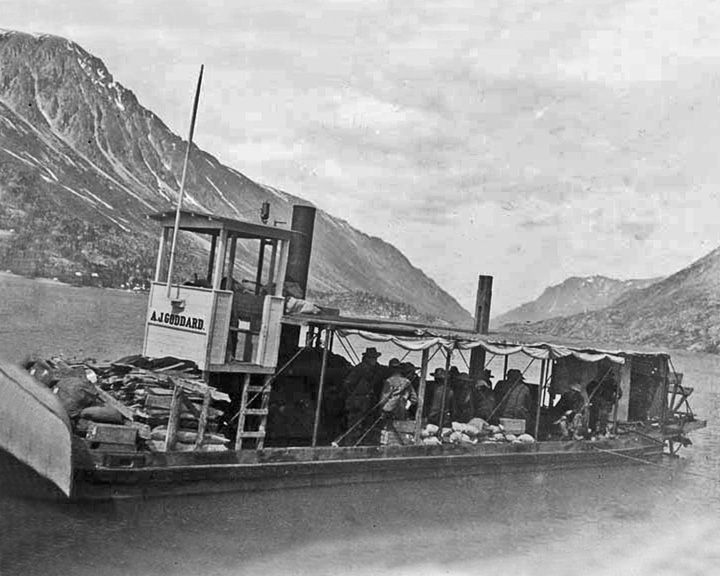 A. J. Goddard — American paddle steamer A Klondike Gold Rush era sternwheeler built for transporting men and supplies on the Upper Yukon River in Canada. She was not suited for the larger sections of the turbulent Yukon River, so instead she carried passengers and equipment across Lake Laberge. LAUNCHED: 1898 → FATE: Sank October 22, 1901. |
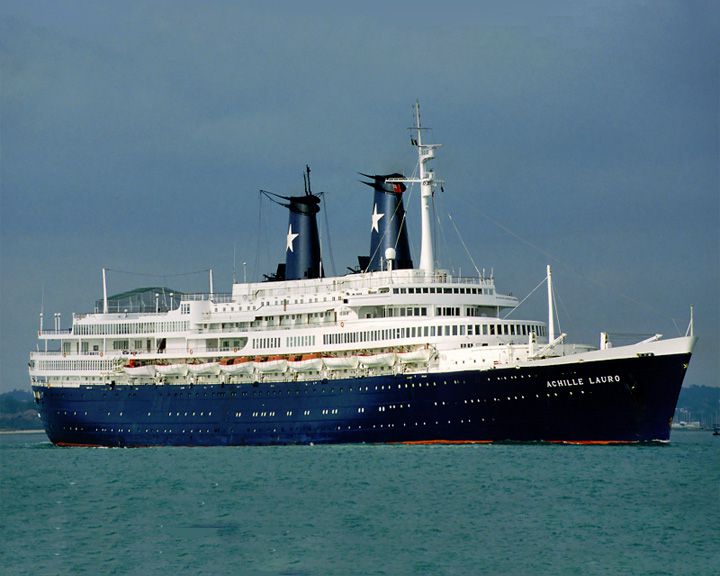 (Another (Another Achille Lauro — Dutch cruise ship Hijacked in 1985 by 4 men representing the PLF; one passenger killed and thrown overboard. The affair was portray in a movie. On January 6, 1953, she collided in the Red Sea with MS Oranje, heading in the opposite direction. LAUNCHED: 1947, July 18 → FATE: Sank in the Indian Ocean on December 2, 1994 due to fire. |
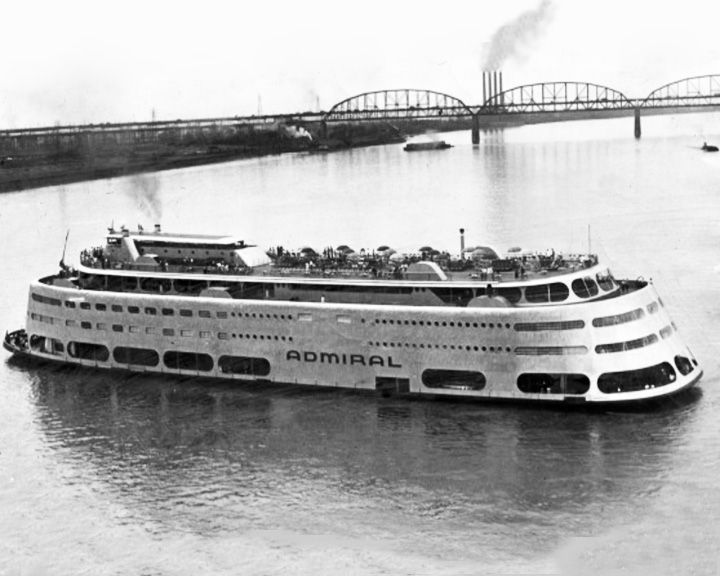 (Another (Another Admiral, SS — American river steamboat (cruise ship; converted to diesel in 1974) Was the largest river cruise ship in the world, sailing the Mississippi River from St. Louis. In 1979 she was converted to a land-based casino. She started out as the side-wheeled steel hulled steamboat, the Albatross, then became the Admiral in the 1940s. LAUNCHED: 1907 → FATE: Dismantled and sold for scrap in 2011. |
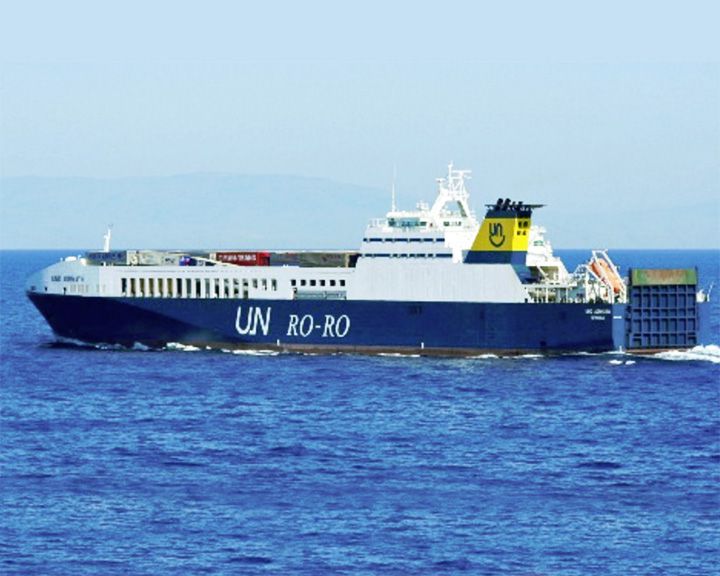 (Another (Another Adriyatik, MS UND — Turkish cargo ship Cargo ship that caught fire off the coast of Istria, Croatia and burned for 2 days. She was sailing from Istanbul to Trieste carrying 200 trucks, nine tons of dangerous material, and 100-200 tons of ship fuel. In spite of fears, there was no environmental damage. LAUNCHED: 2001, June 18 → FATE: Being repaired. |
 Adventure Galley — English galley Captain Kidd's flag ship. Because she had become worm-eaten and leaky, Kidd ordered her to be burnt. LAUNCHED: 1695 → FATE: Burnt and sunk at Saint Mary's Island in 1698. |
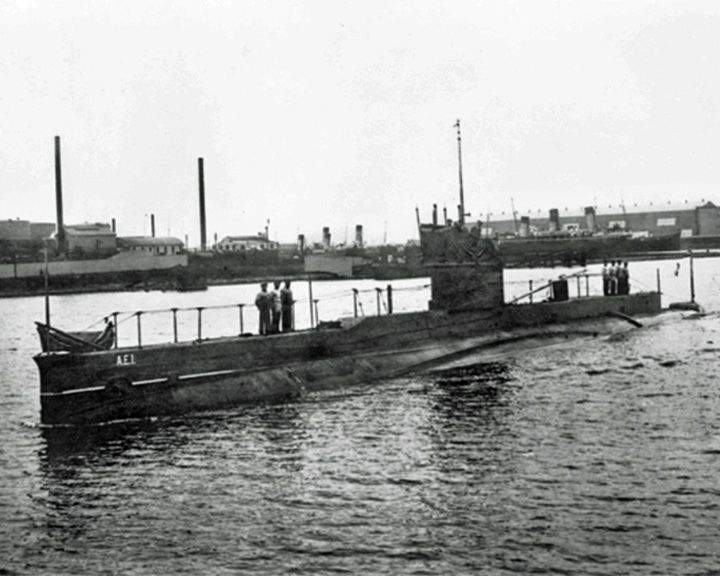 AE1, HMAS — Australia E-class submarine, British built The first Royal Australian Navy submarine and the first allied vessel lost in World War I with a crew of 35. She was assigned to the capture of the German Pacific colony of New Guinea at the outbreak of the World War I. LAUNCHED: 1913, May 18 → FATE: Lost at sea September 14, 1914; her wreckage located at a depth of 300 meters off the Duke of York Islands. |
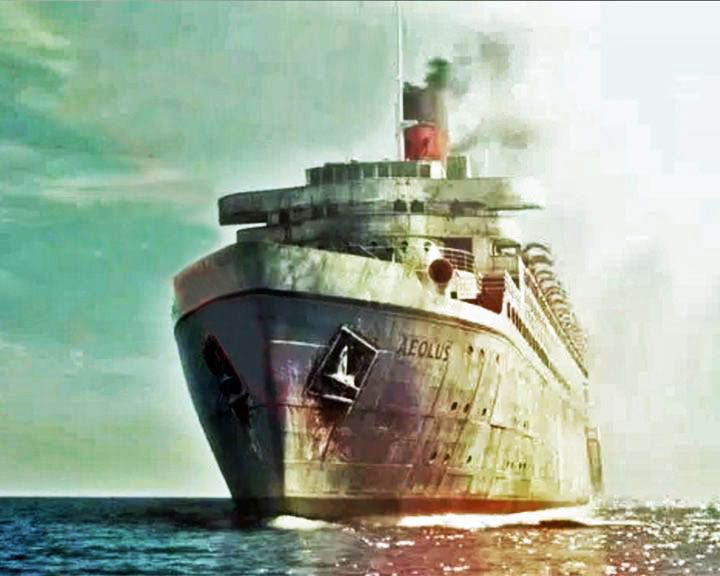 Aeolus — British cruise ship; movie set creation A mysterious ship in the British movie Triangle. The movie scenes include the exterior of the cruise liner which the director insisted on constructing to avoid shooting everything with green screens LAUNCHED: 2009, movie release → FATE: Inconclusive. |


|
Page 2
|
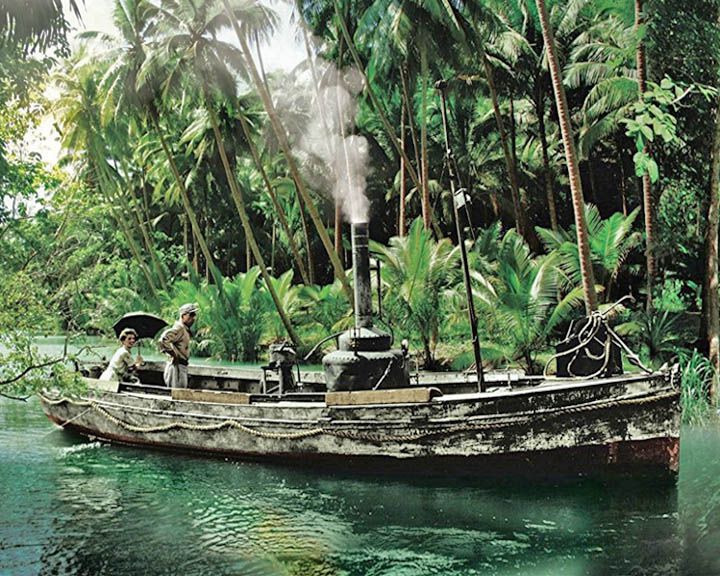 (Another (Another African Queen — American steamboat Boat used in the 1951 movie The African Queen, an adventure set during World War I, starring Humprey Bogart and Katharine Hepburn. From 1912 to 1968, she shuttled cargo and passengers across Lake Albert in Africa. The steam engine in the movie was a prop and its original diesel engine was hidden under crates of gin and other cargo. LAUNCHED: 1912 → FATE: Refurbished to service as a tourist boat in Key Largo, Florida. |
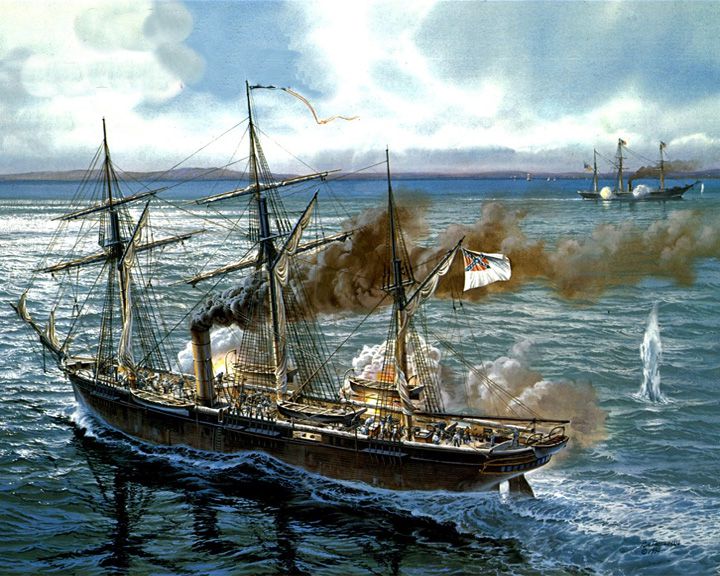 Alabama, CSS — American Confederate screw sloop-of-war A successful commerce raider that attacked Union merchant and naval ships during the American Civil War. She boarded nearly 450 vessels and captured or burned 65 Union merchant ships. LAUNCHED: 1862, July 18 → FATE: Sunk in June 1864 by USS Kearsarge at the Battle of Cherbourg. |
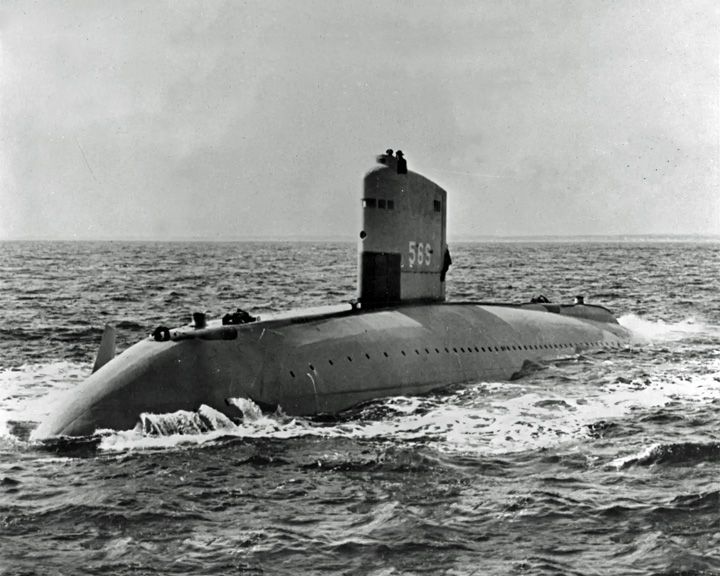 Albacore, USS — American submarine Research submarine that pioneered the teardrop hull of modern submarines. For more than two decades she provided the US Navy information and experience in making submarines faster, quieter, safer and more agile. LAUNCHED: 1953, August 18 → FATE: Decommissioned December 9, 1972. When being towed to a permanent display site in April 1984, she became stuck in the mud of Portsmouth Harbor. In 1985, she was dedicated there as a memorial. |
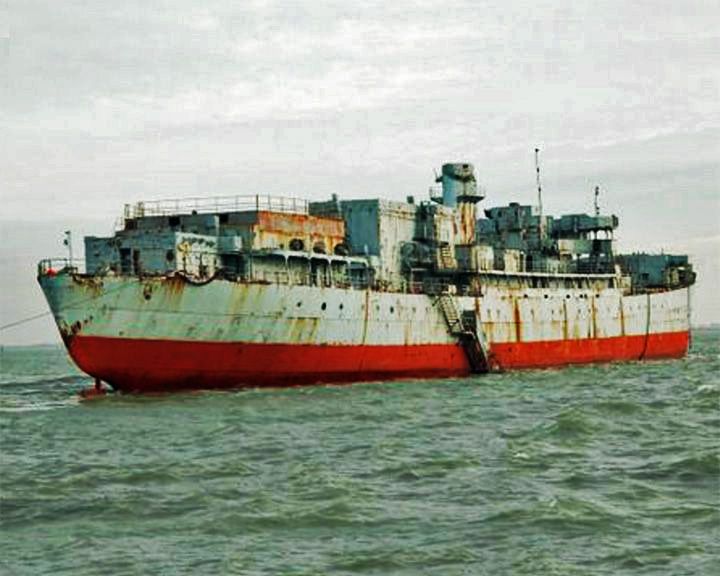 (Another (Another Albert M. Boe — American liberty ship Last Liberty ship built. Though currently landlocked, she is still in use as the home of Trident Seafoods. The ship was withdrawn from the reserve fleet on 19 August 1964 and converted for use as the fish cannery ship Star of Kodiak. LAUNCHED: 1945, September 18 → FATE: Converted to a fish cannery ship in 1964. |
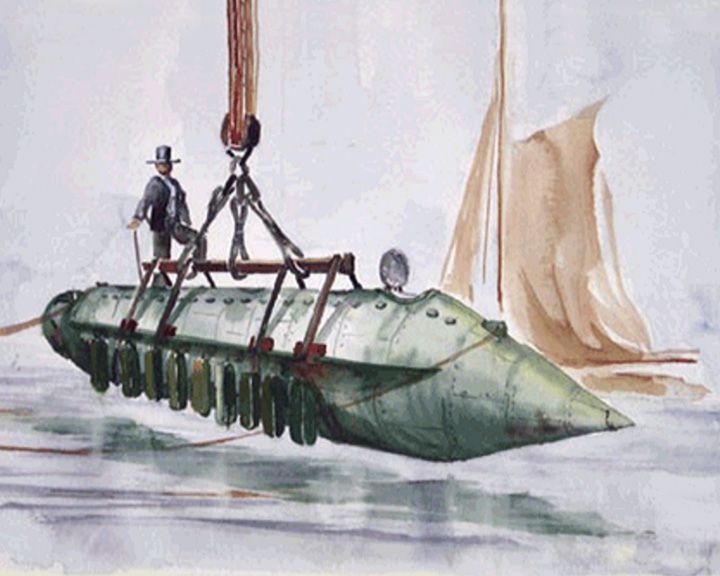 Alligator — American submarine First U.S. Navy submarine. The first American submarine, called Turtle (1776), never served in the U.S. Navy. The first commissioned U.S. submarine was the USS Holland in 1862. LAUNCHED: 1862, May 18 → FATE: Sank in bad weather off Cape Hatteras April 2, 1863. |
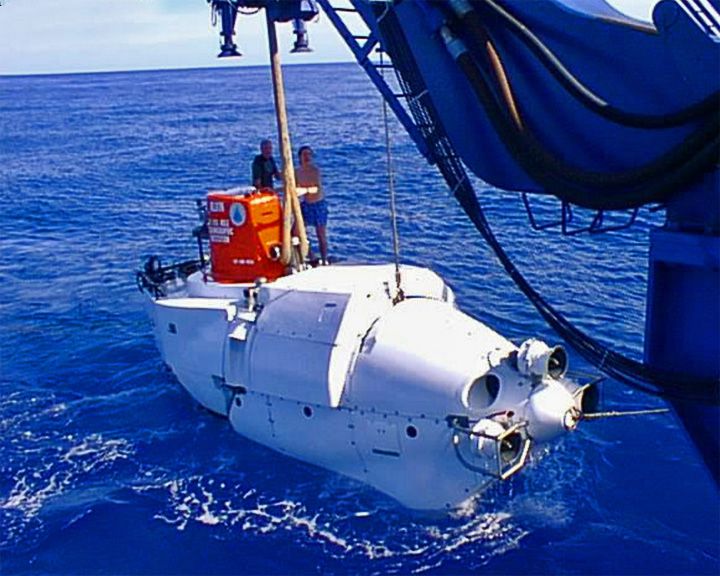 (Another (Another Alvin, DSV — American research vessel; submersible First Deep Submergence Vehicle (DSV) able to dive to 4,500 meters or 14,800 feet. She was lost October of 1968 when she accidentally sank in 1500 meters of water, but was recovered in August of 1969 and refurbished. LAUNCHED: 1964, June 18 → FATE: Still in service. |
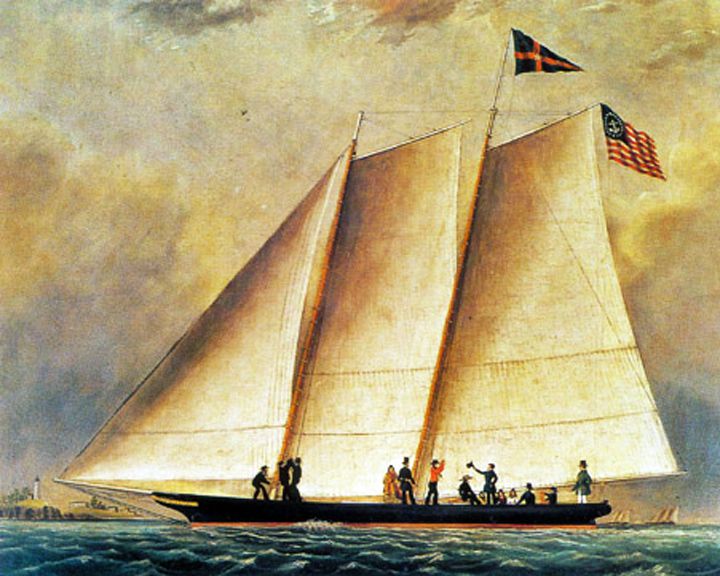 America — American racing yacht; schooner Won the Royal Yacht Squadron's 53 mile regatta around the Isle of Wight, August 22, 1851. The international sailing trophy, America's Cup, is named after her. During the American Civil War, she served in the Union blockading squadron off Charleston, then after the war as a training ship at the Naval Academy. LAUNCHED: 1851, May 18 → FATE: In disrepair, her remains were burned in 1945 at Annapolis. |
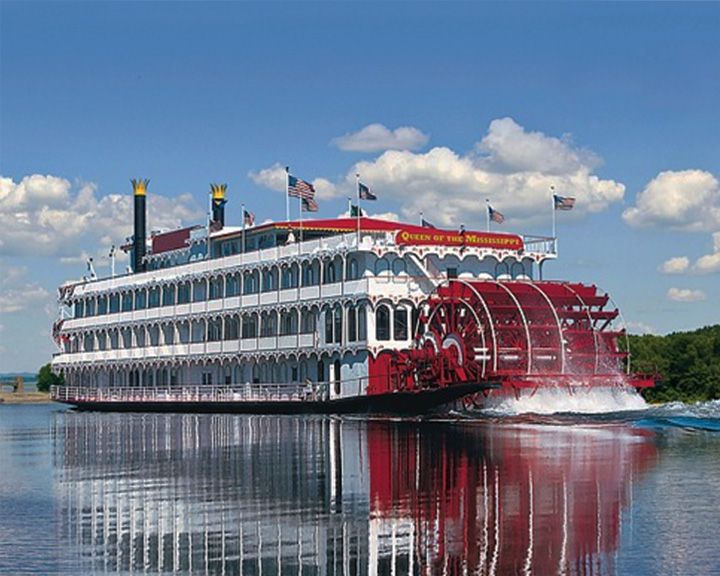 American Queen — American river paddle steamboat; stern-wheeler Largest steamboat ever built, as of 2012. In 2012 she participated for the first time in the Great Steamboat Race and came in second. LAUNCHED: 1995 → FATE: Still in operation on the Mississippi River. |
|
|
Page 3
|
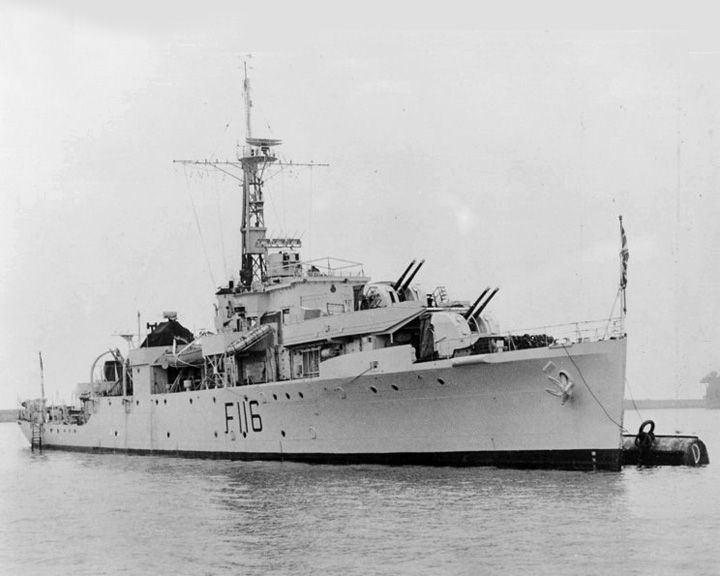 Amethyst, HMS — British modified Black Swan class sloop Subject of the 1957 movie Yangtse Incident, an actual event in April of 1949 during the Chinese Civil War. In the movie, she played herself. During World War II, she was deployed mostly on anti-submarine patrols and escort duties. LAUNCHED: 1943, May 18 → FATE: Scrapped January 19, 1957. |
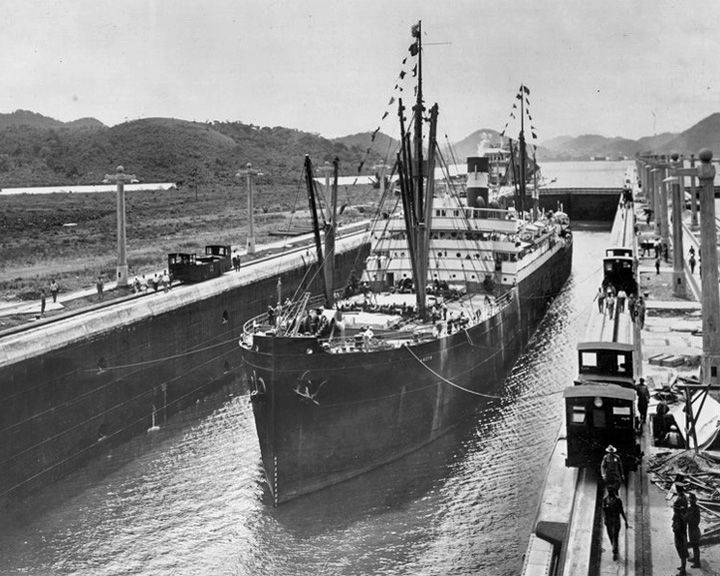 Ancon, SS — American steamship First ship to officially transit the Panama Canal on August, 15 1914. (Sister ship Cristobal made the first unofficial transit on August 3, 1914). She was acquired by the US Navy from the US Army for troop transport just after the end of World War I. LAUNCHED: 1902 → FATE: As the USS Ancon (ID-1467), she was decommissioned on July 25, 1919. |
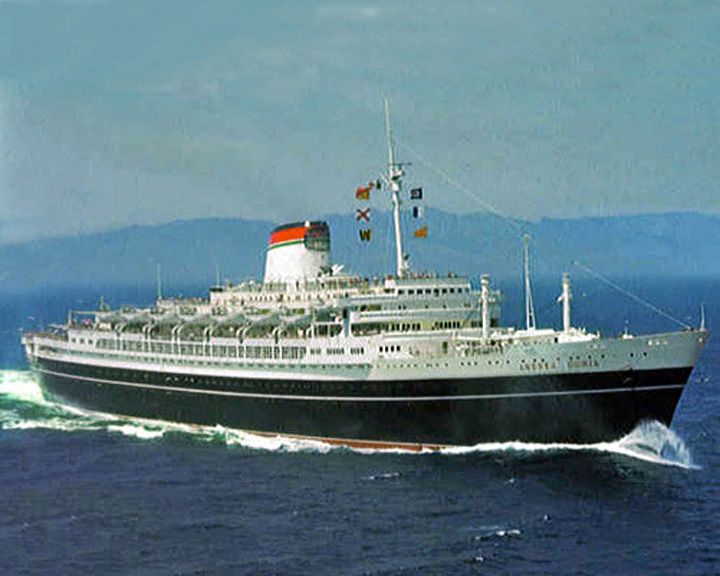 (Another (Another Andrea Doria, SS — Italian ocean liner Collided with the MS Stockholm in the Atlantic and sank; 52 people died. Of all Italy's ships at the time, she was the largest, fastest and supposedly safest. She was the last major transatlantic passenger ship to sink. LAUNCHED: 1953, January 18 → FATE: Sank July 26, 1956. |
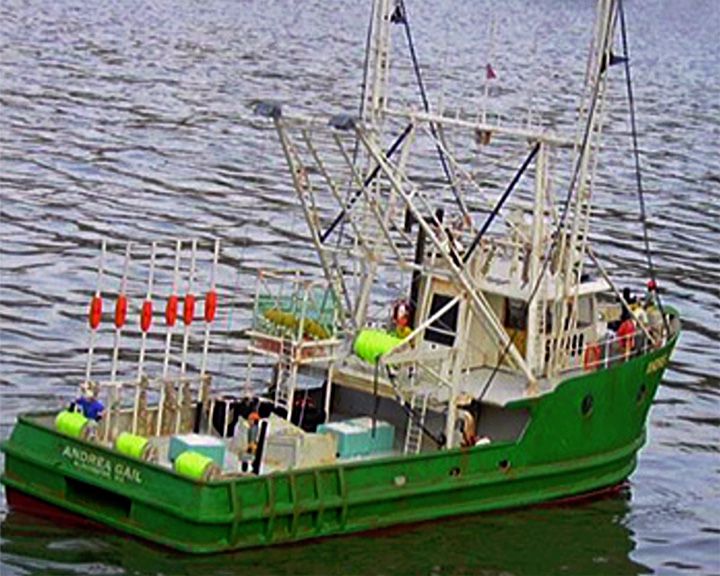 Andrea Gail — American fishing vessel Lost at sea off the coast of Massachusetts with six crew during The Perfect Storm of 1991. The tragedy was the basis of the 1997 book by Sebastian Junger and the 2000 movie The Perfect Storm. LAUNCHED: 1978 → FATE: Lost at sea October 28, 1991. |
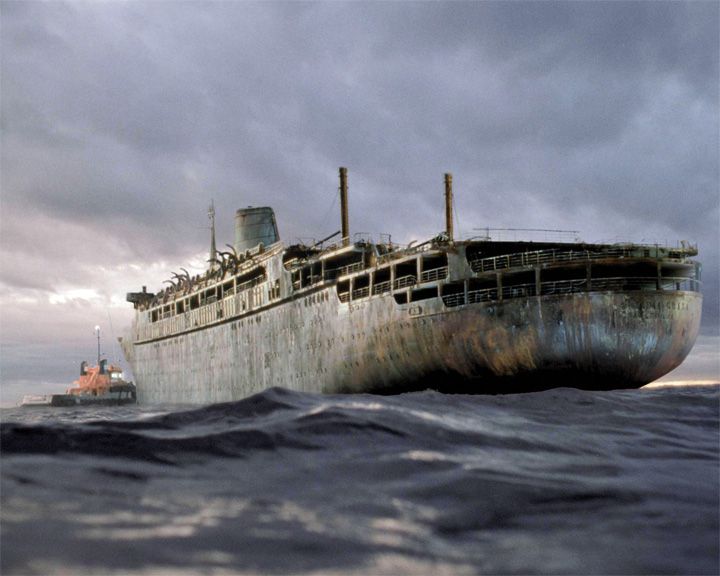 Antonia Graza — Italian ocean liner A fictional ship in the movie Ghost Ship. The plot follows a salvage crew that discovers a long-lost passenger ship floating lifeless in a remote region of the Bering Sea... and horrors abound. LAUNCHED: 1962, first scene takes place in May → FATE: Last scene takes place in 1966. |
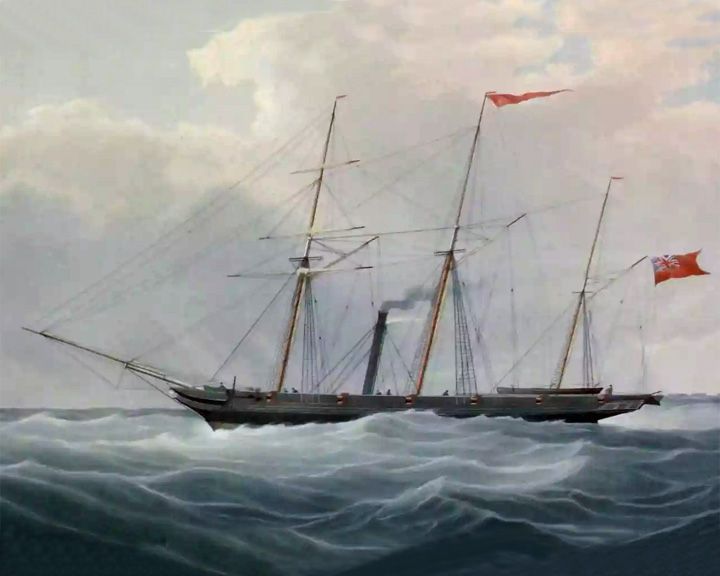 Archimedes, SS — British steamship First ship propelled by a screw drive. The advantages over side paddlewheel propulsion persuaded the Royal Navy to build the steam sloop-of-war HMS Rattler, the first British warship to adopt a screw propeller. LAUNCHED: 1839, October 18 → FATE: Sank in the Meuse River during a storm on March 1, 1864. |
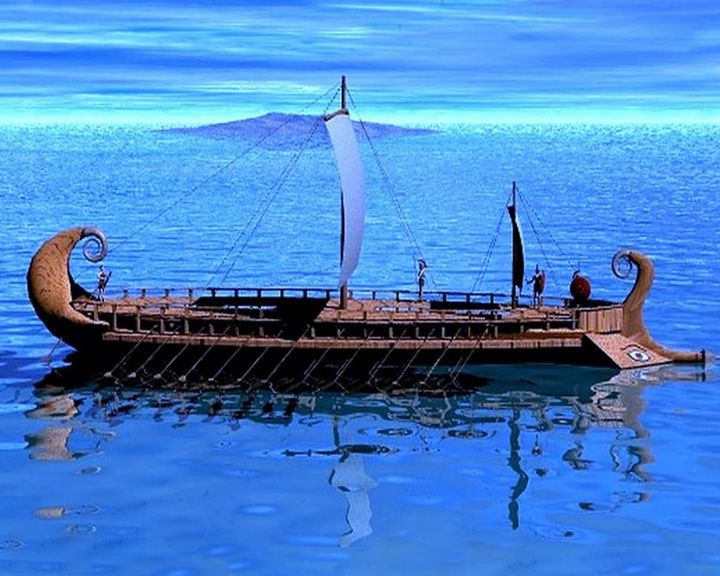 Argo — Greek galley, legendary The ship on which Jason and the Argonauts are said to have sailed from Iolcos to retrieve the Golden Fleece. Legend has it that the Argo was built by the shipwright Argus, and its crew were specially protected by the goddess Hera. LAUNCHED: 1300, BC, perhaps → FATE: Unknown. |
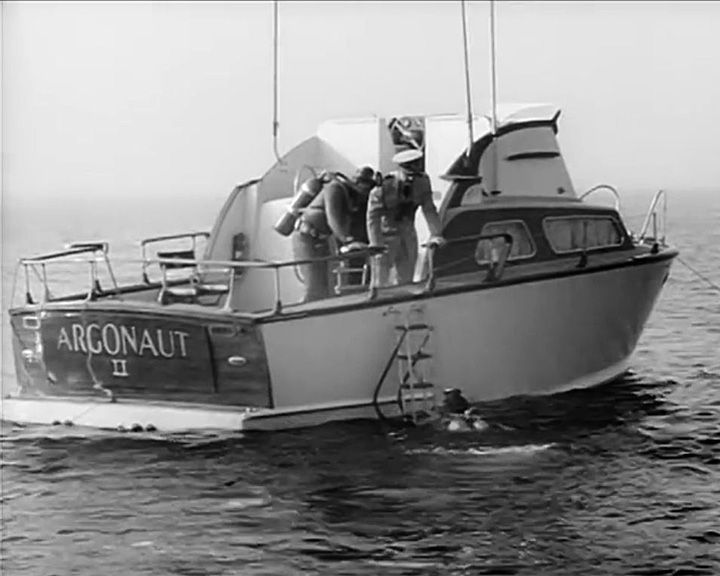 Argonaut — American cabin cruiser The vessel used in the American TV series Sea Hunt, starring Lloyd Bridges about a free-lance scuba diver, airing 1958-1961. Several cabin cruisers were utilized in filming. One notable model was the Trojan Express custom built by Trojan Yachts in 1960. LAUNCHED: 1958 → FATE: Inconclusive. |
|
|
Page 4
|
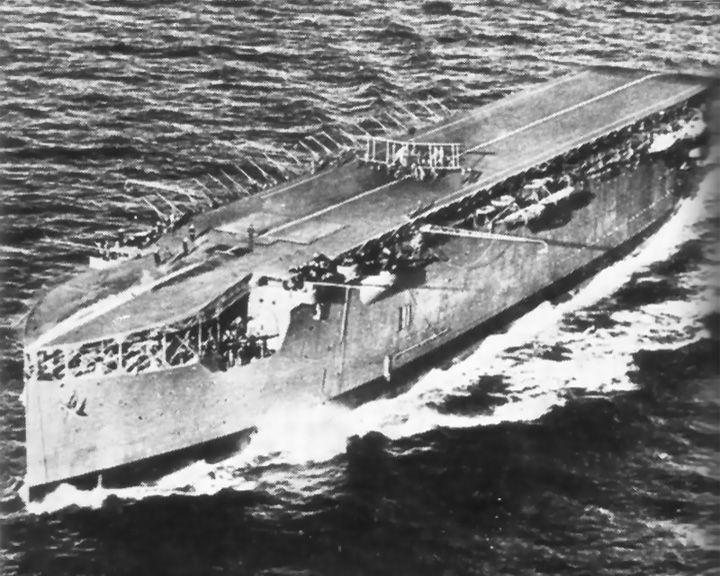 Argus, HMS — British aircraft carrier First Aircraft carrier to have a full flight deck and a lift. She was built from the incomplete Italian ocean liner Conte Rosso and served extensively in both world wars. LAUNCHED: 1917, December 18 → FATE: Scrapped December 1946. |
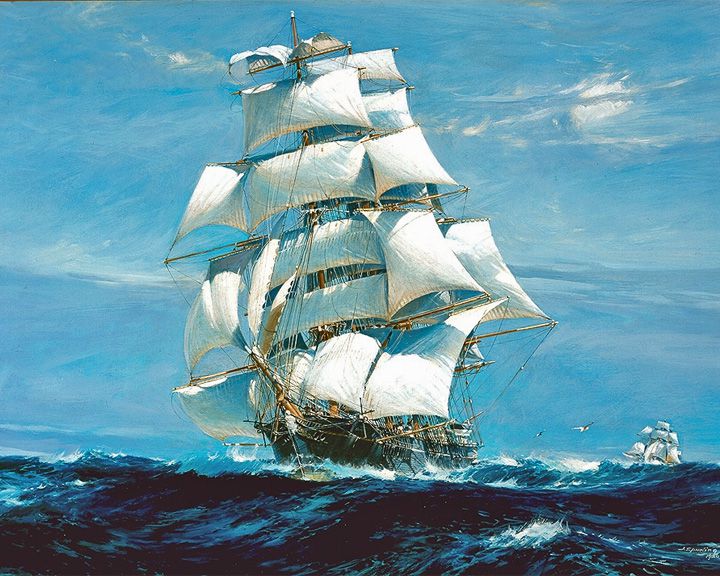 Ariel — English clipper ship Famous for almost winning The Great Tea Race of 1866, an unofficial race between Fuzhou, China and London. On September 6, 1866, the Taeping docked twenty minutes ahead of Ariel. LAUNCHED: 1865 → FATE: Went missing in early 1872. |
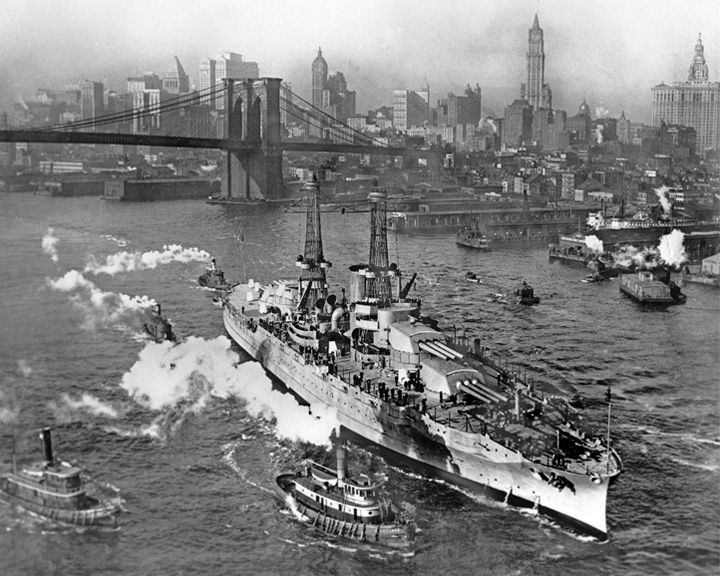 (Another (Another Arizona, USS — American battleship The sunken ship lies in Pearl Harbor with a memorial above it honoring the lost of 1177 crew. The sunken ship continues to leak about a quart of oil per day into the harbor. LAUNCHED: 1915, June 18 → FATE: Sunk during the December 7, 1941 Pearl Harbor attack. |
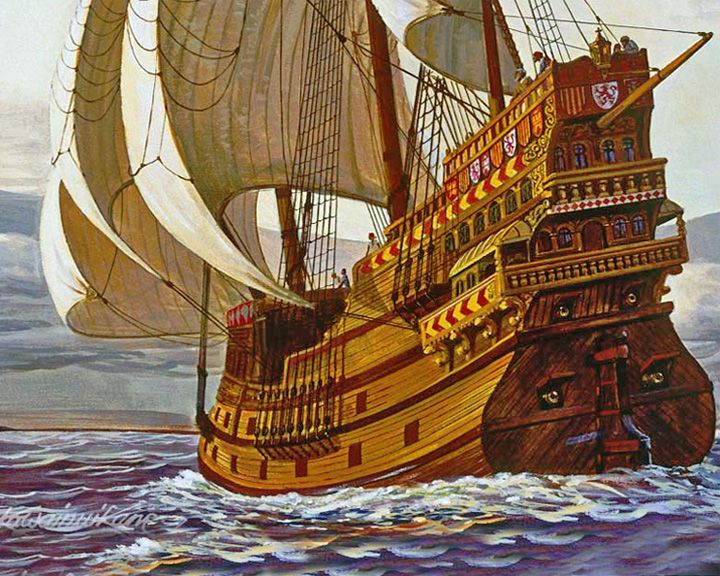 (Another (Another Ark Royal, HMS — English galleon English flagship that fought against the Spanish Armada. During the reign of James VI and I, she was renamed Anne Royal. Several British aircraft carriers have been named Ark Royal. LAUNCHED: 1587 → FATE: Accidentally sunk in April of 1636; raised and broken up in 1638. |
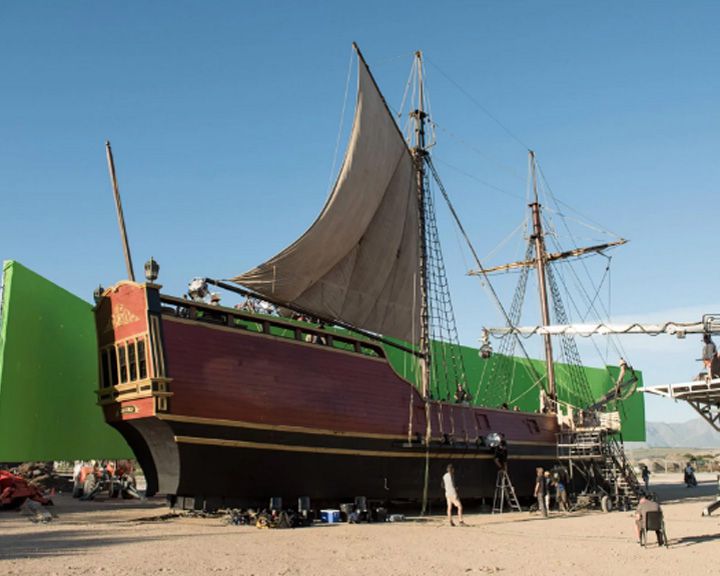 Artemis — American sloop The ship on which Claire and Jamie Fraser travel across the Atlantic in pursuit of the Bruja as seen in season 3 of the TV series Outlander. The ship was never in the water. Green screen was used to fill in ocean background. LAUNCHED: 2017, for the TV series → FATE: inconclusive. |
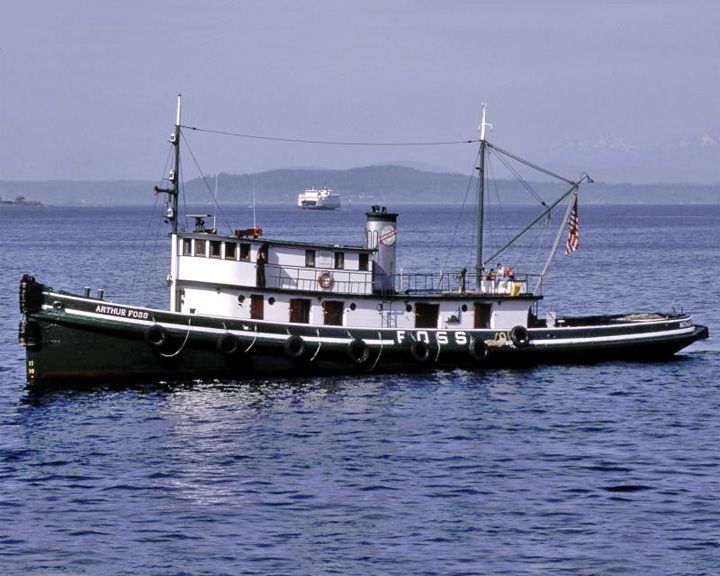 (Another (Another Arthur Foss — American tugboat One of the oldest wooden-hulled tugboats afloat in the United States. She was cast by MGM to play in the 1933 movie Tugboat Annie. LAUNCHED: 1887 → FATE: Renovated and on display at Seattle's South Lake Union Park. |
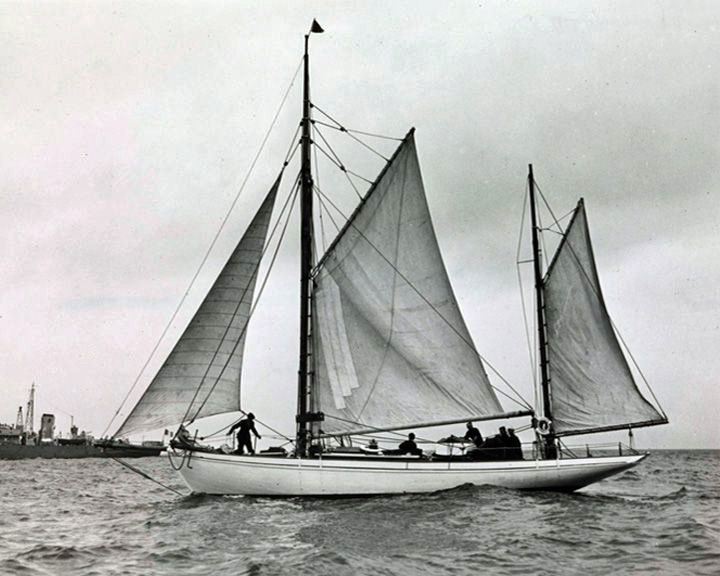 (Another (Another Asgard — British yacht She is most noted for her use in the Howth gun-running of 1914. She was used for sail training by the Irish Navy in the 1960s and as the national sail training vessel from 1969 to 1974. LAUNCHED: 1905 → FATE: The restored Asgard is on permanent display in Collins Barracks, Dublin. |
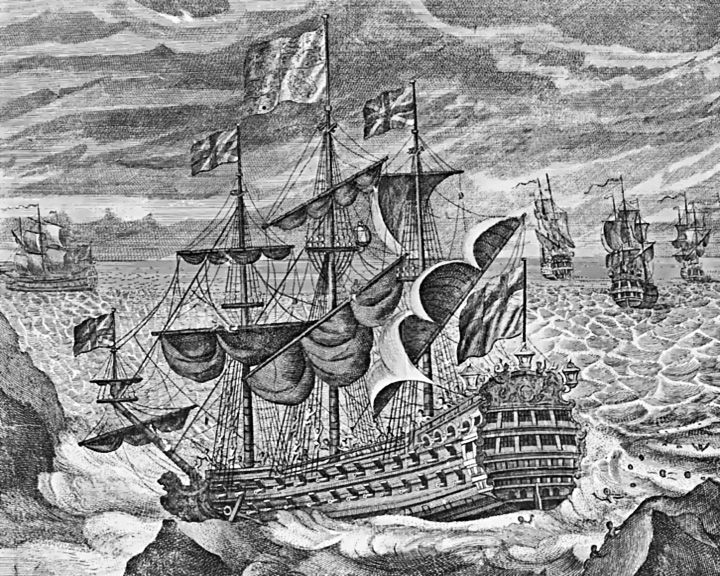 Association, HMS — British second-rate ship of the line After serving with distinction at the capture of Gibraltar, she ended up lost in a storm and wrecked with 3 other ships with the loss of nearly 2,000 lives. The rediscovery of the Association and so many historical artefacts led to legislation such as the Protection of Wrecks Act to preserve British historic wreck sites. LAUNCHED: 1697 → FATE: Wrecked of the Isles of Scilly October 22, 1707. |
|
|
Page 5
|
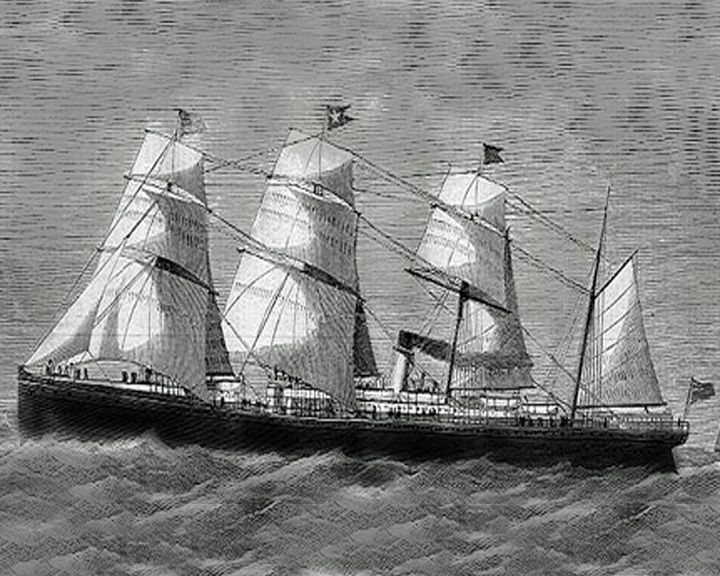 Atlantic, RMS — English ocean liner with sails and steam One of the deadliest civilian maritime disaster in history killing 535 people. The greatest disaster for the White Star Line prior to the loss of Titanic 39 years later. LAUNCHED: 1871, June 18 → FATE: Ran onto rocks and sank off the coast of Nova Scotia April 1, 1873. |
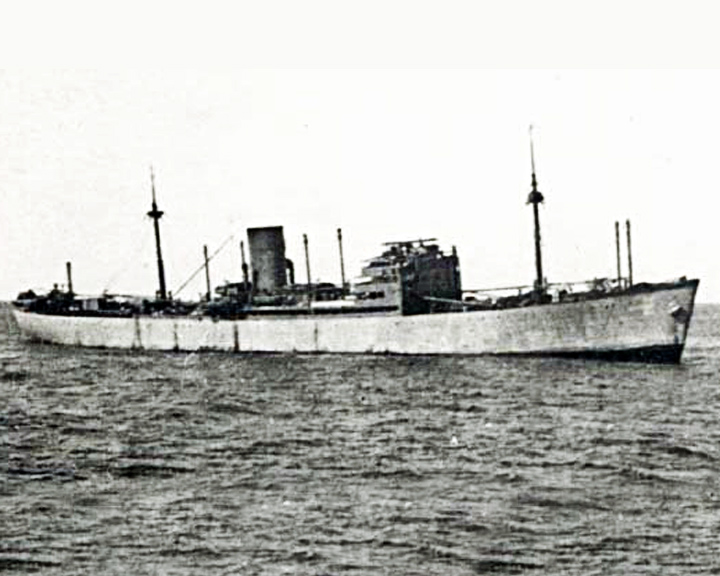 Atlantis — German auxillary cruiser or commerce raider She had the longest raiding career of any German commerce raider in either world war and was second only to Pinguin in tonnage destroyed. She began her career as the cargo ship Goldenfels. In late 1939 she was requisitioned by the Kriegsmarine and converted into a warship. LAUNCHED: 1937, Converted in 1939 → FATE: Sunk by a British ship November 22, 1941. |
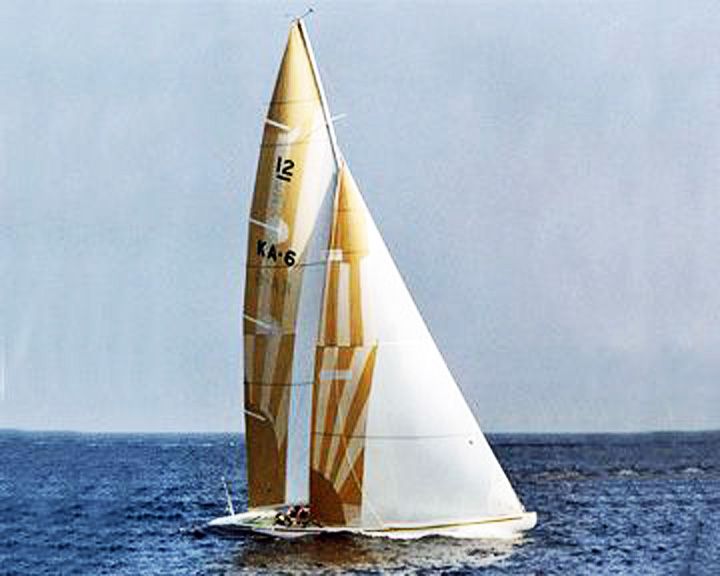 Australia II — Australian racing yacht First winning challenge to the New York Yacht Club's 132 year hold on the America's Cup during the 1983 America's Cup Race. The legality of her winged keel, which gave her advantage in maneuverability and heeling moment, was challenged by the NYYC but upheld. LAUNCHED: 1982 → FATE: On display at the Western Australian Maritime Museum in Fremantle. |
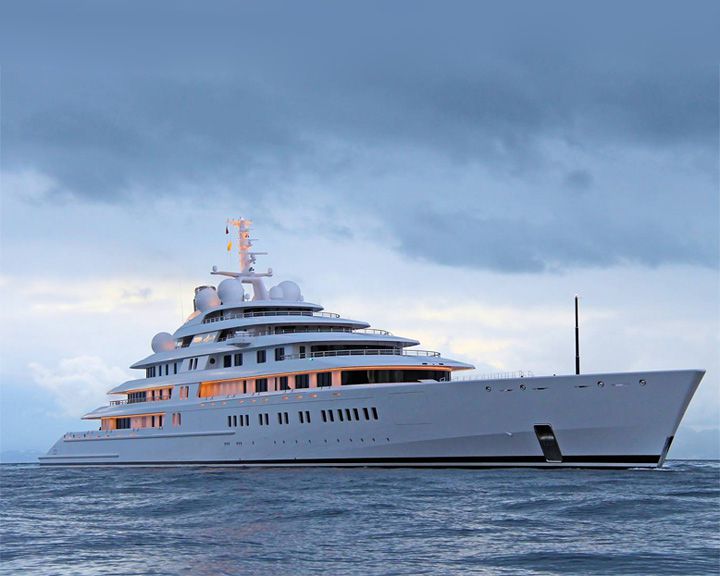 (Another (Another Azzam — Emirati luxury yacht, 180 meters (590 ft) in length; German built As of 2019, the world's largest private yacht with extravagant features and accommodations. At an estimated cost of US $605,000,000, she has a top speed of over 32 knots and carries a submarine and a missile defense system. LAUNCHED: 2013, April 18 → FATE: At sea, but not for charter. |
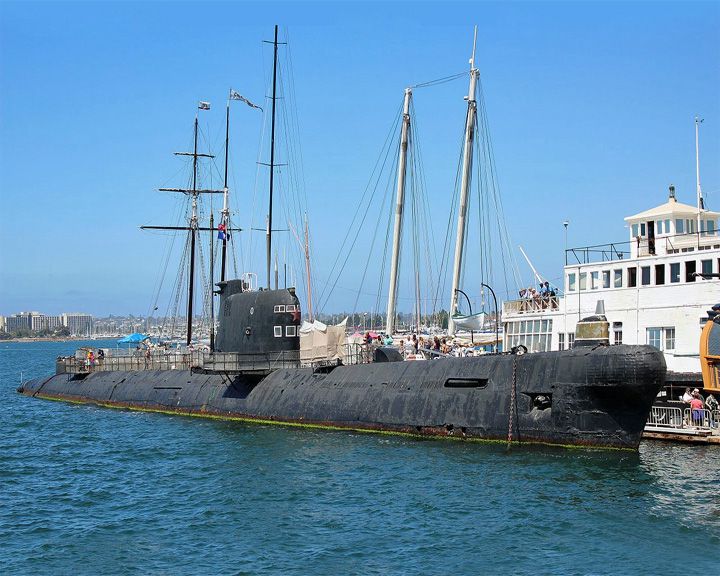 B-39 — Russian foxtrot-class submarine The Soviet Navy's largest non-nuclear submarines.. In 2012, she was used as a prop in the movie Phantom. Another B-39 is rusting in England (see Black Widow). LAUNCHED: 1967, April 18 → FATE: Decommissioned April 1994; now a museum ship at the Maritime Museum of San Diego, California. |
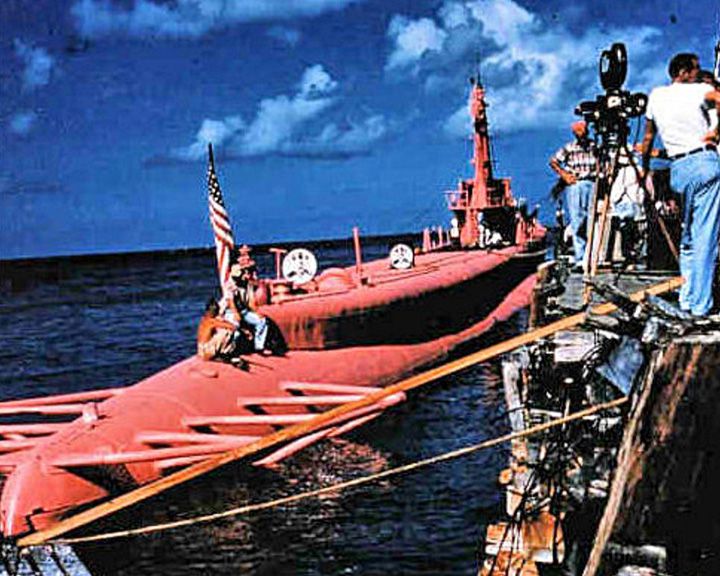 Balao, USS — American submarine Featured as the "pink submarine" in the 1959 movie Operation Petticoat, co-starring with Cary Grant and Tony Curtis. She served ten patrols in World War II, then in training exercises afterwards. Her conning tower and periscope are on display at the U.S.Navy Museum in Washington, D.C. LAUNCHED: 1942, October 18 → FATE: Sunk as a target off Florida on September 6, 1963. |
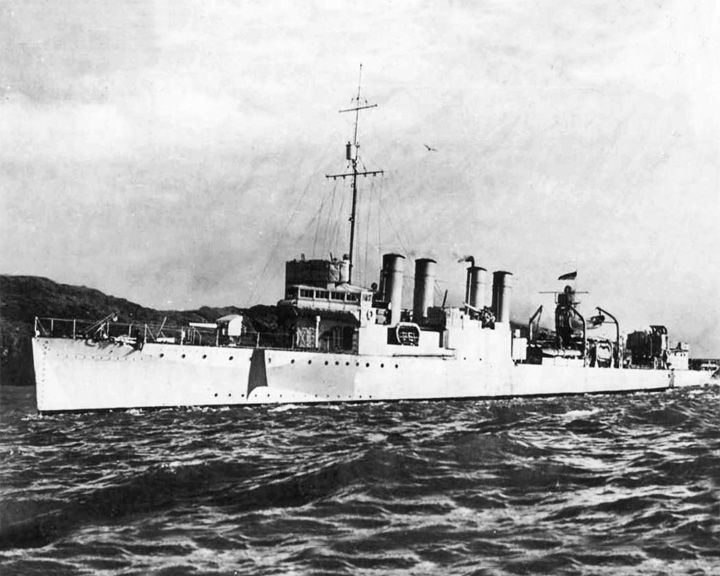 Ballantrae, USS — American Town-class destroyer A fictional ship in the movie Gift Horse on a one-way mission in World War II to destroy a German-held dry dock in France; based on HMS Campbeltown and the St Nazaire Raid. The USS Twiggs was turned over to the Royal Navy in 1940 to become HMS Leamington. From 1944-1949, she served under the Russian flag, then was returned to Great Britain in 1950 where she appeared in the movie. LAUNCHED: 1951, movie release; USS Twiggs launched September 1918 → FATE: After appearing in the movie, she was scrapped at Newport, Wales in 1951. |
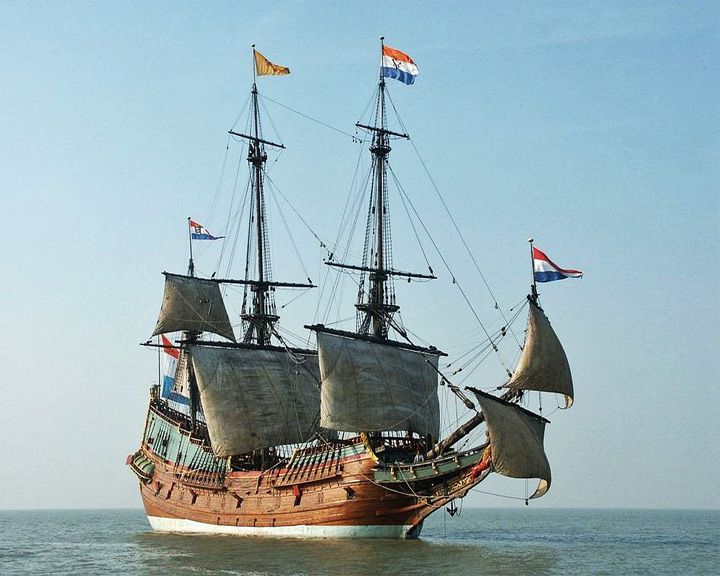 Batavia — Dutch galeon The original ship was made famous by the mutiny and massacre of over 125 crew and passengers. The replica was built with traditional materials using the tools and methods as in the original Batavia's construction. LAUNCHED: 1628, original ship; replica completed 1995 → FATE: Wrecked on Houtman Abrolhos in June 1629; replica is on exhibit at Lelystad, Netherlands. |
|
|
Page 6
|
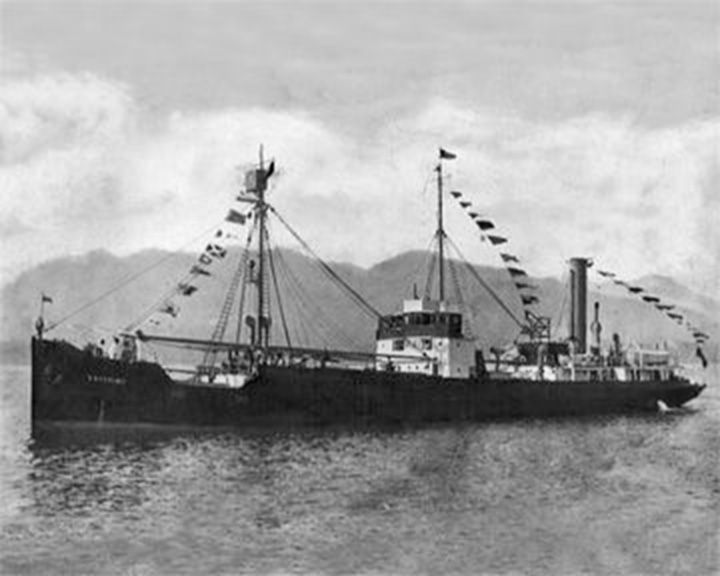 Baychimo, SS — German cargo ship, then British; steel-hulled Known as a ghost ship and seen numerous times since, her last sighting in 1969. She was taken by Great Britain as part of Germany's WW I reparations and acquired by the Hudson's Bay Company in 1921. LAUNCHED: 1914 → FATE: Abandoned and lost along the Alaska coast in November, 1931. |
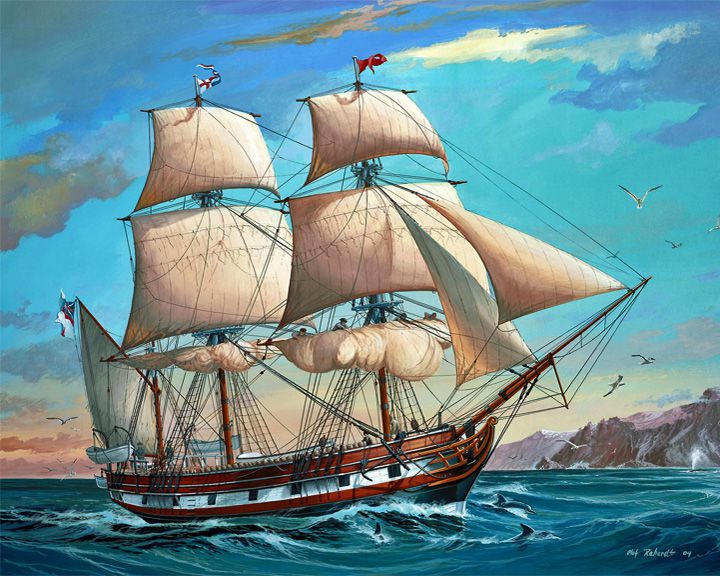 Beagle, HMS — English sloop, or brig-sloop, two-masted She carried Charles Darwin on his historic expedition beginning in 1831. Robert FitzRoy was captain during the historic round-the-world trip. In 1845 the Beagle was refitted as a static coast guard watch vessel. LAUNCHED: 1820, May 18 → FATE: Sold for scrap in 1870. |
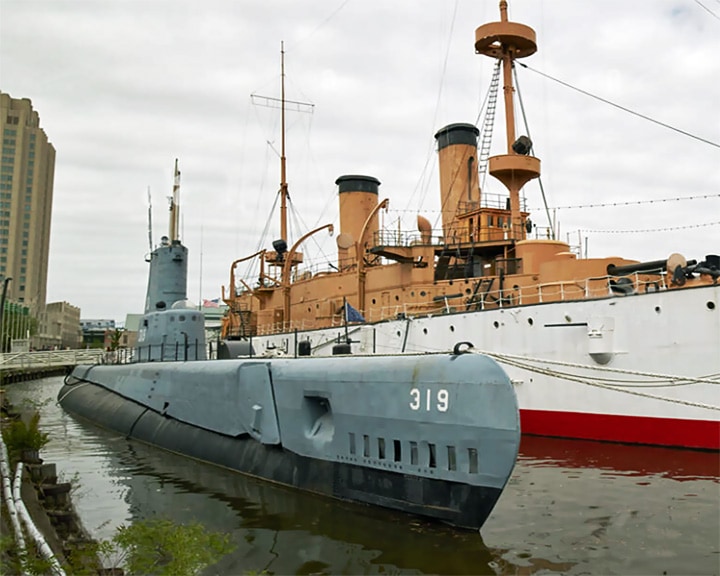 Becuna, USS — American submarine Designated a National Historic Landmark for her service in World War II, for which she earned four battle stars. She is credited with having sunk two Japanese tankers totaling 3,888 tons. LAUNCHED: 1944, January 30 → FATE: She serves as a museum ship at the Independence Seaport Museum in Philadelphia, Pennsylvania |
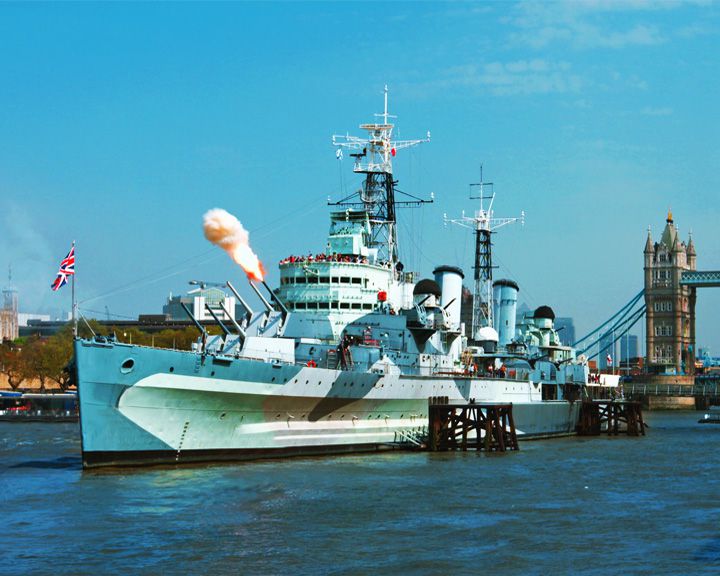 Belfast, HMS — British town-class cruiser One of only three surviving bombardment ships which supported the D-Day Normandy Landings in 1944 of World War II, firing probably the first or second salvo. She spent 33 days in support of the D-Day landings and fired over 4,000 6-inch and 1,000 4-inch shells. LAUNCHED: 1938, March 18 → FATE: After much preservation work, she is on exhibit, located on the River Thames next to Tower Bridge at the Port of London. |
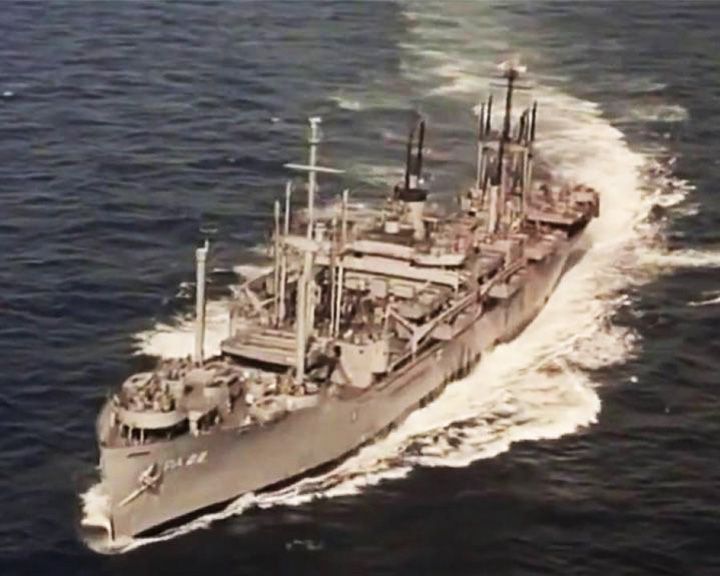 Belinda, USS — American attack transport The World War II ship in the 1956 movie Away All Boats.. She was portrayed by the USS Randall, an attack transport in service with the United States Navy from 1944 to 1956. LAUNCHED: 1956 → FATE: The actual ship, Randall, was scrapped in 1972. |
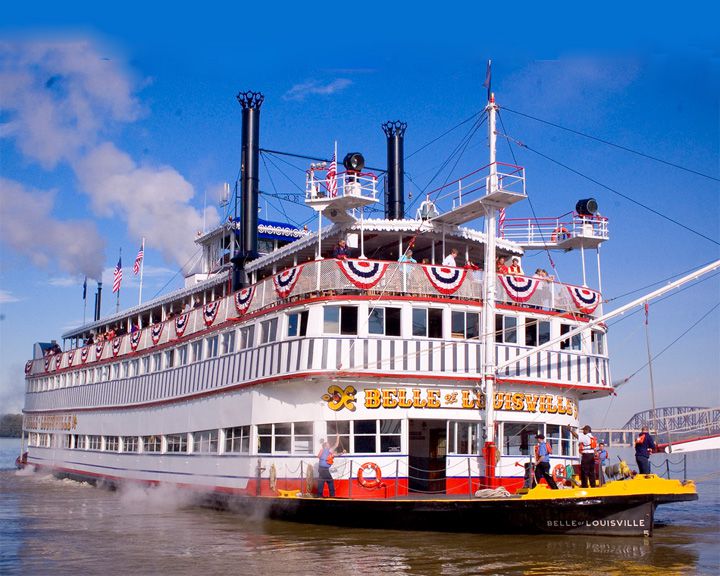 Belle of Louisville — American steamboat, paddle, stern-wheeler Oldest continually operating river steamboat in the United States. She competes every year in the Kentucky Derby Festival event The Great Steamboat Race. LAUNCHED: 1914 → FATE: Restored in 1964, still in use at Louisville, Kentucky. |
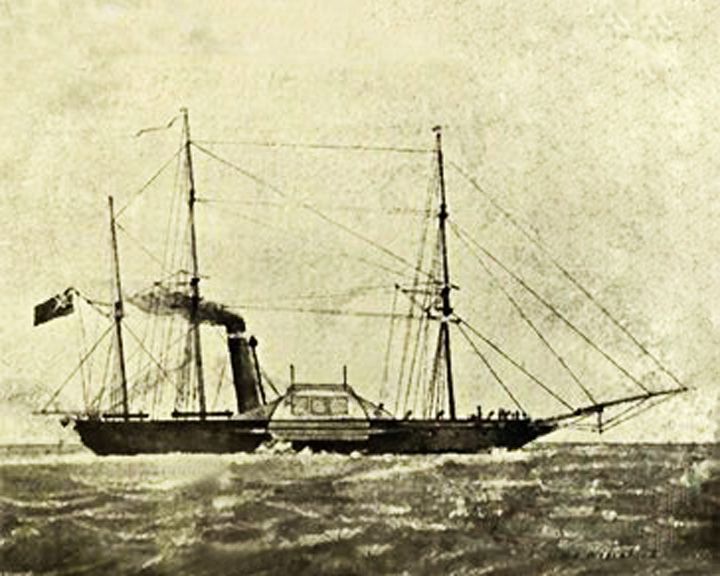 (Another (Another Birkenhead, HMS — British frigate, steamer The protocol "women and children first" originated on this sinking ship. Only 193 of the 643 people on board survived. Over the years, numerous attempts have been made to salvage the gold thought on board. LAUNCHED: 1845, December 18 → FATE: Struck a hidden reef and sank February 26, 1852. |
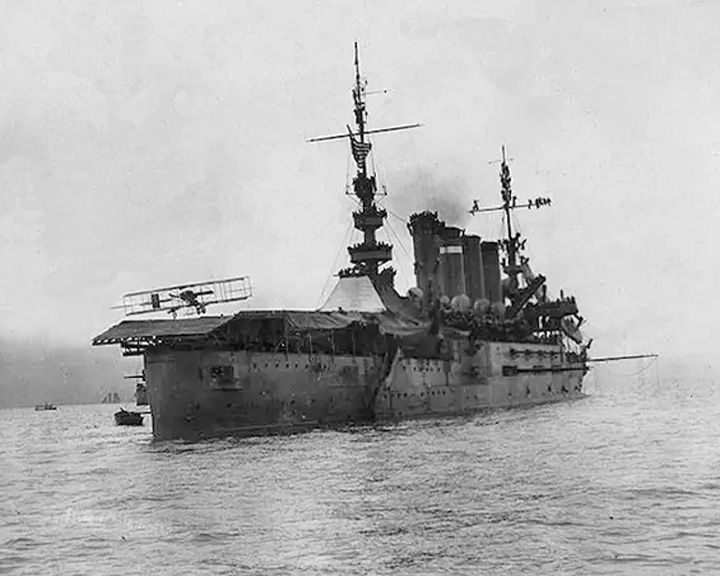 Birmingham, USS — American scout cruiser, Chester-class The first airplane takeoff from a ship in history in 1910. During World War I, she patrolled along the northeast U.S. coast until 14 June 1917 when she sailed from New York as part of the escort for the first US troop convoy to France. LAUNCHED: 1907, May 29 → FATE: Sold for scrap, 13 May 1930. |
|
|
Page 7
|
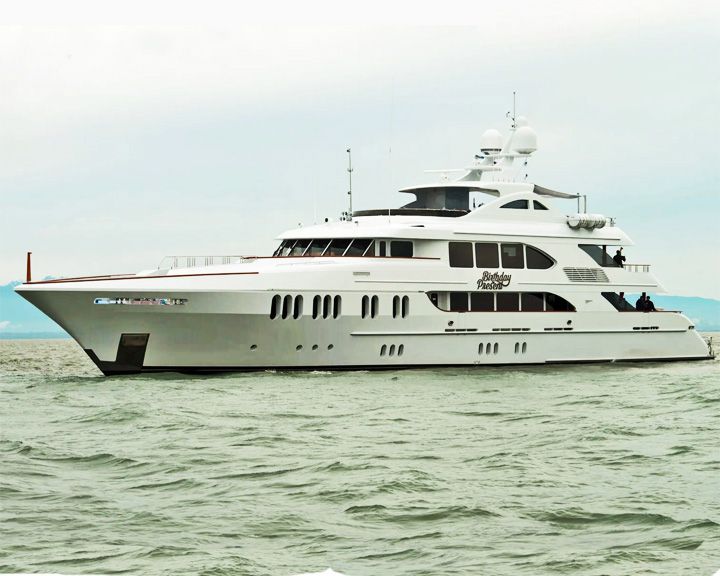 Birthday Present — American super-yacht Super-yacht used int the movie Overboard. The custom motor yacht was actually the Aspen Alternative built in 2010 by Trinity Yachts LAUNCHED: 2018, movie release; 2010 yacht built → FATE: Inconclusive. |
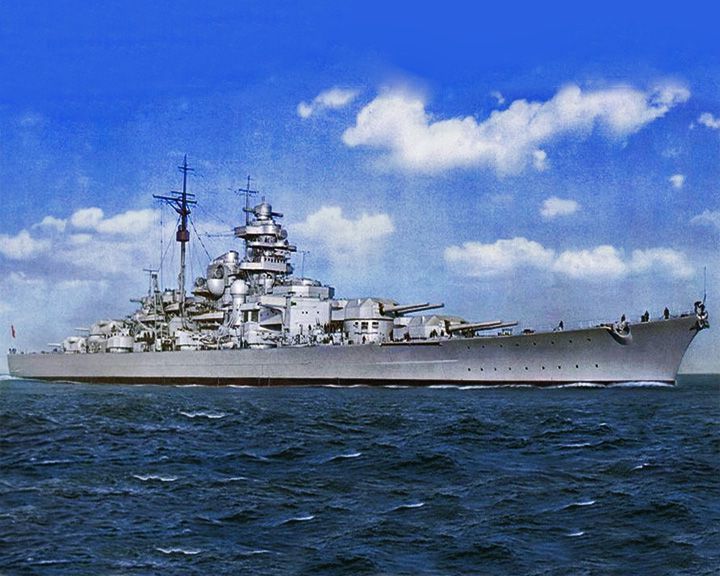 (Another (Another Bismarck — German battleship At the Battle of Denmark Straits, May, 1941, she sunk the British battlecruiser HMS Hood. Relentlessly pursued and sunk by the Royal Navy following Winston Churchill's order "Sink the Bismarck". She and her sister ship Tirpitz were the largest battleships ever built by any European country. LAUNCHED: 1939, February 18 → FATE: Sunk by British forces on May 27, 1941 in the North Atlantic. |
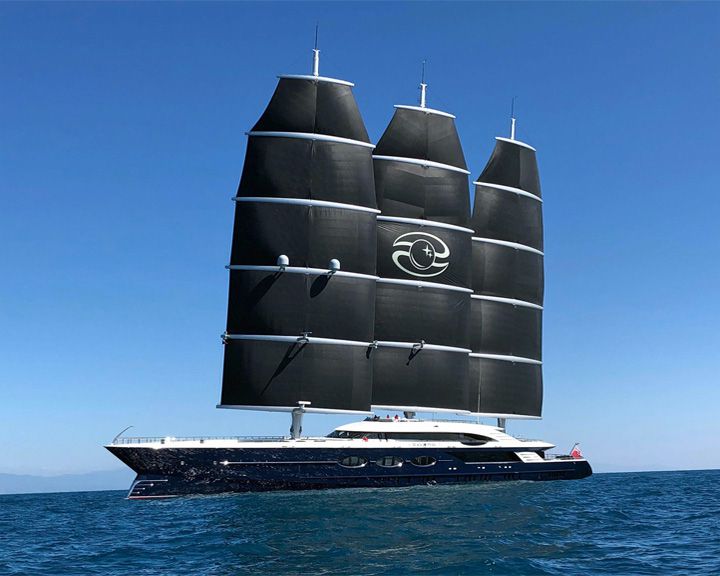 Black Pearl — American yacht The world's largest sailing yacht capable of running carbon free. Her sails consist of freestanding rotating masts with rigid yards that acts as square rigs. She can accommodate 12 passengers and features an on-deck Jacuzzi, swimming platform, and a tender garage. LAUNCHED: 2016 → FATE: In service. |
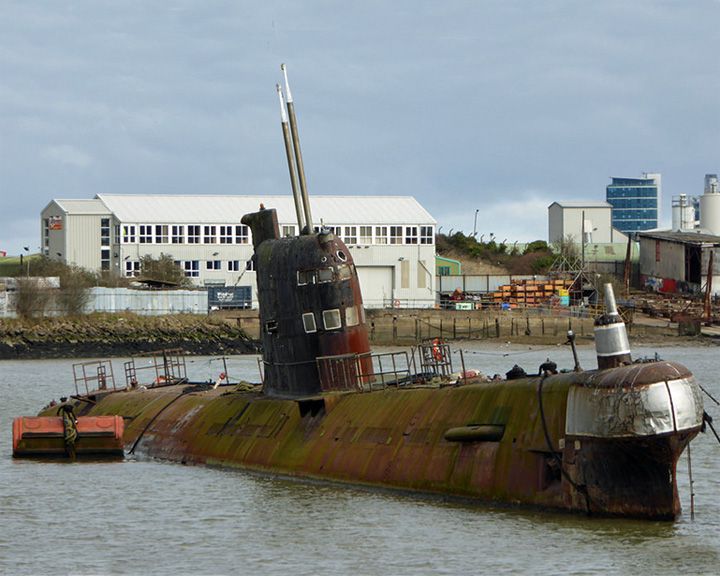 Black Widow — Russian foxtrot-class submarine The rusting boat had been a museum ship for several years in the early 2000s at Folkestone in England. Submarine U-475 Black Widow was a Soviet Navy submarine of the late 20th century. She was sold by the Soviet Navy in 1998 and became a museum ship. Another Foxtrot B-39 is moored at San Diego as a museum ship (see B-39). LAUNCHED: 1966, December 18 → FATE: Decommissioned in 1994 and sold; she is in a state of disrepair awaiting restoration at River Medway. |
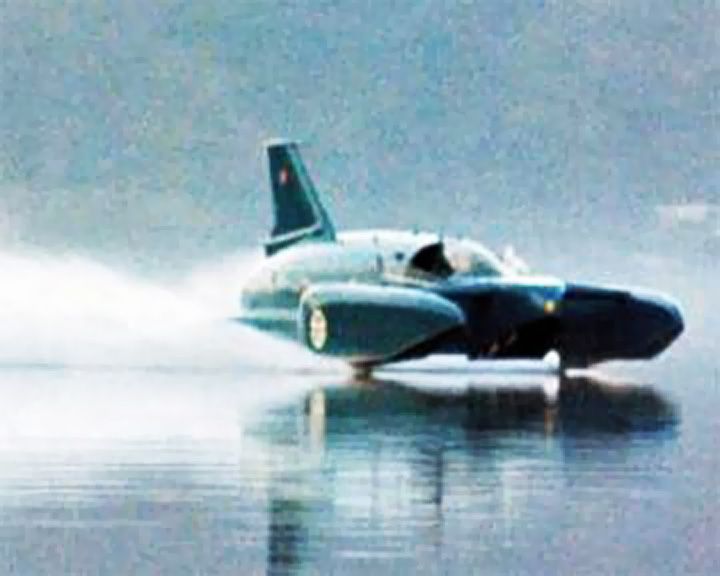 (Another (Another Bluebird K7 — British hydroplane, jet powered Set seven world water speed records between 1955-1964, reaching 276.3 mph or 444.7 km/h. She was developed and piloted by Donald Campbell. LAUNCHED: 1955 → FATE: Flipped and disintegrated at high speed on Coniston Water January 4, 1967, killing Donald Campbell. |
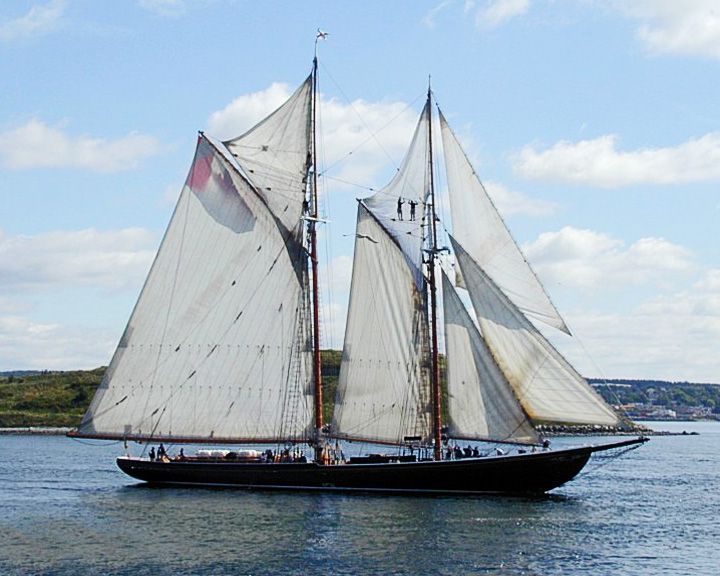 (Another (Another Bluenose — Canadian schooner, fishing and racing Featured on the Canadian dime and once on a Canadian 50 cent postage stamp (see "Another IMAGE") and appears on some Nova Scotia licence plates. During its racing career Bluenose was never beaten and held the International Fisherman's Trophy for 18 consecutive years. LAUNCHED: 1921, March 18 → FATE: Struck a coral reef and abandoned off Haiti on January 28, 1946. |
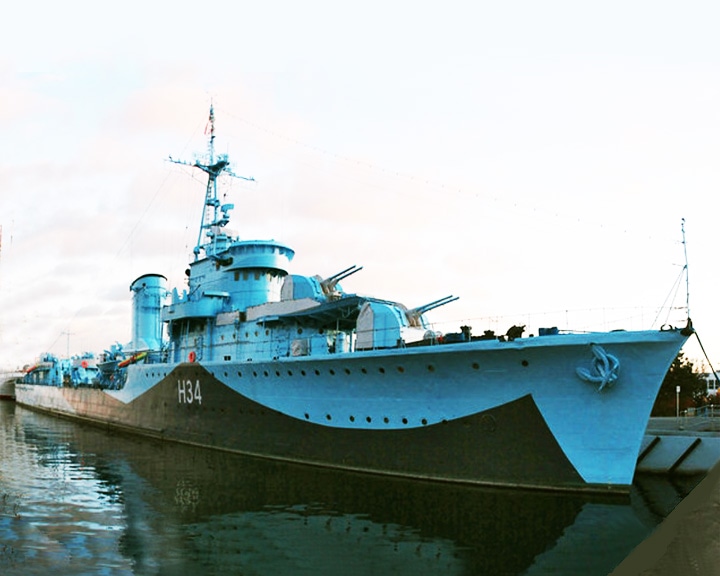 Blyshawica, ORP — Polish destroyer, Grom-class She is the only Polish Navy ship to have been decorated with the Virtuti Militari, Poland's highest military order for gallantry. She is the oldest preserved destroyer in the world. LAUNCHED: 1937, November 25 → FATE: On display as a museum ship in Gdynia, Poland. |
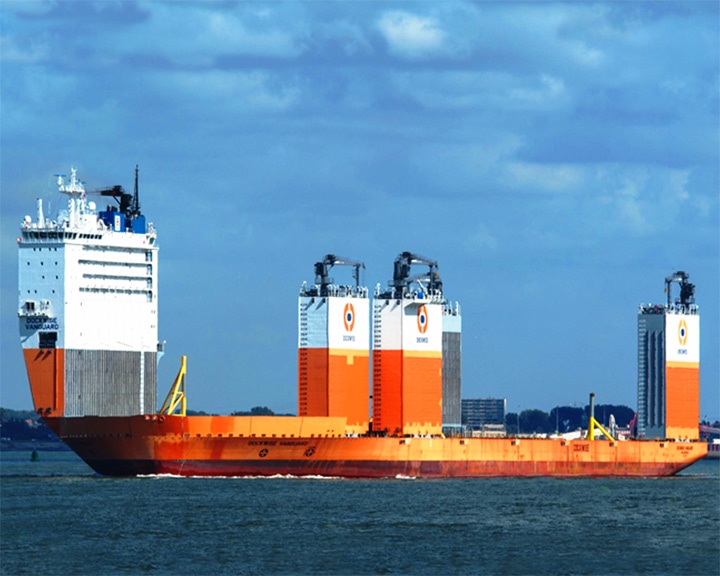 Boka Vanguard — Netherlands heavy-lift ship She is the largest semi-submersible heavy-lift ship ever built and is able to carry cargoes up to 110,000 tonnes. She is capable of lifting ships or rigs out of the water and placing them back into the water. LAUNCHED: 2012, October 7 → FATE: Still in service |
|
|
Page 8
|
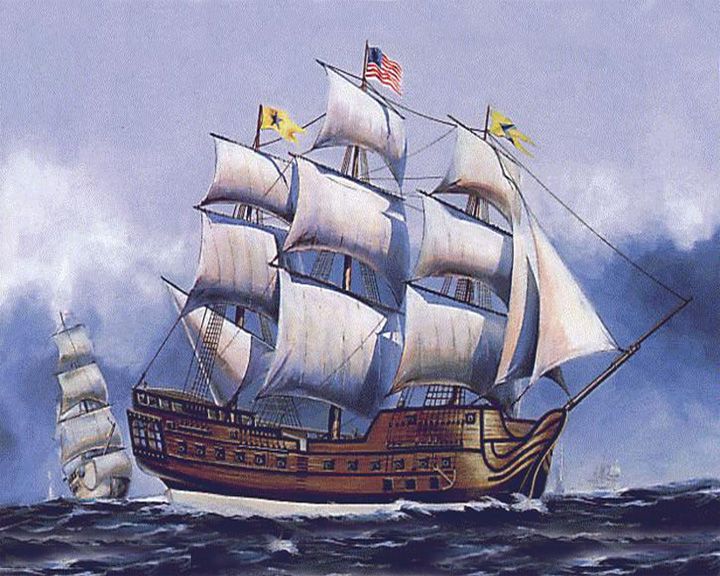 Bonhomme Richard, USS — American frigate Warship commanded by John Paul Jones. She defeated HMS Serapis in the Battle of Flamborough Head. LAUNCHED: 1766 → FATE: Sank in battle off the coast of Yorkshire September 25, 1779. |
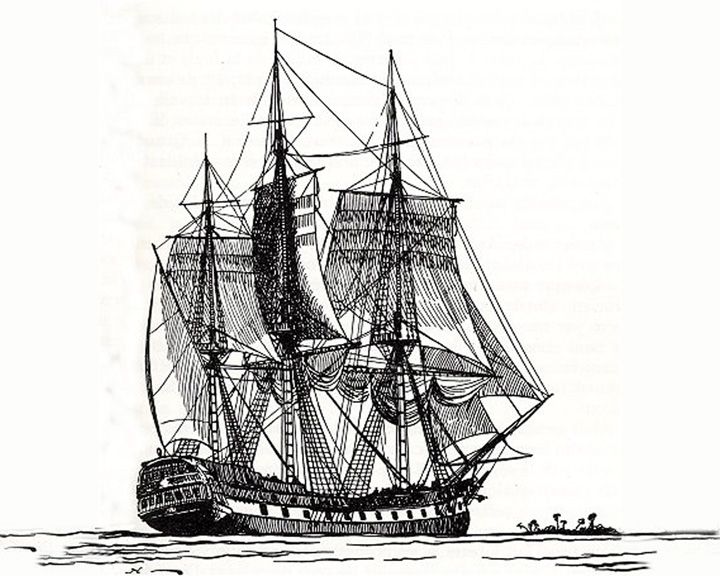 (Another (Another Boudeuse — French frigate First woman to circumnavigate the globe on board, Jeanne Baret, disguised as man. She is also famous as the exploration ship of Louis Antoine de Bougainville, 1766-1769. ("Another IMAGE" is the commemorative stamp issued.) LAUNCHED: 1766, March 18 → FATE: Broken up for firewood at Malta in early 1800. |
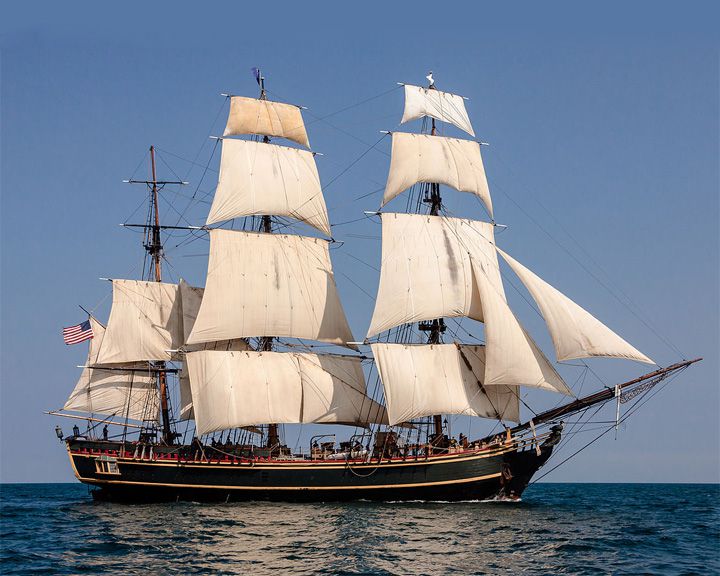 (Another (Another Bounty (replica) — Canadian collier, three-mast (American owned) A reconstruction of the original 1787 Royal Navy ship built for the 1962 movie Mutiny on the Bounty. She also appeared in the 1989 movie Treasure Island and the 2006 and 2007 movies Pirates of the Caribbean. Over the years, she was also used for promotion, entertainment, and education. LAUNCHED: 1960, August 18 → FATE: Sank near North Carolina during Hurricane Sandy on October 29, 2012. |
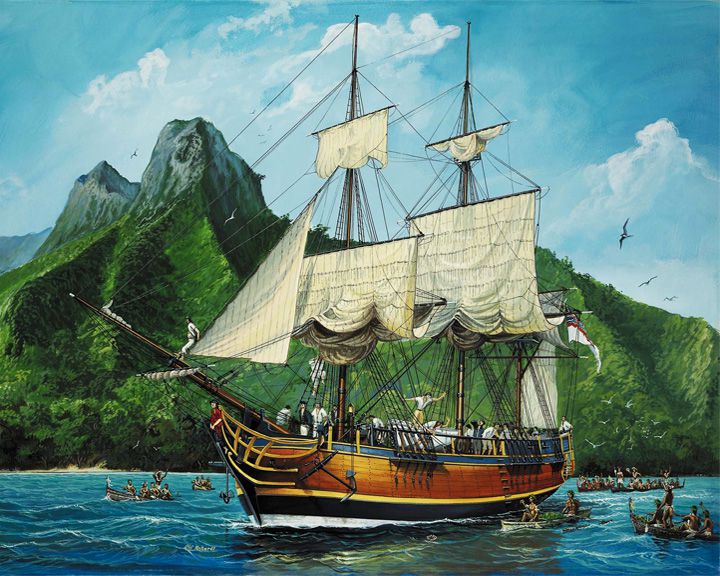 Bounty, HMS — English collier, three-mast Mutiny aboard ship, April 28, 1789, led by Fletcher Christian against Captain William Bligh. Its mission was to pick up breadfruit plants from Tahiti and transport them to the West Indies. The mutiny was dramatized in several books and movies. LAUNCHED: 1784 → FATE: Was burned by the mutineers on January 23, 1790. |
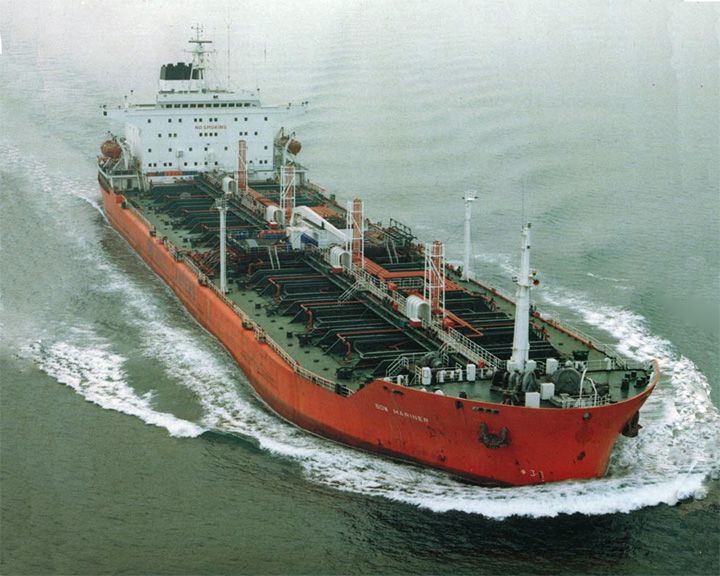 Bow Mariner — Norwegian tanker She exploded and sank taking with her 21 of the 27 crew. At the time of the accident she was carrying 3.5 million gallons of industrial ethanol. She sank in 240 feet of water. LAUNCHED: 1982 → FATE: Sank off the coast of Chincoteague Inlet, Virginia February 28, 2004. |
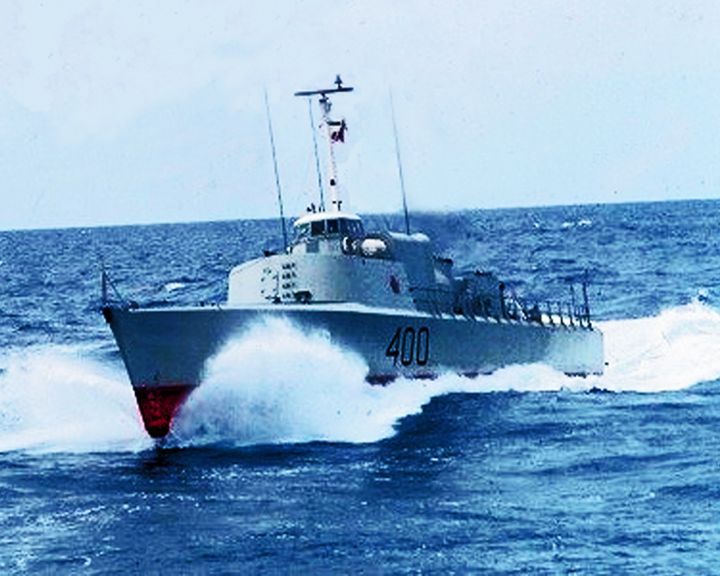 Bras d'Or, HMCS — Canadian hydrofoil The fastest unarmed warship in the world exceeding 63 knots (72 mph). As a project for the testing of anti-submarine warfare technology on an ocean-going hydrofoil, she was never fitted with equipment for warfare. LAUNCHED: 1968, July 12 → FATE: On display at the Musée Maritime du Québec. |
 Britannia, HMY — British yacht Former Royal Yacht of the British monarch, Queen Elizabeth II, and where Prince Charles and Diana took their honeymoon. During her service as Royal Yacht conveying members of the Royal Family and various dignitaries, she steamed 1,087,623 nautical miles or 2,014,278 km. LAUNCHED: 1953, April 18 → FATE: Decommissioned December 11, 1997, now a museum ship at Leith, Edinburgh, Scotland. |
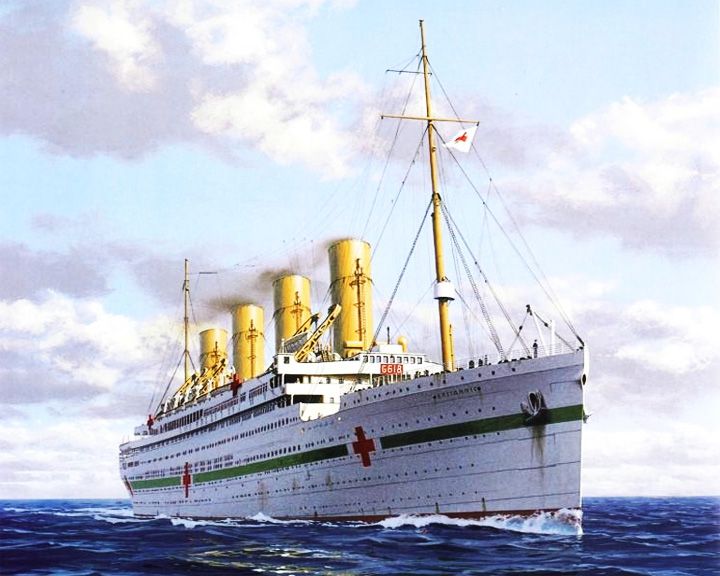 (Another (Another Britannic, HMHS — British ocean liner Largest ship lost during the World War I with the loss of 30 lives. Launched just before the start of the World War I, she was put to use as a hospital ship in 1915. With her loss, SS Bismarck was given to the White Star Line as part of post-war reparations. LAUNCHED: 1914, February 18 → FATE: Struck a mine and sank off the Greek island of Kea November 21, 1916. |
|
|
Page 9
|
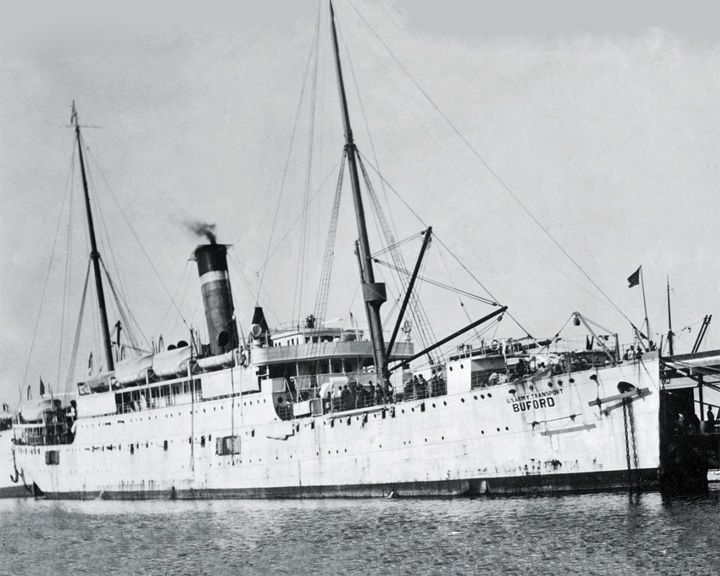 Buford, USAT — American cargo/passenger ship Used to deport 249 non-citizens of the U.S. to Russia because of their alleged anarchist political beliefs; nicknamed the Soviet Ark.. In 1906, rescued over 600 passengers and crew from the SS Mongolia. In 1921, rescued 65 passengers and crew from the inferno of the Japanese steam freighter Tokuyo Maru. Used by Buster Keaton for his film The Navigator. LAUNCHED: 1890, August 29 → FATE: Scrapped in late 1929. |
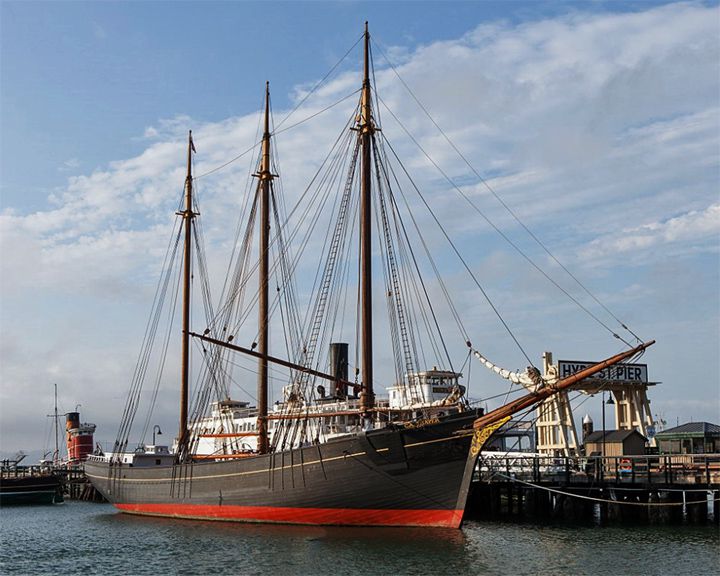 C.A. Thayer — American three-masted schooner Last survivor of the schooners in the West Coast lumber trade. In 1912, she was converted for use in the Alaskan salt-salmon trade. In 1984, she was designated a National Historic Landmark. LAUNCHED: 1895 → FATE: She made her final voyage in 1950. After several restorations, she now is on exhibit at Hyde Stree Pier, San Francisco. |
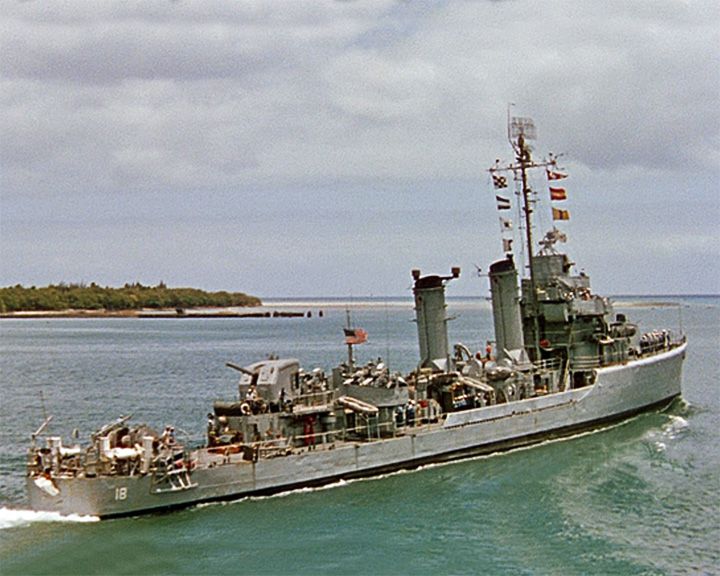 Caine, USS — American destroyer minesweeper The vessel captained by Queeg in the 1951 book The Cain Mutiny and the 1954 movie. In the movie, the USS Thompson (DD-627) was used as the USS Caine. LAUNCHED: 1951, novel, 1954 movie → FATE: Inconclusive. |
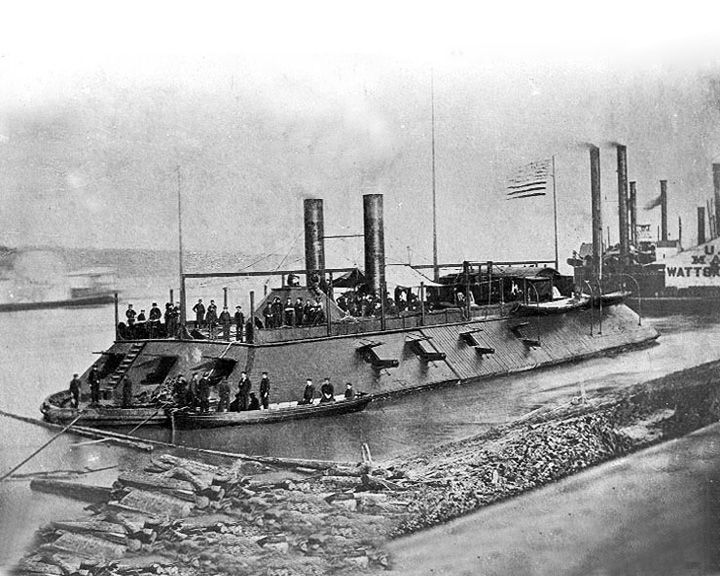 Cairo, USS — American ironclad gunboat First ship sunk by a naval mine and first vessel of the City class ironclads. Served with the Army's Western Gunboat Fleet during the American Civil War. Remnants of the gunboat are in a museum in the Vicksburg National Military Park. LAUNCHED: 1861 → FATE: Sunk by a naval mine in the Yazoo Riveron December 12, 1862. |
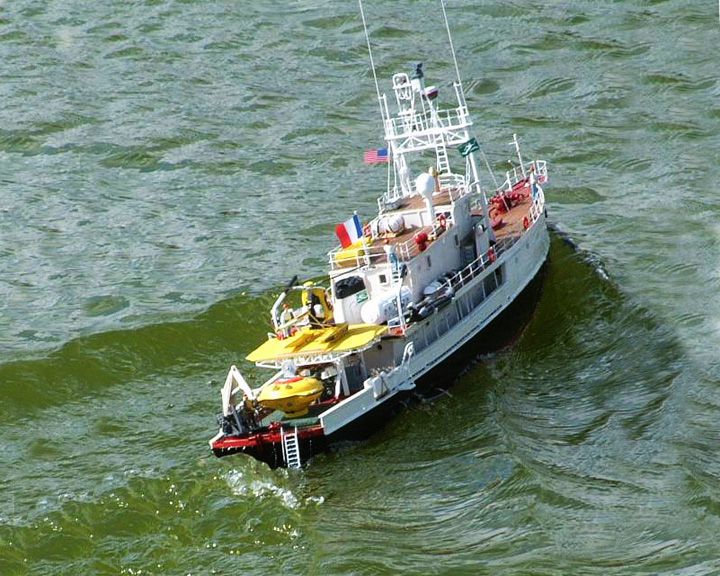 (Another (Another Calypso, RV — American minesweeper built for the British; refitted for research Oceanographer Jacques-Yves Cousteau sailed her as a mobile laboratory for field research. During World War II she served as a minesweeper and carried advanced equipment, including mini submarines. LAUNCHED: 1941, March 21, converted in 1950 → FATE: Sank in 1996, raised, neglected, and now being restored in Brittany. |
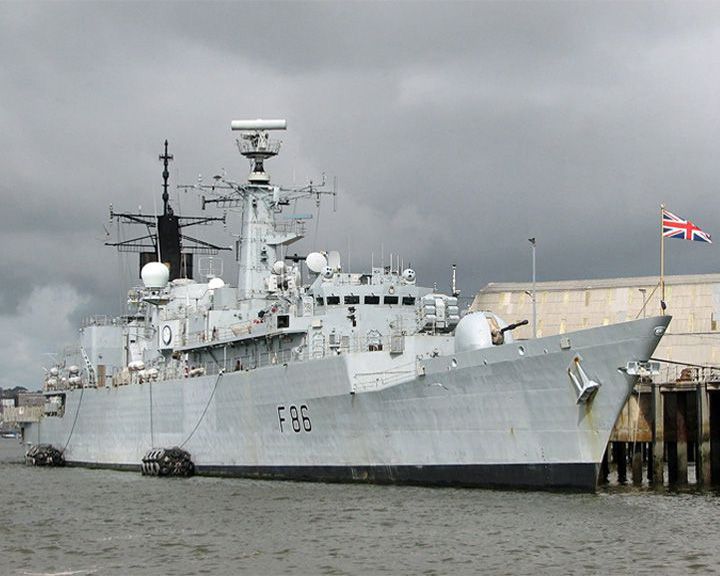 Campbeltown, HMS — American Wickes-class destroyer A most famous ship in the St. Nazaire Raid in 1942 when, packed with explosives, she was rammed into a German port and detonated. The ship and the raid were depicted in the movie Gift Horse. (See Ballantrae, HMS) LAUNCHED: 1919, January 2 as USS Buchanan; given to Britain and renamed in 1940 → FATE: Destroyed March 28, 1942 in the Saint Nazaire Raid, World War II. |
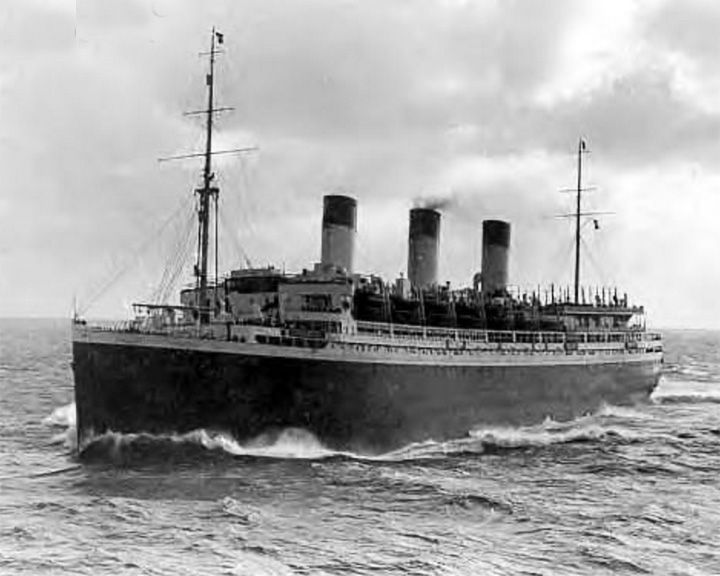 (Another (Another Cap Arcona, SS — German ocean liner Her sinking was one of the biggest maritime losses of life during World War II. Only 350 of the 4,500 former concentration camp inmates aboard the ship survived. LAUNCHED: 1927, May 18 → FATE: Sank on May 3, 1945 after being attacked by an RAF squadron. |
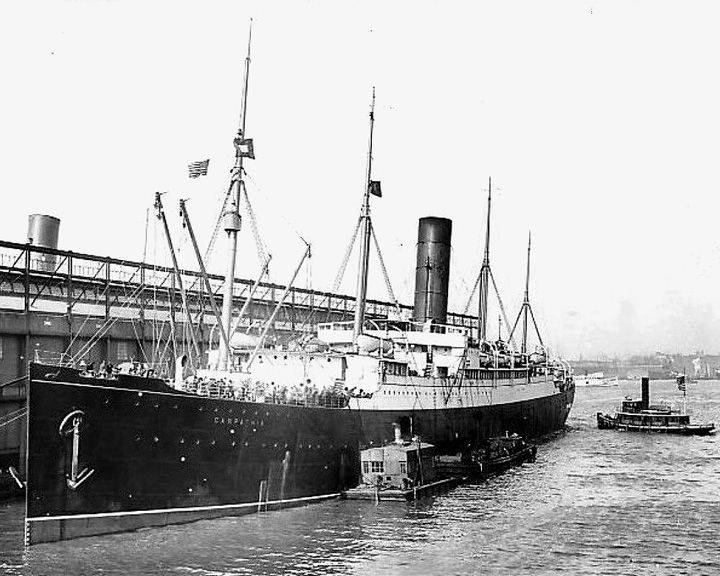 Carpathia — British ocean liner; (Cunard Line passenger steamship) Became famous for rescuing survivors of RMS Titanic on April 15, 1912. After sailing through dangerous ice fields, she arrived at the sinking Titanic at 4:00 am and took on 705 survivors from lifeboats. LAUNCHED: 1902, August 18 → FATE: Sunk in the Atlantic on July 17, 1918 during World War I by a German submarine, the fifth Cunard ship sunk in as many weeks. |
|
|
Page 10
|
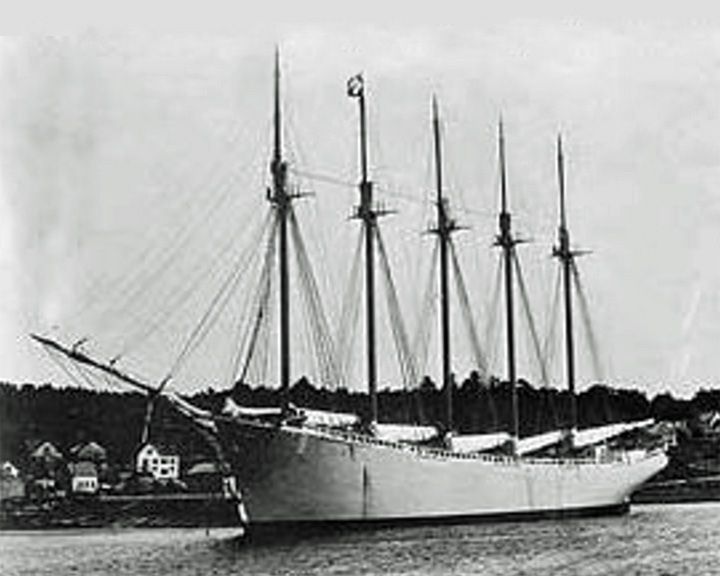 Carroll A. Deering — American five-masted commercial schooner A famous maritime mystery after she was found with her crew of 11 missing. Theories of her demise include piracy, mutiny, hurricane, and paranormal events. Nine other ships also disappeared without a trace in that same area at about the same time. LAUNCHED: 1919 → FATE: Found wrecked off Cape Hatteras on January 31, 1921; scuttled on March 4 that year. |
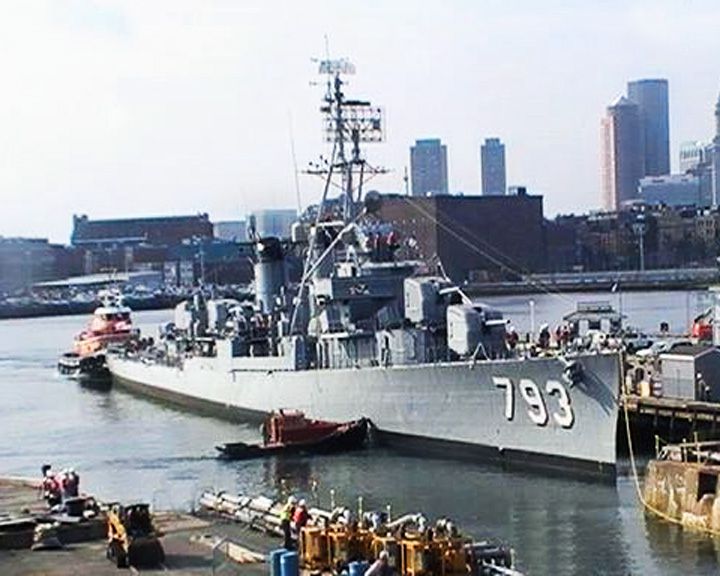 Cassin Young, USS — American destroyer in World War II One of only four surviving Fletcher-class destroyers still afloat. Named for Captain Cassin Young (1894-1942), who was killed in the Naval Battle of Guadalcanal. LAUNCHED: 1943, September 18 → FATE: Docked at the Boston Navy Yard as a museum ship as a museum ship. |
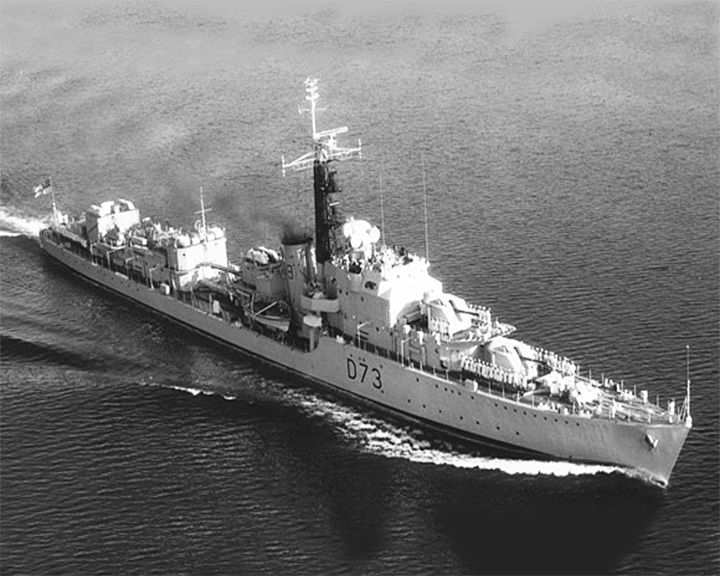 Cavalier, HMS — British C-class Destroyer Because of her high speed, she escorted the RMS Queen Mary and RMS Queen Elizabeth carrying troops across the Atlantic Ocean. In the summer of 2009 the Chatham Historic Dockyard Trust made available accommodation on board the ship for youth groups who wish to stay on board and experience life on board a Royal Naval Destroyer. LAUNCHED: 1944, April 18 → FATE: Preserved as a museum ship since 1998, now at the Chatham Historic Dockyard |
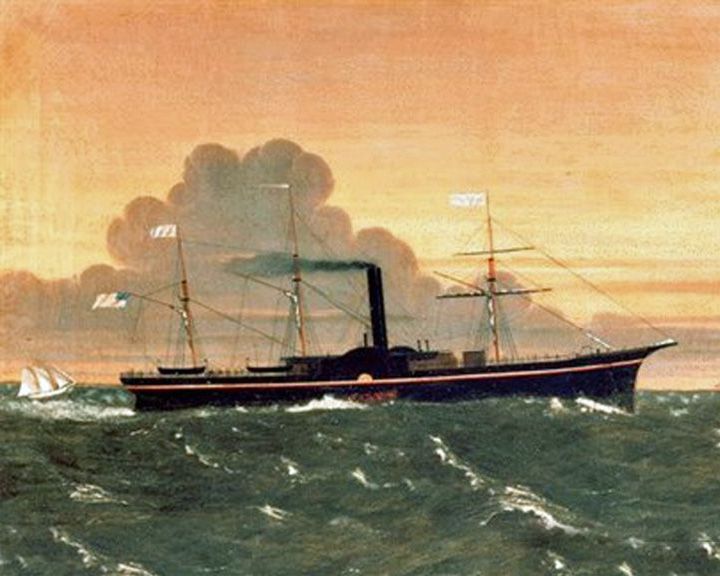 (Another (Another Central America, SS — American paddle steamboat, stern-wheeler; three-masted Sank in a hurricane in 1857, along with 400 passengers and crew and 30,000 pounds of gold. She operated between Central America and the eastern coast of the United States during the 1850s. LAUNCHED: 1852, October 18 → FATE: Sank on September 12, 1857 about 160 miles east of Cape Hattera. |
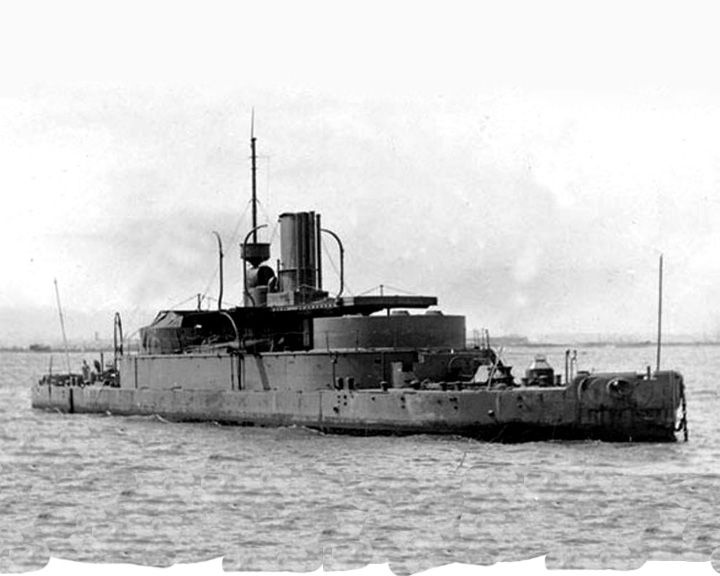 (Another (Another Cerberus, HMVS — Australian breastwork monitor; iron-clad On her maiden voyage from Chatham, England to Melbourne, Australia, she traveled 123 days and over 12,700 miles (20,400 km) with the assistance of temporary sails and frequent stops to refuel wherever possible. During her life, she never left Port Philip Bay and never fired in anger. LAUNCHED: 1868, December 18 → FATE: Sunk as breakwater on September 2, 1926 off Half Moon Bay becoming a popular site for scuba diving. |
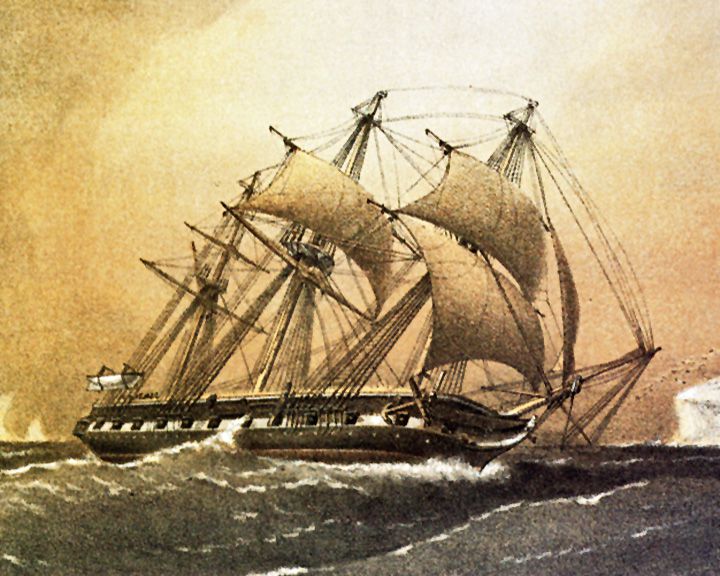 (Another (Another Challenger, HMS — British corvette; steam-assisted Undertook the first global marine research expedition. She was the flagship of the Australia Station between 1866 and 1870. LAUNCHED: 1858, February 18 → FATE: Broken up for her copper end in England in January, 1921. |
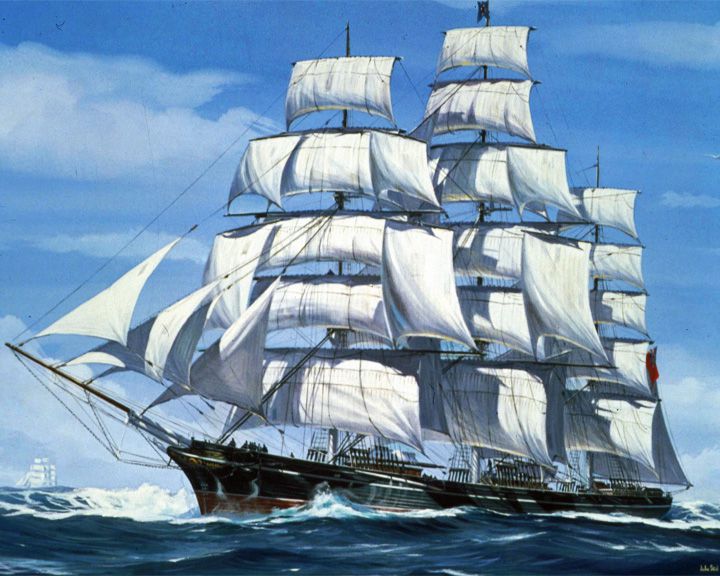 Champion of the Seas — English clipper ship On her maiden voyage, she set a record for the fastest run in 24 hours of 465 nautical miles or 861 km. She was the passenger ship built for the run from Liverpool, England to Melbourne, Australia. LAUNCHED: 1854, April 18 → FATE: Abandoned off Cape Horn in leaking condition in 1877. |
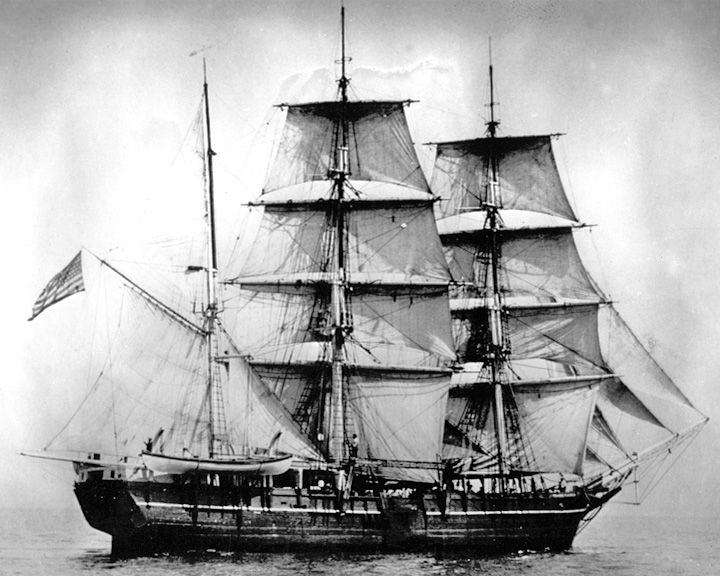 (Another (Another Charles W. Morgan — American whaling ship World's oldest surviving merchant vessel; America's only surviving wooden whaleship. After a 5-year, multi-million dollar restoration, she set sail again, July, 2013. LAUNCHED: 1841 → FATE: On exhibit at the Mystic Seaport museum in Mystic, Connecticut. |
|
|
Page 11
|
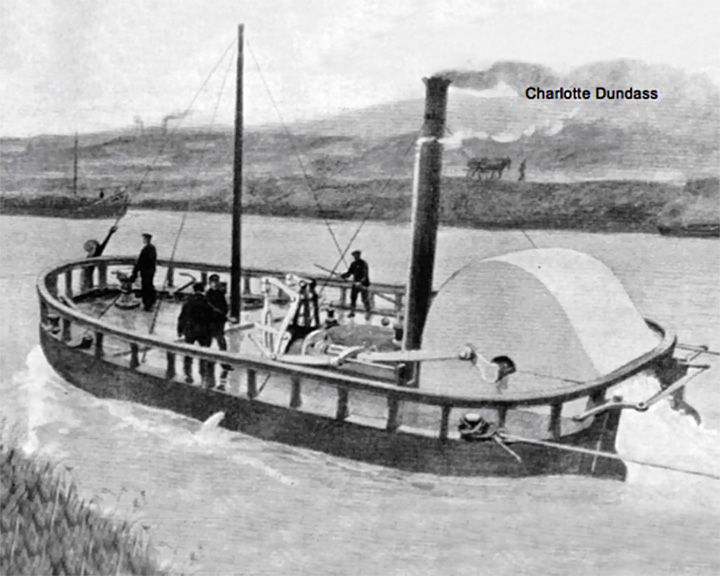 Charlotte Dundas — Scottish steamboat using paddlewheels First towing steamboat and first practical steamboat (second overall); the boat demonstrated the practicality of steam power for ships. Develop by William Symington, the boat employed a horizontal steam engine directly linked to a crank. LAUNCHED: 1801 → FATE: Unknown. |
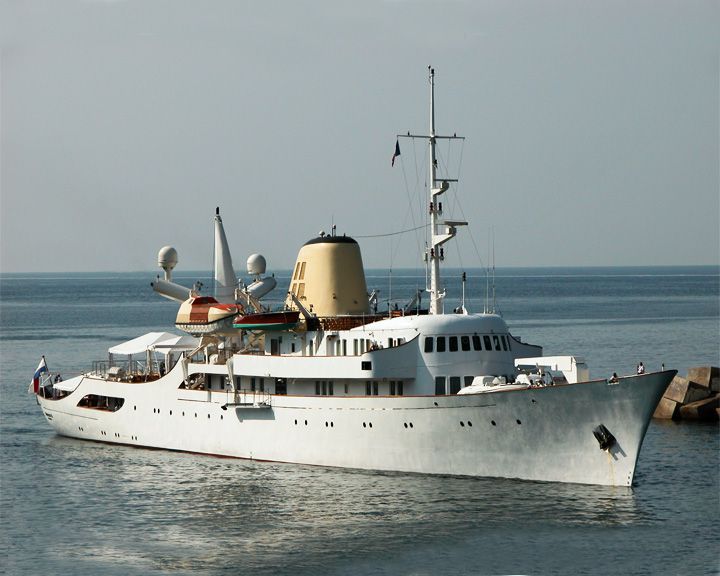 (Another (Another Christina O — Greek luxury yacht Famous yacht of Ari Onassis and his wife, former first lady, Jackie Kennedy. Originally a Canadian built anti-submarine River-class frigate, after WWII, she was purchased by Onassis, refitted as one the largest yachts in the world, and hosted many famous personalities. LAUNCHED: 1943, July 18 → FATE: Available for charter cruises from many ports. |
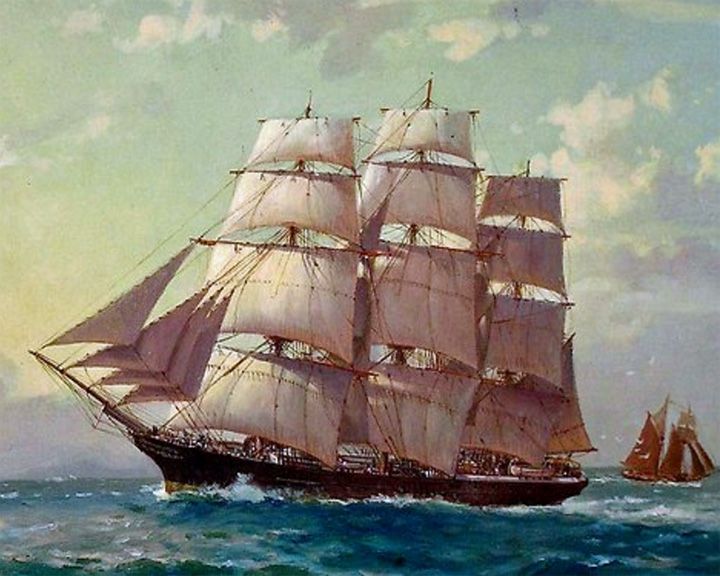 City of Adelaide — English clipper ship The world's oldest surviving clipper ship. From 1864 to 1887, she played an important part in the immigration of Australia. She is now part of the National Historic Ships of the United Kingdom. LAUNCHED: 1864, May 18 → FATE: Out of service since 1948, current being restored. |
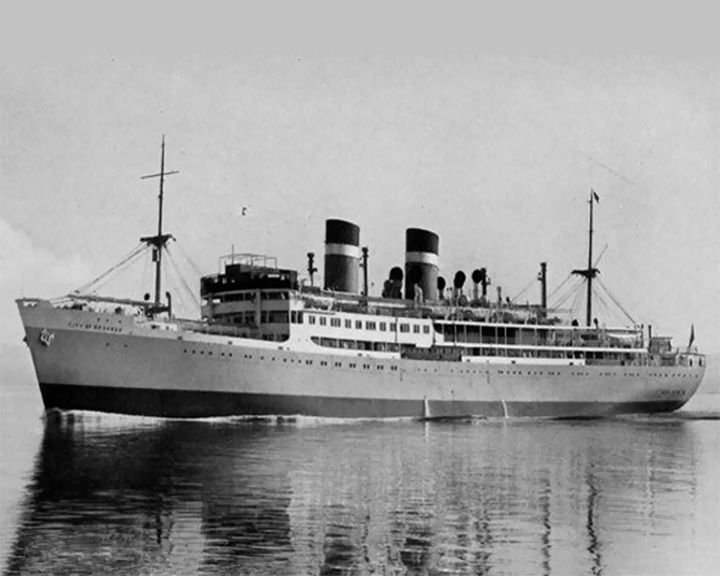 City of Benares, SS — British steam passenger ship The ship taking English evacuated children to Canada torpedoed during World War II by a German submarine. 260 of the 407 people on board were lost including 77 children. The sinking reportedly inspired actress and inventor Hedy Lamarr to develop and patent a system of spread spectrum radio as a means to guide anti-ship torpedoes. LAUNCHED: 1935, August 5 → FATE: Sunk September 18, 1940. |
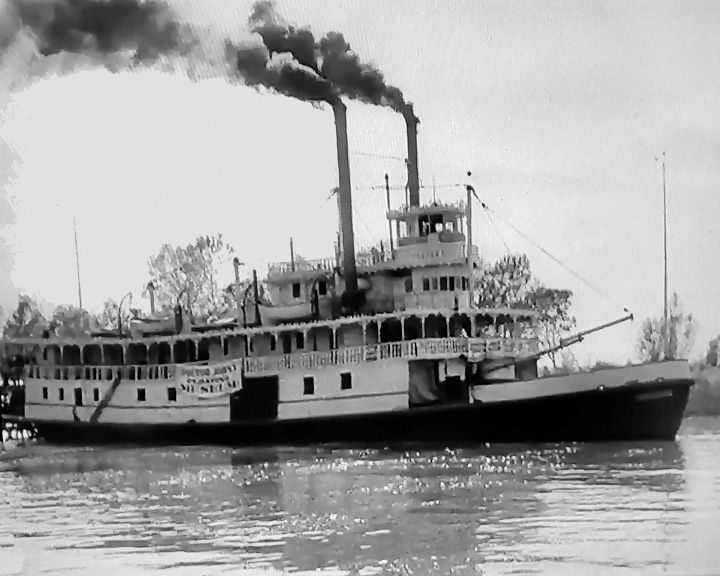 (Another (Another Claremore Queen — American steamboat A movie about a con man enters his steamboat in race in the 1890s. Other boat seen in "Another IMAGE". . The movie was Will Roger's last and was released after he was killed in an airplane crash 1935. LAUNCHED: 1933, movie release → FATE: Inconclusive. |
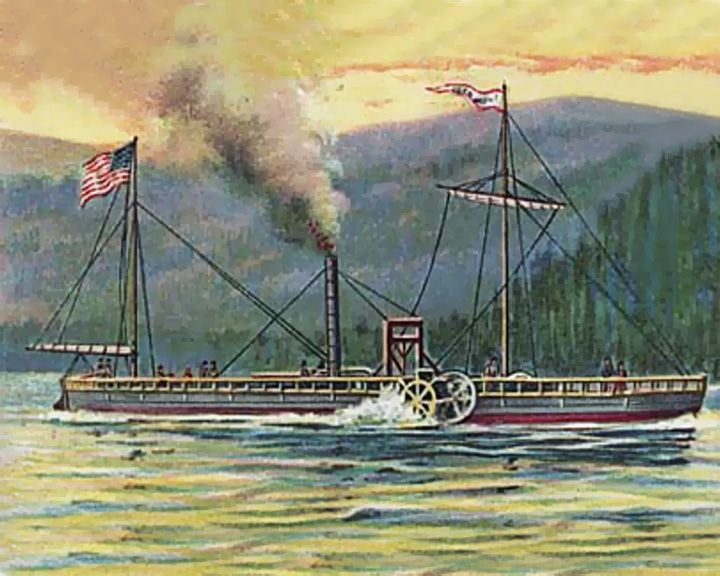 Clermont — American river steamboat First enduring and financially successful steamboat, running on the Hudson River. She was never known as Clermont at the time, but North River Steamboat. After it was lengthened and refitted in 1808 at Clermont, NY, it was named the North River. LAUNCHED: 1807, August 18 → FATE: Retired in 1814, then scrapped. |
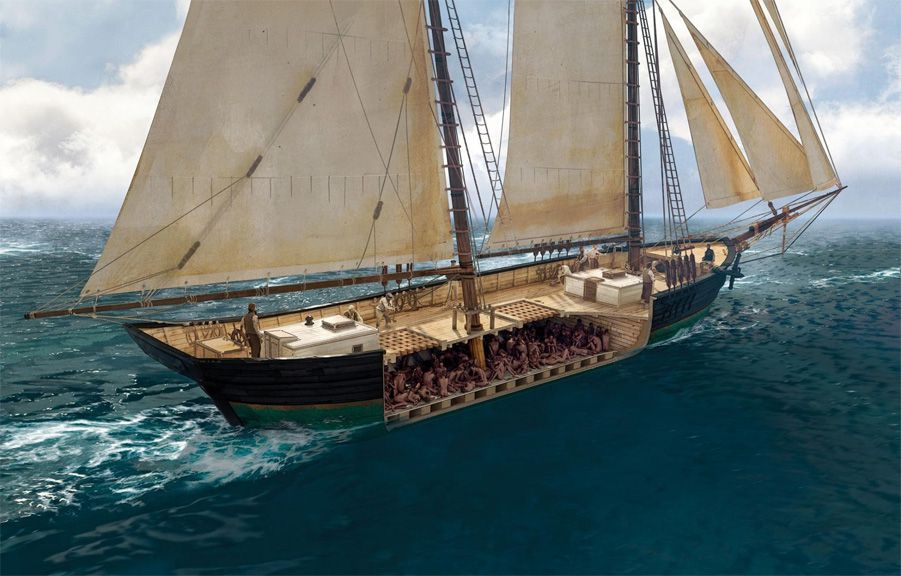 Clotilda — American two-masted schooner Last known slave ship to bring captives from Africa to the United States. The shipwreck was discovered in early 2019. LAUNCHED: 1855 → FATE: Burned and sunk in the Mobile-Tensaw River Delta probably in 1860. |
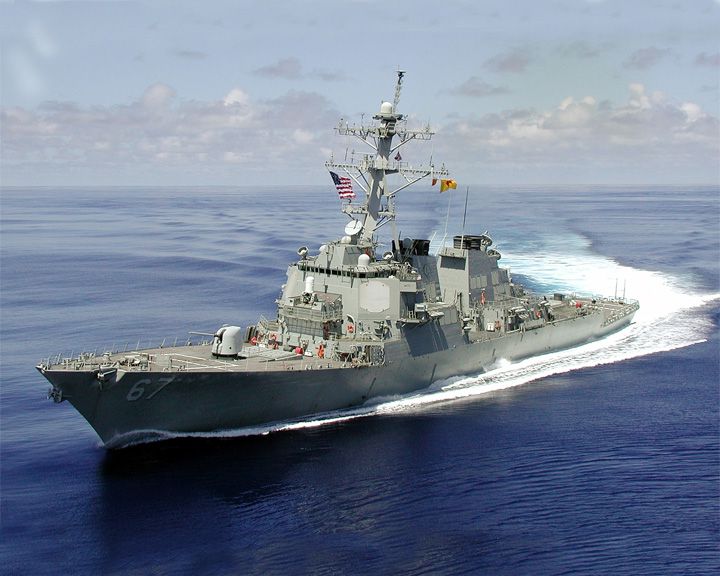 (Another (Another Cole, USS — American aegis-equipped guided missile destroyer In the news because of a suicide attack against it on October 12, 2000. Seventeen American sailors were killed in the incident while harbored in the Yemeni port of Aden. LAUNCHED: 1995, February 18 → FATE: Still in service. |
|
|
Page 12
|
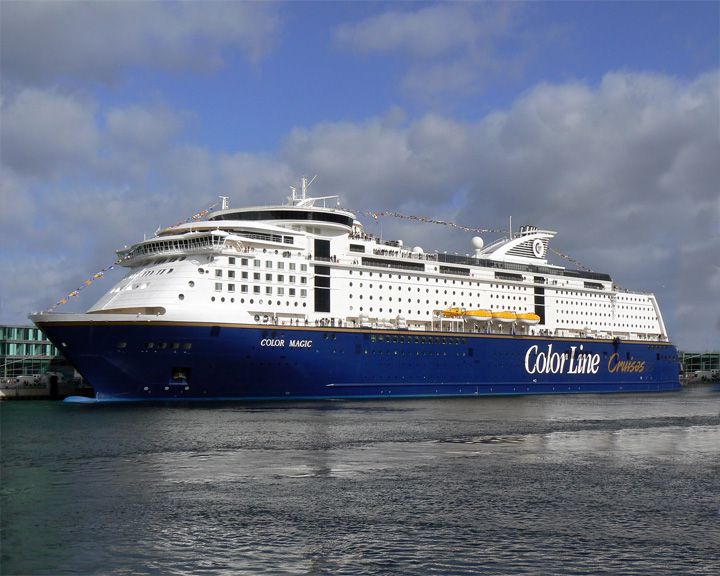 Color Magic — Norwegian cruise ferry The largest cruise ferry in the world. The ship operates between Oslo, Norway and Kiel, Germany. LAUNCHED: 2006, December 18 → FATE: Still in service. |
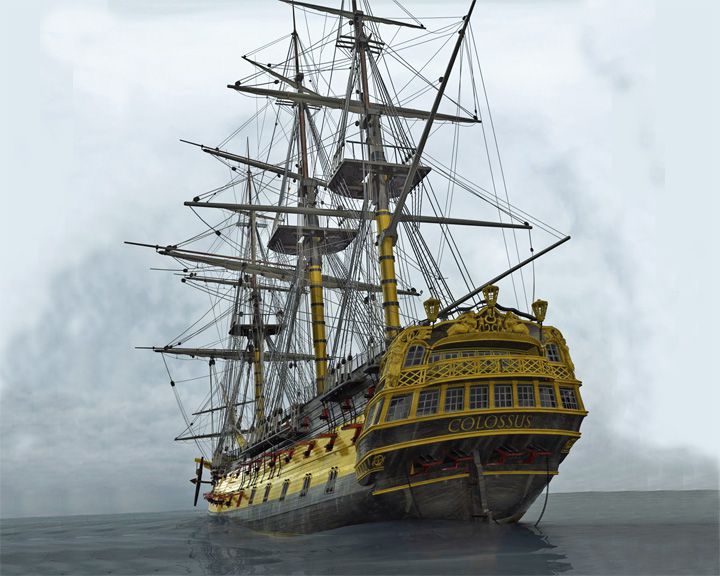 Colossus, HMS — British third-rate ship of the line After many battles and much glory, she lost her way and ran aground and sunk with one fatality. In 1974, fragments from the Colossus were discovered and reconstructed and are now displayed at the British Museum in London. LAUNCHED: 1787, April → FATE: Wrecked of the Isles of Scilly December 10, 1798. |
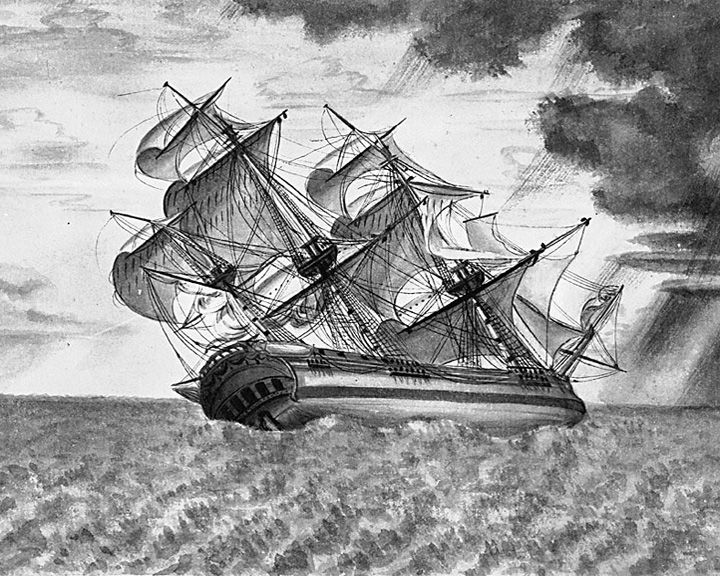 Columbia Rediviva — American full-rigged 3 masted sailing ship First American ship to circumnavigate the globe. In 1792, Captain Robert Gray in command, she was the first ship to enter the Columbia River in the Pacific Northwest. LAUNCHED: 1787 → FATE: Salvaged in 1806. |
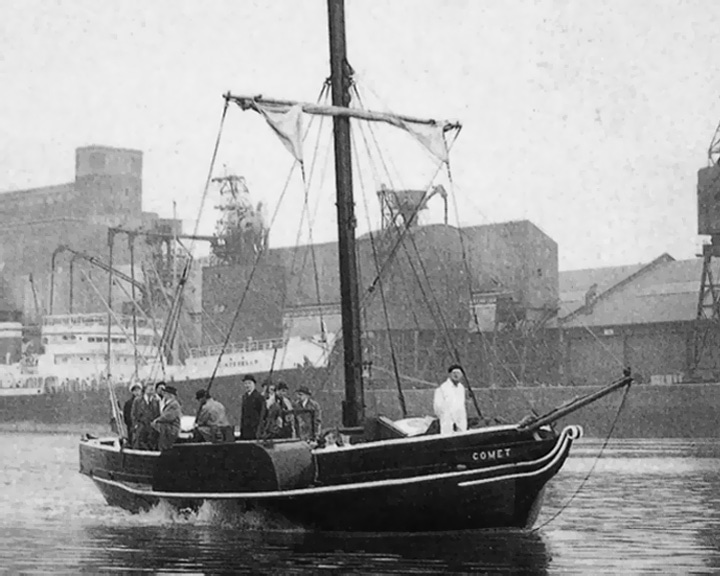 Comet, PS — British paddle steamer First commercially successful steamboat service in Europe on the River Clyde between Glasgow and Greenock in Scotland. The success of this passenger service quickly inspired competition and the Comet was soon outclassed by newer steamers. LAUNCHED: 1812, August 18 → FATE: Wrecked in strong currents at Craignish Point near Oban on December 13, 1820. |
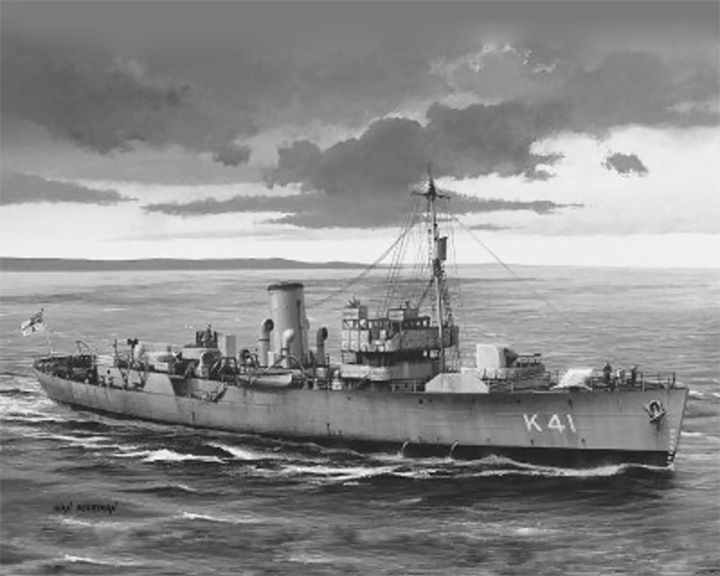 Compass Rose — British Flower-class corvette The ship portrayed in the movie The Cruel Sea, about the conditions in which the Battle of the Atlantic was fought between the Royal Navy and Germany's U-boats. The movie ship was portrayed by the Flower-class corvette HMS Coreopsis. LAUNCHED: 1953 → FATE: Inconclusive. |
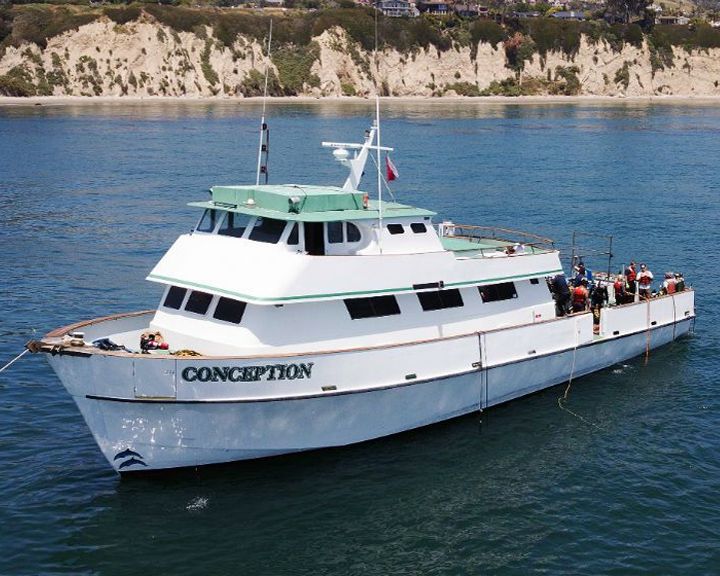 (Another (Another Conception, MV — American dive boat One of the worst maritime disaster in California with the loss of 34 passengers. The boat had been refurbished at a cost of more than $1 million following an incident in 2005 when it had been stolen and run aground. LAUNCHED: 1981 → FATE: Caught fire and eventually sank off the coast of Santa Cruz Island, California, September 2, 2019. |
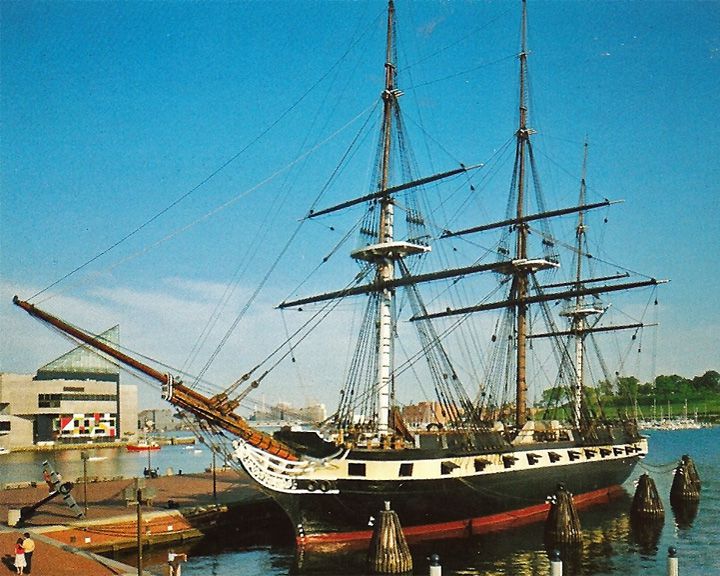 Constellation, USS — American sloop-of-war The last sail-only warship designed and built by the U.S. Navy. This flagship of the USN African Squadron from 1859-1861 disrupted the African slave trade off the coast of Africa. LAUNCHED: 1854, August 18 → FATE: On display at Annapolis, Maryland as a museum ship. |
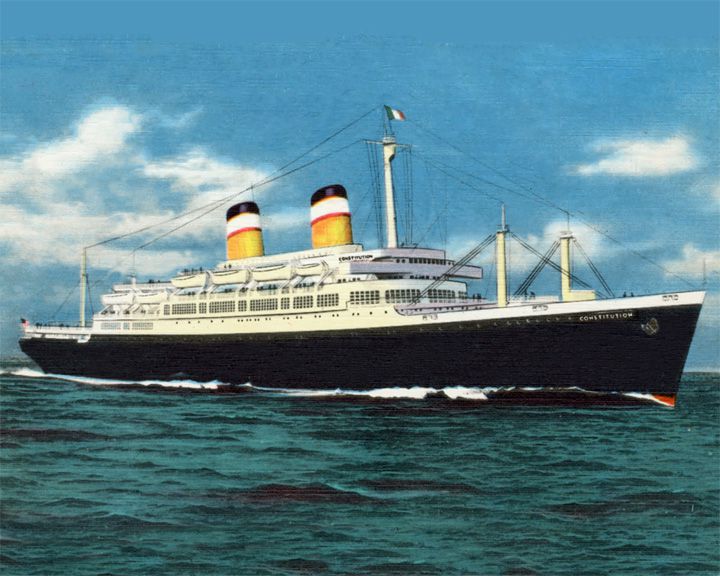 Constitution, SS — American ocean liner Because of her post-war modernity, the ship was featured in the 1957 movie An Affair to Remember and in several TV series, such as the situation comedy I Love Lucy. She and her sister-ship, SS Independence, were innovative ocean liners with an informal, yet luxurious, atmosphere uncommon in passenger ships prior to World War II. LAUNCHED: 1950, September 18 → FATE: Sank November 17, 1997 while under tow to be scrapped north of the Hawaiian Islands. Sister-ship, SS Indepedence, suffered a worst demise. |
|
|
Page 13
|
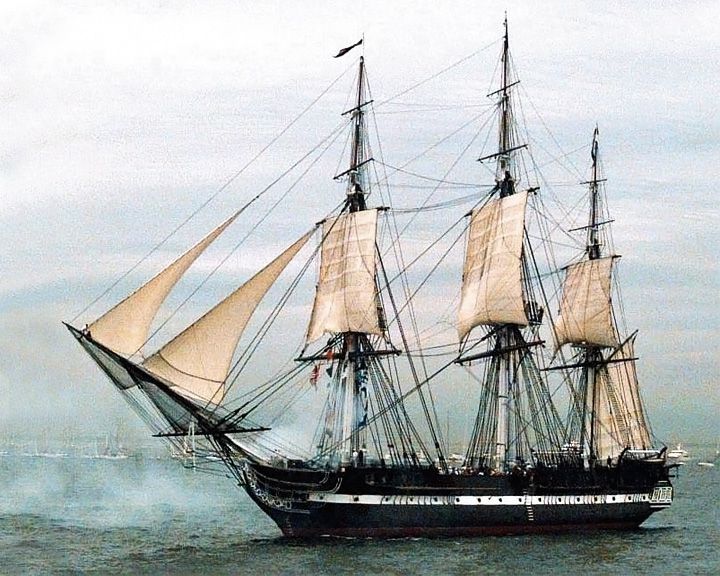 Constitution, USS — American three-masted heavy frigate Oldest commissioned ship afloat in the world. She was larger and more heavily armed than the standard frigates of the period. LAUNCHED: 1797, October 18 → FATE: On display at the Boston Navy Yard as a museum ship. |
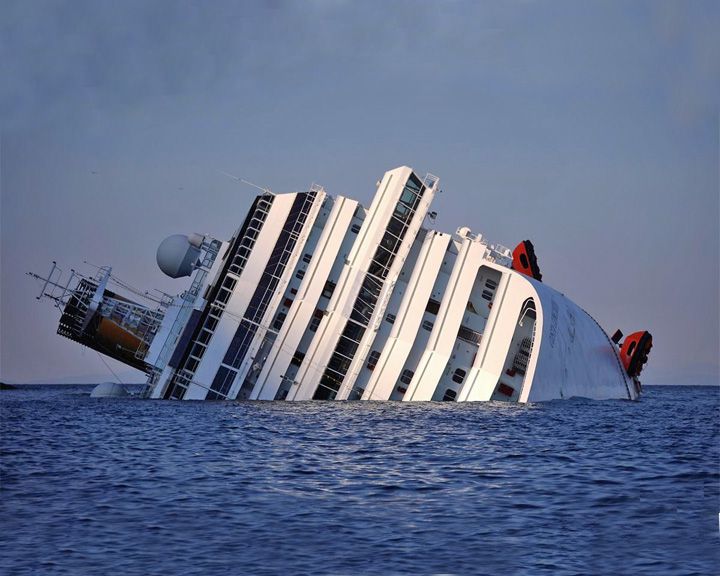 (Another (Another Costa Concordia — Italian cruise ship Largest cruise ship disaster; ran aground on a reef off Isola del Giglio and capsized; 32 people dead. In 2008, she suffered damage to her bow when high winds pushed the ship alongside its dock. LAUNCHED: 2005, September 18 → FATE: Capsized January 13, 2012. |
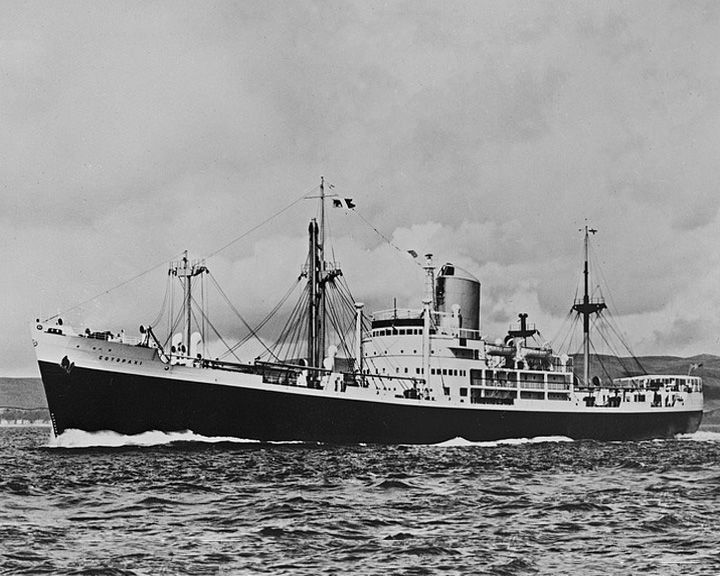 Cotopaxi, SS — American bulk carrier She disappeared on a voyage from Charleston, S.C., to Havana, Cuba; none of the 32 people on board were ever seen again. She became part of the legend of the Bermuda Triangle even though she was found outside that area. In the movie Close Encounters of the Third Kind, aliens are responsible for the ship's disappearance. LAUNCHED: 1918, November 15 → FATE: Lost 35 miles off St. Augustine in Florida, December, 1925. |
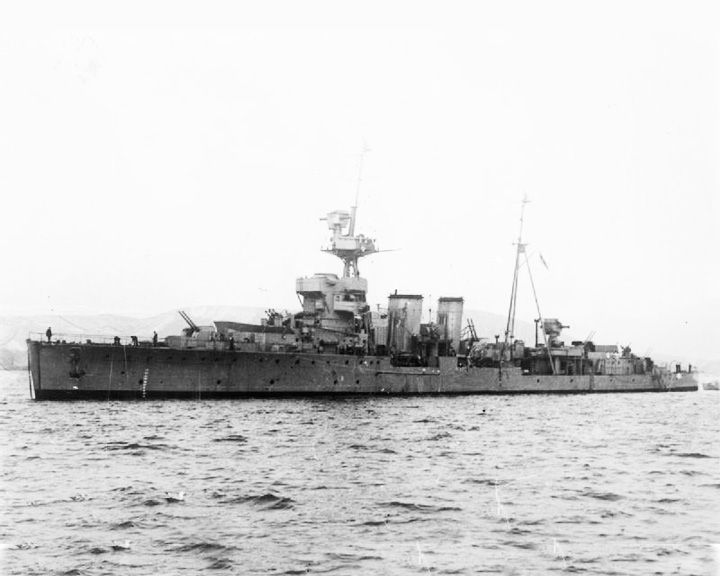 Curacoa, HMS — British light-cruiser Accidentally sliced in half and sunk by the ocean liner RMS Queen Mary, with the loss of 337 men. Her demise came while escorting convoy ships during World War II. Those who witnessed the collision were sworn to secrecy due to national security concerns. LAUNCHED: 1917, May 5 → FATE: Sunk in collision with HMS Queen Mary, 1942, October 2. |
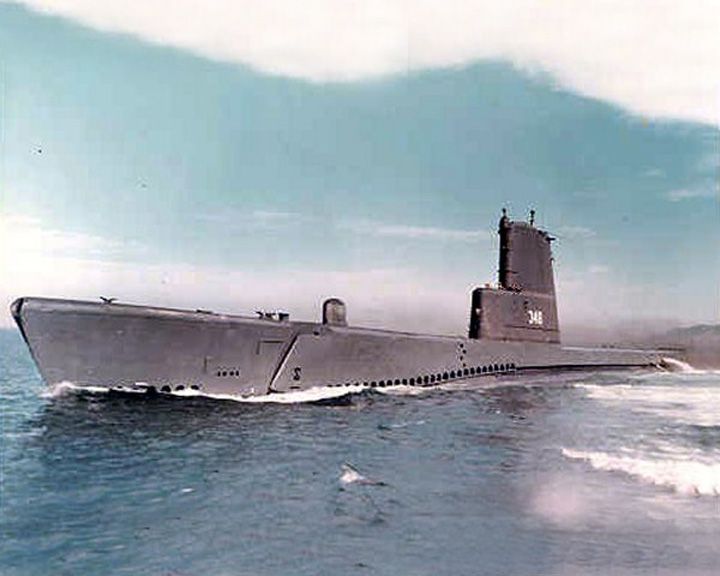 Cusk, USS — American submarine The first submarine to launch a guided missile from her deck. She appeared in the 1950 movie The Flying Missile as the USS Bluefin. LAUNCHED: 1945, July 18 → FATE: Sold for scrap June 26, 1972. |
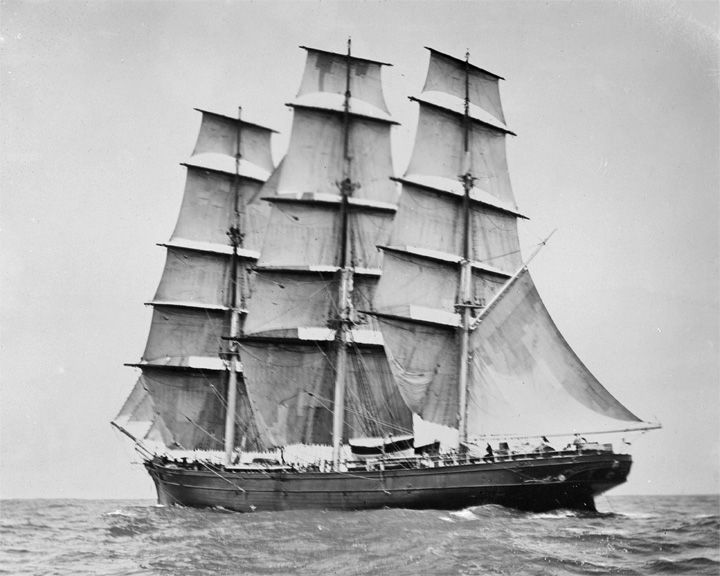 (Another (Another Cutty Sark — English clipper ship Lost China-to-London race to ship called Thermopylae. She is one of three remaining original composite construction (wooden hull on an iron frame) clipper ships from the nineteenth century. LAUNCHED: 1869, November 18 → FATE: Now preserved in dry dock in Greenwich, England. |
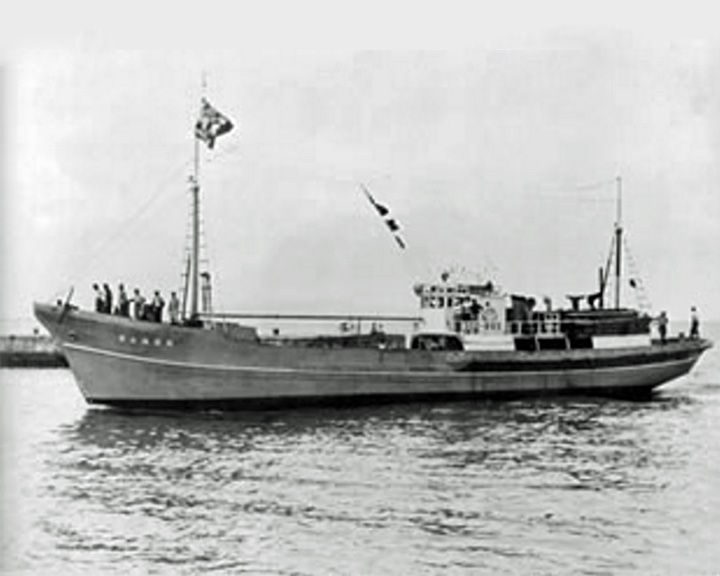 Daigo Fukuryu Maru — Japanese fishing boat First victim of a hydrogen bomb died of radiation poisoning because the ship was too near the test zone. On on March 1, 1954, the boat was contaminated by nuclear fallout from the US's Castle Bravo thermonuclear test on Bikini. On Sept. 23, 1954, the ship's radio operator, Aikichi Kuboyama, succumbed. LAUNCHED: 1947 → FATE: Now on display in Tokyo at the Tokyo Metropolitan Daigo Fukuryu Maru Exhibition Hall in Yumenoshima Park. |
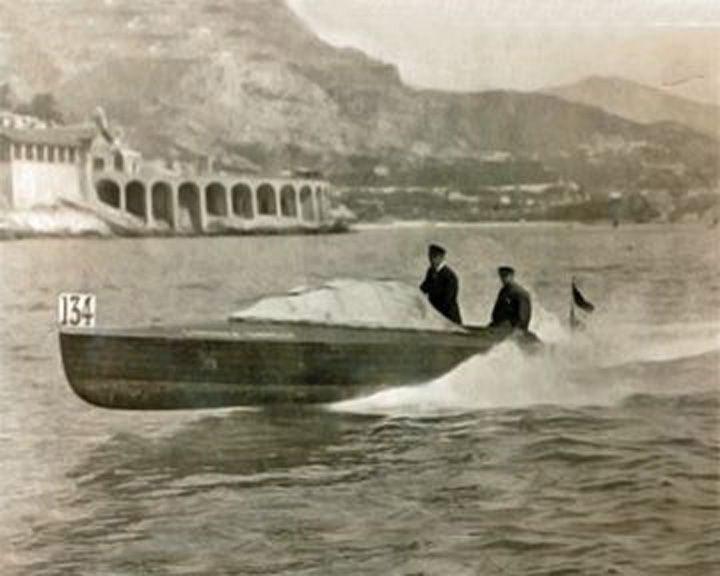 |
|
|
Page 14
|
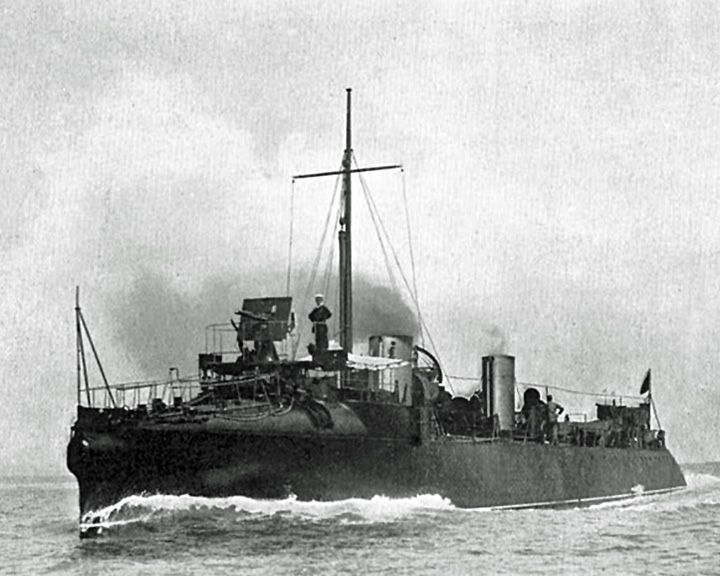 Darling, HMS — British torpedo boat destroyer First destroyer-type ship. Created to defend against torpedo boats. She was described at the time as the "fastest boat ever" having achieved a speed over 28 knots. LAUNCHED: 1893, November 18 → FATE: Scrapped in 1912. |
 (Another (Another David, CSS — American Confederate torpedo boat A cigar-shaped boat with explosives on the end of a spar projecting forward from her bow. Surface vessel designed to operate very low in the water, resembling a submarine. LAUNCHED: 1863 → FATE: Unknown. |
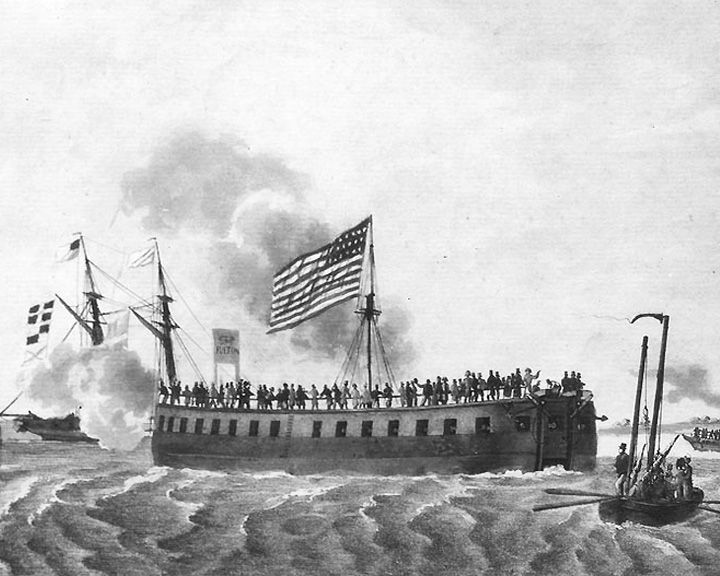 (Another (Another Demologos — American paddle steamers with a catamaran hull First warship to be propelled by a steam engine. Designed by Robert Fulton, with the steam engine between a double hull, no other ship like her was ever built. (See "Another IMAGE" for cross view of her structure.) LAUNCHED: 1815 → FATE: Accidentally blown up in the Brooklyn Navy Yard on June 4, 1829. |
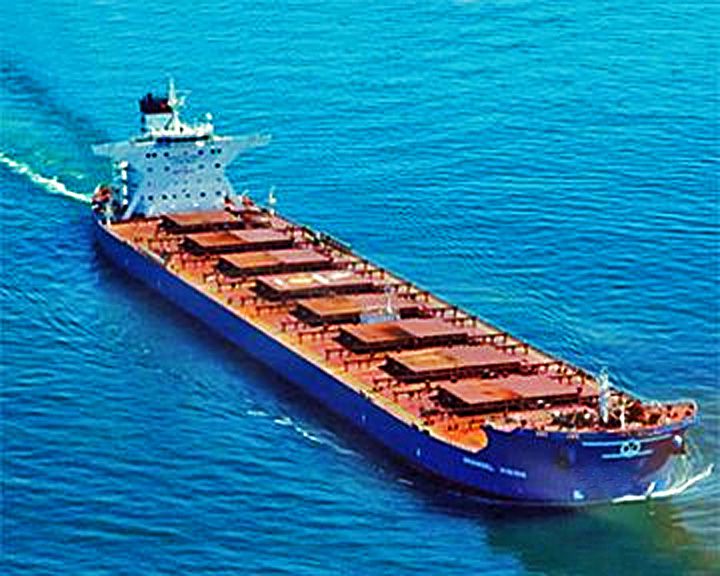 Derbyshire, MV — British cargo ship, oil-ore Largest British ship ever to have been lost at sea. All 42 crew members and two wives were lost with the ship during Typhoon Orchid in 1980. LAUNCHED: 1976, June → FATE: Sank south of Japan September 9, 1980. |
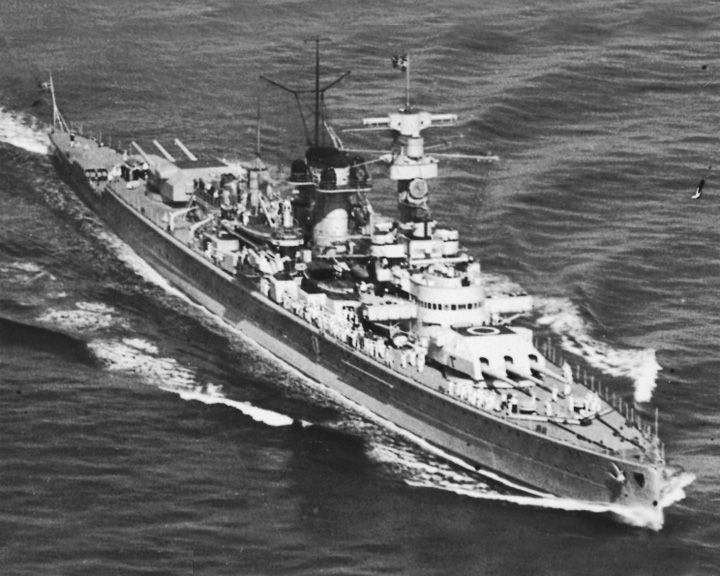 Deutschland — German pocket battleship Lead ship of her class serving in the German Kriegsmarine before and during World War II. Renamed Lützow in November of 1939, because Adolf Hitler feared loss of a ship named Deutschland would make for bad propaganda. LAUNCHED: 1931, May 18 → FATE: Sunk in the Baltic sea July 20, 1947. |
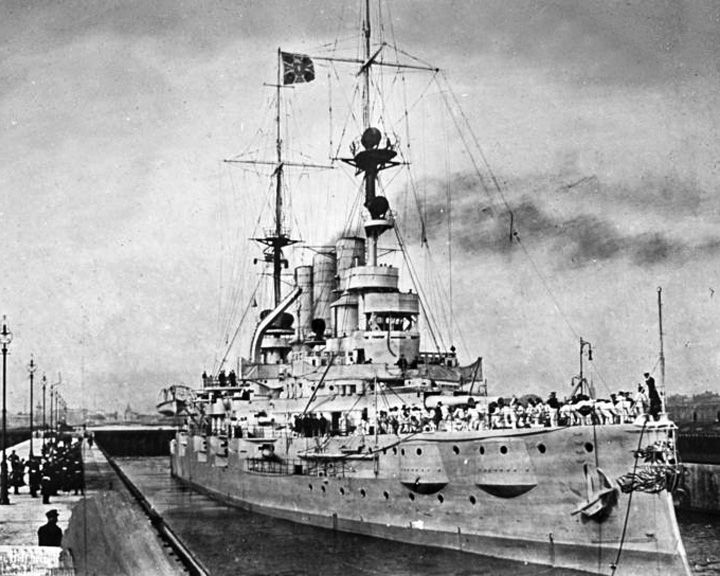 Deutschland, SMS — German battleship First of five Deutschland class pre-dreadnought battleships built for the Kaiserliche Marine between 1903 and 1906. With the launching of the big-gun English HMS Dreadnought battleship, the SMS Deutschland became obsolete. LAUNCHED: 1904, November 18 → FATE: Scrapped in 1920. |
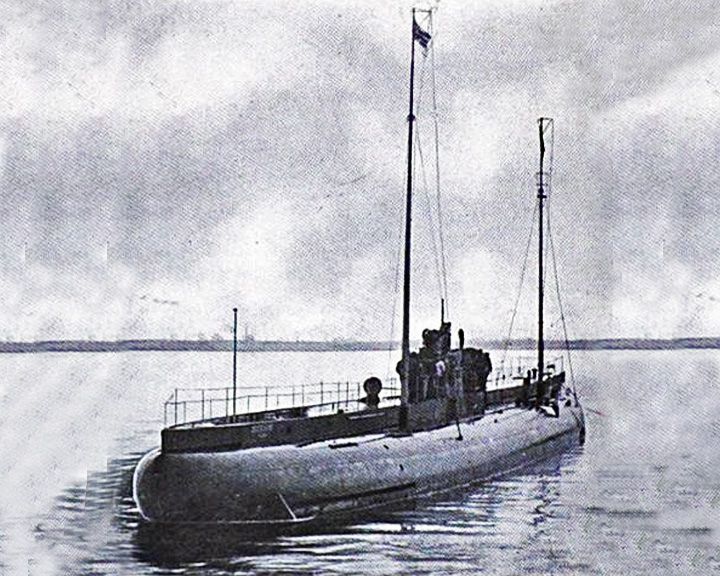 Deutschland, submarine — German submarine First submarine to cross the Atlantic Ocean. She was a blockade-breaking German merchant submarine used during World War I. LAUNCHED: 1916, March 28; converted 1917 June → FATE: Broken up at Morecambe, England in 1922. |
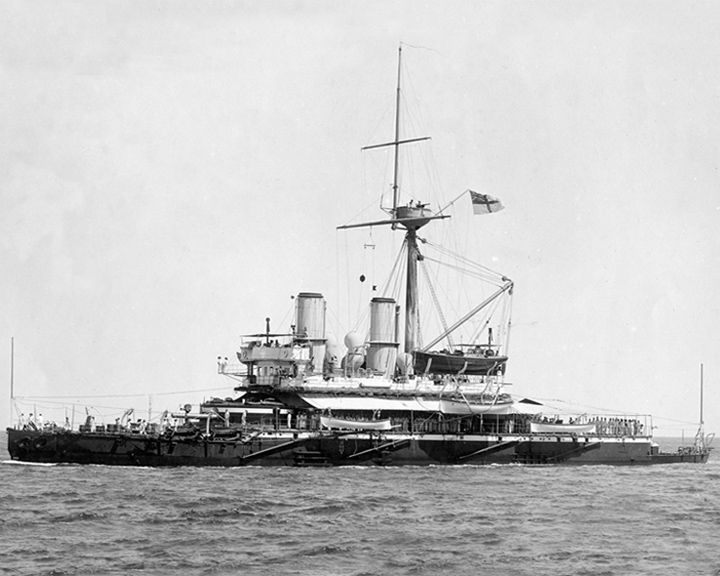
Devastastion, HMS — British Devastation-class ironclad The first ocean-going capital ship not carry sails, and the first with the entire main armament mounted on top of the hull rather than inside it. Originally conceived as a ocean-going breastwork monitor, she was redesignated as 2nd Class Turret ships in 1886 and finally as 2nd Class Battleships by the 1900. LAUNCHED: 1874 → FATE: Was scrapped in 1908. |
|
|
Page 15
|
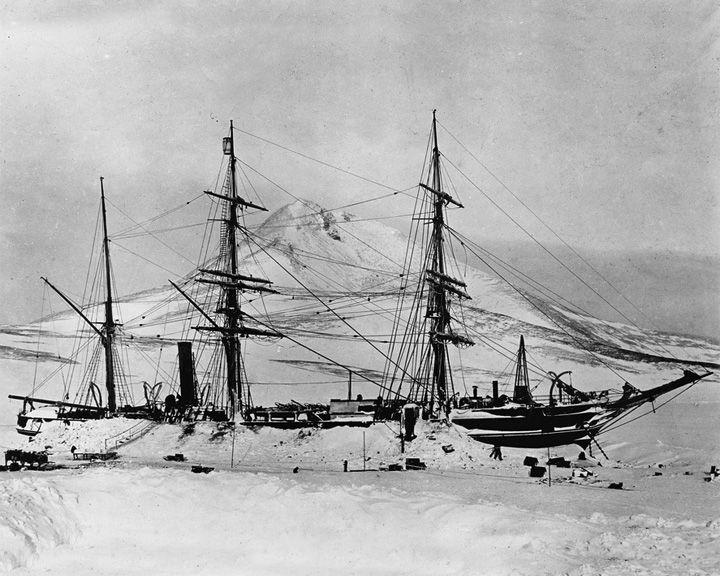 Discovery — British three-masted barque The ship that carried Scott and Shackleton on their first successful journey to the Antarctic. She was locked in the ice of the Antarctic for two years. The ship was eventually freed in February, 1904 by the use of controlled explosives. LAUNCHED: 1901, March 18 → FATE: Museum ship in Dundee, Scotland. |
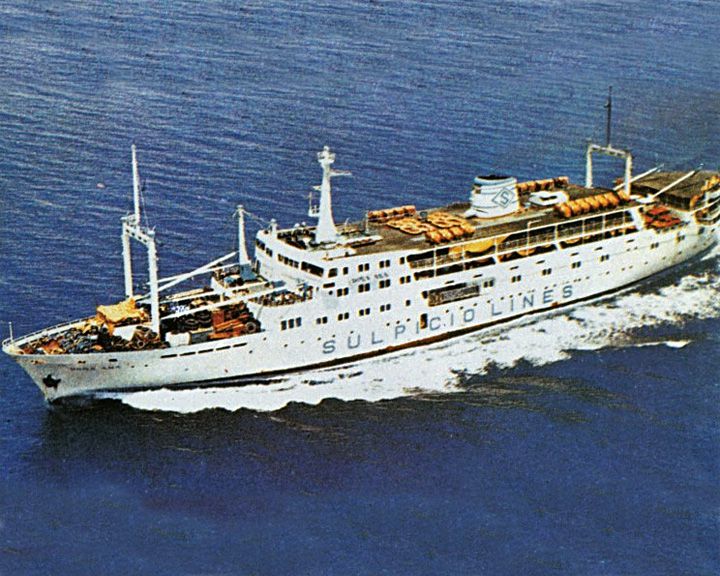 (Another (Another Doña Paz, MV — Japanese built, Philippine owned ferry A collision with MT Vector in 1987 resulted in the deadliest ferry disaster in history in peace time; possibly 4375 lives lost. As Don Sulpicio, on June 5, 1979, she was gutted by fire (with no casualties), beached and declared a total loss. The wreck was sold, refurbished and returned to service in 1981. LAUNCHED: 1963, April 18 → FATE: Collided with the oil tanker, caught fire and sank on December 20, 1987. |
 Dolpin, USS — American V-class submarine The penultimate design in the V-boat series and star in the movie Submarine D-1. The movie hi-lights the use of the Momsen lung for emergency submarine rescues as well as the training tank structures of New London, Connecticut submarine base. LAUNCHED: 1931, March 18 → FATE: Broken up in August 1946. |
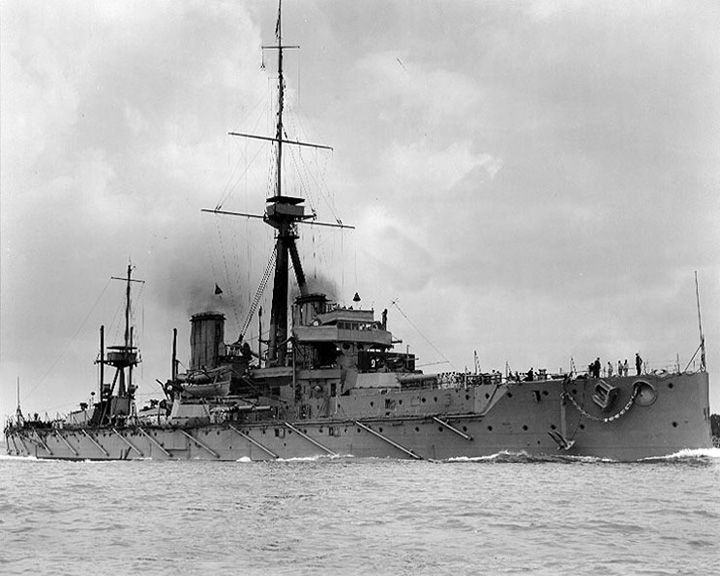 Dreadnought, HMS — British dreadnought battleship First "all-big-gun" armament and steam turbine propulsion. She revolutionized naval power and started a naval arms race. LAUNCHED: 1906, February 18 → FATE: Sold for scrap in 1923. |
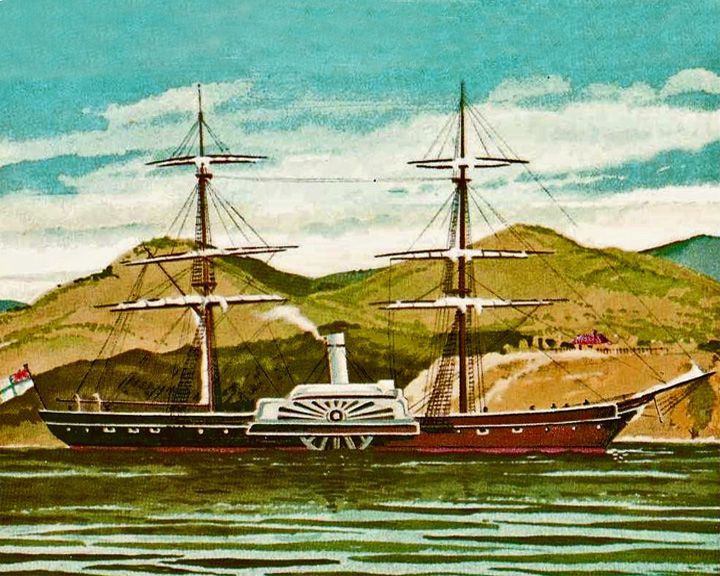 Driver, HMS — British side-wheeler paddle sloop First steamship to circumnavigation the globe. She was the first steamship to visit New Zealand, arriving January 1846, and was involved in the New Zealand Wars. LAUNCHED: 1840, December 18 → FATE: Wrecked on Mayaguana Island on August 3,1861. |
 Drum, USS — American Gato-class submarine She is the oldest of Gato-class submarine still in existence, having received a total of 12 battle stars for her World War II service. She sank 15 ships for a total of 80,580 tons of Japanese shipping, eighth highest of all US submarines. LAUNCHED: 1941, May 18 → FATE: Currently a museum ship in Mobile, Alabama, at Battleship Memorial Park. |
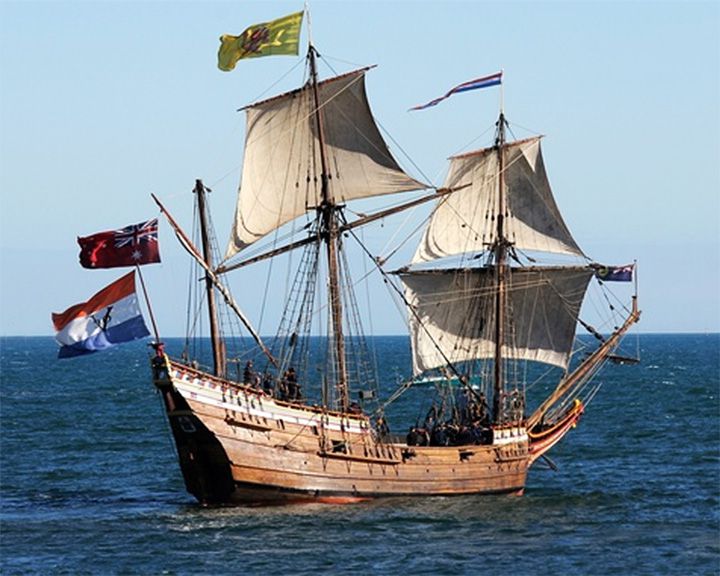 Duyfken — Dutch barque First authenticated European discovery of Australia, 1606. Prior to finding Australia, she explored much of South Pacific including the "Spice Islands" as part of the Dutch East Inda Company fleet. Her replica was built in Australia. LAUNCHED: 1595, original ship; replica launched January 24, 1999 → FATE: Condemned and dismantled in July 1608; replica on display at Elizabeth Quay in Perth, Austrailia. |
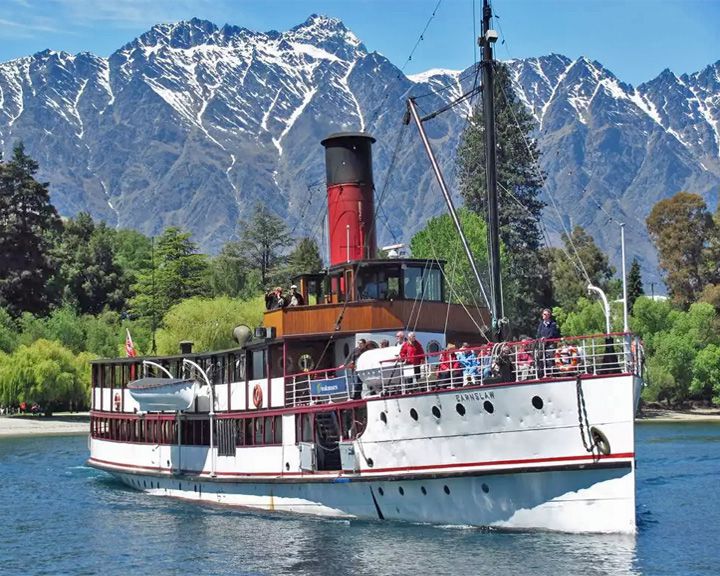 Earnslaw, TSS — New Zealand ferry, coal-fired steamship One of the oldest tourist attractions in New Zealand carrying passengers across Lake Wakatipu. She made a cameo appearance in the 2008 movie Indiana Jones and the Kingdom of the Crystal Skull as an Amazon River boat. LAUNCHED: 1912, February 18 → FATE: Still in use. |
|
|
Page 16
|
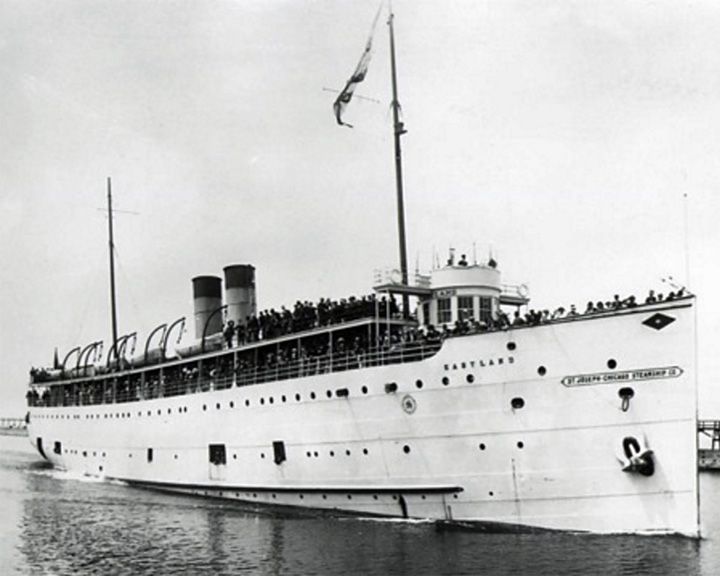 (Another (Another Eastland, SS — American steamship, passenger Largest loss of life from a single shipwreck on the Great Lakes. On the morning of July 24, 1915, the ship, being top-heavy, rolled over while docked in the Chicago River, killing 844 passengers and crew. LAUNCHED: 1903, May 18 → FATE: Sunk on July 24, 1915; raised, converted to a gunboat, renamed USS Wilmette February, 1918; sold for scrap in October of 1946. |
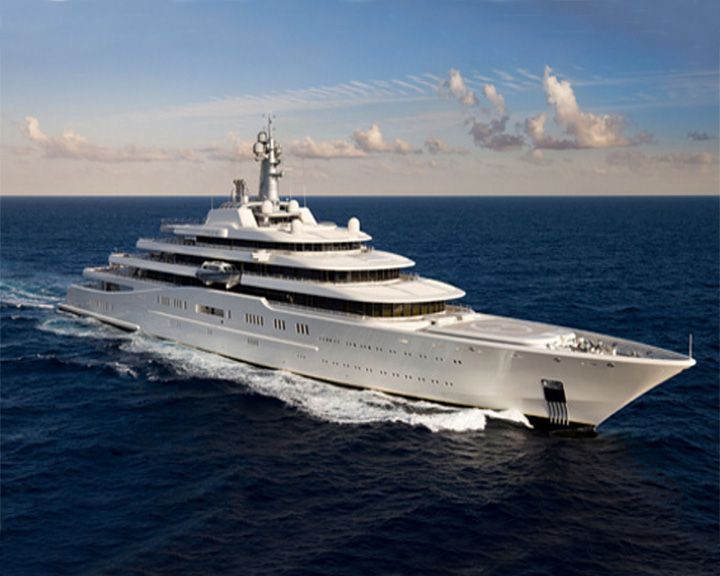 Eclipse — Russian luxury yacht, (German built) One of the largest private motor yacht at 162.5 meters (533 feet), costing over a billion dollars. She has two helicopter pads, 24 guest cabins, two swimming pools, and several hot tubs, and is also equipped with three launch boats and a mini-submarine. LAUNCHED: 2009, June 18 → FATE: Still in use. |
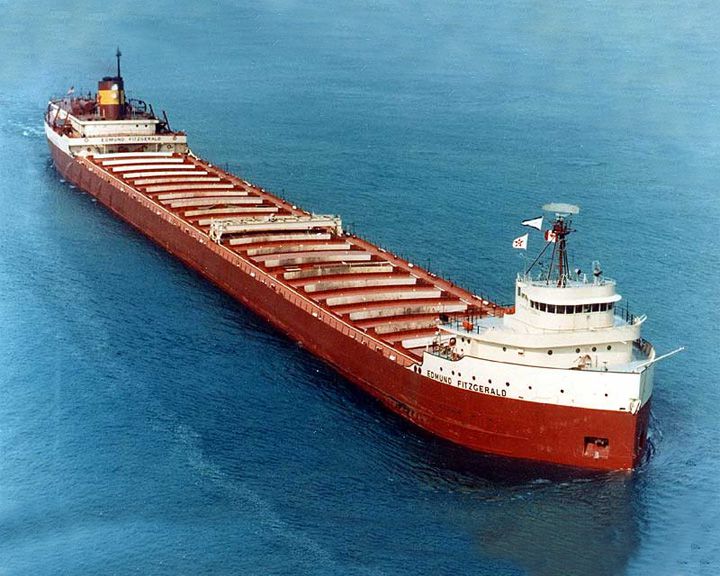 Edmund Fitzgerald, SS — American lake cargo ship, freighter; ore carrier Sank suddenly during a gale storm on Lake Superior without a distress signal. All 29 crew members were lost gaining it the appellation "Titanic of the Great Lakes." The wreck was found 17 miles from Whitefish Bay 4 days later. LAUNCHED: 1958, June 18 → FATE: Lost in a storm on November 10, 1975. |
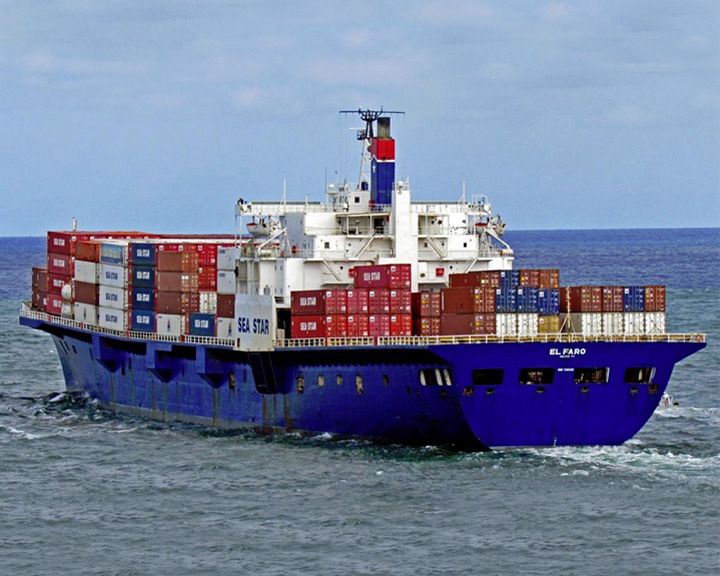 El Faro, SS — American container ship (cargo ship) The worst maritime disaster for a U.S.-flagged vessel in decades, resulting in the deaths of 33 crew. In 2003, prior to the invasion of Iraq in Operation Iraqi Freedom, the vessel, then named Northern Lights, ferried U.S. Marines and supplies from California to Kuwait. LAUNCHED: 1974, November 18 → FATE: Lost at sea with all hands on October 1, 2015 after losing propulsion near the eyewall of Hurricane Joaquin. |
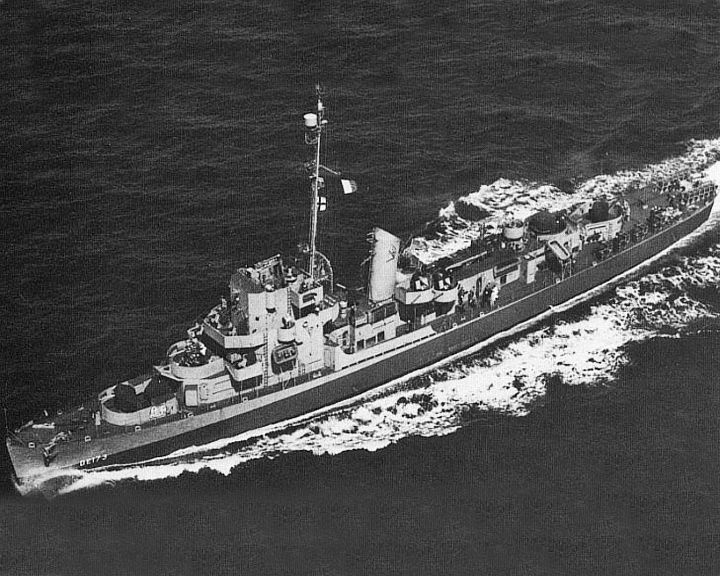 Eldridge, USS — American destroyer escort Famed as part of an alleged military experiment of cloaking ships invisible and carried out by the U.S. Navy at the Philadelphia Naval Shipyard.. A 1984 movie of the incident, The Philadelphia Experiment, presented a fictionalized version of the incident. LAUNCHED: 1943, July 25 → FATE: Decommisioned and scrapped November 11, 1999. |
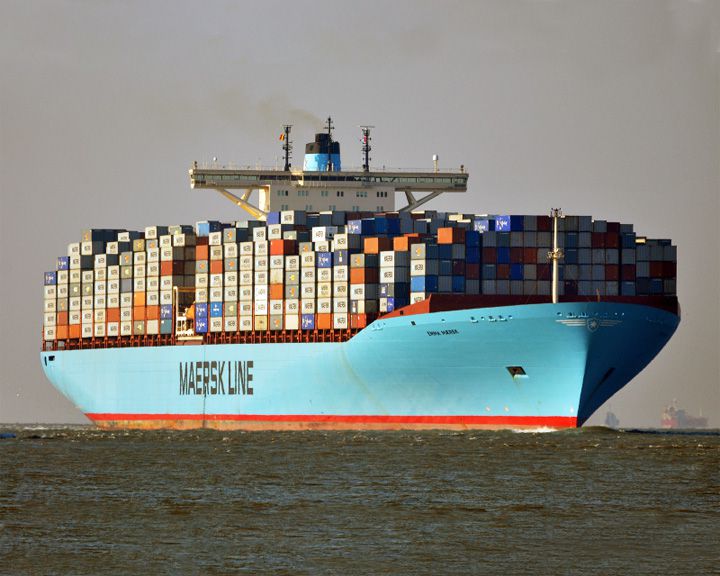 (Another (Another Emma Maersk — Danish container ship (cargo ship) First of the larger container ships. She was once dubbed SS Santa because she was bound for the United Kingdom from China loaded with Christmas goods. During construction, welding work caused a fire that spread throughout the ship. LAUNCHED: 2006, May 18 → FATE: Still in service. |
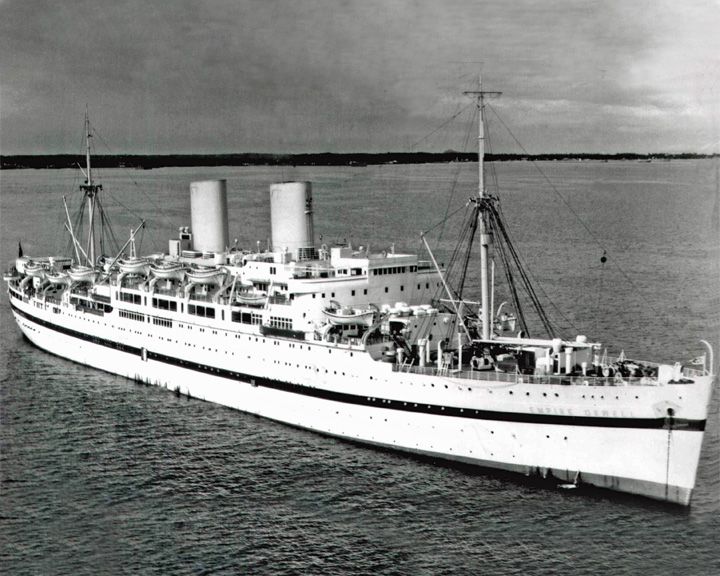 Empire Windrush, MV — German cruise ship captured by England in May of 1945 Carried 493 West Indian immigrants from Jamaica wishing to start a new life in the England on June 22, 1948. Before World War II, she was used for cruises by the Nazi Party to reward party members for services to the Party. Image shown is of sister-ship Empire Doon. LAUNCHED: 1930, December 18 → FATE: Sank in the Mediterranean Sea in March 30, 1954. |
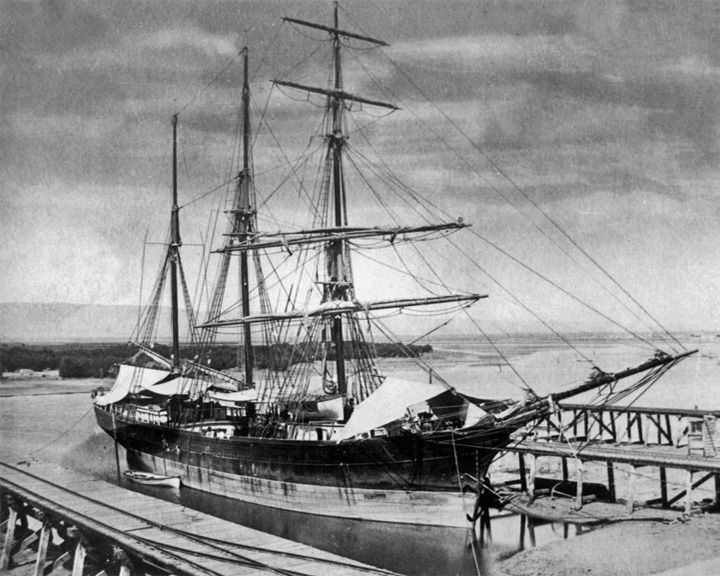 Empress of China — American three-masted, square-rigged sailing ship First American ship to sail from the newly independent United States to China, opening what is known today as the Old China Trade. She left New York harbor on Washington's birthday, February 22, 1784 and returned to New York after a round voyage of fourteen months and twenty-four days. LAUNCHED: 1783 → FATE: Unknown. |
|
|
Page 17
|
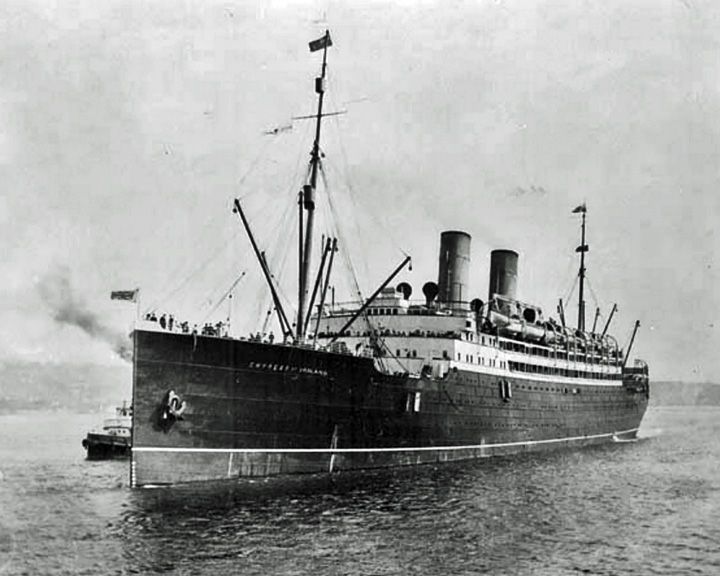 (Another (Another Empress of Ireland — Canadian ocean liner Collided with a Norwegian collier in 1914 claiming 1012 lives, the worst Canadian maritime accident in peacetime. The wreck lies in 40 meters (130 ft) of water, making it accessible to divers. Many artifacts from the wreckage are on display at the Site historique maritime de la Pointe-au-Père in Rimouski, Quebec. LAUNCHED: 1906, January 18 → FATE: Sank in the Saint Lawrence River following a collision May 29, 1914. |
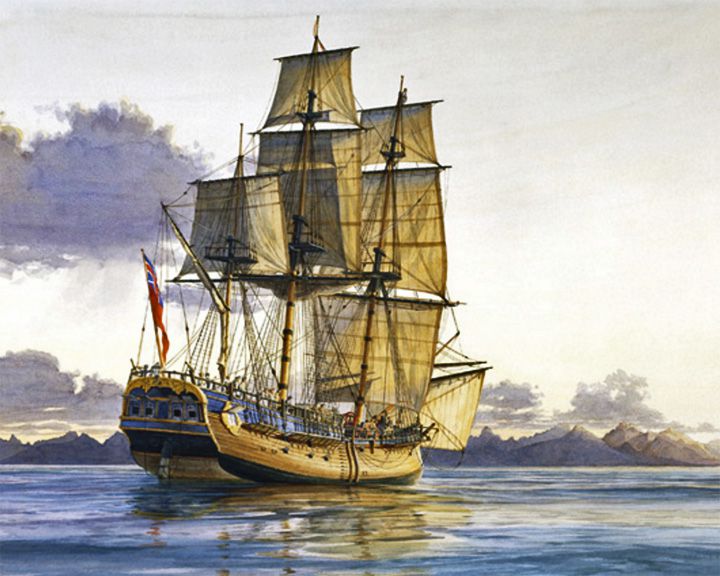 (Another (Another Endeavour, HMS — British collier, three-masted; refitted in 1768 for the expedition James Cook's ship during his voyage to explore the Pacific Ocean and Terra Australis Incognita. She became the first ship to reach the east coast of Australia at Botany Bay in April 1770, and went on to circumnavigate the world. LAUNCHED: 1764, June → FATE: Later renamed Lord Sandwich. Scuttled in a blockade of Narragansett Bay, Rhode Island, in 1778. |
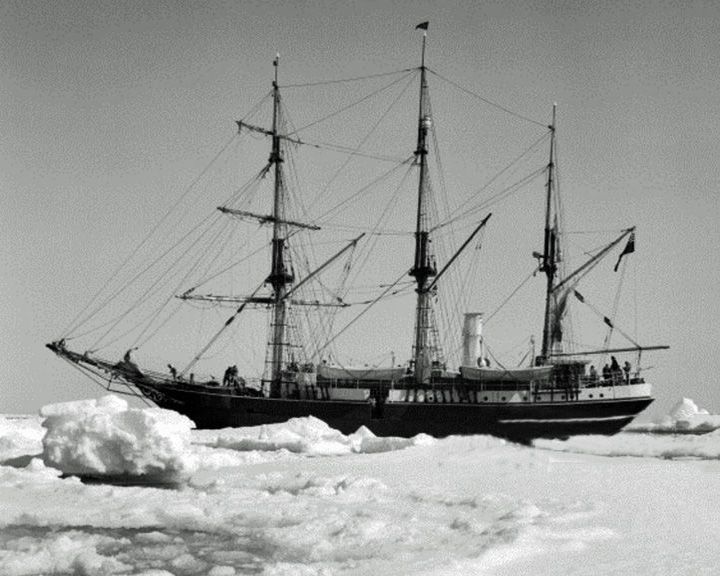 (Another (Another Endurance — Norwegian barquentine, three-masted Used by Sir Ernest Shackleton for the 1914 Imperial Trans-Antarctic Expedition. Her original purpose was as an luxurious ice-capable steam yacht designed for polar conditions. She was one of the strongest wooden ship ever built. LAUNCHED: 1912, December 18 → FATE: Crushed by pack ice in the Weddell Sea in 1915. |
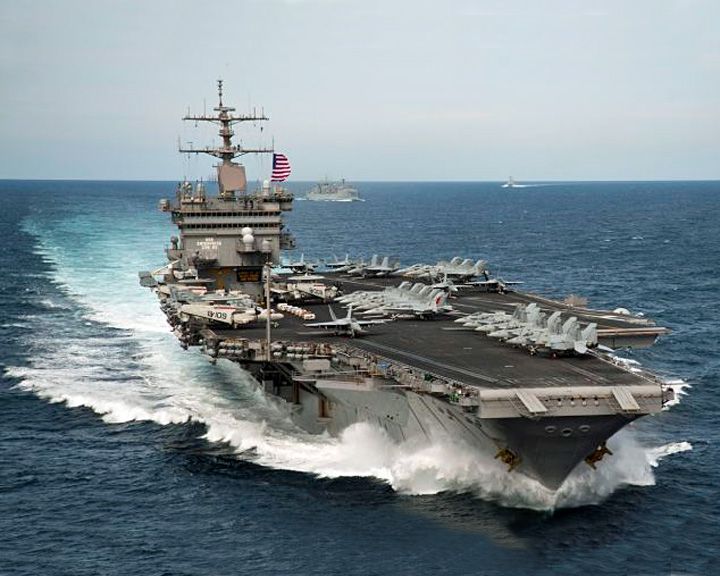 Enterprise, USS — American aircraft carrier World's first nuclear powered aircraft carrier and the eighth U.S. Naval vessel to bear the name. As one of the oldest carriers in the fleet, she was deactivated in 2012 at which time a Gerald R. Ford class carrier, CVN-80, will inherit the name Enterprise. LAUNCHED: 1960, September 18 → FATE: Put in storage in 2017. |
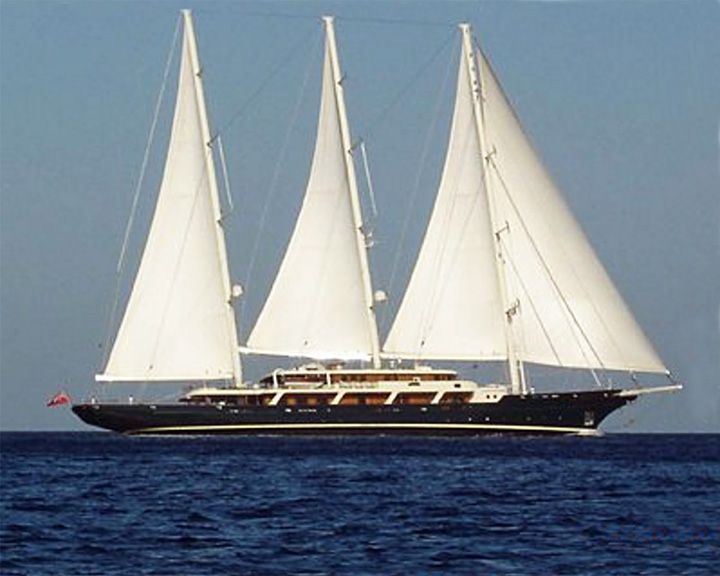 Eos — American three-masted Bermuda rigged schooner, built in Germany The largest sailing yacht in the world with an overall length of 305 feet or 92.92 meters. With much of its length in the bowsprit, the length at the waterline is less than the Maltese Falcon. LAUNCHED: 2006 → FATE: Still in service. |
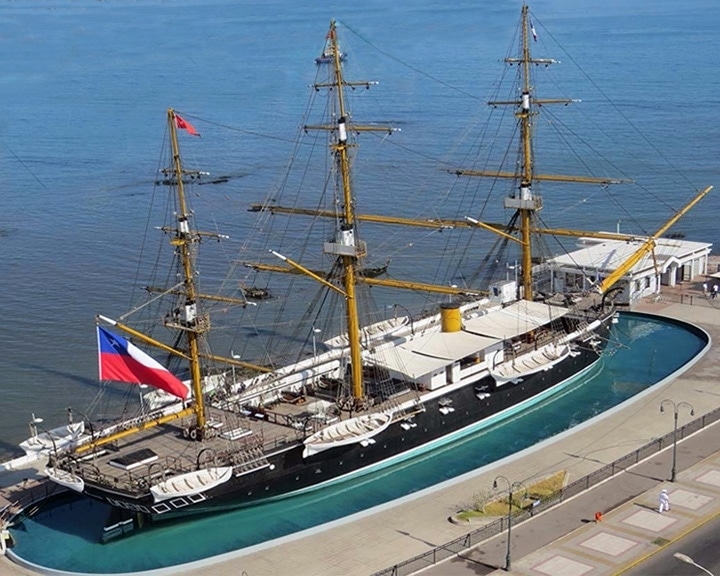 (Another (Another Esmeralda — Chilean wooden hull steam corvette Engaged the Peruvian ironclad Huáscar in the Battle of Iquique despite the material superiority of the Peruvian ship. A replica of Esmeralda is a museum ship in Iquique, Chile. LAUNCHED: 1855, June 26 → FATE: Rammed and sunk on 21 May 1879 at the Battle of Iquique during the War of the Pacific. |
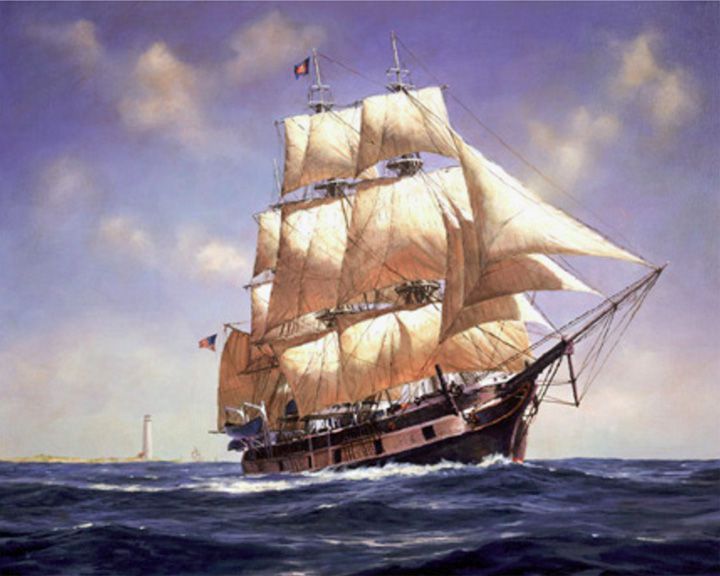 Essex — American barque; whale ship, a three-masted Basis of Nathaniel Philbrick's book In the Heart of the Sea and the movie as well as the inspiration for Herman Melville's 1851 classic novel Moby-Dick. She left Nantucket in 1819 on a whaling voyage in the South Pacific with 21 aboard. It was attacked and sunk by a sperm whale in the Pacific Ocean. Only two men survived. LAUNCHED: 1800, approx. → FATE: Sunk in the southern Pacific November 20, 1820. |
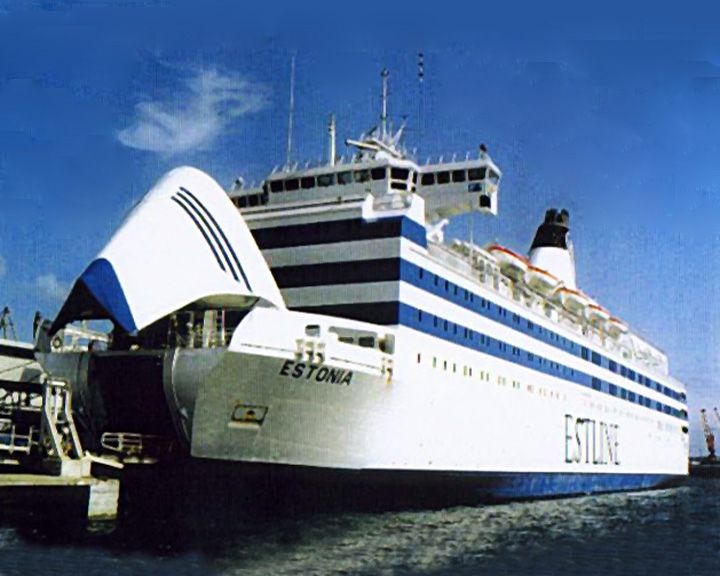 (Another (Another Estonia, MS — German cruise ferry with bow opening car ramp Worst maritime ship disaster in the European waters in peacetime after the Titanic, costing 852 lives. As the largest Estonian-owned ship of the time, she symbolized the independence Estonia regained after the collapse of the Soviet Union. LAUNCHED: 1980, April 18 → FATE: Capsized and sunk in the Baltic Sea on September 28, 1994. |
|
|
Page 18
|
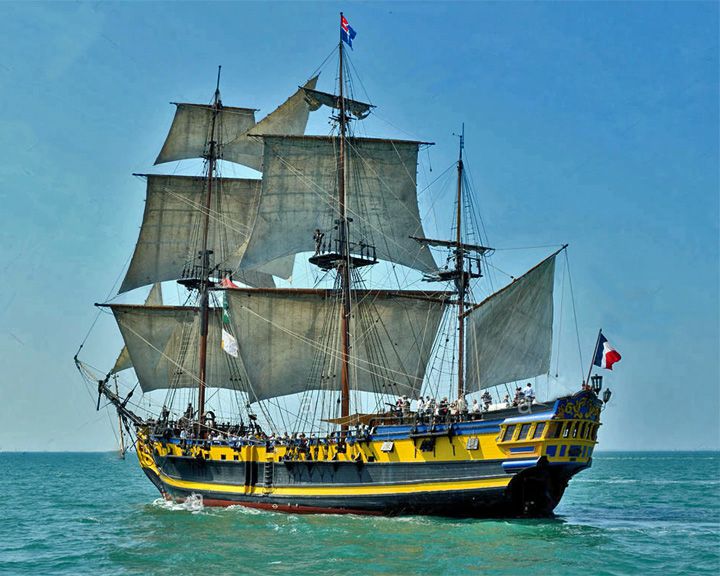 Etoile du Roy — British frigate, sixth-rate Stand-in for several different ships for the British TV series Horatio Hornblower, 1998-2003. The three-masted frigate was built specifically to represent a generic Nelson-age warship, with her design inspired by HMS Blandford built in 1741. LAUNCHED: 1997, September → FATE: Sold to a French company and now on exhibit at Saint-Malo, Brittany. |
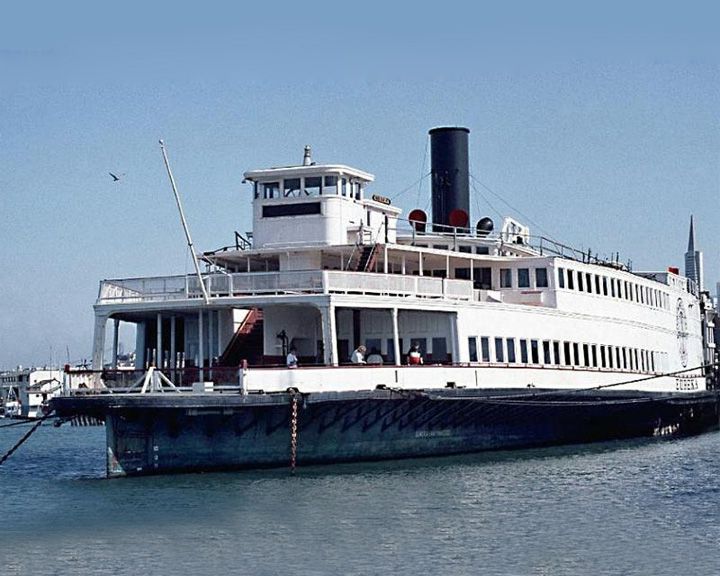 Eureka — American paddle steamboat, stern-wheeler, ferry The largest wooden passenger ferry ever built, certified to carry 3,500 people. She was the last example of the fleet of ferry boats carrying passengers and vehicles across the San Francisco Bay. LAUNCHED: 1890 → FATE: Preserved at the San Francisco Maritime National Historical Park. |
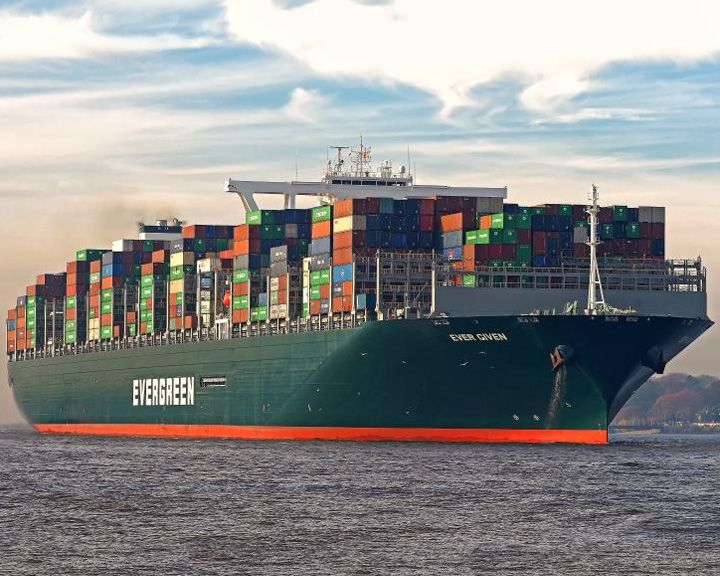 (Another (Another Ever Given — Japanese container ship The ship ran aground in the Suez Canal, completely blocking it. Traffic in both directions was blocked for just over six days, leading to a traffic jam of over two hundred vessels. The ship was finally freed on March 29, 2021. LAUNCHED: 2018, May 9 → FATE: Still operating. |
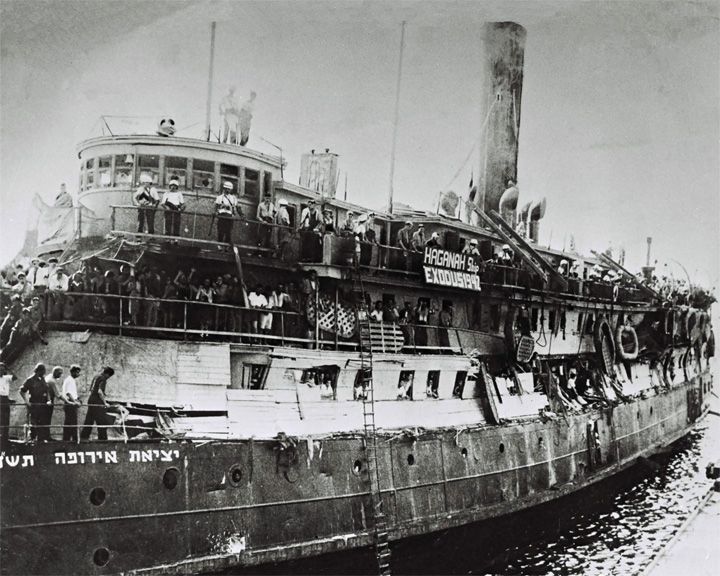 (Another (Another Exodus 1947 — American packet steamer The ship carried 4,500 Jewish immigrants from France to British Mandatory Palestine on July 11, 1947. The incident was the topic of the 1960 movie Exodus.. Until 1942, she carried passengers and freight between Norfolk, Virginia and Baltimore, Maryland. LAUNCHED: 1928 → FATE: After efforts to restore her, a fire destroyed her in 1952 while tied up in Haifa. The wreck was towed out past the ship lanes and scuttled. Two later attempts to raise her for salvage failed. |
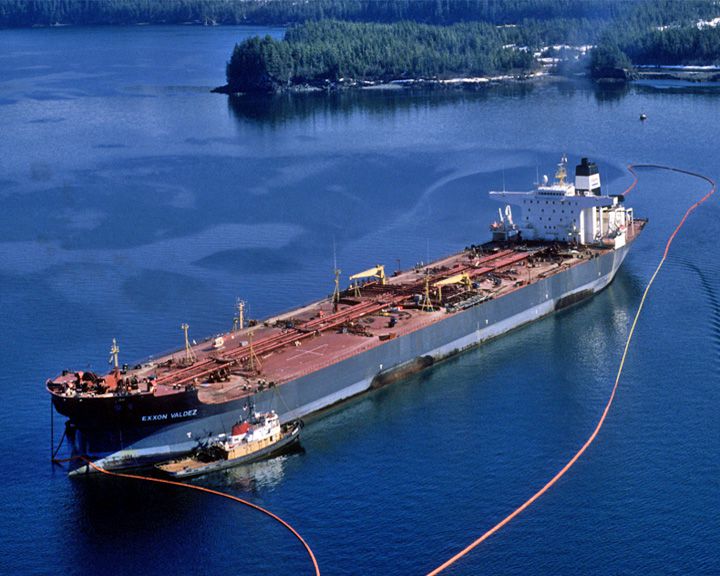 Exxon Valdez — American oil tanker Spilled millions of gallons of crude oil in Prince William Sound. Over her life, she was renamed several times ending up in 2011 as Oriental Nicety. In 2010, as Dong Fang Ocean, she colided with Aali, a cargo ship, causing severe damage to both ships. LAUNCHED: 1986, October 18 → FATE: Beached for dismantling August 20, 2012. |
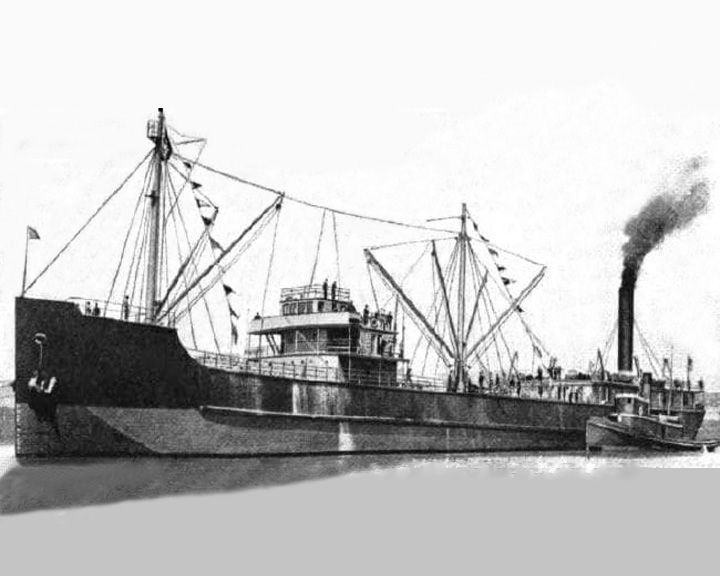 Faith, SS — American Concrete cargo steamer The first concrete ship built in the United States and the largest in the world at the time at 336.5 feet (102.6 meters) and 8000 tons. The first successfully launched cement ship was the 84 foot-400 ton Namsenfjord on August 2, 1917, N.K. Fougner of Norway. LAUNCHED: 1918, March 14 → FATE: After being cracked during a Gulf storm in 1921, she was towed to Cuba for use as a breakwater. |
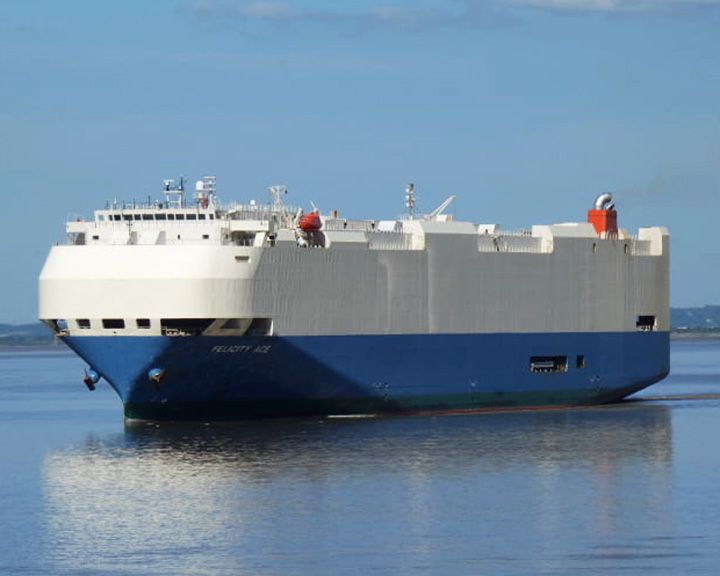 (Another (Another Felicity Ace — Japanese roll-on/roll-off cargo ship The greatest economic loss of cargo shipping in history, costing about $400 million dollars. She was carrying 3,965 Volkswagen Group cars, including Audi, Porsche, Lamborghini and Bentley models. All crew were safely evacuated. LAUNCHED: 2005, July 2 → FATE: She caught fire on February 16, 2022 south of the Azores, then on March 1, 2022, Felicity Ace capsized and sank. |
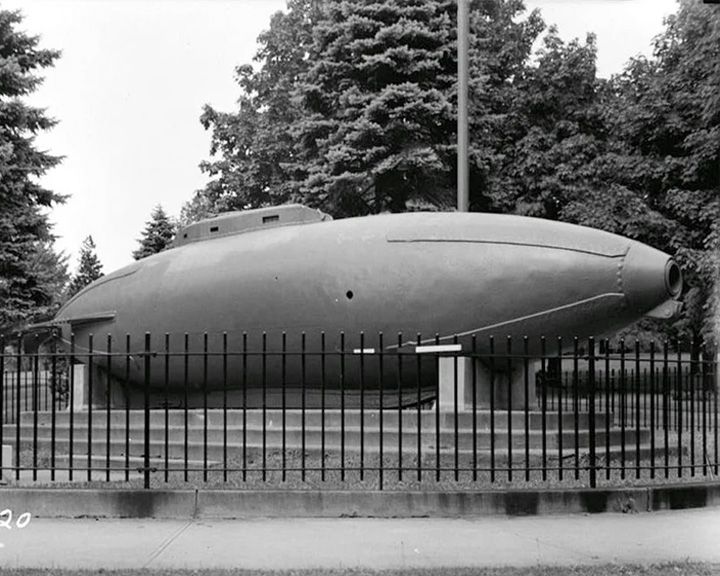 Fenian Ram — American submarine The second experimental submarine built by Irish-born inventor and educator John P. Holland. In 1916, she was exhibited in Madison Square Garden to raise funds for victims of the Easter Rising. LAUNCHED: 1881 → FATE: On exhibit at the Paterson Museum in Paterson, New Jersey. |
|
|
Page 19
|
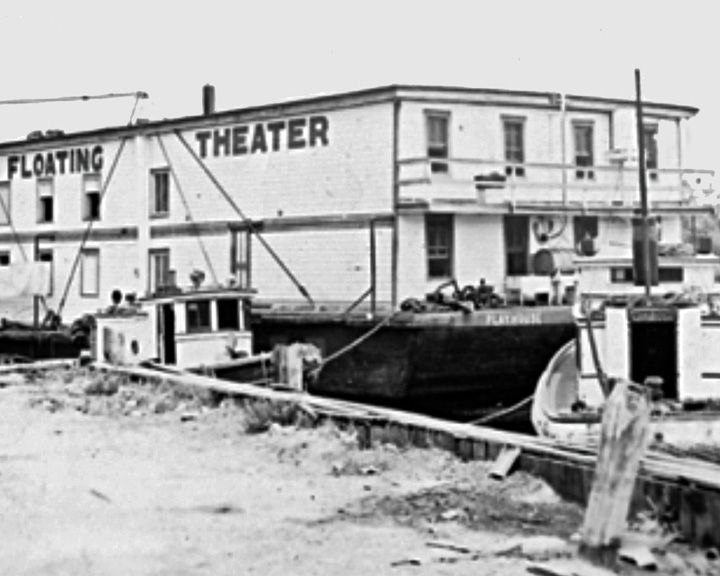 (Another (Another Floating Theater — American caravel The first deliberately-planned showboat, created by British-born actor William Chapman, Sr.; replaced by a new steamboat with a stage and named Steamboat Theatre. In 1914, circus actors James Adams and his wife launched the James Adams Floating Theatre, a showboat that would tour the Chesapeake Bay. LAUNCHED: 1831, and 1836 → FATE: Both unknown. |
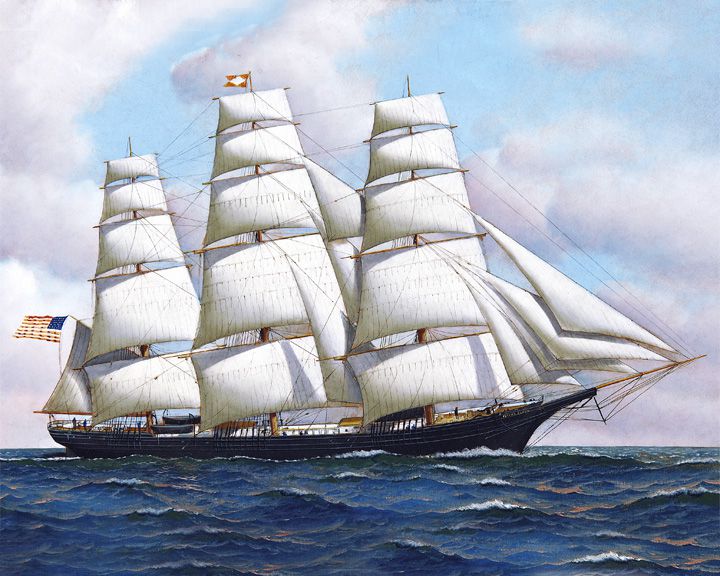 Flying Cloud — American clipper ship The most famous clipper ship, she set a world record (until 1989) for the fastest passage from New York to San Francisco in 89 days, more than 16,000 miles. The ship's navigator was a woman, Eleanor Creesy wife of Josiah Perkins Creesy who skippered Flying Cloud. LAUNCHED: 1851 → FATE: Went aground at Saint John, New Brunswick June 19, 1874. |
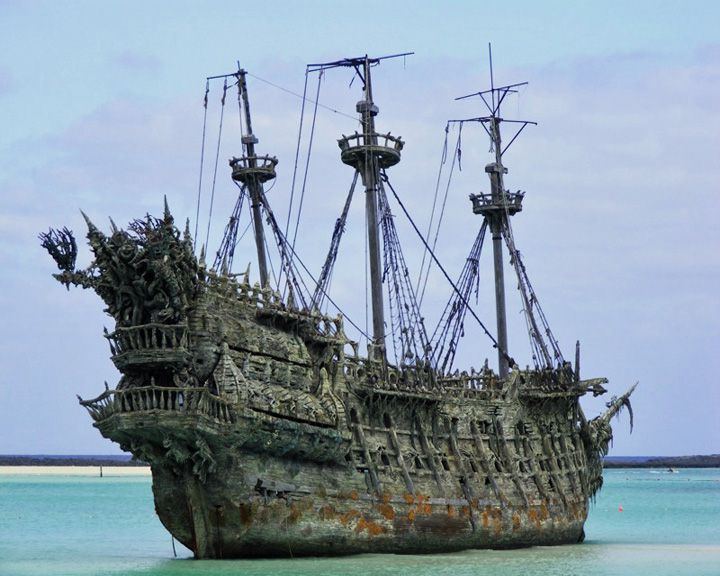 Flying Dutchman — Dutch sailing ship of unknown sort A legendary ghost ship that is doomed to sail the seas forever. She is much cited in movies, TV, books and other amusements. LAUNCHED: 1790, first reference → FATE: Casting about forever. |
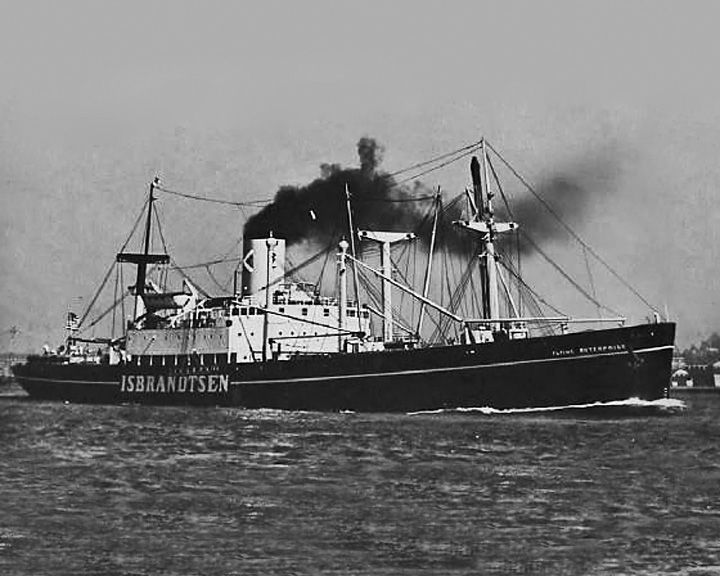 (Another (Another Flying Enterprise — American cargo ship in World War II, then a tramp steamer Subject of intense deep-sea diving and salvage. In 1960, a portion of the cargo was salvaged by an Italian company. In 2001, a team of Danish and British divers re-discovered the lost shipwreck almost 50 years after she had sunk. LAUNCHED: 1944, March → FATE: Sank south of Cornwall, England January 10, 1952. |
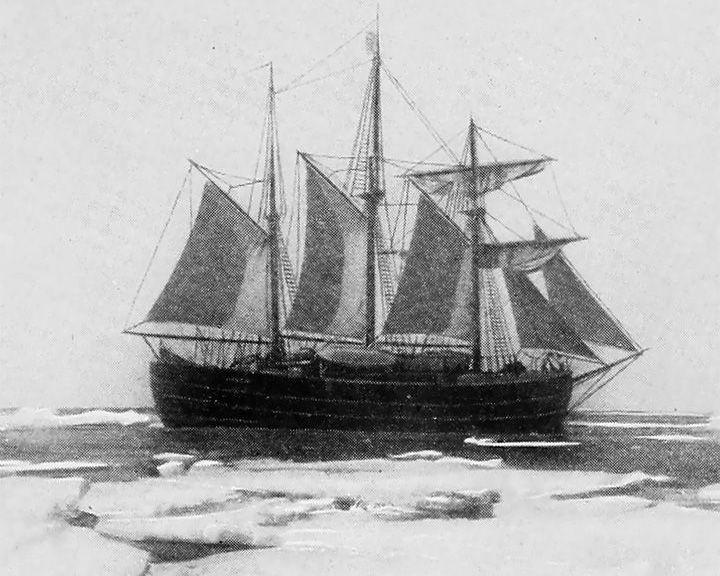 Fram — Norwegian schooner Used in expeditions in the Arctic and Antarctic regions by the Norwegian explorers. Most likely she was the strongest ship ever built, having sailed farthest north and south than any other wooden ship. LAUNCHED: 1892 → FATE: Currently on display at the Fram Museum, Oslo, Norway. |
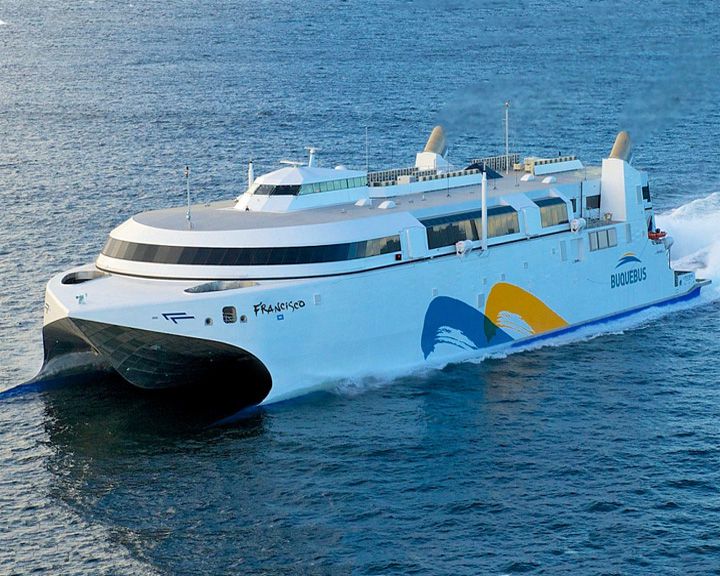 Francisco, HSC — Argentine high-speed catamaran The world's faster ferry sailing at a speed of 58 knots (67 mph). Named after Pope Francis, she is powered by liquefied natural gas. (More info) LAUNCHED: 2012, November 17 → FATE: Still operating. |
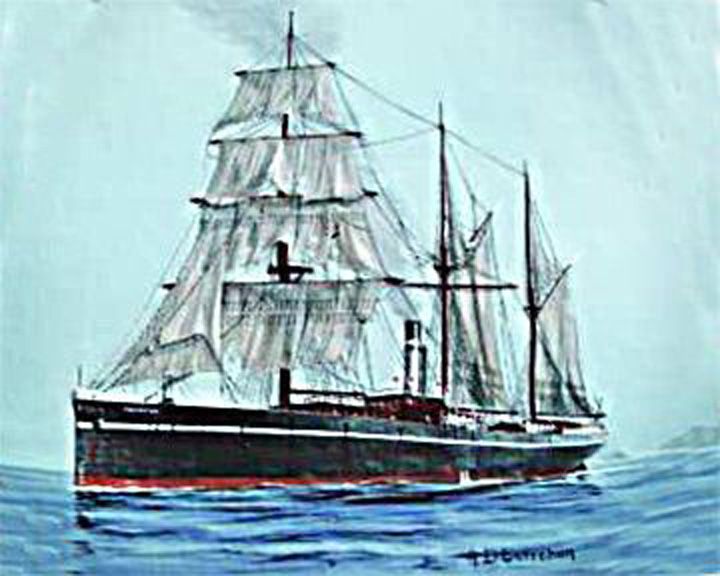 (Another (Another Frigorifique — French steamship First to carry frozen meat across the ocean; from Argentina to France. The first commercially successful shipment of frozen meat that launched the industry was by the steamship Dunedin from New Zealand to England in 1882. LAUNCHED: 1876 → FATE: Sank after a collision with British coal freighter Rumney along the coast of France in March of 1884. |
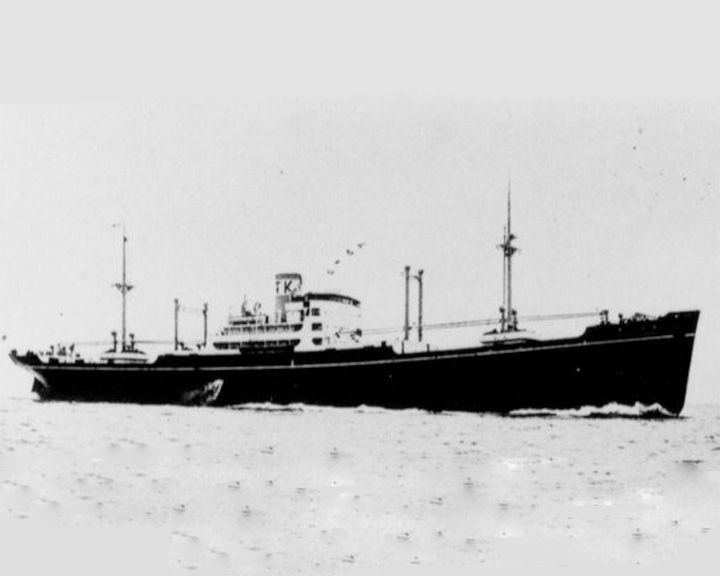 Fujikawa Maru — Japanese cargo ship, transport ship Her sunken remains are a leading wreck diving site for scuba divers. She was sunk in Truk Lagoon during Operation Hailstone during World War II. LAUNCHED: 1938 → FATE: Sunk by torpedo on February 17, 1944. |
|
|
Page 20
|
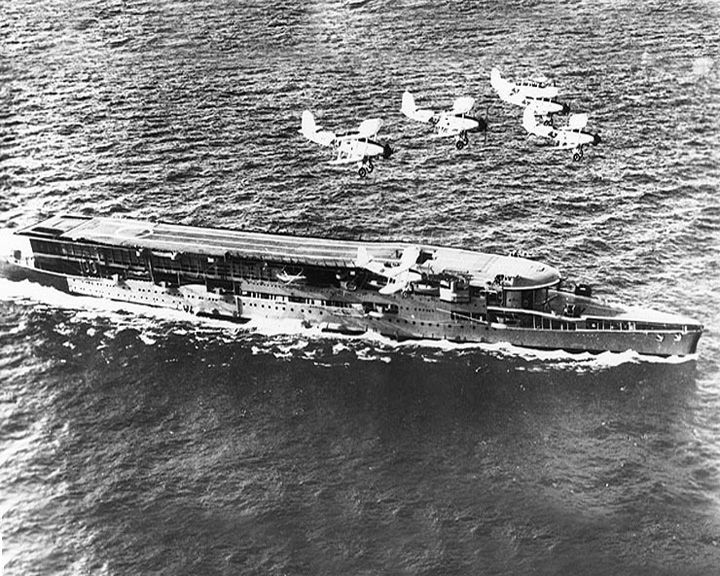 Furious, HMS — British battlecruiser (modified while under construction as an aircraft carrier) First aircraft carrier; her forward turret was removed and a flight deck was added in its place. Spent last of World War I and much of World War II as an aircraft ferry. LAUNCHED: 1916, August 18 → FATE: Sold for scrap in 1948. |
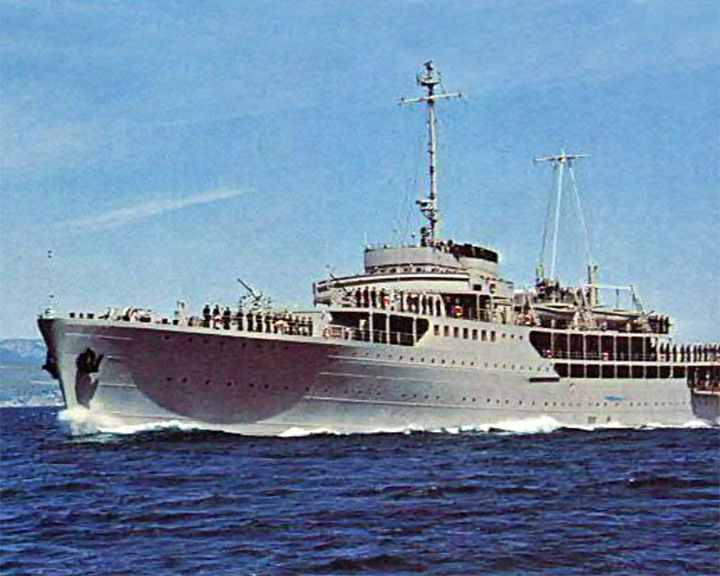 Galeb — Croatian yacht, built as an Italian auxillary cruiser called Ramb III Official yacht of former Yugoslavian president Tito and used for entertaining world leaders and celebrities. The Germans seized the boat in World War II and named it Kiebitz; after the war, the Yugoslavian navy converted it to a training ship; then in 1952, it became Tito's yacht. LAUNCHED: 1938,, then seized by Germany September 1943 → FATE: Being restored and is occasionally opened to the public. |
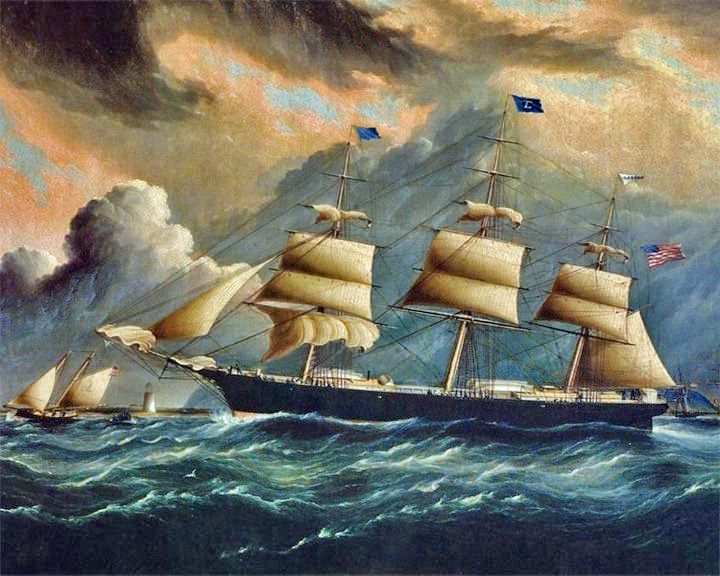 (Another (Another Gaspée — English single-masted sloop-of-war, used as a fast revenue cutter Subject of the "Gaspée Affair," the torching of the ship by a group of American colonialists, leading up to the American Revolution. The city of Warwick, RI commemorates the Gaspée Affair with a festival and parade, including burning the Gaspée in effigy. LAUNCHED: 1764, January → FATE: Looted and burned in Narragansett Bay June 9, 1772. |
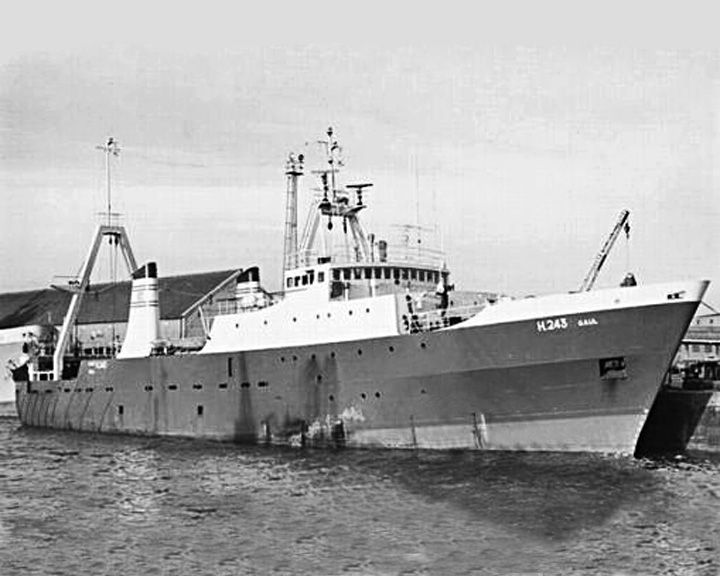 Gaul — English fishing trawler Worst peacetime maritime disaster to befall the UK fishing fleet. No distress signal was received and her loss was not realised until days later. 36 crew were lost. LAUNCHED: 1971, December 18 → FATE: Mysteriously sank in the Barents Sea, north of Norway February, 1974. |
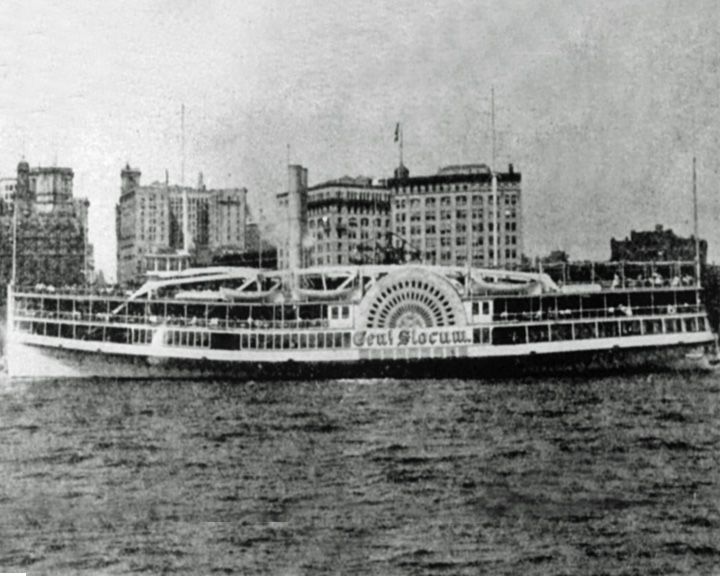 (Another (Another General Slocum — American river paddle steamboat, side-wheeler Caught fire and burned to the water line in New York's East River on June 15, 1904 killing 1,021 people. She was named after Major General Henry Warner Slocum, 1827-94. LAUNCHED: 1891, April 18 → FATE: The remains were recovered and converted into a barge, which sank in a storm in 1911. |
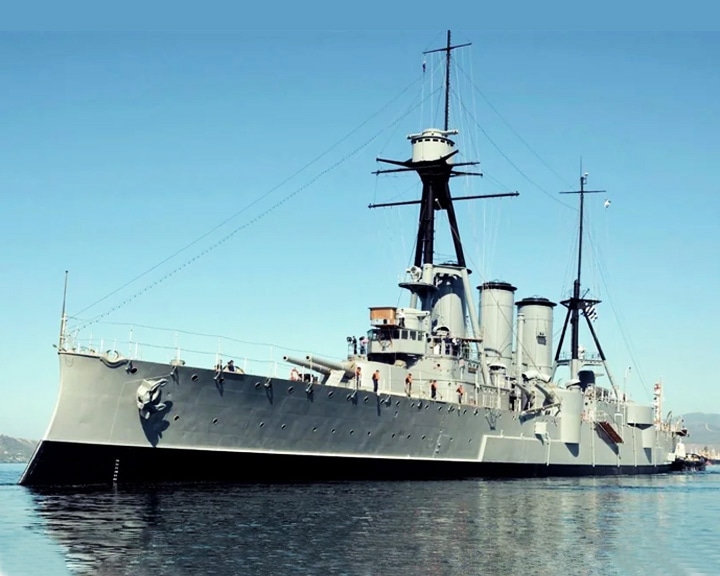 Georgios Averof — Greek armored cruiser The only anored cruiser still in existence. The ship served as the Greek flagship during most of the first half of the 20th century. LAUNCHED: 1910, March 12 → FATE: She has been reinstated on active duty as a museum ship in the Naval Tradition Park in Faliro, Athens. |
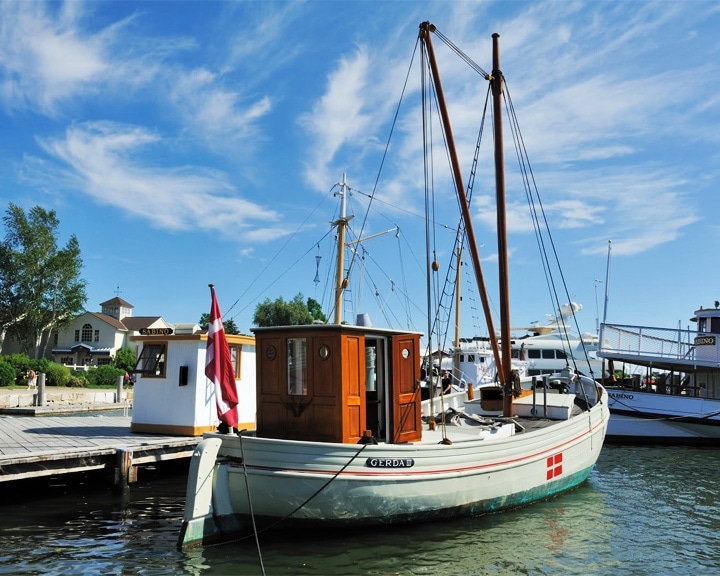 Gerda III — Danish lighthouse tender During WWII, in 1943, she was used to smuggle about 300 Jews from Nazi occupied Denmark to Sweden. The rescue story is the subject of the 1991 film A Day in October. LAUNCHED: 1928 → FATE: On exhibit at the Museum of Jewish Heritage in New York City. |
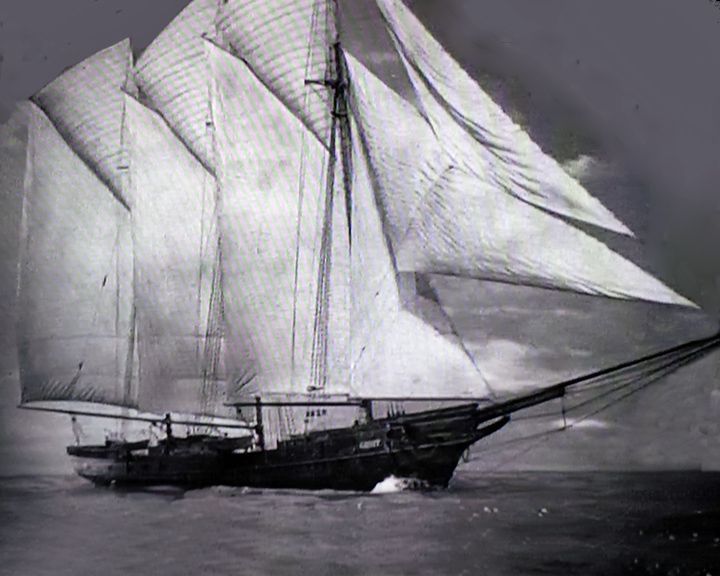 Ghost — American schooner; a seal-hunting ship The setting for the 1941 movie The Sea Wolf, starring Edward G. Robinson and Ida Lupino. The story is based on the novel The Sea Wolf by Jack London. LAUNCHED: 1941 → FATE: Inconclusive. |
|
|
Page 21
|
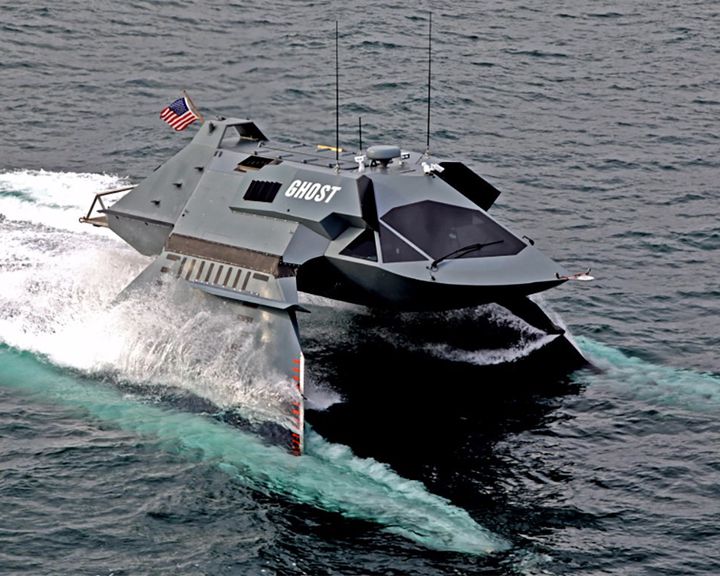 Ghost, stealth ship — American super-cavitating stealth ship A prototype ship for stealth operations designed by a private American company, Juliet Marine Systems. Designed to travel above the water's surface, her main hull is positioned atop by two long and narrow struts. LAUNCHED: 2009, (trials in 2011) → FATE: Its future is uncertain. |
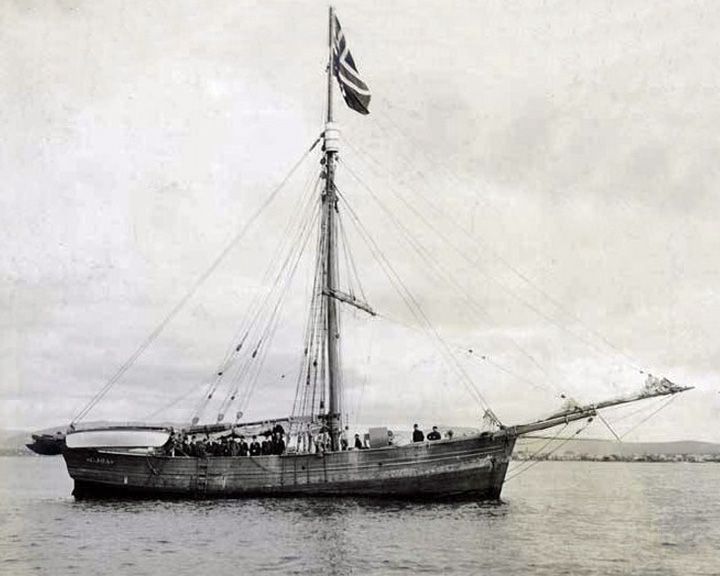 Gjøa — Norwegian sloop, square sterned The first vessel to transit the Northwest Passage. She reached San Francisco in 1906 where she was put on display, but slowly deteriorated until 1949 when she was refurbished. Then in 1972 she was returned to Norway. LAUNCHED: 1872 → FATE: On display at the Fram Museum in Bygdøy, Norway. |
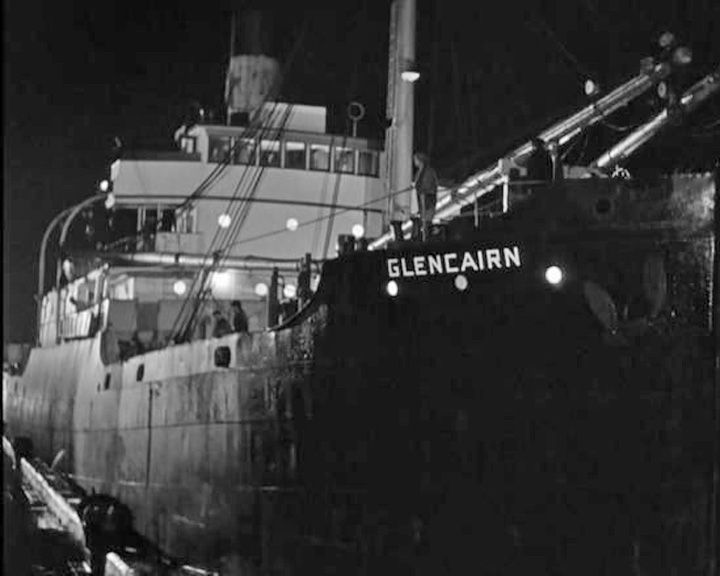 Glencairn, SS — British tramp steamer In the movie The Long Voyage Home about the men on board on the long voyage home from the West Indies to Baltimore and then to England. Nine prominent American artists, all painters, were hired to construct the dramatic scenes during the film's production. LAUNCHED: 1940, for the movie → FATE: Inconclusive. |
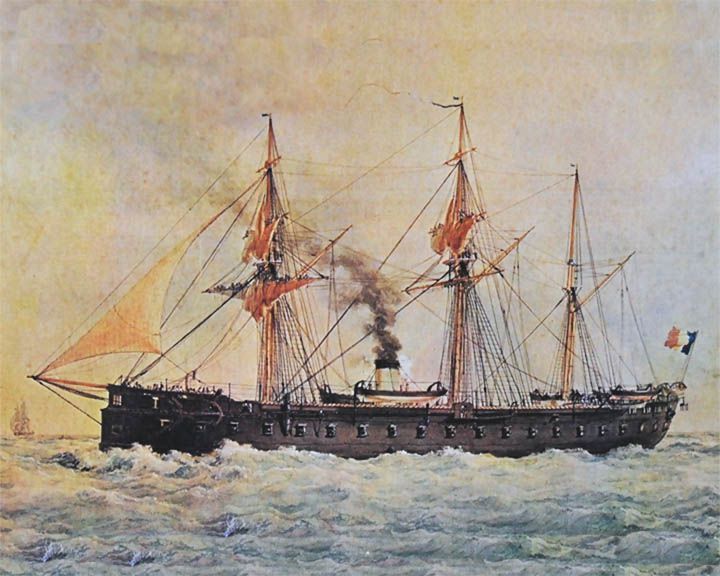 Gloire — French ocean-going ironclad First ocean-going ironclad, developed in response to navel gun technology, including the Paixhans gun, thus rendering obsolete traditional unarmoured wooden ships-of-the-line. She was constructed with light barquentine sails as well as a steam-powered screw. LAUNCHED: 1859, November 18 → FATE: Scrapped in 1883. |
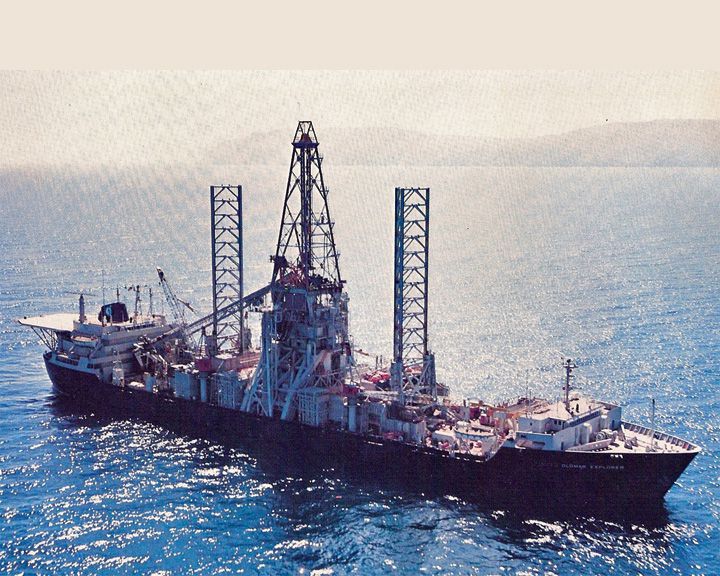 Glomar Explorer — American deep sea research vessel Built for a secret operation by the CIA to recover a sunken Soviet submarine, K-129 which was lost in April, 1968. She was converted into a deep sea oil drilling ship in 1997. LAUNCHED: 1972, November 18 → FATE: Currently operates as the GSF Explorer. |
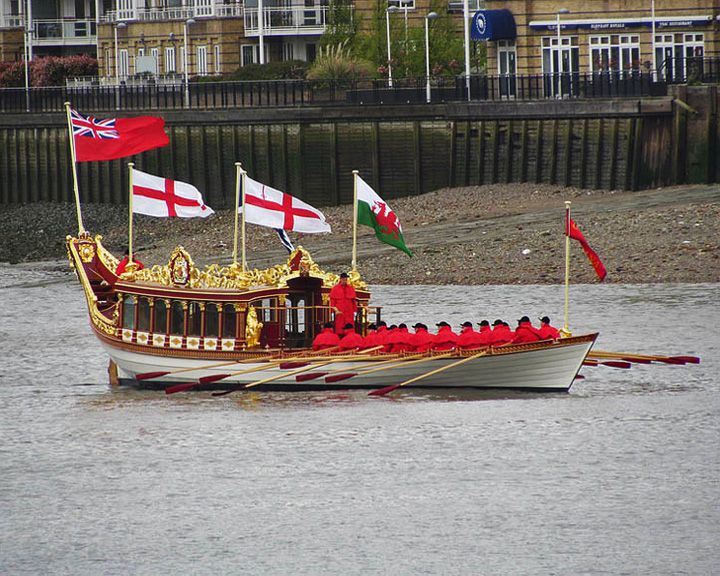 Gloriana — English royal barge, or rowbarge The lead vessel of the flotilla celebrating Queen Elizabeth II's Diamond Jubilee, June 3, 2012. She is powered by 18 oarsmen, and can carry an additional 34 passengers and crew. LAUNCHED: 2012, April 18 → FATE: Still afloat. |
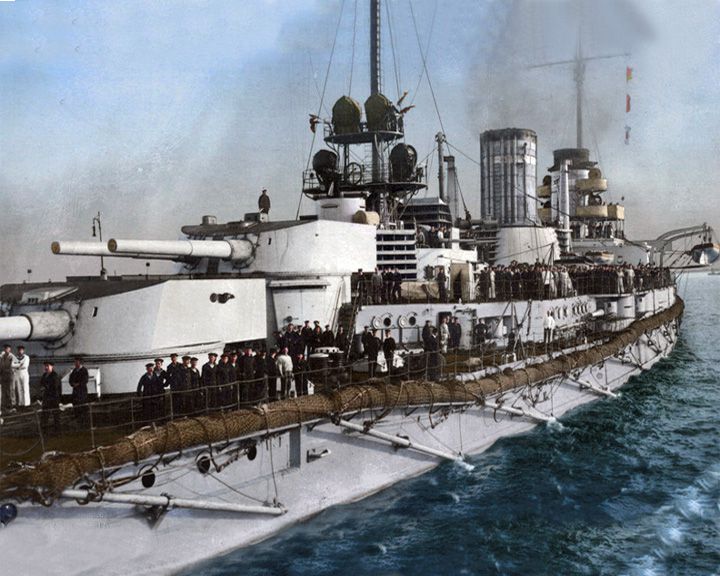 Goeben, SMS — German battlecruiser Last surviving ship built by the Imperial German Navy, and the longest-serving battlecruiser or dreadnought-type ship in any navy. During World War I, she and light cruiser Breslau were transferred to the Ottoman Empire, August of 1914, and became the flagship Yavuz Sultan Selim. LAUNCHED: 1911, March 18 → FATE: Scrapped in 1973. |
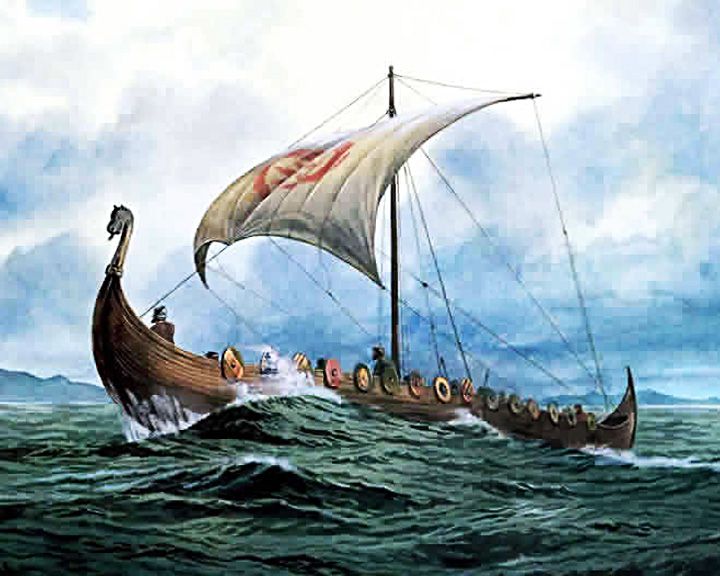 (Another (Another Gokstad — Viking clinker-built ship Viking ship found in a burial mound at Gokstad farm in Sandefjord, Norway in 1880. Later she was used for the burial of an important chieftain who died about 900 A.D. (A replica is on display at the Hjemkomst Center museum in Moorhead, MN.) LAUNCHED: 890, circa → FATE: On display at the Viking Ship Museum in Oslo, Norway. |
|
|
Page 22
|
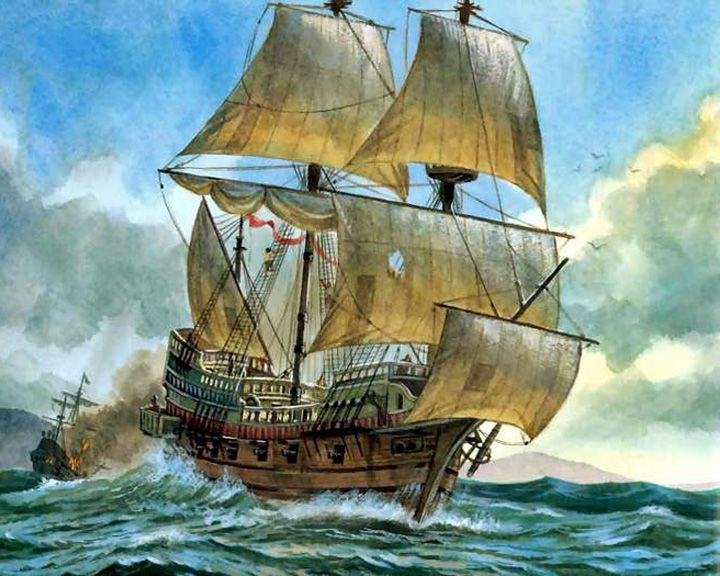 Golden Hind — English galleon Second ship to circumnavigation of the globe between 1577 and 1580, captained by Sir Francis Drake. Several replicas were built, the latest the Golden Hinde lauched in 1973. LAUNCHED: 1576, probably → FATE: In dry dock at Deptford, England as a museum piece, rotted away after decades around 1650. |
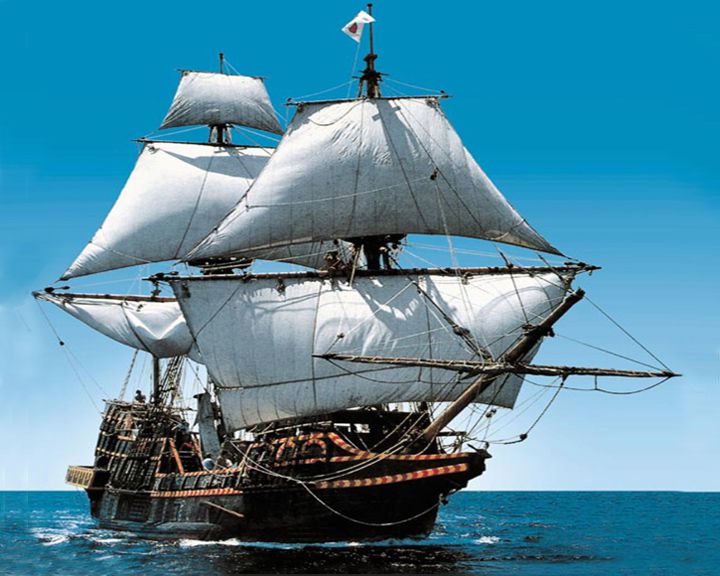 Golden Hinde — English galleon A full-size replica of the 1577 Golden Hind and appeared in several movies. She has travelled a distance equal to more than five times around the globe. Like Francis Drake's ship, she has circumnavigated the globe. LAUNCHED: 1973 → FATE: Since 1996 she has been berthed at St Mary Overie Dock, Southwark, London. |
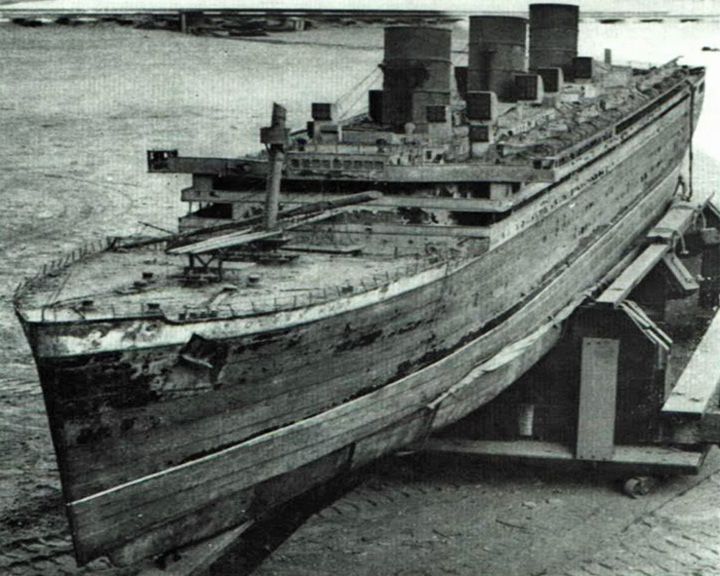 Goliath, RMS — British ocean liner Fiction ocean liner in the movie Goliath Awaits. The interiors of Goliath were filmed aboard the RMS Queen Mary in Long Beach, California. LAUNCHED: 1981, movie release → FATE: Inconclusive. |
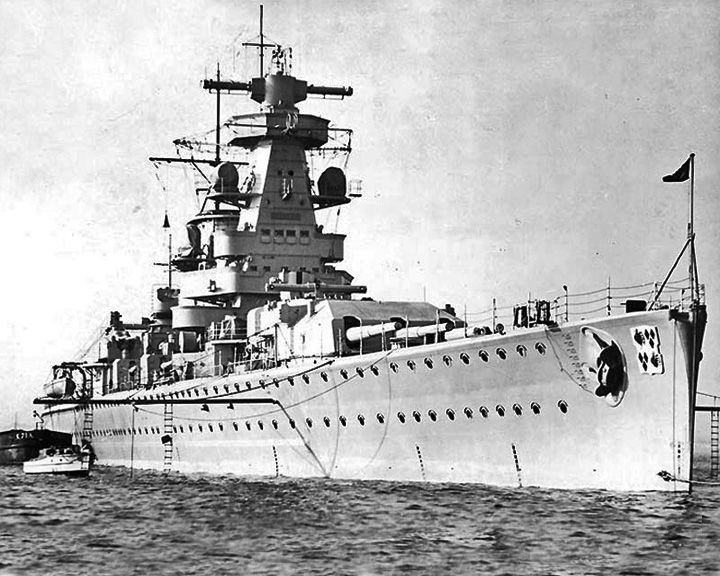 (Another (Another Graf Spee, Admiral — German pocket battleship Though size was limited by the Treaty of Versailles, she was as heavily armed as a battleship. Sank nine Allied merchant ships. Afterwards, ships of this size were called heavy cruisers. LAUNCHED: 1934, June 18 → FATE: Scuttled off Montevideo December 17, 1939. |
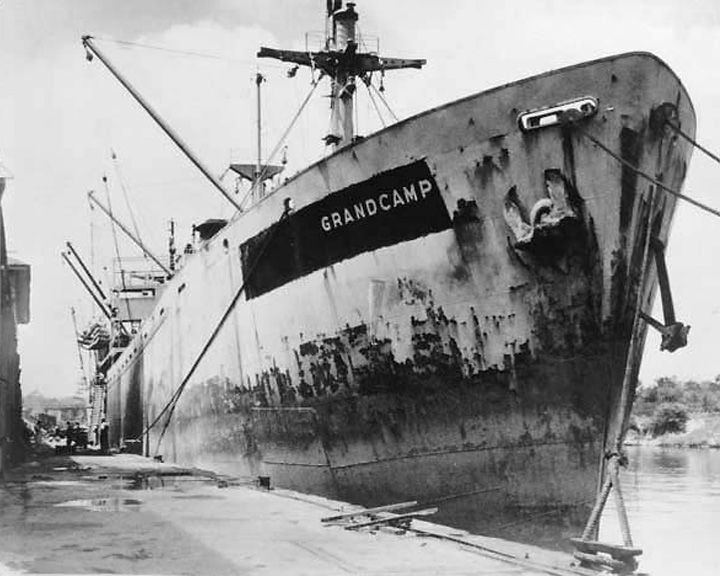 Grandcamp, SS — American liberty ship Origin of the deadliest industrial accident in U.S. history and one of the largest non-nuclear explosions. The initial blast and subsequent fires and explosions in other ships and nearby oil-storage facilities killed at least 581 people, wounding over 5,000. LAUNCHED: 1942, November → FATE: Exploded and destroyed April 16, 1947. |
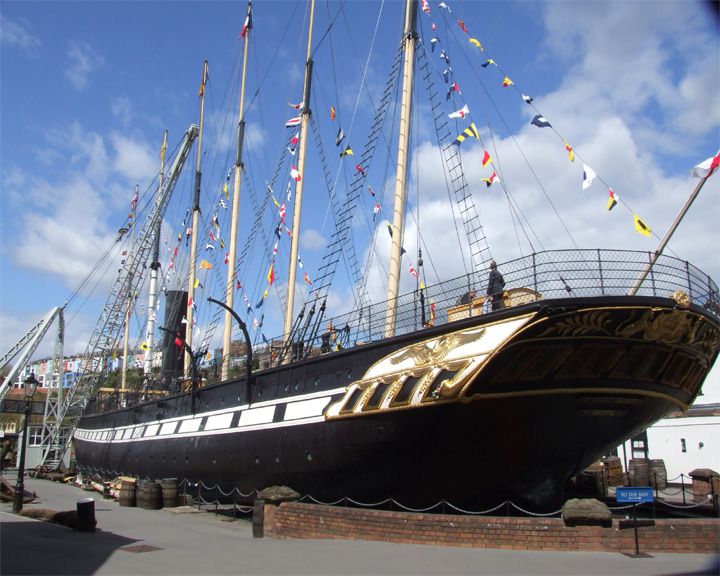 (Another (Another Great Britain, SS — British steamship, passenger ship First steamer to cross the Atlantic. Also first built of iron and with a screw propeller. She ran aground in 1846 and was sold for salvage, repaired and revised. In 1881 she was converted to sail. In 1937 she was retired and scuttled. In 1970 she was recovered and eventually restored as a museum ship. LAUNCHED: 1845, July 18 → FATE: Now a museum ship in Bristol Harbour. |
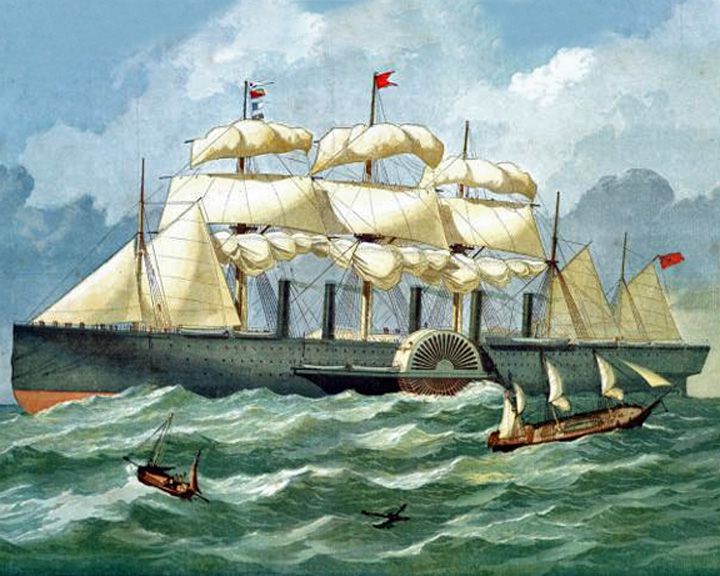 (Another (Another Great Eastern, SS — British iron paddle steamboat, side-wheeler with sails The world's largest steamship; successfully laid cable across the Atlantic Ocean. She completed 45 crossings in eight years; then she was used for carrying mail, then troops. LAUNCHED: 1858, January 18 → FATE: Broken up for scrap at Rock Ferry on the River Mersey in 1889. |
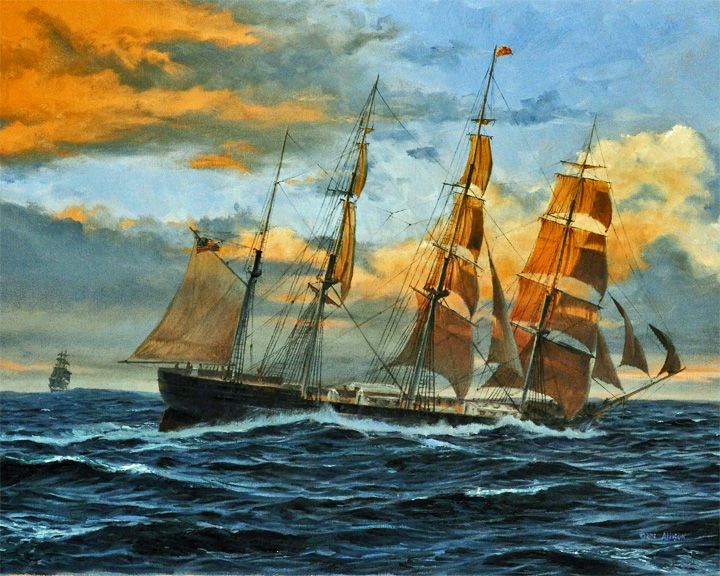 Great Republic — American clipper, four-masted The largest wooden clipper ship ever constructed, requiring 1,500,000 feet of pine, 336½ tons of iron, and 56 tons of copper. In 1853, fire sank her; but she was salvaged and rebuilt as a three deck vessel and went on to set transatlantic speed records. LAUNCHED: 1853, October 18 → FATE: Abandoned during a hurricane off Bermuda March 5, 1872. |
|
|
Page 23
|
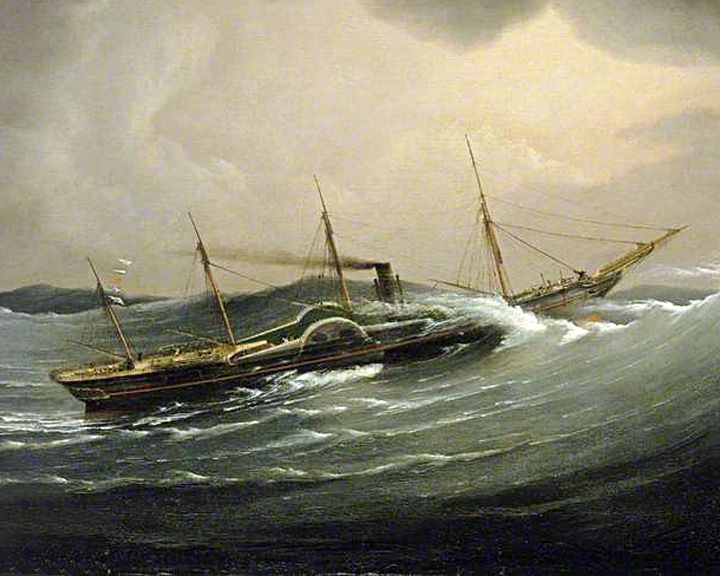 Great Western, SS — British paddle steamboat, side-wheeler First paddle ship built for crossing the Atlantic; completed the crossing in April of 1838. In later years, she was used as a showboat, a floating palace/concert hall and gymnasium. LAUNCHED: 1837, July 18 → FATE: Taken out of service December of 1846, she was broken up in 1856. |
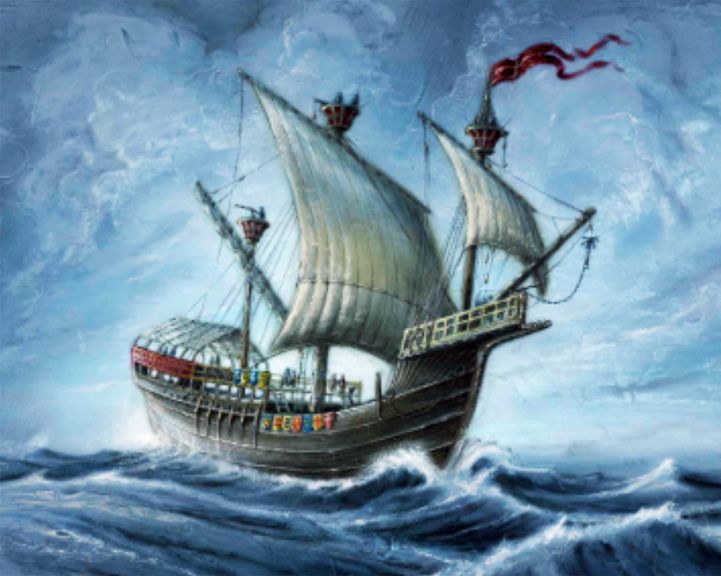 Gribshunden — Danish warship, one of the first carvel-built vessels and among the earliest armed with guns. She was the flagship of the King of Denmark, Hans, on her way to a political summit with the Swedish leader when she sank, killing a number of those aboard and the summit. In 2015, the wreckage attracted international attention when a near perfectly-preserved wooden figurehead of a mythical beast was brought to the surface. LAUNCHED: 1485 → FATE: In 1495, she sank after an accidental fire while in the Baltic Sea off the coast of Ronneby in southeastern Sweden. |
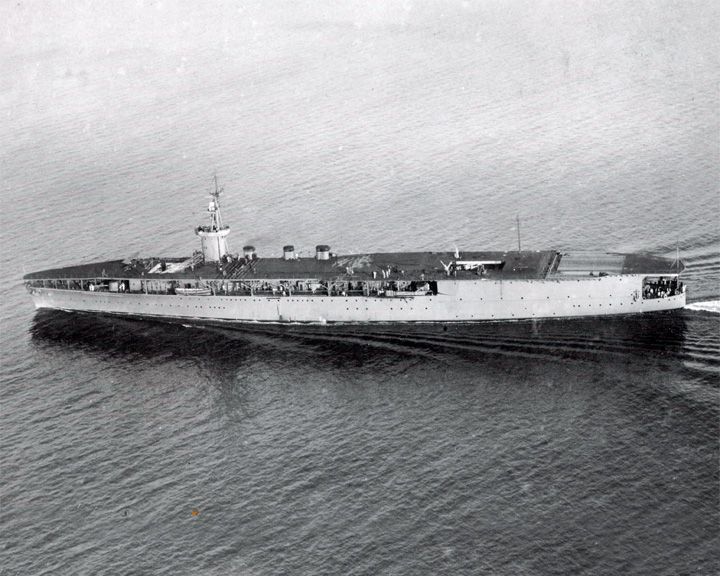 Hōshō — Japanese aircraft carrier First ship designed and built as an aircraft carrier. During World War II, she participated in the Battle of Midway in a secondary role. Afterward, she returned to Japan as a training ship for the duration of the war. LAUNCHED: 1922 → FATE: Scrapped in 1948. |
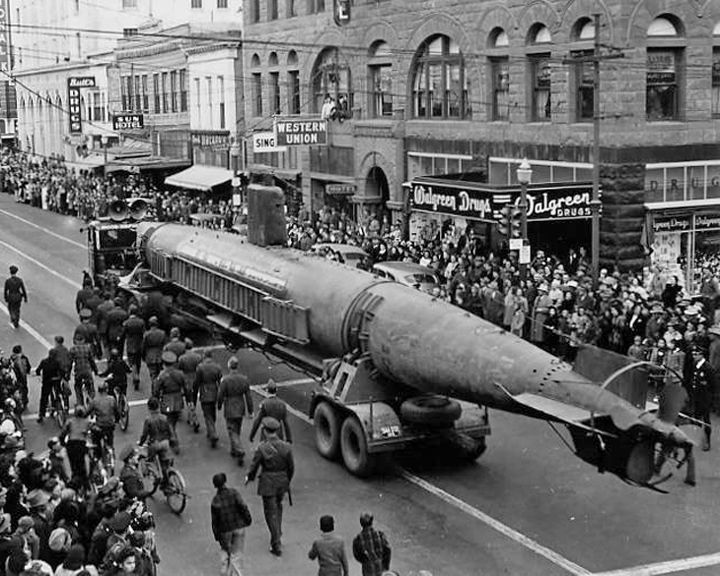 HA. 19 — Japanese midget submarine First shot fired by the U.S. in the World War II was at this minisub as it tried to enter Pearl Harbor. Grounded and abandoned after failing to fired any torpedos, she was pulled out of the sea and was sent to the US mainland in January 1942 where she went on war bond tours. LAUNCHED: 1938 → FATE: On exhibit at the National Museum of the Pacific War in Texas to where she was moved in 1991. |
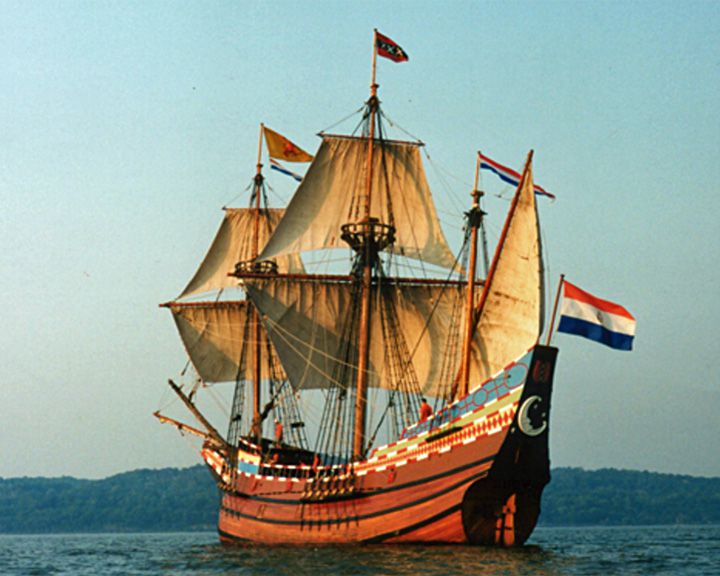 Half Moon — Dutch flyboat, square-rigged, three-masted, wooden Henry Hudson's ship looking for Northwest Passage. Englishman Henry Hudson was in the service of the Dutch East India Company. LAUNCHED: 1609, March → FATE: In 1618 the ship was destroyed during an English attack on Jakarta. |
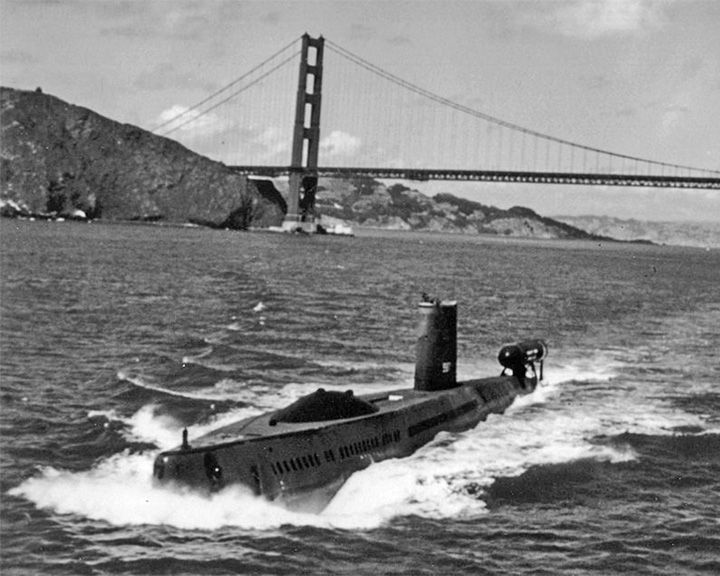 Halibut, USS — American attack submarine Unique nuclear-powered guided missile submarine, adapted for spying operations. In the 1970s, she was used on secret underwater espionage missions by the US against the Soviet Union including the underwater tapping of a Soviet communication line (see Operation Ivy Bells). LAUNCHED: 1959, January 9 → FATE: Moth-balled 1976, dismantled in 1994. |
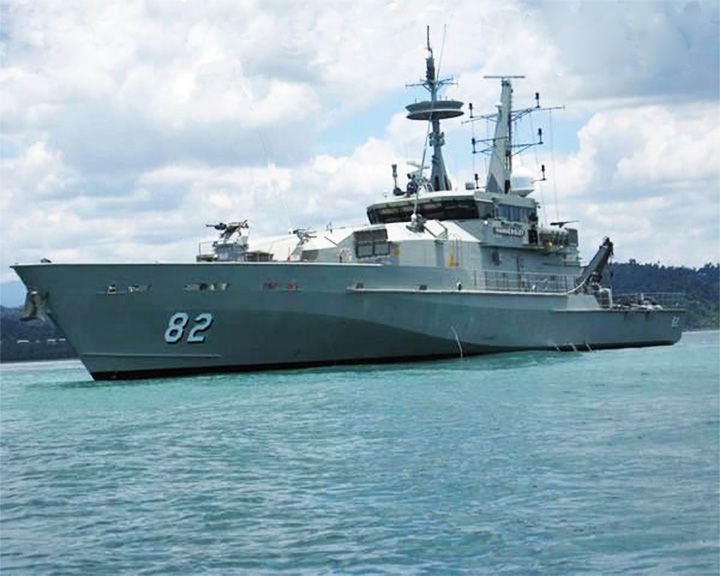 Hammersly, HMAS — Australian Armidale-class patrol boat Setting for the Australian television drama Sea Patrol, from 2007-2011. Several ships were used in filming; first portrayed by two real Fremantle-class patrol boats, then for the second season, two Armidale-class patrol boat were used to represent Hammersley LAUNCHED: 2007 → FATE: Inconclusive. |
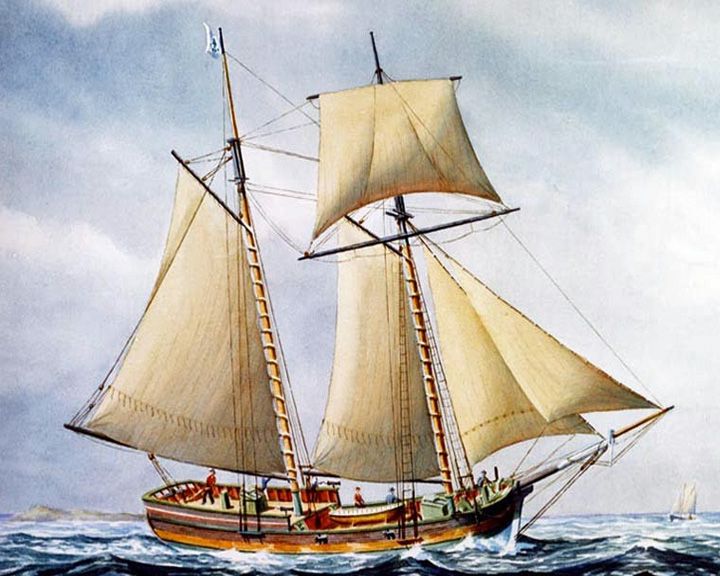 Hannah, USS — American schooner The first armed American naval vessel of the American Revolution and is claimed to be the founding vessel of the US Navy. The city of Beverly, Massachusetts and the town of Marblehead, Massachusetts each claim to have been the home port of the schooner. LAUNCHED: 1775, September 2 → FATE: Unknown. |
|
|
Page 24
|
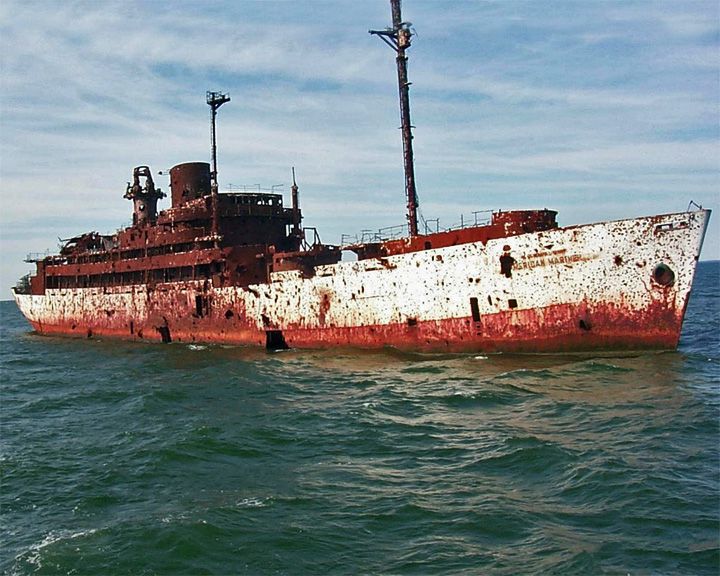 Hannibal, USS — American collier A target ship in the Chesapeake Bay. In 1966, a old WW II Liberty ship, the American Mariner, was made a target ship, and, by tradition, was named Hannibal. LAUNCHED: 1898, April → FATE: Sunk as target practice March 1, 1945. |
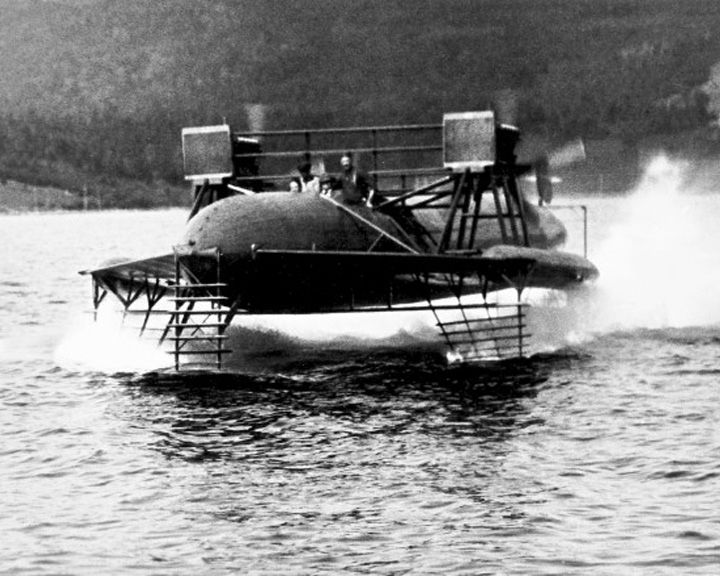 HD-4 — American hydrofoil An early research hydrofoil watercraft developed by the Alexander Graham Bell. She set a world marine speed record of 70.86 miles per hour (114.04 km/h), that stood for almost a year. LAUNCHED: 1919 → FATE: Dismantled in 1921, laying for decades on the shore at Beinn Bhreagh, Nova Scotia. |
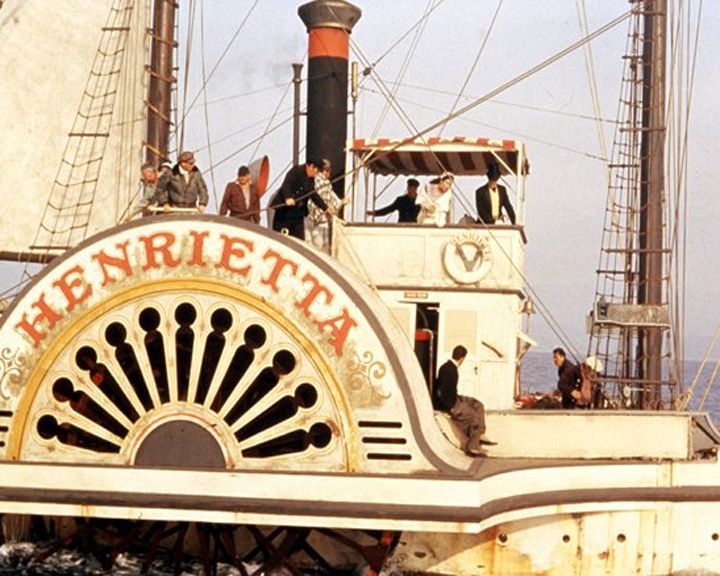 Henrietta — French steamboat Fiction steam boat in the movie Around the World in 80 Days. In the movie, the boat is stripped clean in order to fuel her across the ocean. LAUNCHED: 1956, movie release → FATE: Inconclusive. |
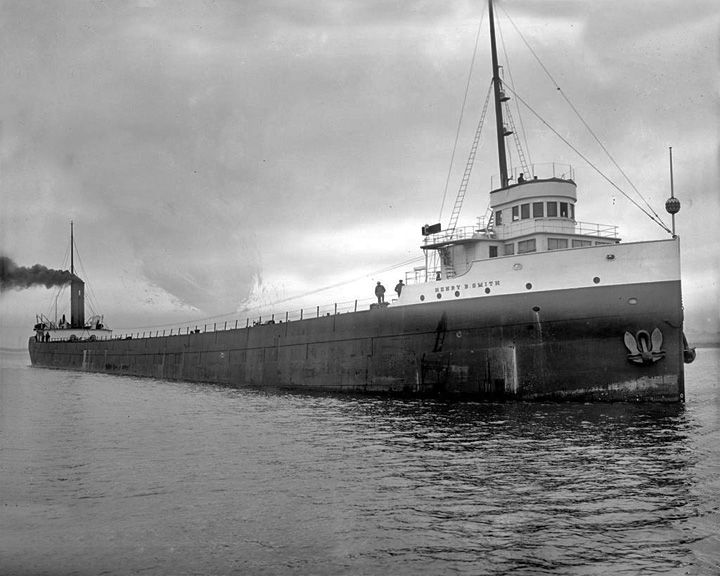 Henry B. Smith, SS — American lake cargo ship, freighter; steel-hulled, propeller-driven One of several ships lost in the Great Lakes Storm of 1913. The crew of 25 were lost and the wreck has not been located as of 2017. LAUNCHED: 1906, May → FATE: Foundered and sank near Marquette Michigan, November 10, 1913. |
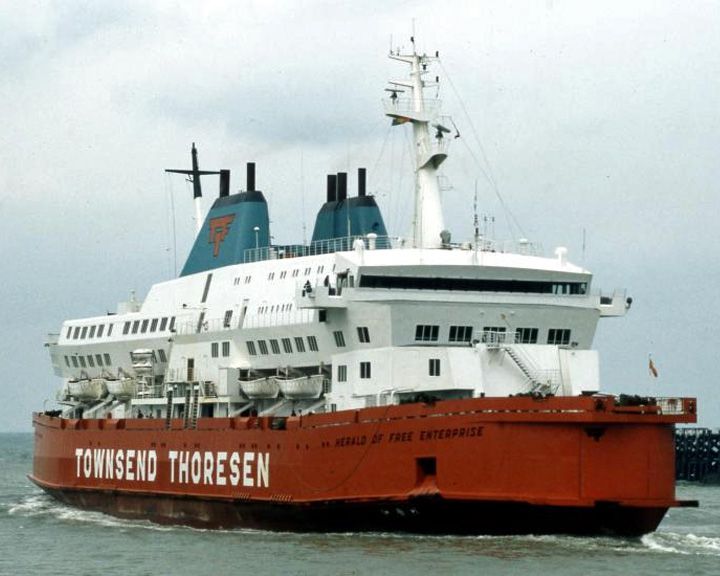 (Another (Another Herald of Free Enterprise, MS — British roll-on/rolll-off ferry Capsized moments after leaving the Belgian port, killing 193 passengers and crew, the highest death-count of any peacetime British maritime disaster since 1919. The ship owners, Townsend Thoresen, re-branded the company as P&O European Ferries, repaint the fleet's red hulls in navy blue and remove the TT logo from the funnels. LAUNCHED: 1980 → FATE: Because deck doors were left open, she filled with water and capsized March 6, 1987; was raised April 1987 and scrapped in 1988. |
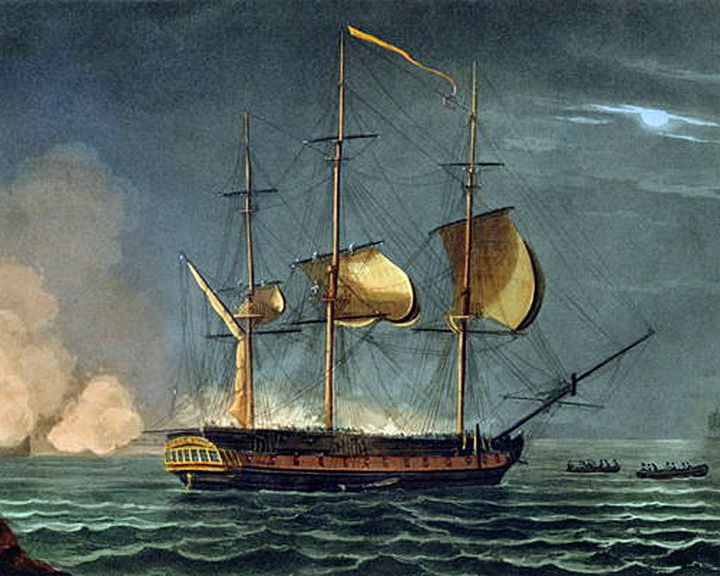 Hermione, HMS — British frigate, fifth-rate Notorious for having the bloodiest mutiny in British naval history. Mutineers gave her to the Spaniards in 1797 who put her in service as Santa Cecilia. She was retaken by the British in 1799 and renamed the Retaliation. LAUNCHED: 1782, September → FATE: Broken up at Deptford in June 1805. |
 Hero, HMAS — British Leander-class frigate Setting for the popular British television series Warship, from 1973-1977. Seven different frigates played the role of HMS Hero, all were repainted with the pennant number F42 of HMS Phoebe, the main warship used for filming. LAUNCHED: 1973 → FATE: Inconclusive. |
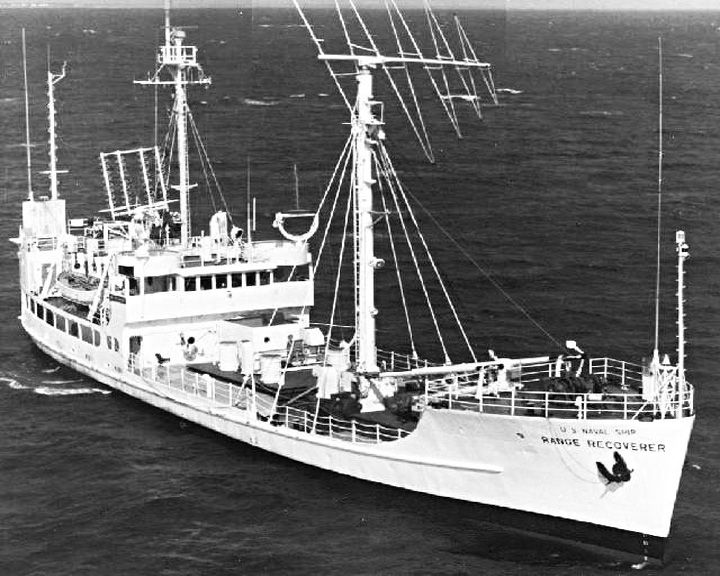 Hewell, USS — American cargo ship Featured in the 1955 movie Mister Roberts, starring Jack Lemmon. For the movie, small alterations were made including the palm trees on deck. LAUNCHED: 1944 → FATE: Scrapped 1973. |
|
|
Page 25
|
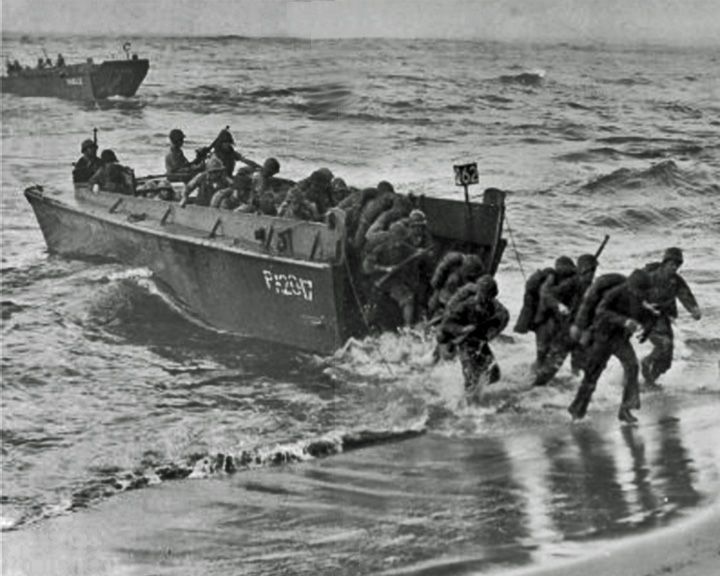 Higgins boat — American troop landing craft (Landing Craft, Vehicle, Personnel or LCVP) Troop landing craft crucial to the Allied victories in World War II. Designed by Andrew Higgins, nearly 20,000 were build. LAUNCHED: 1935 → FATE: Only a few survive and are being restored. |
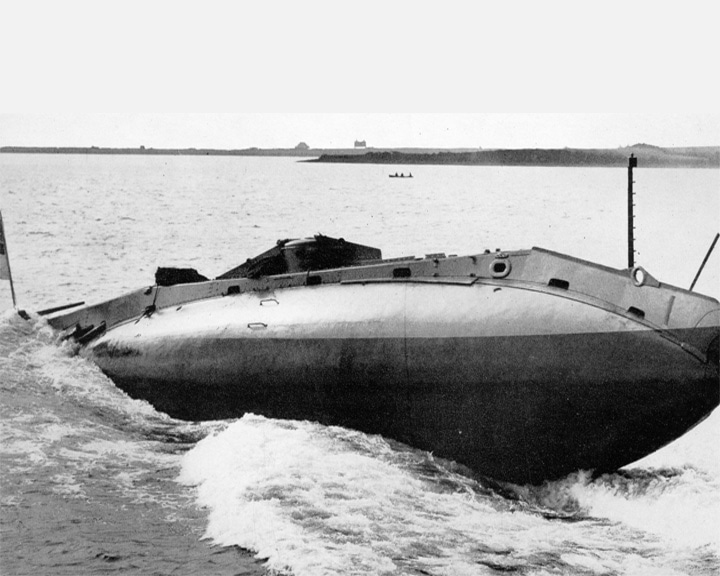 Holland I, HMS — British submarine The first submarine commissioned by the Royal Navy. While being towed to the scrapyard she sank in bad weather off the coast of Eddystone lighthouse. LAUNCHED: 1901, October → FATE: On display at Royal Navy Submarine Museum, Gosport. |
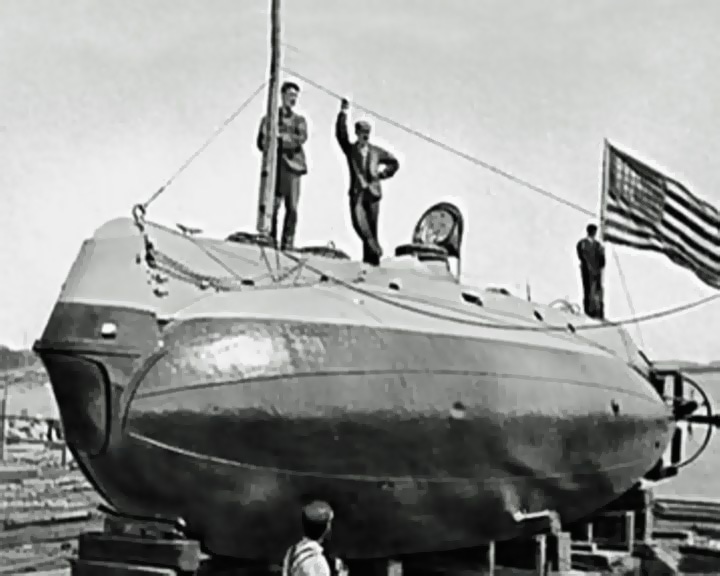 Holland, USS (SS-1) — American submarine First modern commissioned submarine for the US Navy. She proved valuable for experimental purposes in collecting data for submarines under construction or contemplation and for training officers and enlisted men. LAUNCHED: 1897, May 17 → FATE: On display in a park in Paterson, New Jersey until sold for scrap, 1932. |
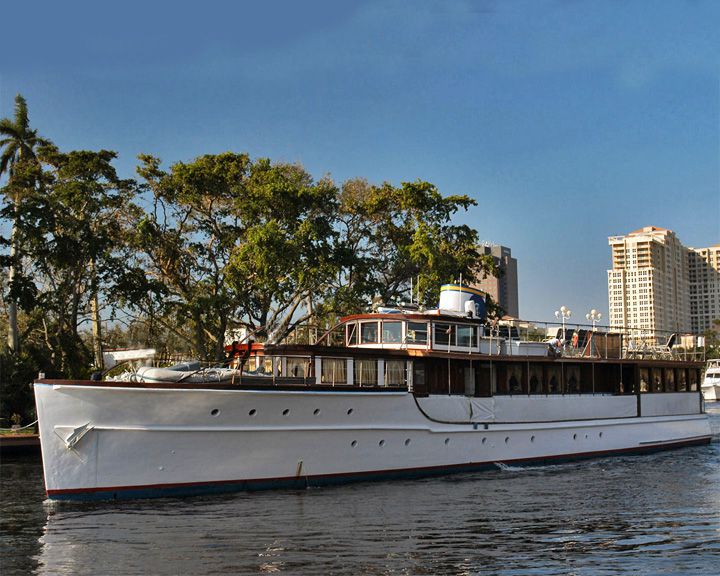 Honey Fitz — American yacht Presidential yacht was renamed after John Francis "Honey Fitz" Fitzgerald, maternal grandfather of President John F. Kennedy. The yacht saw service during World War II as a picket ship off Fire Island, New York. She also served as a training ship for submarine crews. LAUNCHED: 1931 → FATE: Still in service as a pleasure boat. |
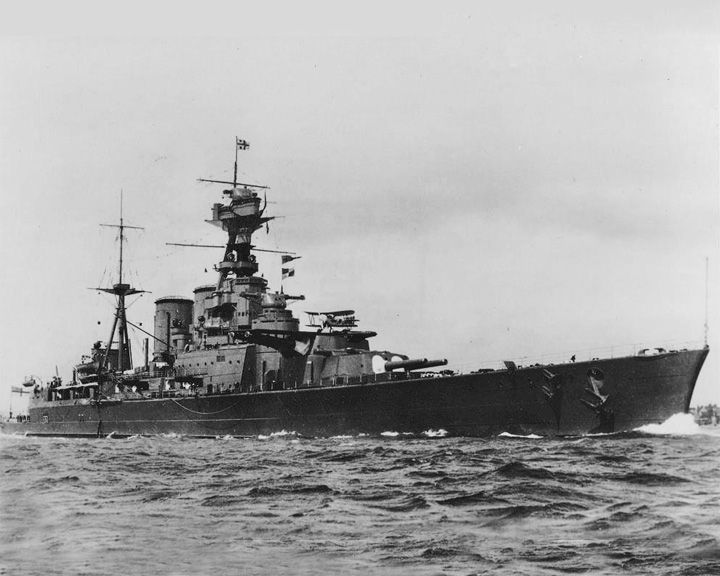 Hood, HMS — British battle cruiser Last battle cruiser built by Britain. Of the 1,418 aboard, only three men survived. LAUNCHED: 1918, August 18 → FATE: Sunk by the German battleship Bismarck at the Battle of the Denmark Strait May of 1941. |
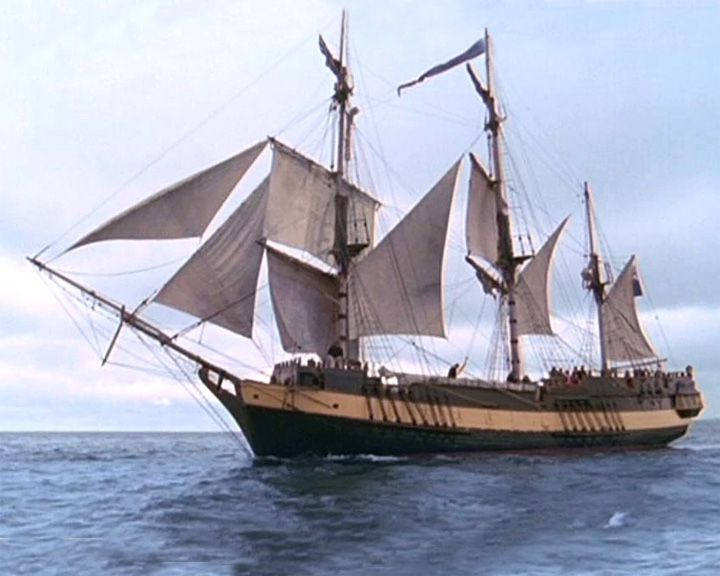 Hotspur, HMS — British sloop-of-war Ship of Horatio Hornblower in the book series and British TV series Hornblower and the Hotspur by C. S. Forester. In the TV series, she is captured by the French. After Hornblower and the crew later discover the ship, they succeed in retaking it. LAUNCHED: 1962, for the book; 1988 2003 for the TV series → FATE: Unknown. |
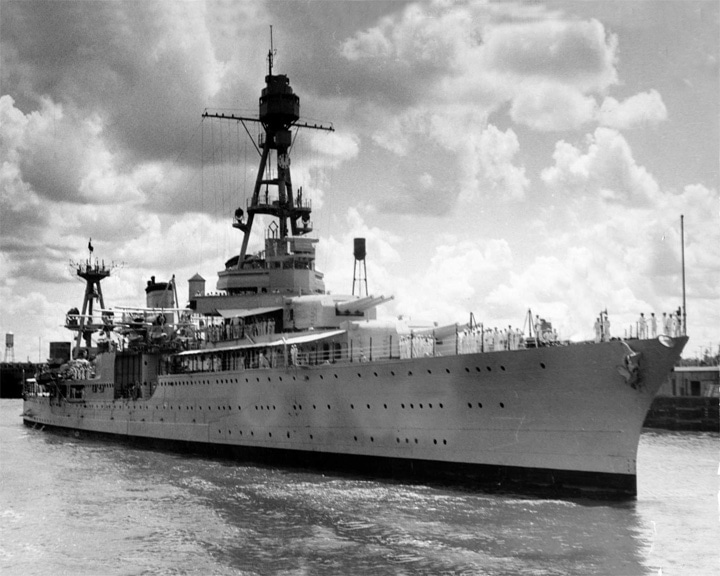 Houston, USS (CA-30) — American cruiser, Northampton-class During the Battle of Sundra Strait, she put up a valiant effort an against overwhelming Japanese offense. In the 1930s, she made several special cruises, several with President Franklin Roosevelt aboard. LAUNCHED: 1929, September 7 → FATE: Sunk by a torpedo, 1 March 1942. |
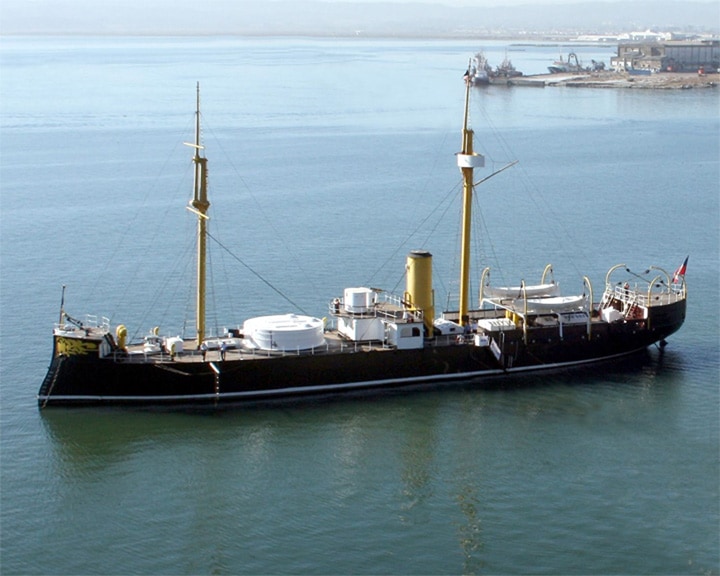 (Another (Another Huáscar — Peruvian iron-clad turret ship The flagship of the Peruvian Navy and participated in the Battle of Pacocha and the War of the Pacific of 1879–1883. She is the second oldest armored warship afloat and the oldest monitor afloat LAUNCHED: 1865, October 6 → FATE: She was restored and is a memorial ship anchored in Talcahuano, Chile. |
|
|
Page 26
|
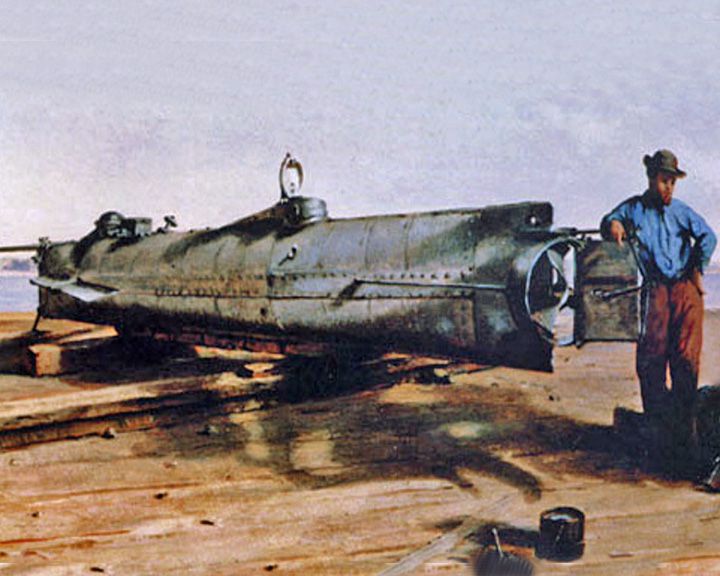 Hunley, H.L. — American Confederate submarine During the American Civil War, the first submarine to sink a ship. She a ttacked by embedding a barbed spar torpedo into the foe's hull and detonating it as she backed away. LAUNCHED: 1863, July → FATE: Sank after attacking and sinking USS Housatonic in Charleston Harbor, February 17, 1864. |
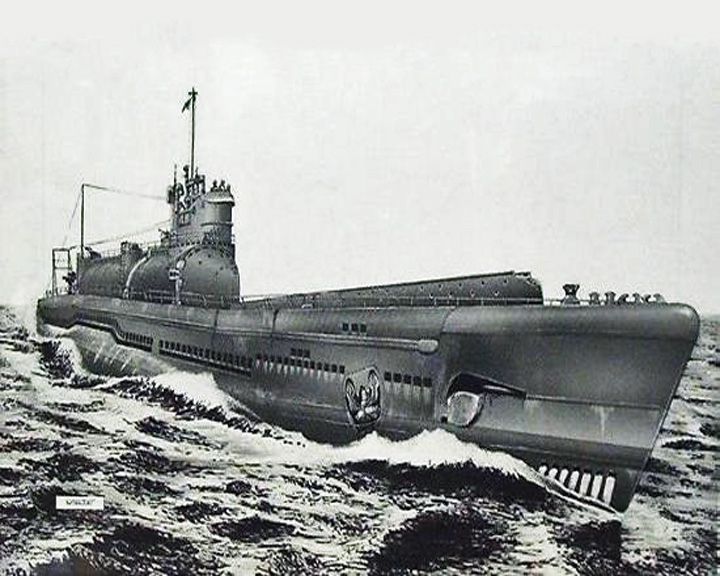 I-400 — Japanese submarine The largest non-nuclear submarines ever built. These submarine aircraft carriers were able to carry three aircraft underwater to their destinations, surface, launch their planes, then quickly dive again. LAUNCHED: 1943, January 1945 July → FATE: Scuttled near Kalaeloa, Hawaii on June 4, 1946. |
Icon of the Seas — American cruise ship Largest passenger ship ever constructed, accommodating 7600 guests and a gross tonnage of 250,800, surpassing Wonder of the Seas at 235,600.. At 1,198 feet (365 meters) in length, she is longer than the largest military ship ever built, the U.S. Gerald R. Ford-class aircraft carrier at 1,106 feet (337 meters). LAUNCHED: 2022, December 9 → FATE: Still in service. |
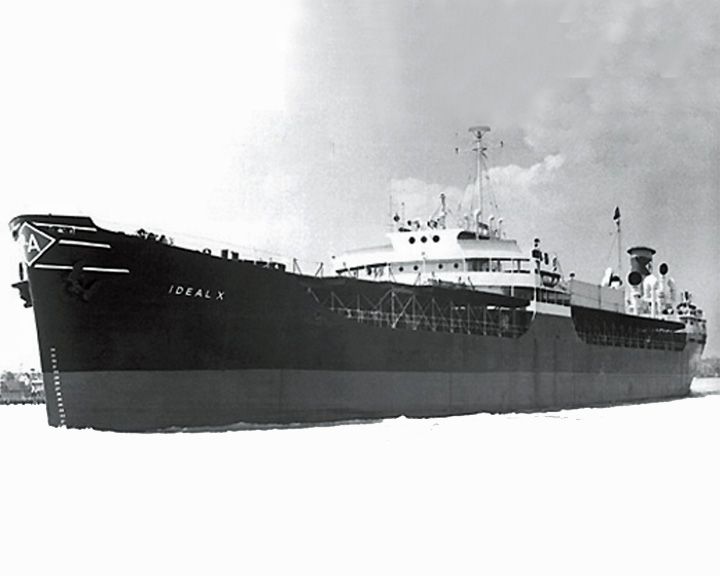 Ideal X, SS — American cargo ship (container ship) First container ship. She was converted from a World War II T-2 oil tanker named Potrero Hills by a trucking executive named Malcolm McLean. LAUNCHED: 1944, December → FATE: Scrapped in Japan in 1967. |
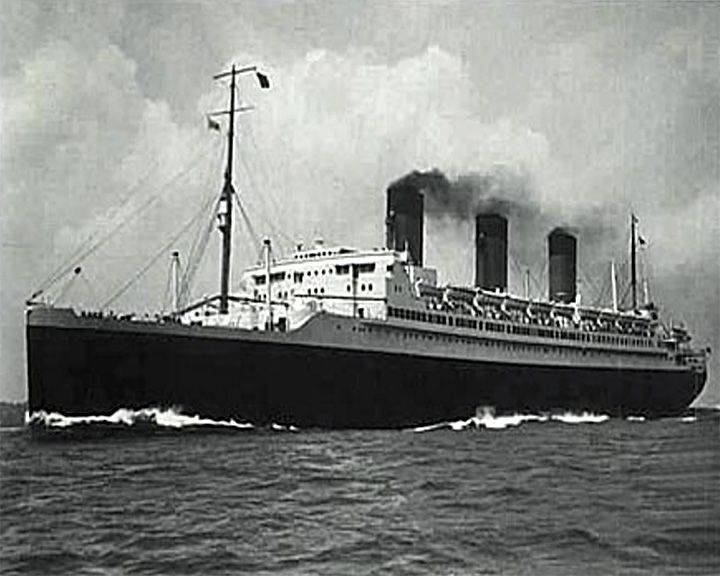 Ile de France, SS — French ocean liner Used as a floating prop for 1960 movie The Last Voyage with the name SS Claridon. She was the first major transatlantic ocean liner to be decorated entirely in the Art Deco style. LAUNCHED: 1926, March 18 → FATE: Scrapped at Osaka, Japan in 1959. |
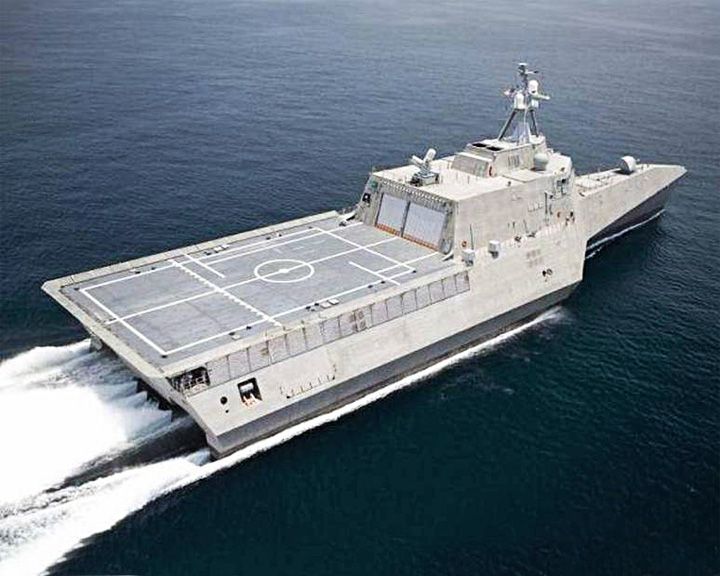 Independence, USS — American trimaran, small assault transport ship A versatile multi-hulled U.S. Navy ship designed for high speed. The ship is a trimaran design that can make more than 40 knots (74 km/h; 46 mph). LAUNCHED: 2008, April 18 → FATE: Currently in service. |
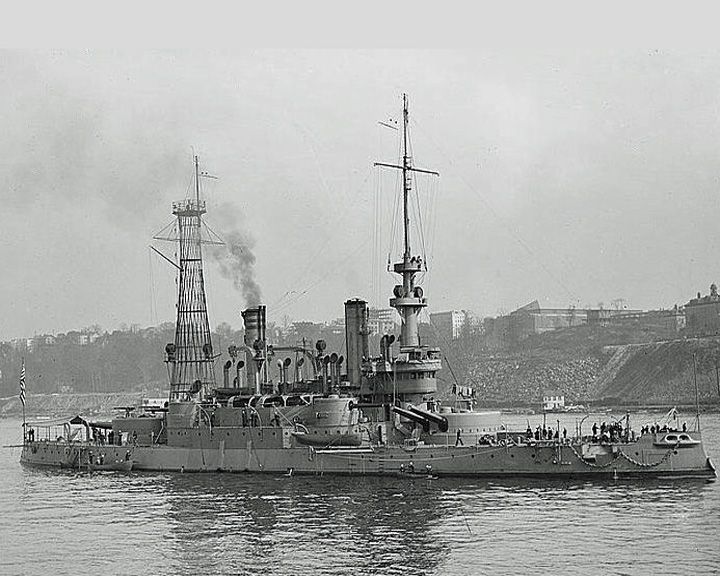 Indiana, USS (BB-1) — American battleship First battleship in the United States Navy comparable to foreign battleships of the time. Decommissioned in 1919, her name was changed to Coast Battleship # 1. She was subsequently used as a target in ordnance tests and sank as a result. LAUNCHED: 1893, February 28 → FATE: Sunk as target on November 1, 1920 |
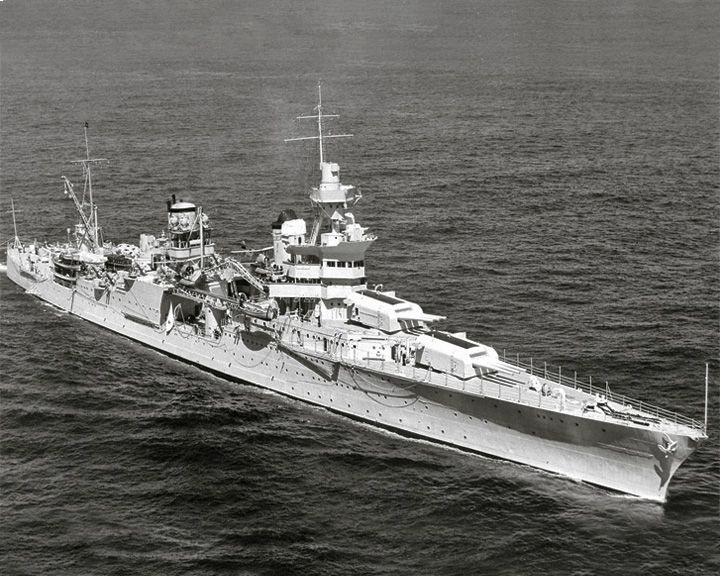 Indianapolis, USS — American Portland-class cruiser Last U.S. ship sunk by enemy in World War II; greatest loss of life at sea in the U.S. Navy's history. Four days after delivering the 1st atomic bomb to Tinian, she was torpedoed and sank with 300 crew. The 900 survivors faced exposure, dehydration, and shark attacks until 4 days later only 317 were rescued. LAUNCHED: 1931, November 18 → FATE: Sunk by a Japanese submarine July 30, 1945. |
|
|
Page 27
|
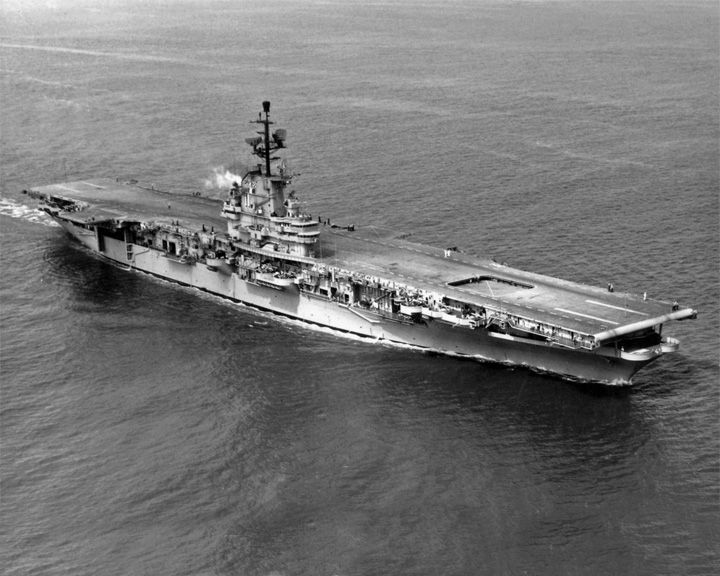 Intrepid, USS — American aircraft carrier; Essex-class In World War II, served extensively in the Pacific; later recovered capsules in space program. Upgraded several times; first American carrier to launch aircraft with steam catapults. One of more than a dozen English and American ships and boats named Intrepid. LAUNCHED: 1943, April 18 → FATE: Currently a museum ship docked at Intrepid Sea, Air & Space Museum in New York City. |
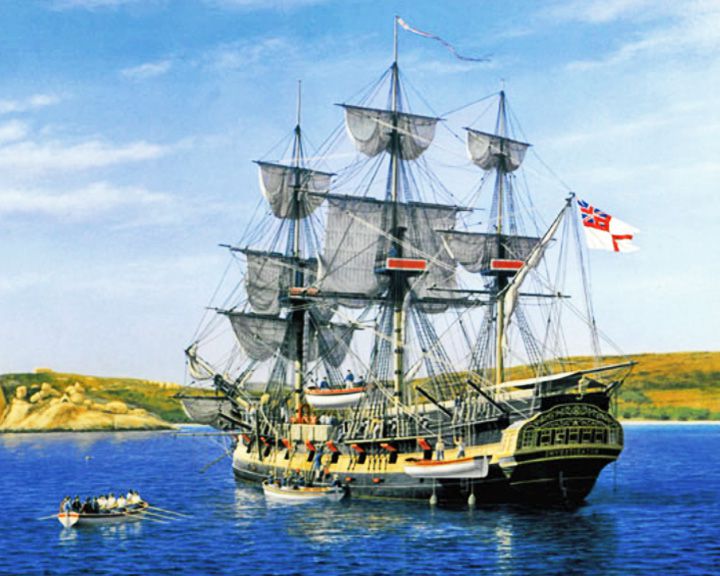 Investigator, HMS — British collier, then in 1801 converted to a survey ship. The first ship to circumnavigate Australia. The Royal Navy sold her in 1810 and she returned to mercantile service under the name Xenophon. LAUNCHED: 1795 → FATE: Broken up about 1872. |
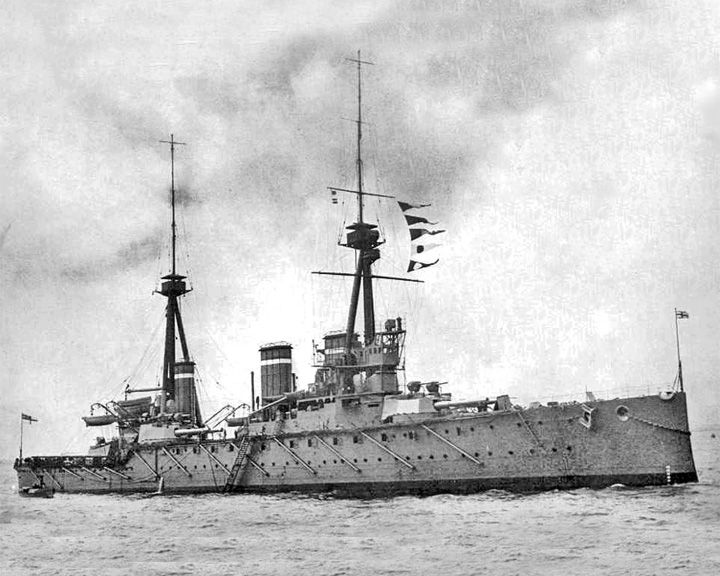 Invincible, HMS — British battlecruiser First battle cruiser to be built by any country in the world. She is one of seven ships named Invincible in the British navy from 1747 to the present. LAUNCHED: 1907, April 18 → FATE: Sunk by the German battleship SMS Lützow at the Battle of Jutland, May 31, 1916. |
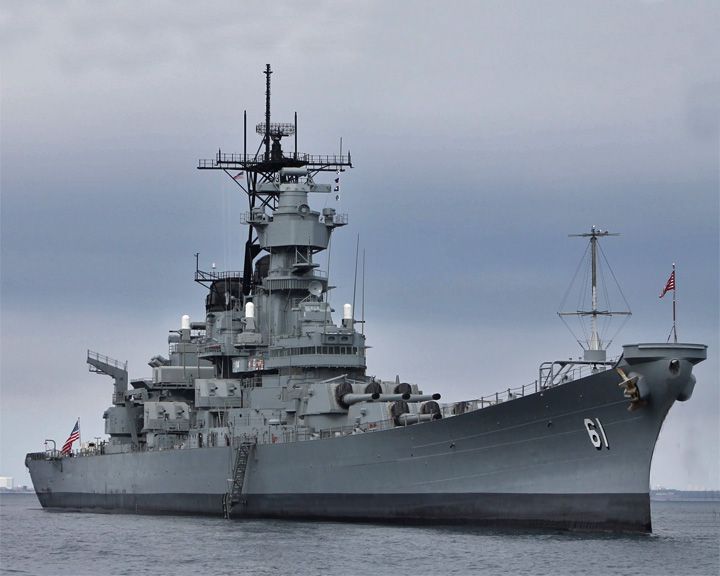 (Another (Another Iowa, USS — American fast battleship First of her class, the last battleship in active service in the world. During a gunnery exercise, on April 19, 1989, an explosion ripped through a gun turret, killing 47 crewmen. LAUNCHED: 1942, August 18 → FATE: Anchored at San Pedro as a museum ship. |
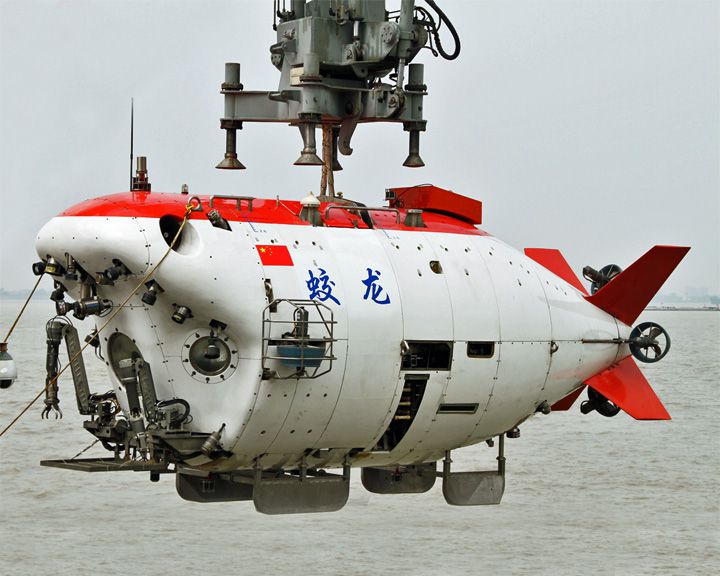 Jiaolong — Chinese research vessel, submersible World's first manned research submersible designed to reach a depth of 7,000 meters below sea level. Named after a mythical river dragon, spiritually akin to the crocodile. LAUNCHED: 2010, July → FATE: Still in operation. |
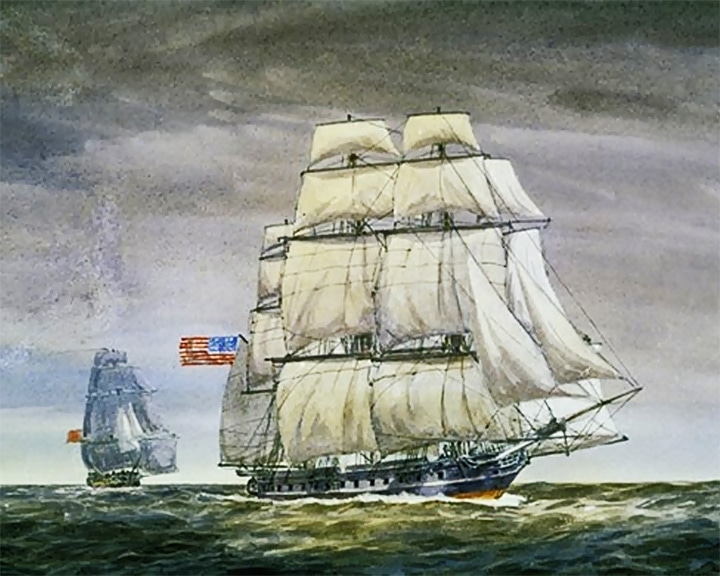 John Adams, USS — American frigate She participated in the raid on Combahee Ferry that Harriet Tubman, the former slave and Union operative, organized with Union colonel Montgomery. She fought in the Quasi-War, the First and Second Barbary Wars, the War of 1812, the Mexican–American War and the American Civil War. LAUNCHED: 1799, October → FATE: Sold October 1867 to the British to use as the Hong Kong Water Police Headquarters. In February 1884, she caught fire and was lost. |
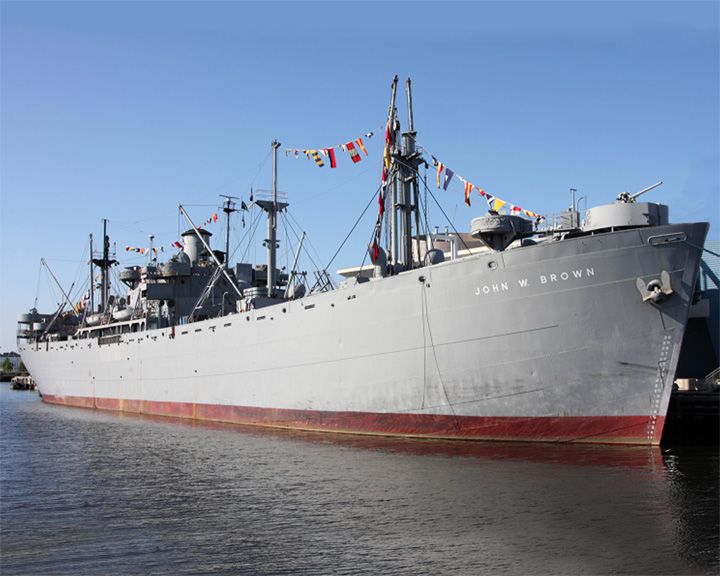 John W. Brown, SS — American liberty ship One of two still operational and one of three preserved as museum ships. After making 12 troop and cargo voyages across the Atlantic during World War II, she served as a training ship from 1946 to 1982. LAUNCHED: 1942, September 7 → FATE: After restoration, now a floating museum stationed in the Chesapeake Bay, Baltimore, Maryland. |
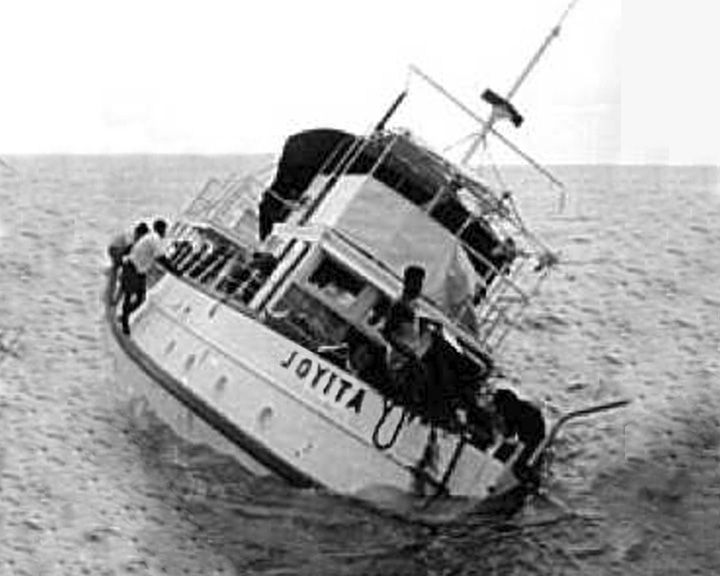 Joyita — American luxury yacht, outfitted as a yard patrol boat Found adrift in the South Pacific, her passengers and crew mysteriously missing in 1955. She is sometimes referred to as the "Mary Celeste of the South Pacific." She has been the subject of several narrations offering explanations ranging from rational to supernatural. LAUNCHED: 1931 → FATE: Broken up near Ovalau, Fiji in the 1970s. |
|
|
Page 28
|
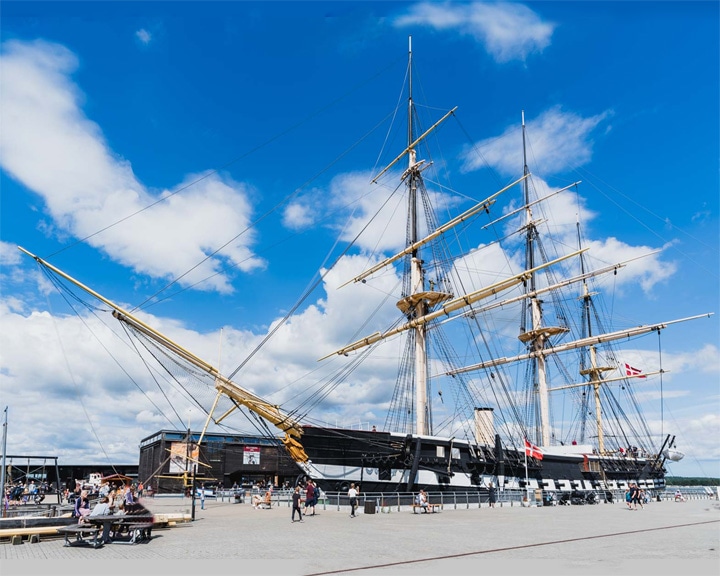 Jylland, HDMS — Danish screw-propelled steam frigate The world's largest wooden warship still in existence. She took part in the Battle of Heligoland May 9, 1864 LAUNCHED: 1860, November 20 → FATE: She is preserved as a museum ship in the small town of Eblet, Denmark. |
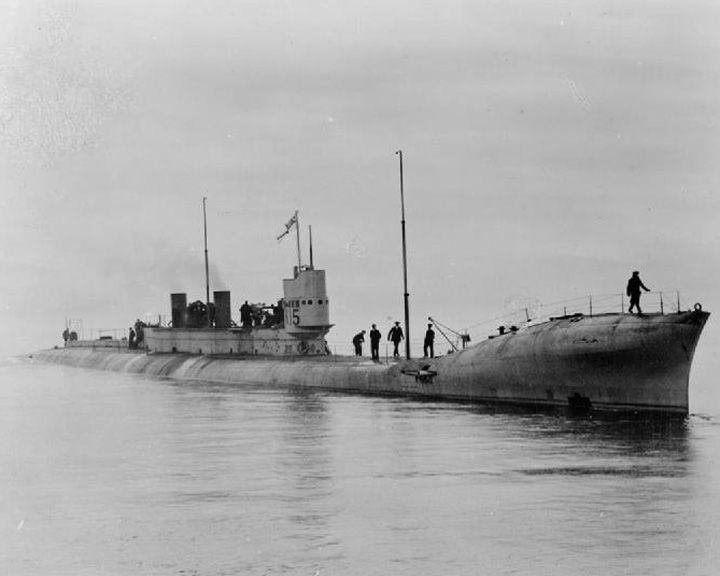 K-13 — British K-class submarine The first in the class of the steam-powered submarines. She sank in an accident during sea trials in early 1917 and was salvaged and recommissioned as HMS K22. 32 people died in the accident and 48 were rescued. LAUNCHED: 1916, November 11 → FATE: Sold for scrapping December 16, 1926 in Sunderland. |
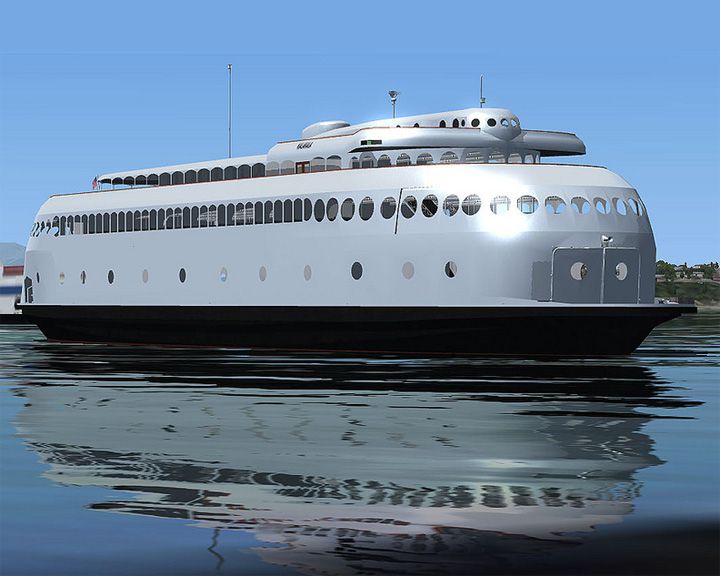 (Another (Another Kalakala — American ferry The first streamlined ferry with Art Deco styling and luxurious amenities served in Puget Sound from 1935 to 1967. From 1926 to 1933, she sailed as the ferry Peralta; after a fire, the superstructure was rebuilt in modern style. LAUNCHED: 1926, April as Peralta; relaunch 1934 → FATE: Moored at Tacoma, Washington. |
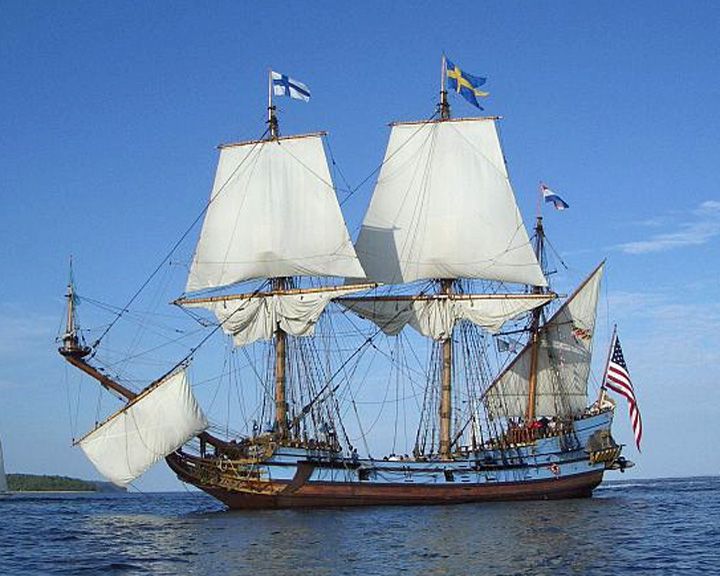 (Another (Another Kalmar Nyckel — Swedish full-rigged pinnace The ship is famed for carrying Swedish settlers to North America in 1638 to establish the colony of New Sweden. A replica (as seen in "Another IMAGE) was launched in 1997. The Kalmar Nyckel made four successful round trips from Sweden to North America, a record unchallenged by any other colonial vessel. LAUNCHED: 1625 → FATE: The original ship was sunk in the North Sea by the Dutch in a war against the English in July of 1652. Replica is in service as a tourist attraction at Wilmington, Delware. |
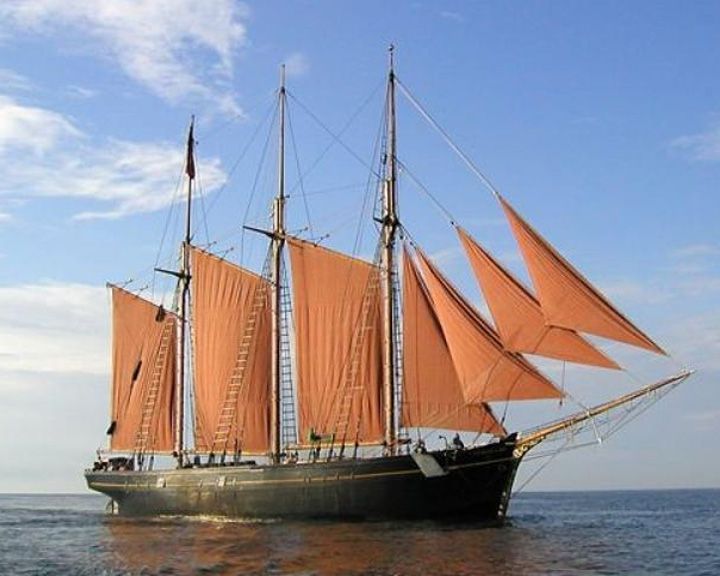 Kathleen and May — British three masted schooner Last remaining British built wooden hull three-masted top sail schooner. Originally equipped with the first known fitting of Appledore roller reefing. After years of service, during restoration in 2000, 70% of the original planking was stripped from the frames, enabling most of her internal timbers to later be refitted. LAUNCHED: 1900, April → FATE: Restored and based in Bideford on the River Torridge. |
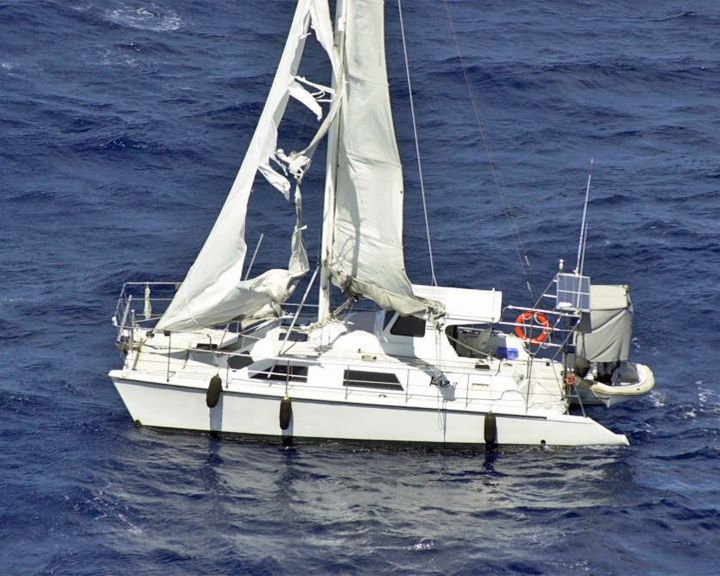 Kaz II — Australian catamaran yacht Three men sailing aboard their yacht mysteriously vanish without a trace off the north-eastern coast of Australia. The fate of her crew is still unknown and the circumstances in which they disappeared can be compared to that of Marie Celeste. LAUNCHED: 1989 → FATE: Unknown. |
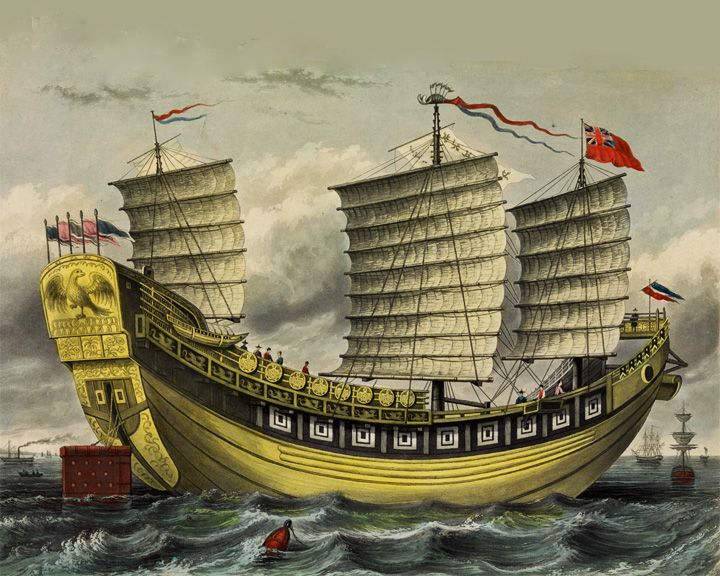 Keying, Junk — Chinese junk, three-masted (trading ship) The first ship from China to visit New York where it was visited by 4,000 tourists a day paying 25 cents to board the ship and meet its crew. She was manned by 30 Chinese and 12 Englishmen, and commanded by the British Captain Charles Alfred Kellett during her travel. LAUNCHED: 1846, circa → FATE: Neglected and rotted in England in 1855. |
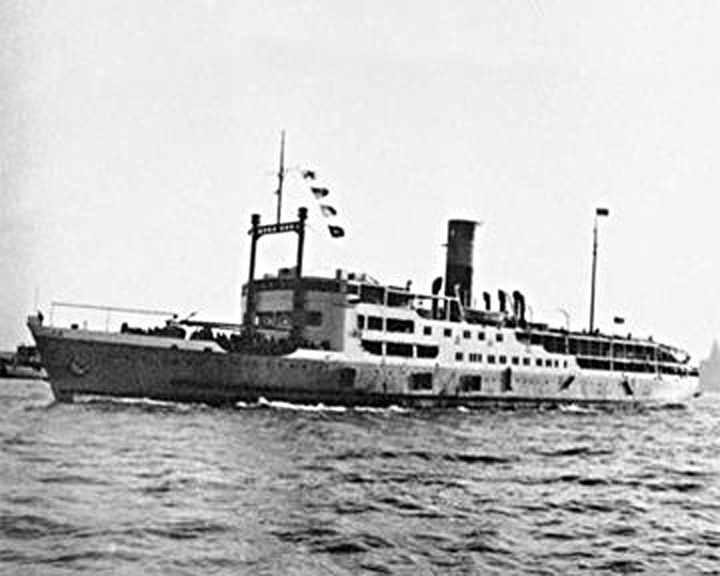 Kiangya, SS — Chinese steamship, passenger Blew up, probably after hitting a World War II Japanese mine, resulting in over 3000 killed. She was packed with refugees from the Chinese Civil War fleeing the advancing Communist army when she sank. LAUNCHED: 1939 → FATE: Sank December 4, 1948 in the mouth of the Huangpu River 50 miles south of Shanghai. |
|
|
Page 29
|
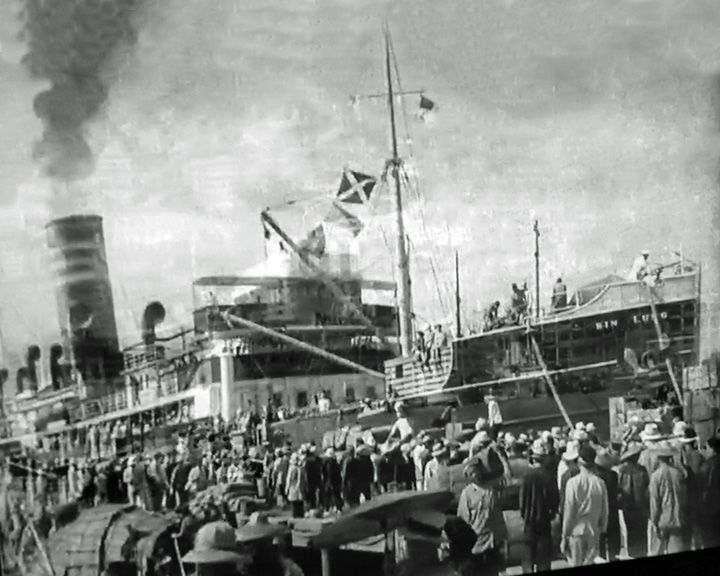 Kin Lung, SS — Chinese tramp steamer The ship setting in the 1935 movie China Seas starring Clark Gable and Jean Harlow. (The ship exterior is rarely seen in the movie; image here is from an opening scene). The special effects during the typhoon with huge waves washing over everyone are dramatic and effective. LAUNCHED: 1935, for the movie; the existence of the actual ship is unknown → FATE: Inconclusive. |
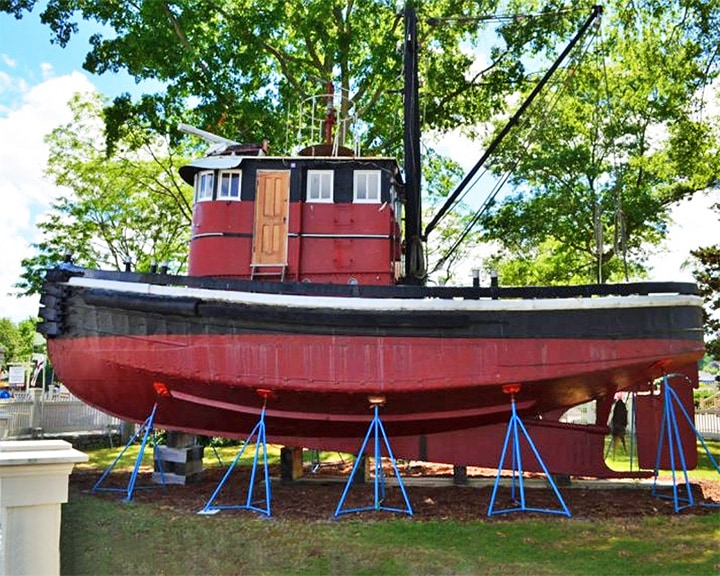 Kingston II — American tugboat She assisted the launch of several U.S. Navy submarines including Nautilus, the world’s first nuclear submarine. Her ceremonial duties at the museum have included leading river parades of antique boats and welcoming visiting vessels from other nations. LAUNCHED: 1937 → FATE: On exhibit at Mystic Seaport Museum at Mystic, Connecticut. |
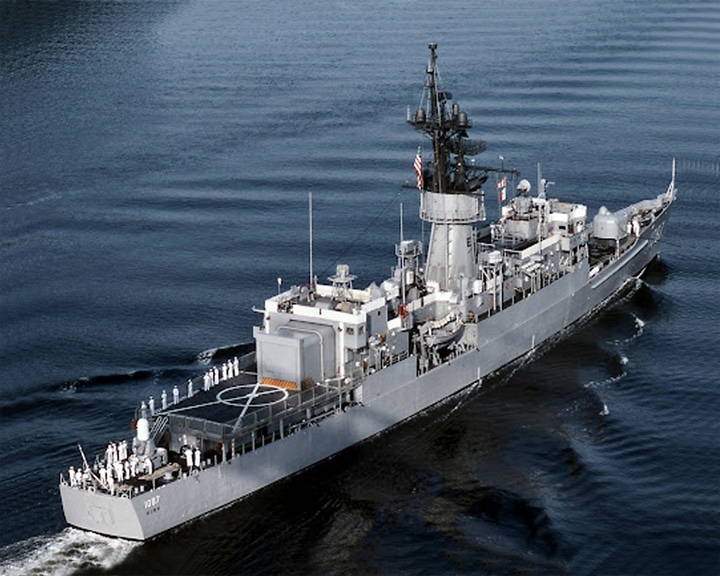 (Another (Another Kirk, USS — American destroyer escort, Knox-class She was sent to help evacuate Americans and fleeing refugees from South Vietnam, caring out one of the most significant humanitarian missions in U.S. military history.. During the evacuation, she was a makeshift landing pad for helicopters flown by South Vietnamese pilots fleeing with families and friends on board. LAUNCHED: 1971, September 25 → FATE: On 29 September 1999, the ship was purchased by Taiwan and renamed Fen Yang. |
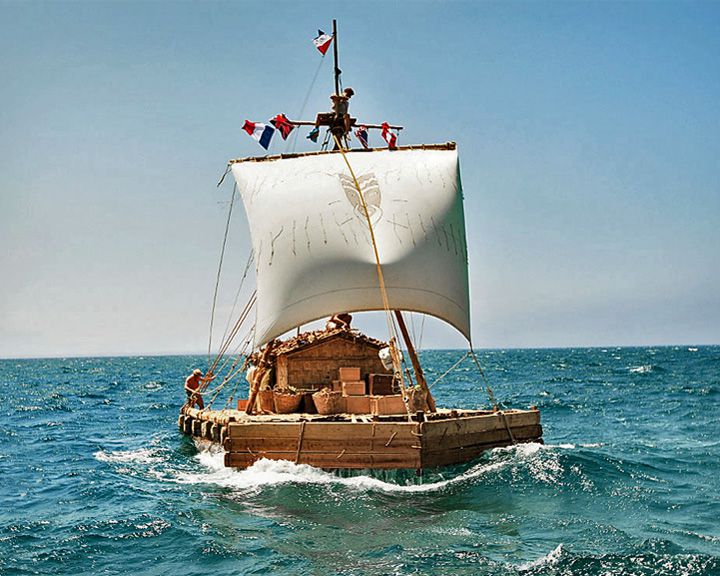 Kon Tiki — Norwegian raft Used by Norwegian Thor Heyerdahl to cross the Pacific. Heyerdahl used the craft in his 1947 expedition from South America to the Polynesian islands to show that people from South America could have settled Polynesia in pre-Columbian times. LAUNCHED: 1947 → FATE: On display in the Kon-Tiki Museum in Oslo, Norway. |
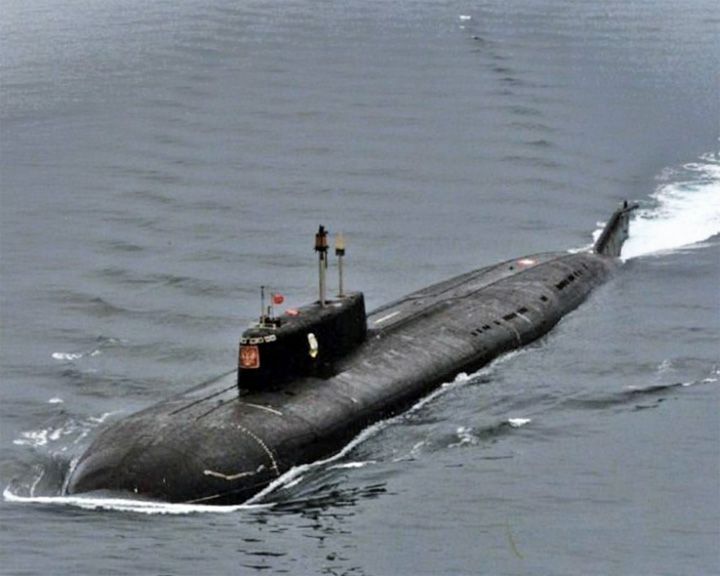 Kursk, K-141 — Russian nuclear submarine Sank with all 118 crew; Russia declined rescue offers even though rescue of some was possible. With the use of a giant barge, the she was eventually raised and the dead recovered and buried in Russia. LAUNCHED: 1994 → FATE: Sank in the Barents Sea on August 12, 2000. |
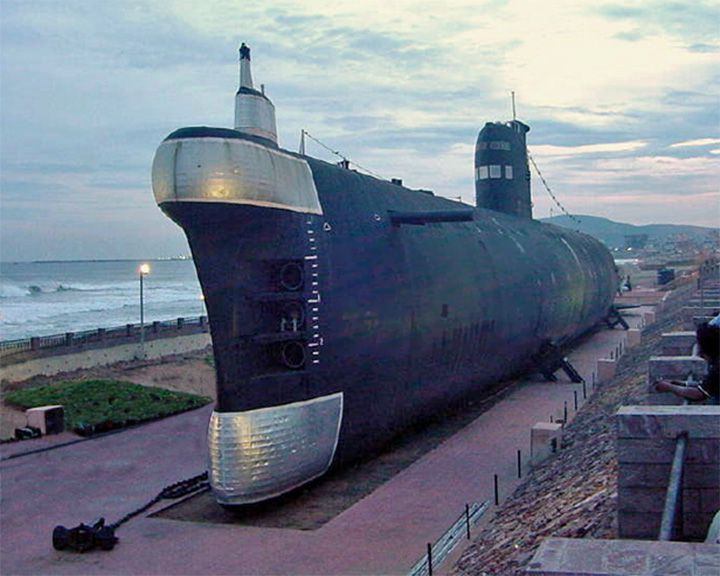 Kursura, INS — Indian Kalvari-class submarine (Russian built) A famous tourist attraction and one of the few submarine museums to be exhibited as it was in service. She was laid off for several years and cannibalized for spare parts for other submarines; then between 1980 to 1982 underwent a refit in the Soviet Union and made operational again in 1985. LAUNCHED: 1969, December 18 → FATE: Decommissioned on February 2001 and made into a museum ship August 2002 at Ramakrishna Mission Beach in Visakhapatnam, India. |
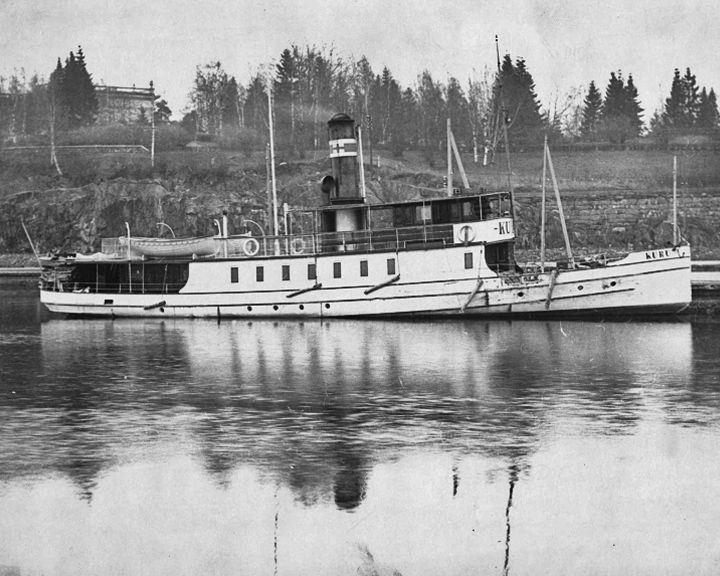 Kuru, SS — Finnish steamship On September 7, 1929, she capsized and sank on lake Näsijärvi, in Tampere making it the worst maritime disaster in Finnish waters with the loss of 136 lives. The capsizing was mainly due to a high center of gravity when a third deck level was added in 1927. LAUNCHED: 1915 → FATE: The wreck was raised and repaired shortly afterwards and served until 1936. |
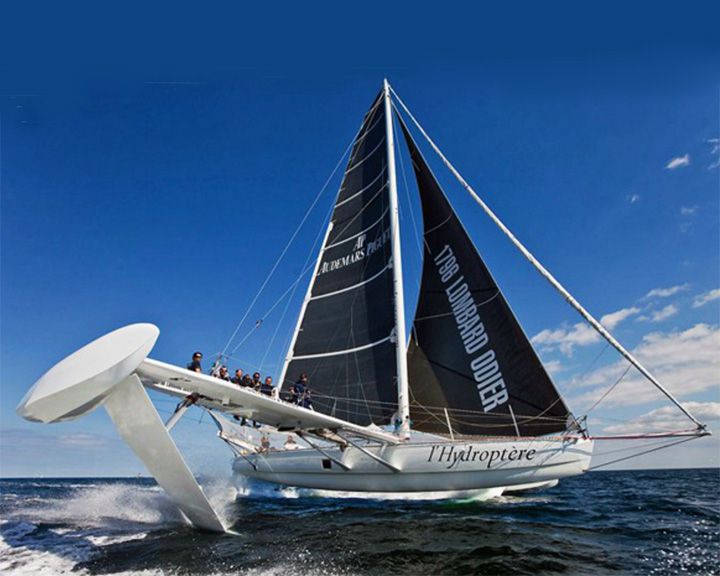 L'Hydroptère — French speed sailboat; experimental Currently the world's fastest sailboat. In 2008, it reached a sailing speed of 56.3 knots, the first sailboat to ever pass 100 km/h. LAUNCHED: 2008 → FATE: Still sailing. |
|
|
Page 30
|
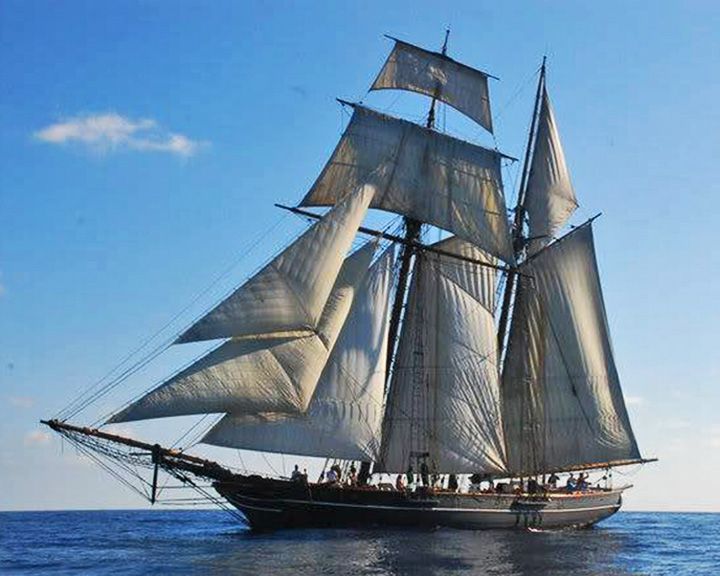 La Amistad — Spanish schooner, two-masted; built in U.S. In 1839, Africans being transported as slaves revolted against their captors aboard. She primarily engaged in short coastal trade with sugar-industry cargo. Her normal route ran from Havana to her home port of Guanaja. LAUNCHED: 1838, maybe → FATE: Renamed Ion, she was sold in Guadeloupe in 1844. No record after 1844. |
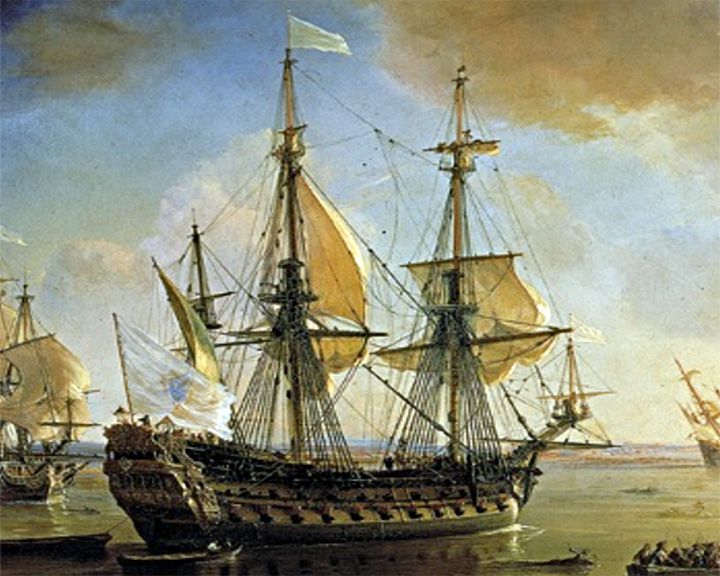 (Another (Another La Belle — French barque Explorer Robert De La Salle's flagship in the 1680s; its wreckage recovered in the late 1990s was an important maritime archaeological achievement. Discovered in 1995, the hull of the ship was recovered with over a million artifacts, many on display at the Bob Bullock Texas State History Museum in Austin, Texas. LAUNCHED: 1684, probably → FATE: Washed aground and wrecked in Matagorda Bay in the Gulf of Mexico in 1686. |
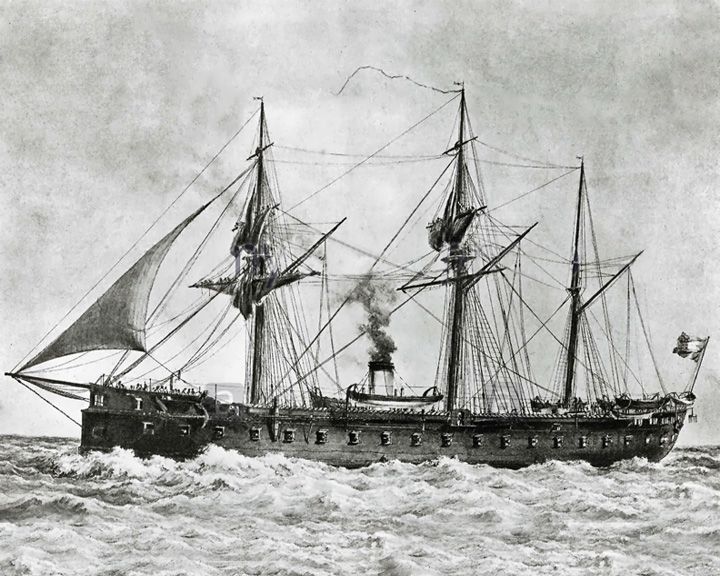 La Gloire — French battleship, steamer The first ocean-going ironclad battleship in history. The ship initiated the obsolescence of traditional unarmored wooden ships-of-the-line. LAUNCHED: 1859, November → FATE: Scrapped in 1883. |
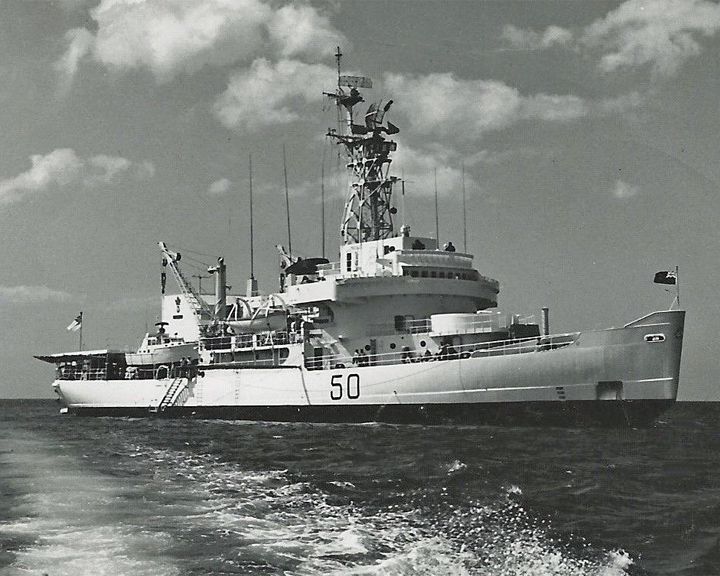 Labrador, CCGS — Canadian Wind-class icebreaker The first ship to circumnavigate North America in a single voyage and first warship to transit the Northwest Passage. Her career marked the beginning of the CCG's icebreaker operations which continue to this day. LAUNCHED: 1951, December 14 → FATE: Sold for scrap and broken up 1989. |
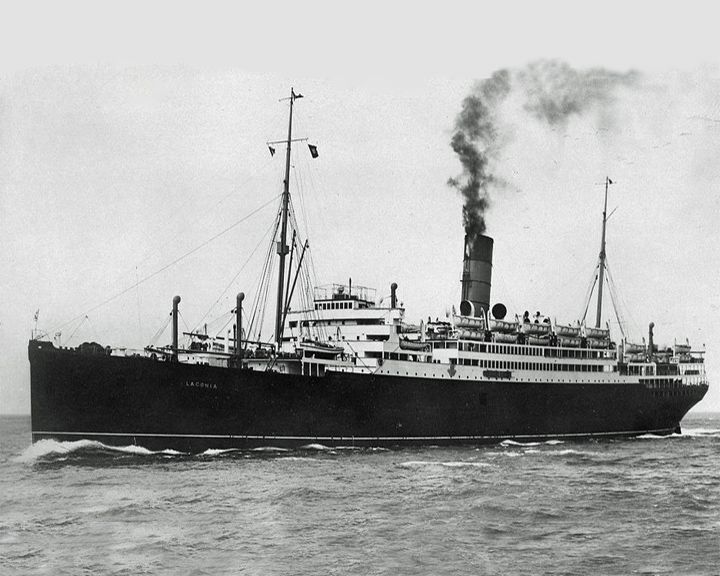 Laconia, RMS — British ocean liner, then converted to a troop ship After a torpedo attack, a dramatic rescue of the ship's passengers turned to disaster and became known as the Laconia incident. U.S. planes attacked the several German U-boats trying to rescue its 2,732 passengers and crew most of whom were abandoned by the subs, resulting in a loss of over 1,649 people. The sinking was portrayed in the 2011 British TV movie. LAUNCHED: 1921, April 18 → FATE: Sunk by German submarine U-156 off the coast of West Africa, September 12, 1942. |
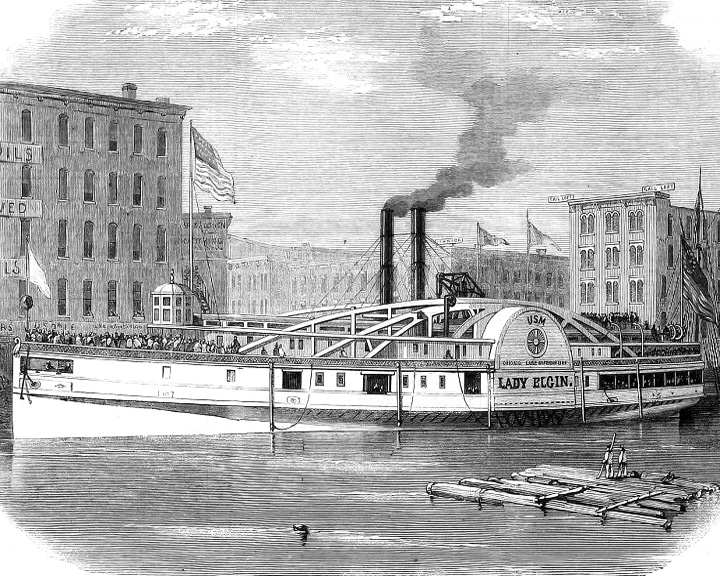 Lady Elgin, PS — American paddle steamer The wooden-hulled sidewheel steamship sank in Lake Michigan near Port Clinton, Illinois with the loss of 300 lives. During her time afloat, she was one of the most elegantly appointed passenger ships sailing the Great Lakes. LAUNCHED: 1851 → FATE: Sunk in collision with schooner Augusta of Oswego September 8, 1860 |
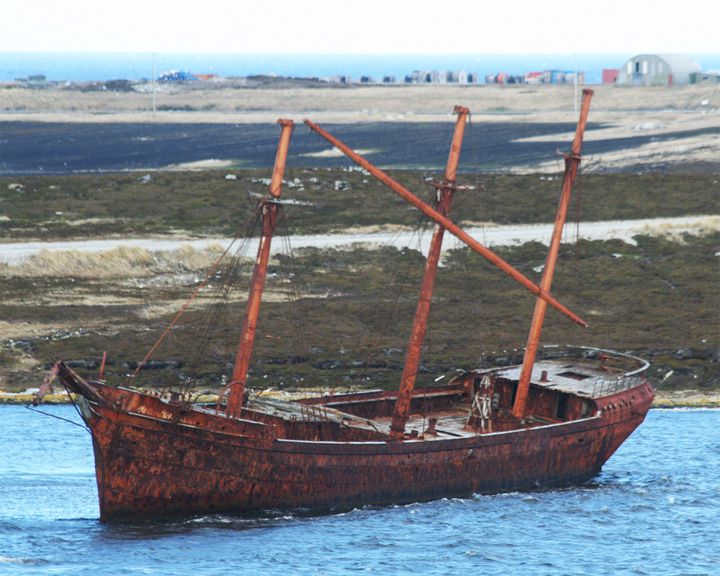 (Another (Another Lady Elizabeth — British 3-masted iron barque The hulk of the ship is the only semi-intact hulk left in the harbours of the Falkland Island. After being condemned in 1913, she served as a timber warehouse alongside the East Jetty. In February 1936 she broke her moorings in a storm and drifted to her present location. LAUNCHED: 1879, June 6 → FATE: Her remains now lie at the bottom of Whale Bone Cove harbour, Stanley, Falkland Islands. |
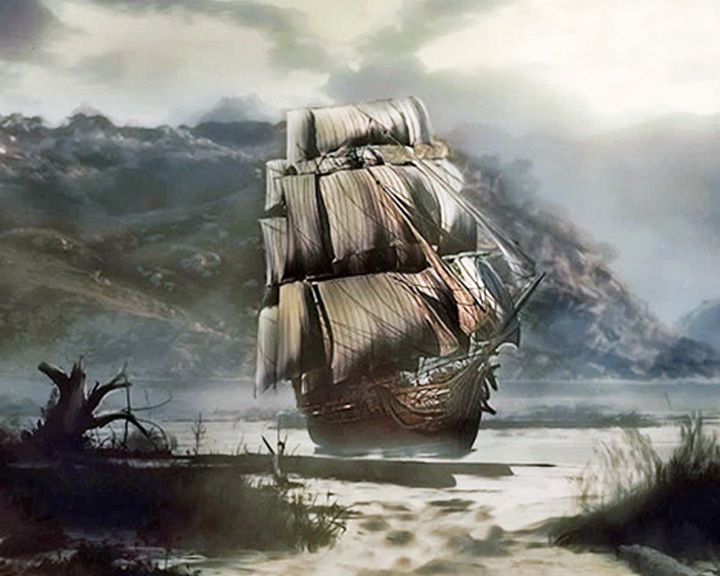 Lady Lovibond — English schooner A legendary ship said to reappear every fifty years as a ghost ship, yet no records of the ship or its sinking exist. The ship may have been a fabrication from a newspaper article in 1924, or based on phantom sightings between 1914 and 1924. LAUNCHED: 1798, February 12, first supposed sighting → FATE: Allegedly wrecked on the Goodwin Sands, off the coast of south-east England, on February 13, 1748, killing everyone aboard. |
|
|
Page 31
|
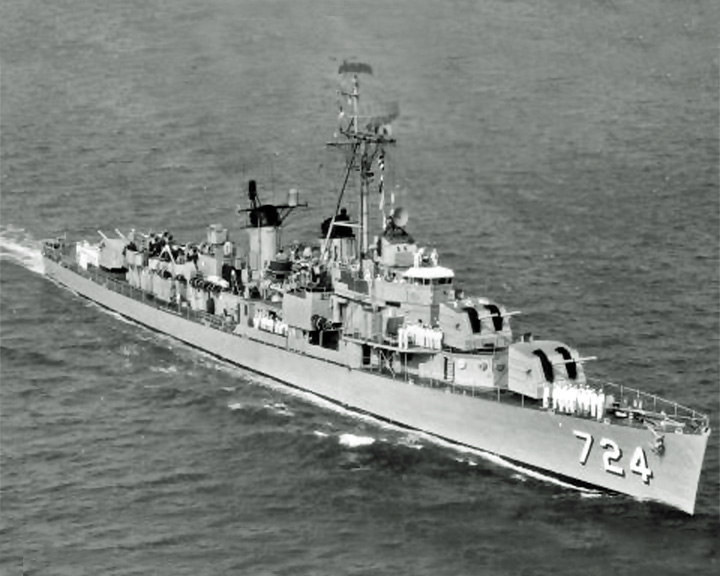 Laffey, USS — American Allen M. Sumner-class destroyer During the battle of Okinawa, she withstood the greatest kamikaze air attack in history, losing 32 killed and 71 wounded. Laffey was declared a National Historic Landmark in 1986, the only remaining US-owned Sumner-class destroyer LAUNCHED: 1943, November 21 → FATE: After WWII, she was repaired and continued to serve until decommissioned March 9, 1975. Laffey is currently a museum ship at Patriots Point in Mount Pleasant, South Carolina. |
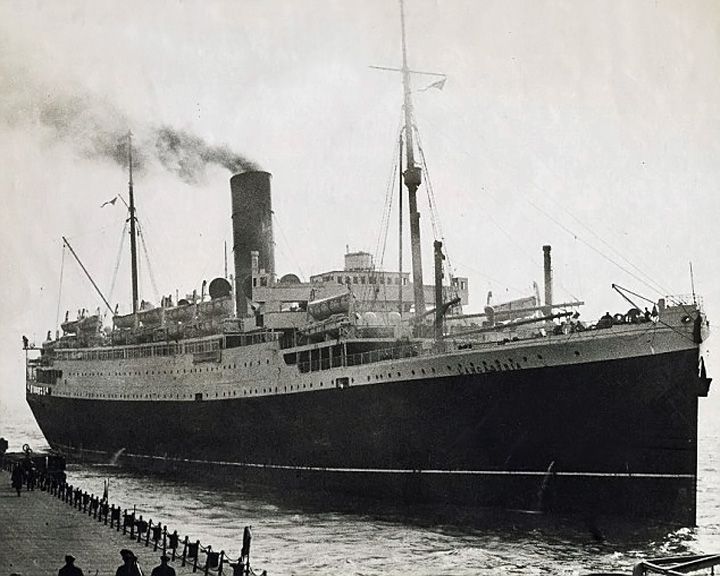 Lancastria, RMS — British ocean liner Worst single loss of life in British maritime history and the bloodiest single engagement for UK forces in World War II. Over 4000 people were lost while evacuating British nationals and troops from France. LAUNCHED: 1922, June → FATE: Sunk off the French port of St. Nazaireon June 17, 1940. |
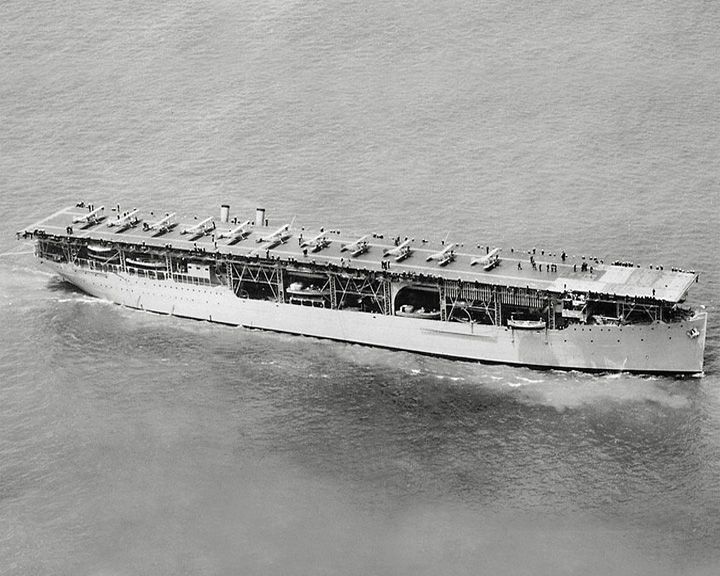 Langley, USS — American aircraft carrier First American aircraft carrier and U.S. Navy's first turbo-electric-powered ship. Following a conversion in 1936 to a seaplane tender, she fought in World War II. LAUNCHED: 1911, built as a collier converted in 1920 → FATE: Attacked and badly damaged by Japanese planes, she was scuttled, February 27, 1942. |
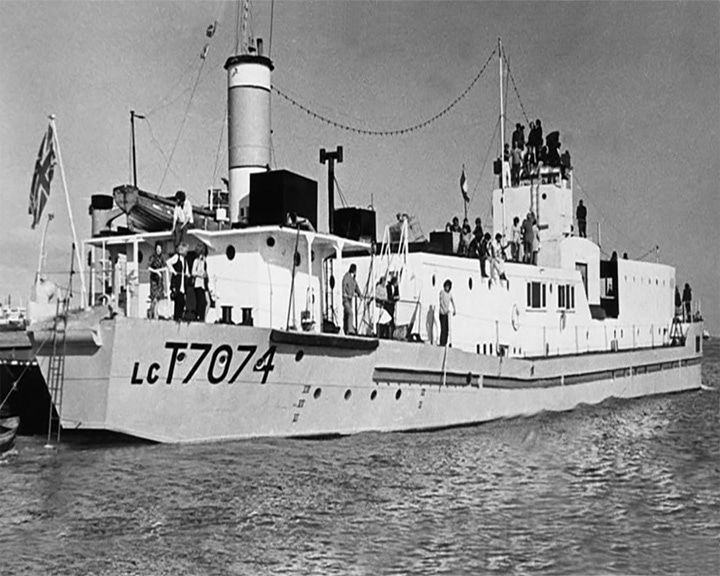 LCT7074, HM — British landing craft, tank (LCT) The last amphibious assault ship in the United Kingdom for landing tanks, other vehicles and troops on beachheads. De-commissioned in 1947 she was renamed Landfall and became the club ship for the Master Mariners’ Club of Liverpool. The craft was later converted into a riverfront nightclub. LAUNCHED: 1944, April 4 → FATE: Salvaged and restored by 2020, then moved to a permanent display at Portsmouth's The D-Day Story museum. |
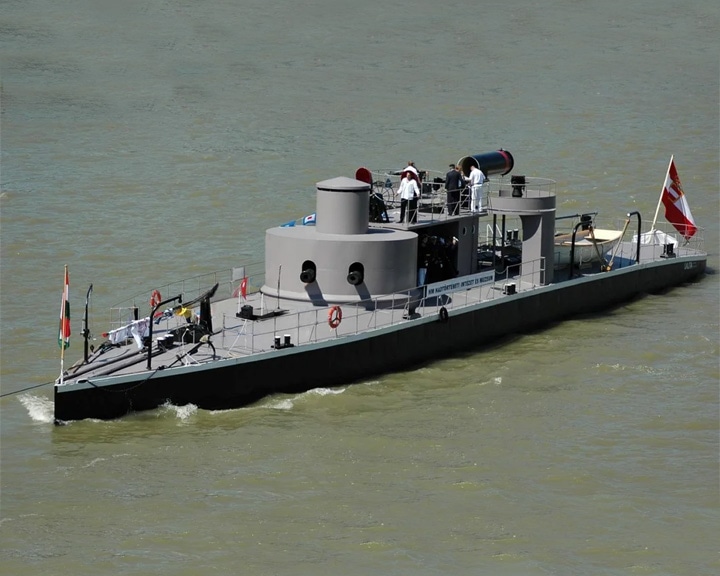 Leitha, SMS (later named Lajta) — Austro-Hungarian river monitor The first river monitor in Europe. The oldest and the only restored warship of the Austro-Hungarian Navy. In October 1914, her turret took a direct hit, all the crew inside being killed. LAUNCHED: 1872, October 13 → FATE: Restored in 2009, Lajta is currently moored on the Danube in Budapest as a museum ship |
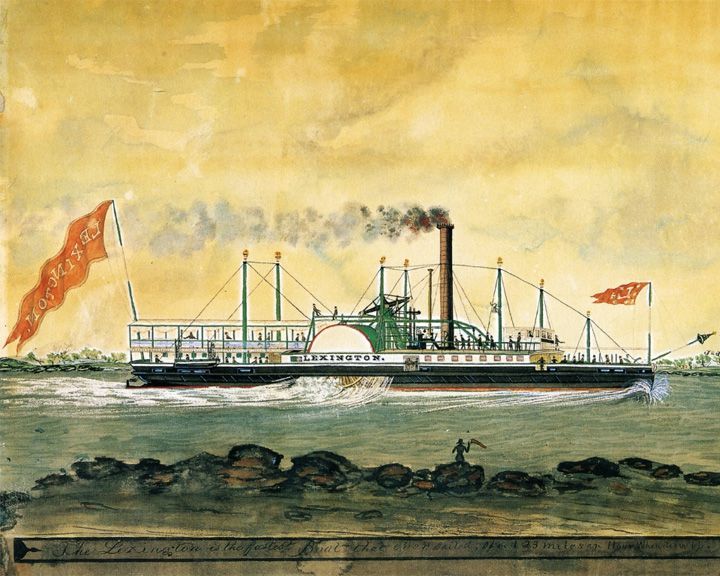 (Another (Another |
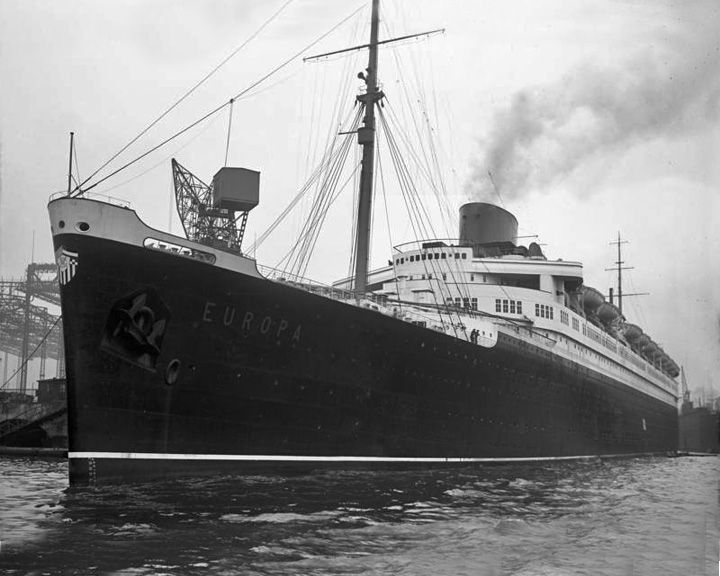 Liberté, SS — German ocean liner; then American war prize; then French owned Featured prominently in the movie The French Line, starring Jane Russell. She was taken as a US war prize at the end of World War II, then used to transport US servicemen back to the states, and finally turned over to the French as war reparations. LAUNCHED: 1928, August 18 → FATE: Retired in 1961 and scrapped in 1962. |
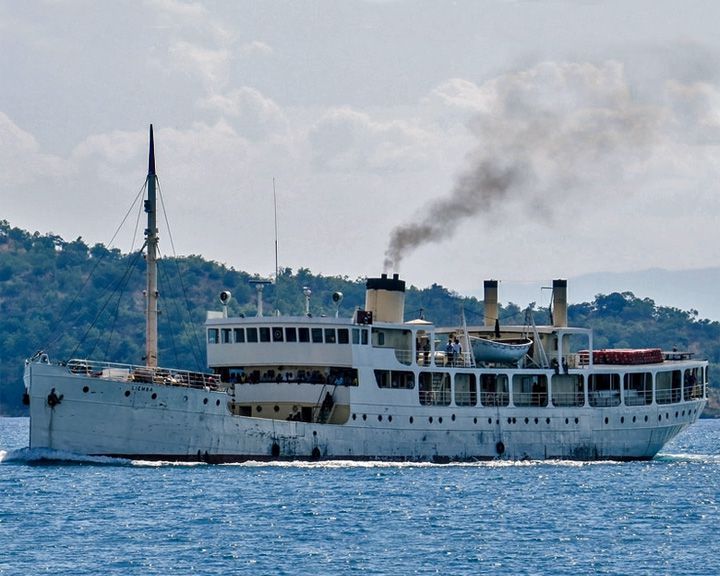 Liemba, MV — German ferry, passenger and car The last vessel of the German Imperial Navy still sailing. She was the inspiration for the German gunboat in the novel and movie The African Queen. LAUNCHED: 1915, February → FATE: Scuttled July 26, 1916; raised in 1927, still in service on Lake Tanganyika. |
|
|
Page 32
|
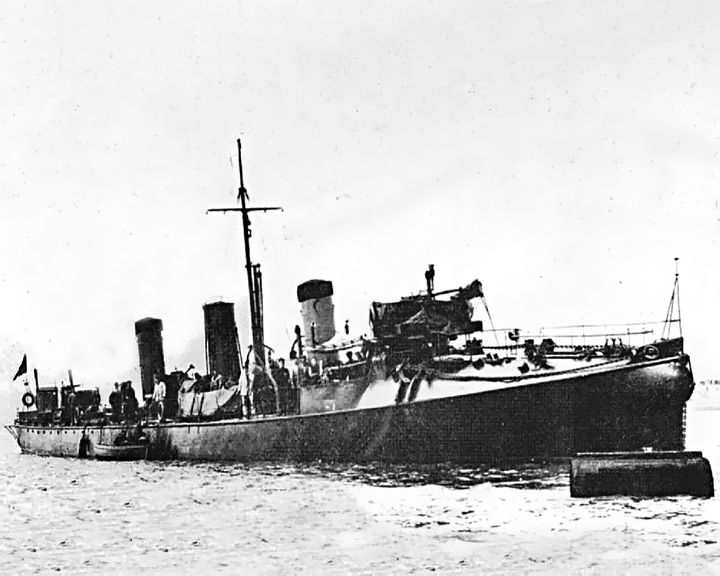 Lightning, HMS — British torpedo boat The first ship to launch self-propelled torpedos. She was used exclusively with HMS Vernon, a torpedo school ship at the Royal Navy's Torpedo Branch at Portsmouth, England. LAUNCHED: 1876 → FATE: Scrapped in 1896. |
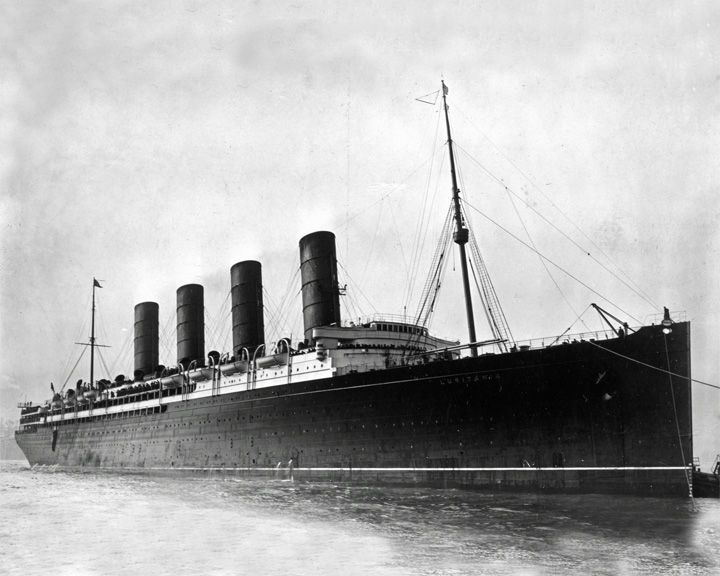 (Another (Another Lusitania, RMS — British ocean liner Torpedoed by German submarine U-20, killing 1,198 people. Her sinking during transatlantic passage turned public opinion against Germany in World War I. LAUNCHED: 1906, June 18 → FATE: Sank 70 kms from the Old Head of Kinsale May 7, 1915. |
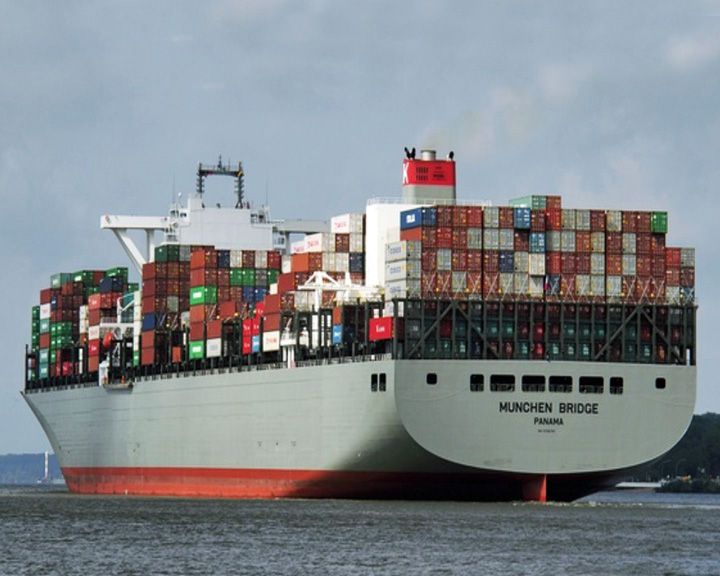 München, MS — German LASH carrier (cargo ship) Sank with with 28 crew in a severe storm, probably due to rogue waves and featured in several television documentaries. A court case regarding the loss of cargo in this tragedy set a legal precedent used in many legal textbooks illustrating the administration of the Uniform Commercial Code. LAUNCHED: 1972, May 18 → FATE: Sank in the North Atlantic December 1978. |
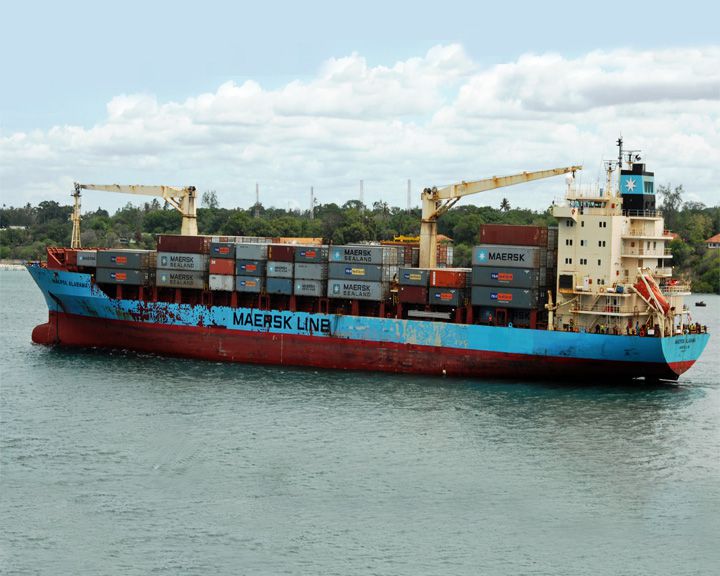 Maersk Alabama, MV — American container ship Its hijacking by pirates near Somalia in 2009 was followed by the rescue of its crew. A second unsuccessful hijacking that year and several in 2011 were attempted. The hijacking was the subject of the movie Captain Phillips starring Tom Hanks. LAUNCHED: 1998, launched as Alva Maersk → FATE: Still in service. |
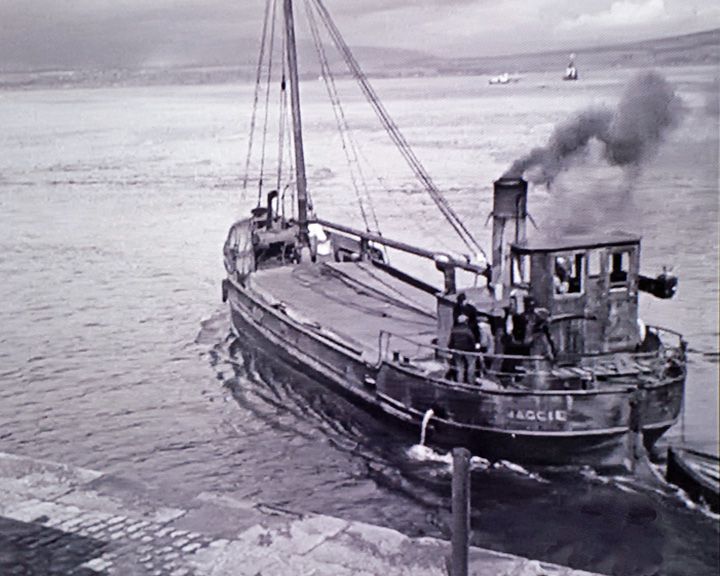 Maggie — British Clyde puffer cargo ship Appeared in the movie The Maggie which was released in the U.S. titled High and Dry. The story is about a clash of cultures between a hard-driving American businessman and a wily Scottish captain. LAUNCHED: 1954, movie release; boat origin unknown → FATE: Inconclusive. |
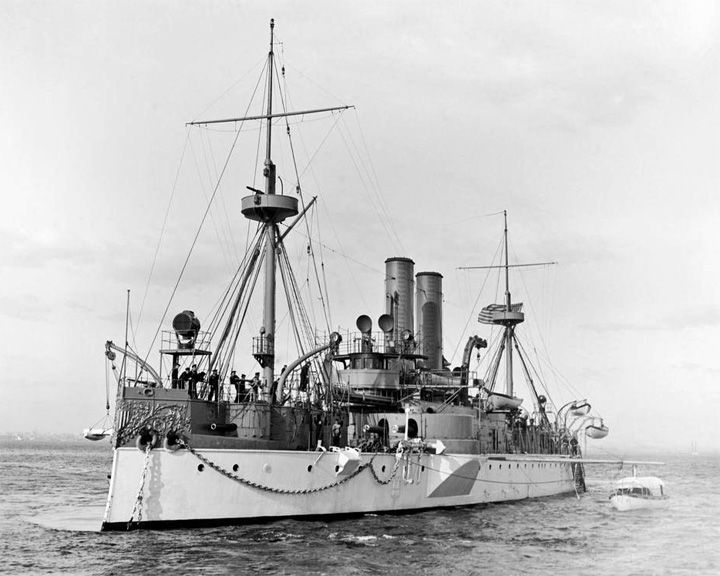 (Another (Another Maine, USS — American battleship Its sinking precipitated the Spanish-American War. Sent to protect U.S. interests during the Cuban revolt against Spain, she exploded without warning and sank, killing 274 men. LAUNCHED: 1889, November 18 → FATE: Sank in the Havana Harbor February 15, 1898. |
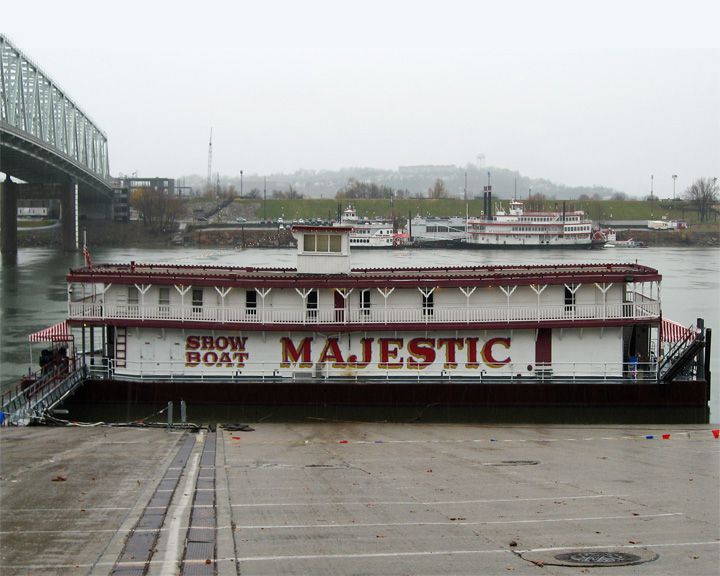 (Another (Another Majestic — American paddle steamboat, stern-wheeler showboat The last of the original traveling showboats. Now the riverboat is a venue for comedies and musicals. LAUNCHED: 1920 → FATE: Currently docked at the Cincinnati Public Landing in Ohio. |
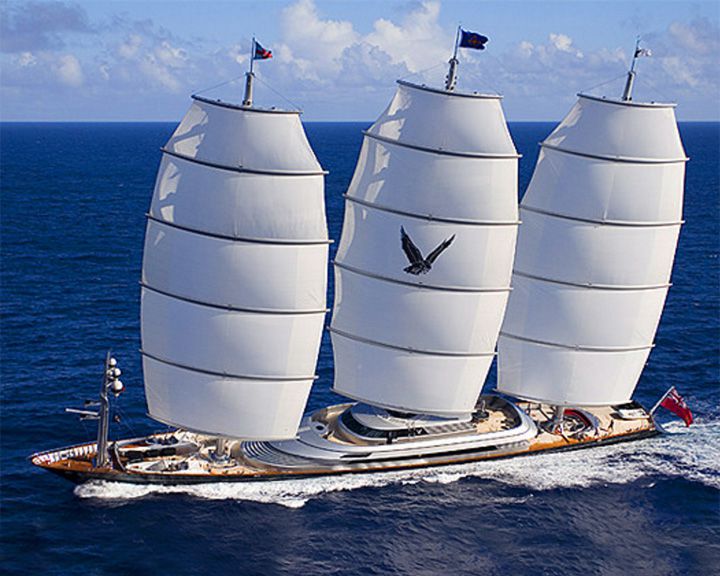 Maltese Falcon — American full-rigged luxury yacht; now owned by a Englishman The largest full-rigged luxury yacht in the world. She has 5 square sails on each of 3 masts that can be fully unfurled in 6 minutes. Some claim the Eos is larger. LAUNCHED: 2006 → FATE: Still in service. |
|
|
Page 33
|
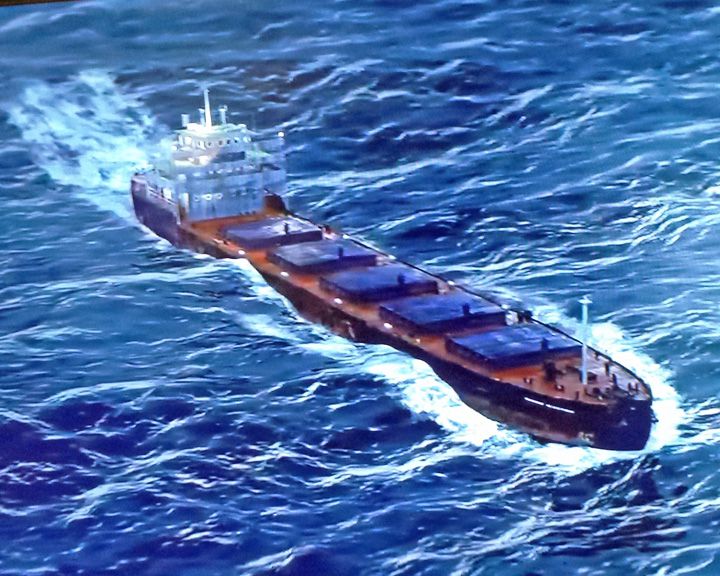 Marine Electric — American bulk carrier Her sinking resulted in some of the most important maritime reforms in the 20th century. The tragedy, with the loss of 34 crew, resulted in better inspection standards, mandatory survival suits for winter North Atlantic runs, and creation of the Coast Guard's Aviation Survival Technician program. LAUNCHED: 1944, May 2 → FATE: Sank February 12, 1983 about 30 miles off the coast of Virginia. |
 (Another (Another Mars — Swedish three masted warship One of the largest warships at the time and the first ship to sink another ship with gunfire. The shipwreck was found by a team of divers north of the island Oland August 19, 2011. LAUNCHED: 1564 → FATE: Caught fire and exploded during the First Battle of Oland, May 31, 1564. |
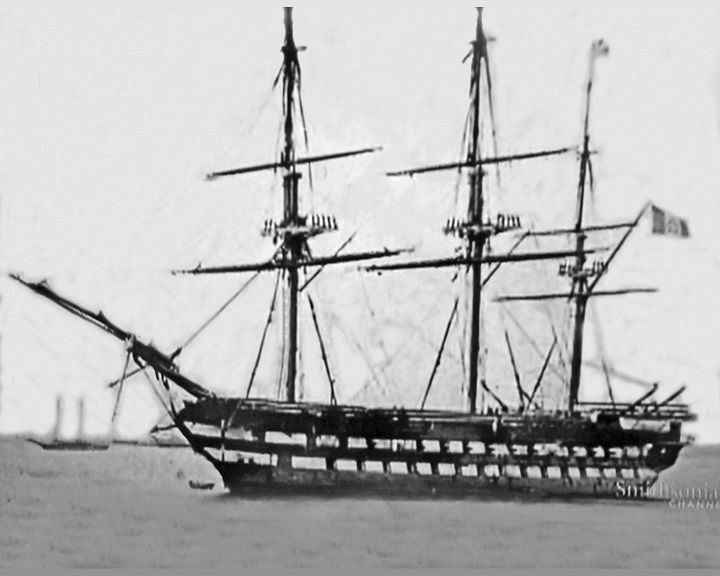 Mary Celeste — American brigantine The "ghost ship" found near the Strait of Gibraltar abandoned by its seven crew members in 1872. The popular mystery of the ship began with Arthur Conan Doyle's story in 1884, about a derelict ship which he called Marie Celeste. LAUNCHED: 1860 → FATE: Intentionally scuttled in January of 1885. |
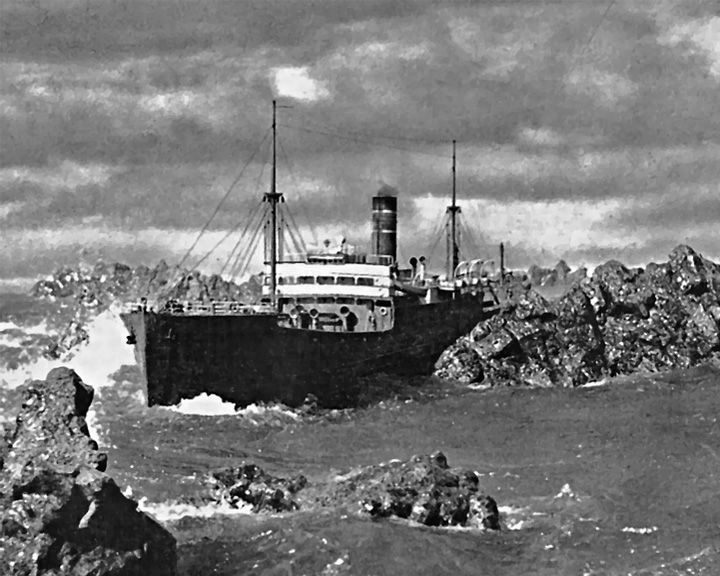 Mary Deare — American steamship; actually a 28 foot model. A fictional ship in the movie The Wreck of the Mary Deare. The movie was based upon the novel of the same name written by Hammond Innes. LAUNCHED: 1959, November 6, film release → FATE: Inconclusive. |
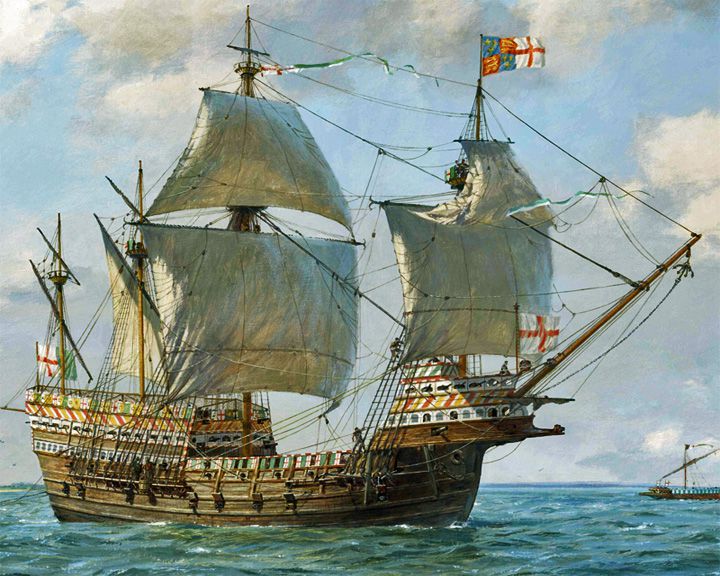 Mary Rose — English carrack-type warship One of the earliest ships built for war sporting the innovation of gun ports. The wreck of the Mary Rose was rediscovered in 1971 and salvaged in 1982. LAUNCHED: 1512 → FATE: Sank in the straits north of the Isle of Wight, 1545. |
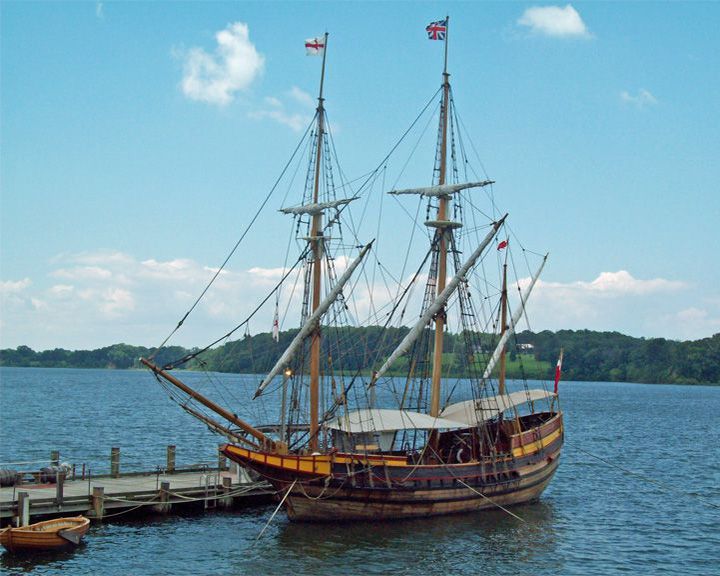 Maryland Dove — American merchant vessel Replica of the Dove, one of two early 17th-century English ship that, in 1634, brought the first settlers to what is now Maryland. The original Dove was the smaller of the two ship, used in shallow waterways along the coast. The accompanied ship with 140 passengers was the Ark. LAUNCHED: 1978, August 18 → FATE: On exhibit at Historic St. Mary's City and occasionally other ports. |
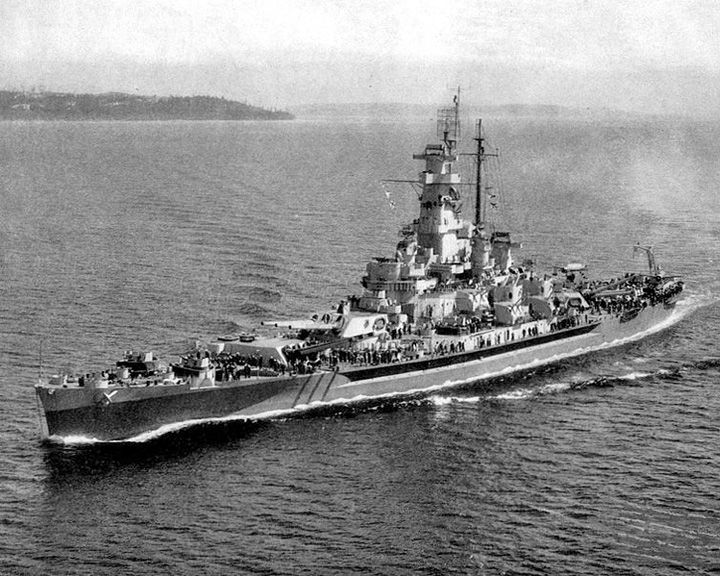 Massachusetts, USS — American South Dakota class battleship Has the distinction of having fired the US Navy's first and last 16-in shells of the World War II. Despite being used as a parts cache to get the Iowa-class battleships back in service, Massachusetts was designated a National Historical Landmark a 14 January 1986. LAUNCHED: 1941, June 18 → FATE: Became a in museum ship at Battleship Cove, Fall River, Massachusetts June, 1965. |
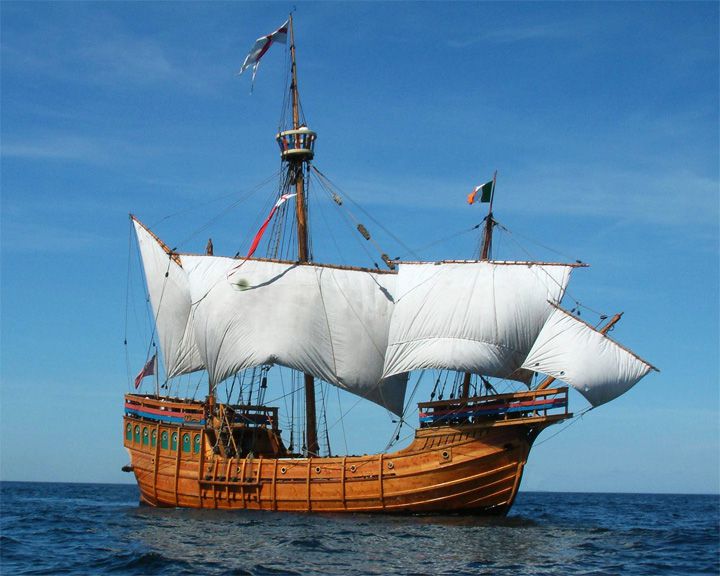 Matthew — English caravel Sailed by John Cabot, first European to reach North America. Apparently, she was a small ship of fifty tons carrying twenty men and food for seven or eight months. LAUNCHED: 1496, or earlier; replica launched 1996 → FATE: Original ship, unknown; replica on display at M Shed Museum, Bristol, England. |
|
|
Page 34
|
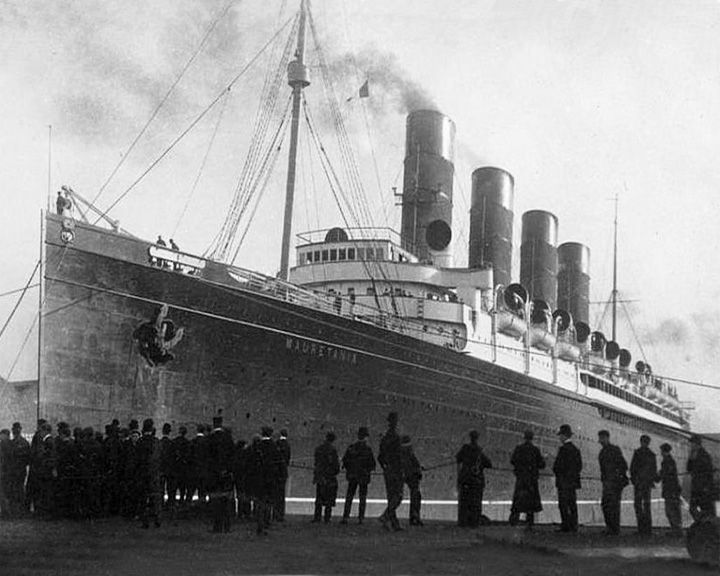 Mauretania, RMS — British ocean liner At the time, she was the largest and fastest ship in the world. She made an eastbound transatlantic crossing with a long-standing record average speed of 23.7 knots. She served as a hospital ship and troop ship in World War I. LAUNCHED: 1906, September 18 → FATE: Scrapped in 1934. |
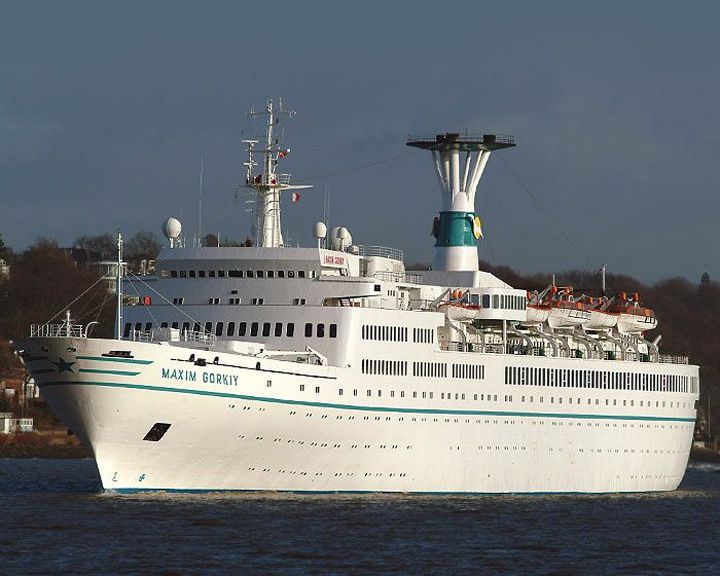 Maxim Gorky — Russian cruise ship Portrayed the fictional SS Britannic in the filming of Juggernaut in 1974. She was sold to a Russian company in 1974. The hard luck ship hit an ice floe while on a cruise and nearly sank in 1989. LAUNCHED: 1968, February 18 → FATE: Beached and scrapped in India February of 2009. |
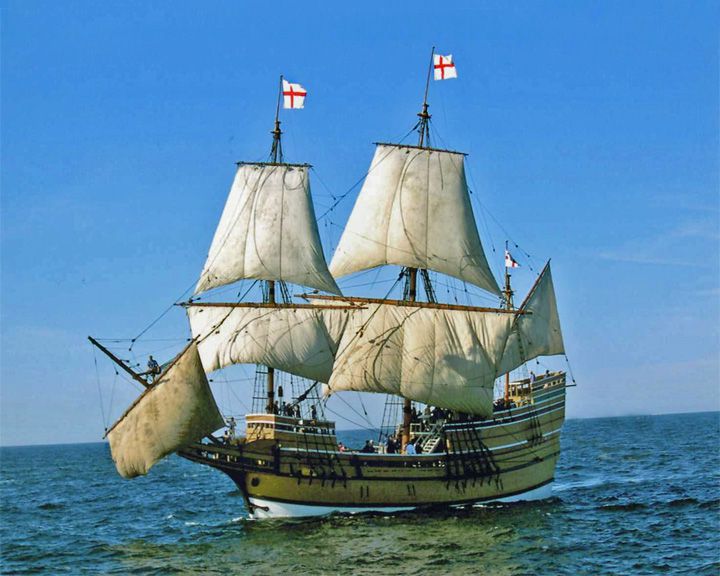 Mayflower — English galleon Transported the English Pilgrims from England to Plymouth, Massachusetts in 1620. The ocean crossing took 66 days. A second ship called the Mayflower made a voyage from London to Plymouth Colony in 1629. LAUNCHED: 1607, about → FATE: Sold and taken apart in May of 1624. |
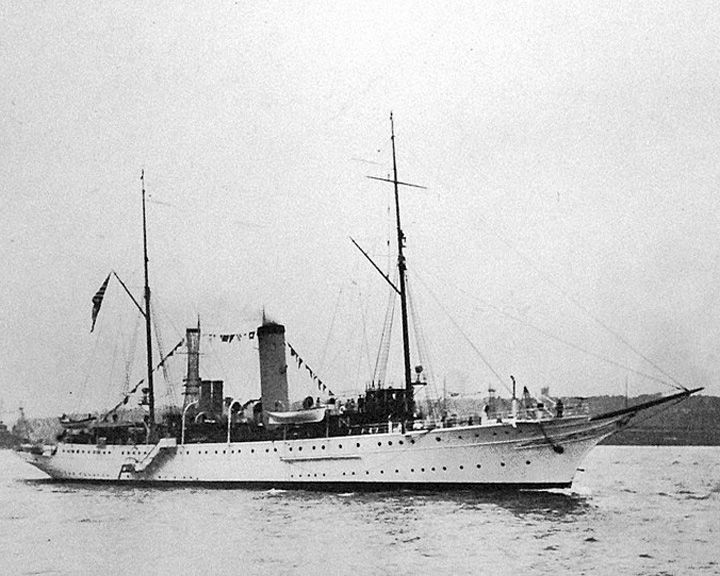 Mayflower, USS (PY-1) — American yacht She served as a private yacht, merchant ship, presidential yacht, and warship in 3 wars. She had many owners, as well serving as a presidential yacht 1905-1929. She was finally purchased by Israel in 1950 and renamed INS Ma'oz. LAUNCHED: 1896 → FATE: Broken up in 1955. |
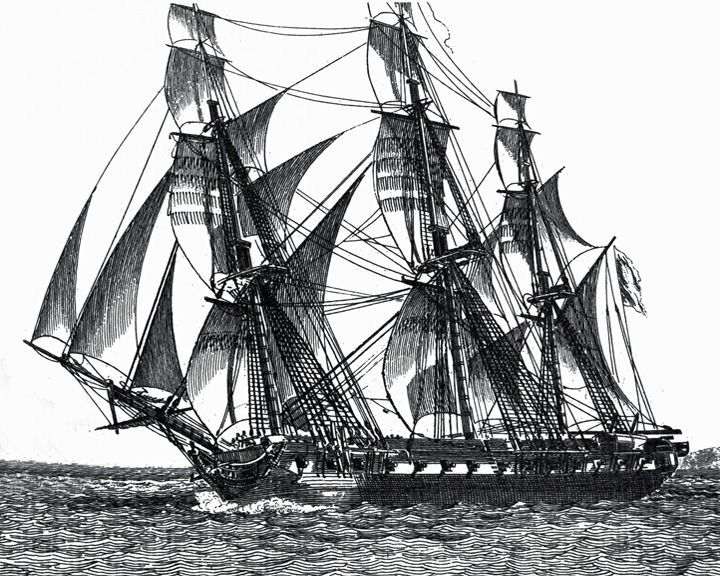 (Another (Another Medusa — French frigate Most famous sea disaster of the nineteenth century. After hitting a shoal, most of the 400 passengers were evacuated while 151 men took refuge on an improvised raft. After 13 days at sea, the raft was discovered with only 15 men still alive. The raft carrying people was the subject of a famous painting, The Raft of the Medusa by French artist Théodore Géricault. LAUNCHED: 1810 → FATE: Beached on Bank of Arguin in 1817. |
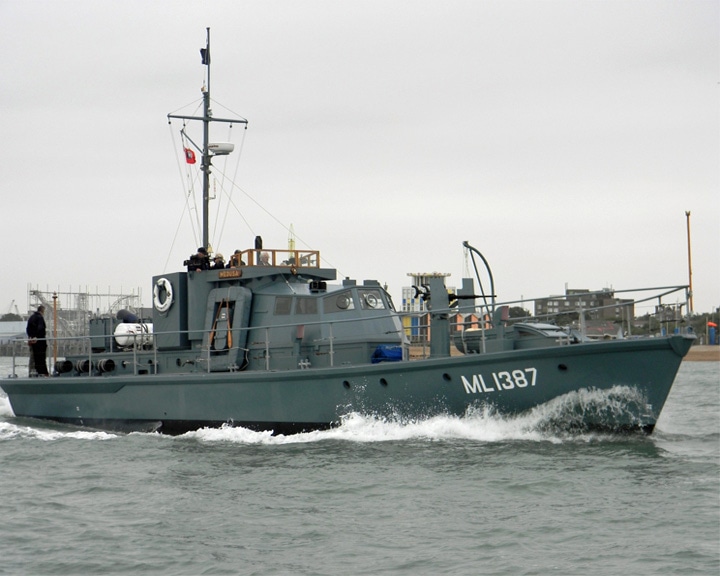 Medusa, HMS — British Harbour defence motor launch She served at D-Day as a Navigation Leader, marking German minefields to be cleared by minesweepers, and then staying at the entrance of the cleared channel to direct parts of the invasion force. For more, see Museum Ships. LAUNCHED: 1943 → FATE: On exhibit at Gosport in England. |
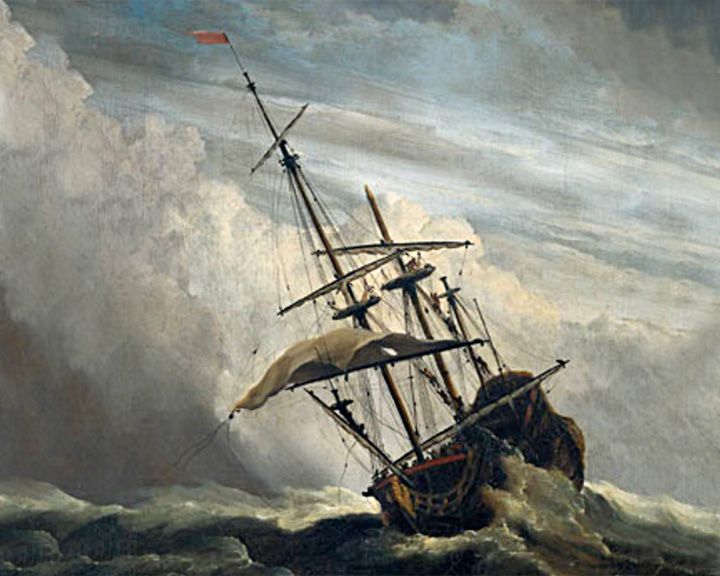 Merchant Royal — English merchant ship Lost at sea with 18 men off Land's End, Cornwall, England, the ship is one of the richest sunken treasures. Lost were more than half million Spanish silver pesos, 500 bars of gold and ingots of silver, and hundreds of pieces of jewelry. LAUNCHED: 1627 → FATE: Sank in bad weather September 23, 1641. |
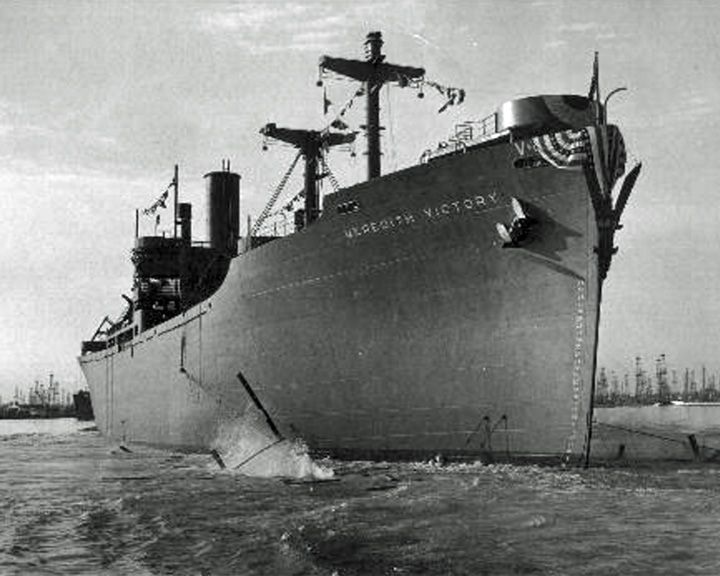 Meredith Victory, SS — American cargo ship, freighter The "Ship of Miracles" saved more than 14,000 refugees during the Korean War, the largest humanitarian rescue operation by a single ship. The ship was built to transport supplies and equipment overseas during World War II. LAUNCHED: 1945, June 18 → FATE: Broken up for scrap in China in 1993. |
|
|
Page 35
|
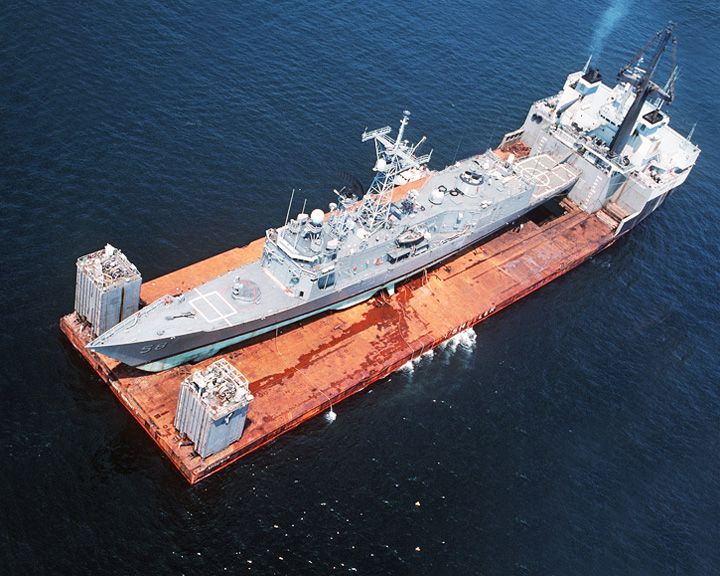 Mighty Servant 2 — American heavy lift ship, semi-submersible Hauled the USS Samuel B. Roberts from Dubai to Newport, RI after the frigate struck a mine in the Persian Gulf. Along with sister ships Mighty Servant 1 and Mighty Servant 3, used mainly for moving oil drilling rigs. LAUNCHED: 1983 → FATE: Capsized near the Indonesian island of Singkep with loss of 5 crew November 2, 1999. |
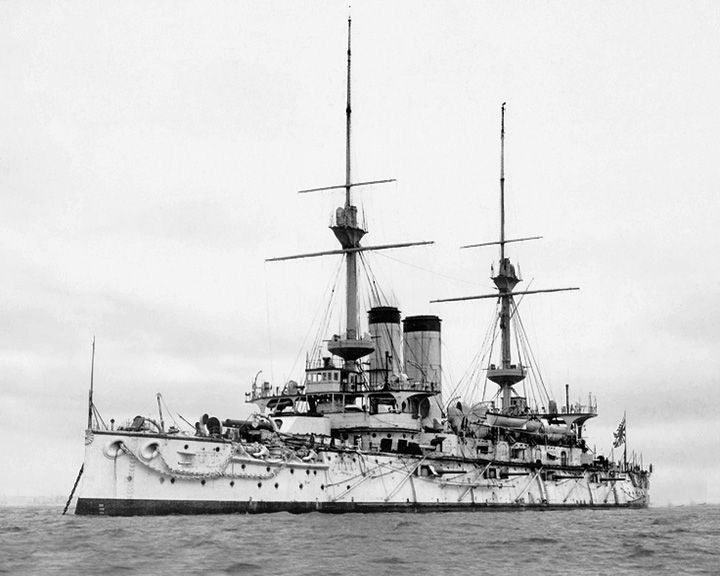 Mikasa — Japanese pre-dreadnought battleship (British built) The last remaining example of a pre-dreadnought battleship anywhere in the world. After the Russo-Japanese War, her magazine accidentally exploded and sank the ship. She was salvaged and repaired and then served in World War I. LAUNCHED: 1900, November 18 → FATE: She was preserved as a museum ship and later refurbished and is on exhibit in Mikasa Park, Yokosuka. |
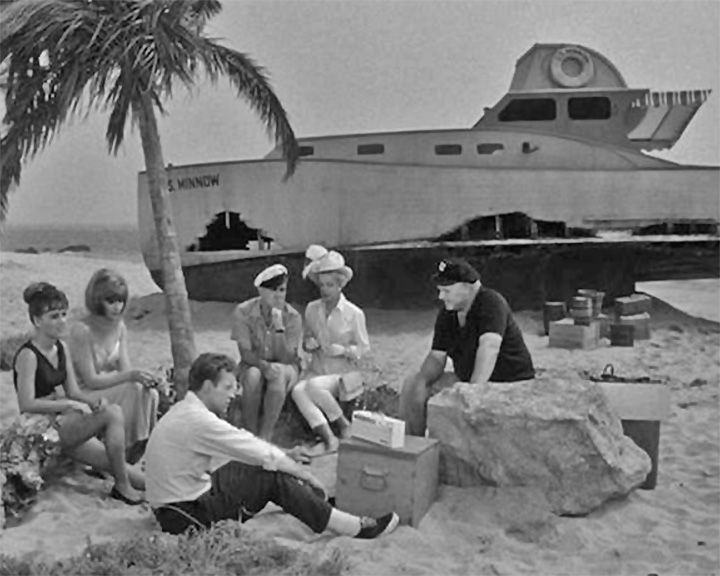 Minnow, S.S. — American express cruiser A fictional charter boat on the hit 1960s television sitcom Gilligan's Island. There were actually four different boats used on the show. (See Original S.S. Minnow Found for more.) LAUNCHED: 1964, for the TV series → FATE: Series ended in 1967. |
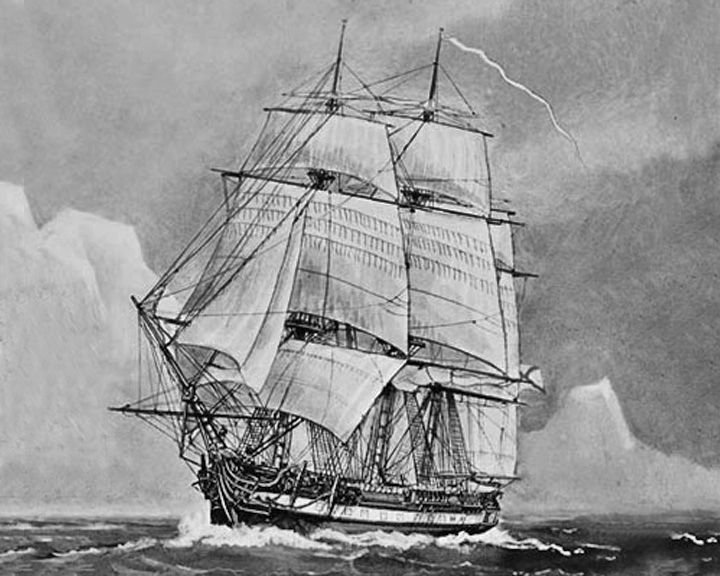 (Another (Another Mirny — Russian sloop-of-war First to discover the continent of Antarctica and circumnavigated it twice. A medal was issued by the Russian Admiralty to commemorate the expedition as seen in "Another IMAGE". LAUNCHED: 1819 → FATE: Unknown. |
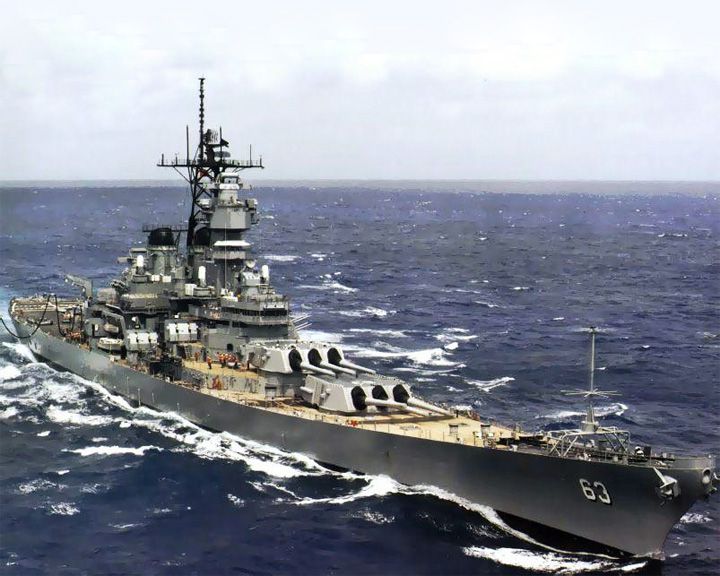 Missouri, USS — American battleship The site of the surrender of Japan which ended World War II. She was the last battleship built by the United States. LAUNCHED: 1944, January 18 → FATE: On exhibit near the USS Arizona Memorial at Pearl Harbor in Honolulu, Hawaii. |
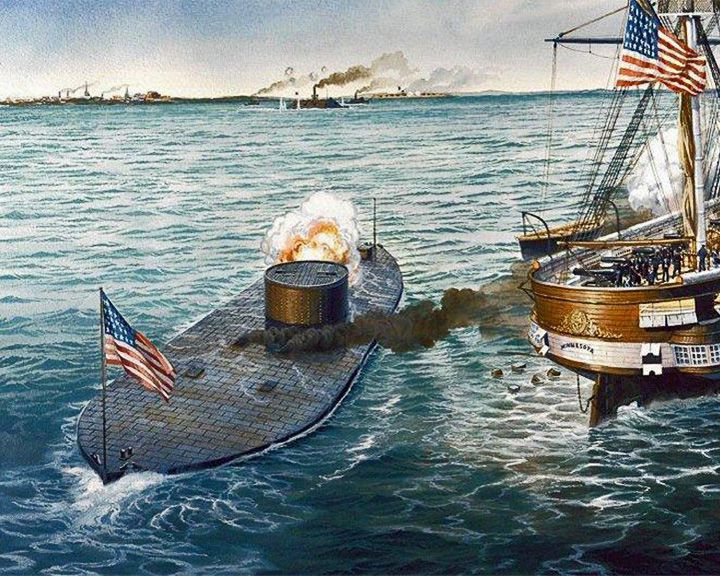 Monitor, USS — American ironclad warship With CSS Virginia, first naval battle between two ironclad warships at the Battle of Hampton Roads. She had a rotating gun turret. LAUNCHED: 1862, January 18 → FATE: Sank on December 31, 1862. |
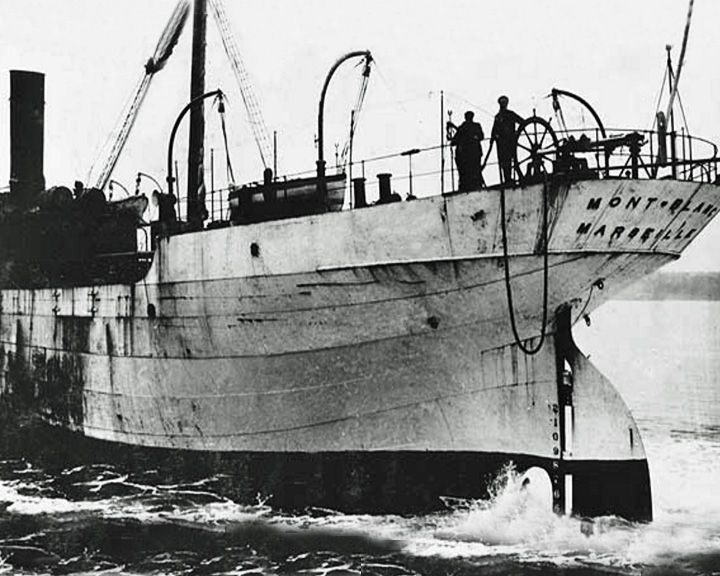 Mont Blanc, SS — French cargo ship, freighter The worst human-made disaster in Canadian history and was the world's largest human-made blast until the detonation of an atomic bomb in 1945, and known as Halifax Harbor. The collision with the Norwegian steamship SS Imo caused her ammunition cargo to exploded in Halifax Harbor, resulting ing 2000 killed, 9000 injuried, 13,630 homes wrecked, and 6000 left homeless LAUNCHED: 1899 → FATE: Blown to pieces December 6, 1917, after the collision. |
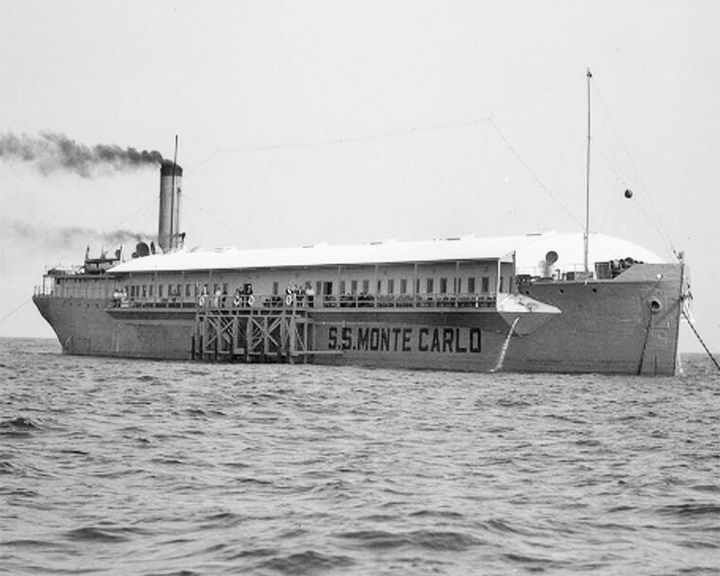 Monte Carlo, SS — American concrete ship She became a gambling and prostitution ship operating in international waters off the coast of Long Beach, California. In the 1930s, she was the largest of a fleet of ships making up Gambling Ship Row off the southern California. LAUNCHED: 1921, December → FATE: Wrecked during a storm in 1937, ending up on a San Diego beach where it remains. |
|
|
Page 36
|
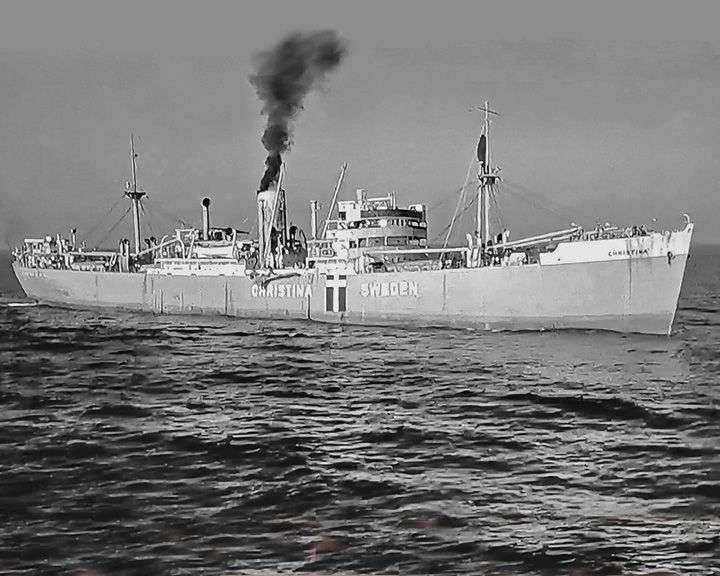 (Another (Another Morituri — German cargo ship In the movie Morituri a freighter hauling rubber to Nazi Germany during WWII; starring Marlon Brando and Yul Brynner. The actual unnamed old German freighter was used for nearly all the film sequences. LAUNCHED: 1965, movie release → FATE: Inconclusive. |
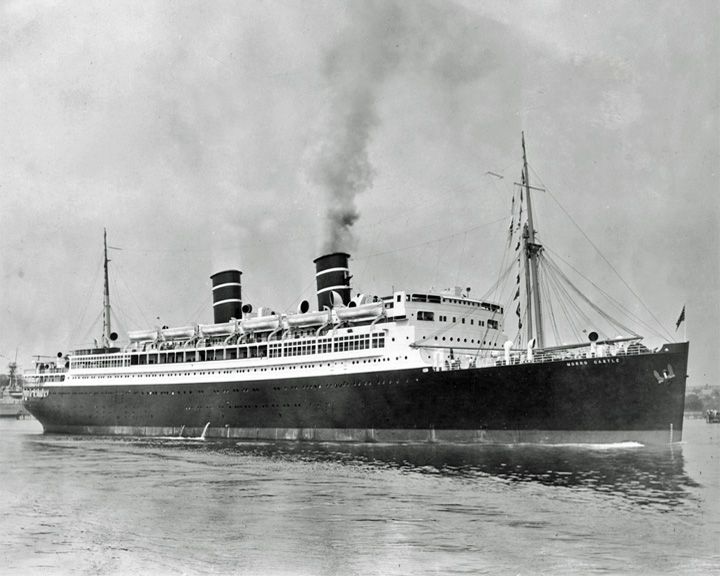 (Another (Another Morro Castle, SS — American cruise ship A devastating fire aboard ship that killed 137 resulted in greater fire safety on newer ships. The burnt ship ended up at Asbury Park, NJ, where it became a tourist attraction. The tragedy resulted in the establishment of the United States Merchant Marine Academy. LAUNCHED: 1930, August 18 → FATE: Beached on September 8, 1934, scrapped March 29, 1935. |
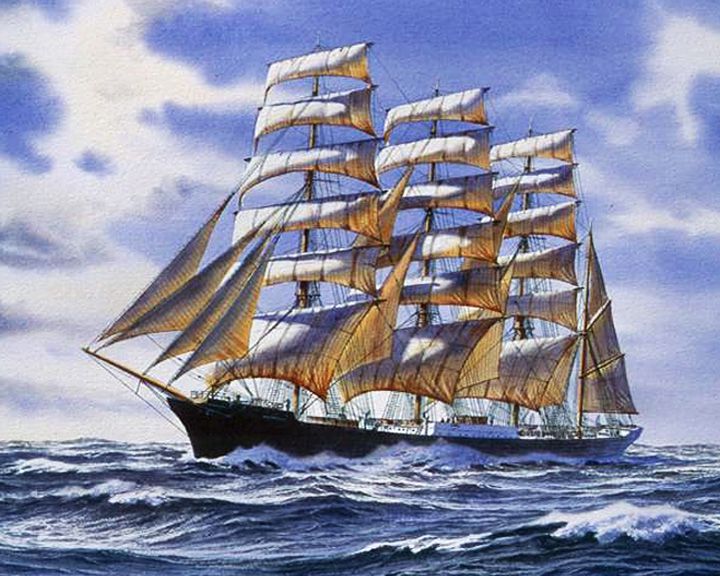 Moshulu — Scottish barque, four-masted Famous through the books of Eric Newby such as The Last Grain Race, 1956. Between 1904 and 1914, under German ownership, Kurt shipped coal, nitrate, coal, and coke around the world. She appeared in several movies. LAUNCHED: 1904, April 18 → FATE: Currently a floating restaurant docked in Penn's Landing, Philadelphia, Pennsylvania. |
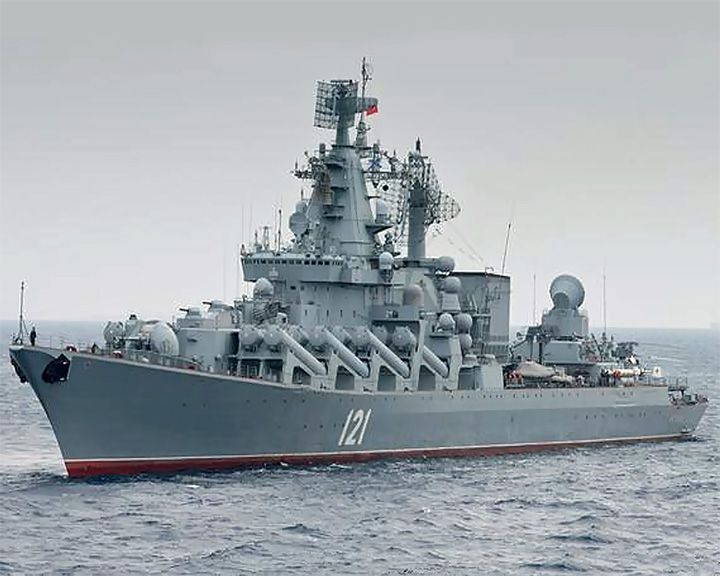 Moskva — Russian guided missile cruiser Flagship of the Russian Black Sea Fleet and helped lead the naval assault during the 2022 Russian invasion of Ukraine. The Russian Ministry of Defence said she sank after a fire caused a munitions explosion. LAUNCHED: 1979 → FATE: Sunk by Ukraine forces on April 14, 2022. |
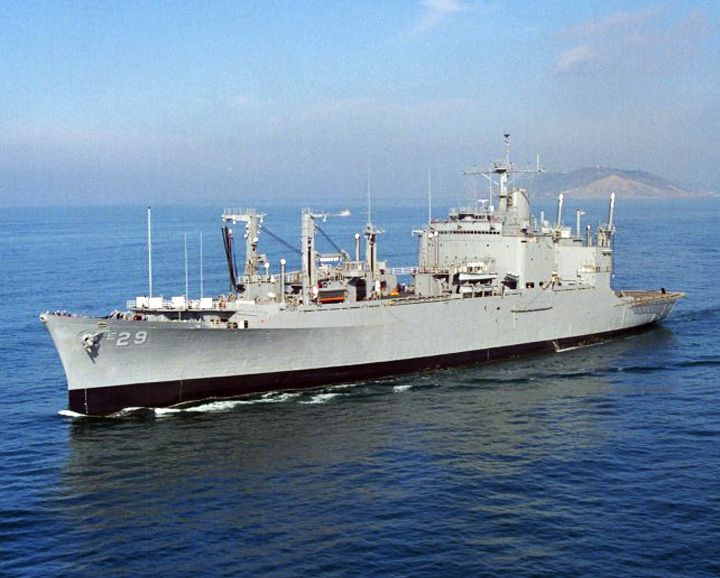 Mount Hood, USS — American ammunition ship The ship and dozens of surrounding vessels were obliterated with over 370 casualties in a massive explosion. The ship's 3800 tons of ordnance produced a blast equivalent to a tactical nuclear weapon. LAUNCHED: 1943, November 28 → FATE: Exploded on November 10, 1944, at Seadler Harbor on Manus Island. |
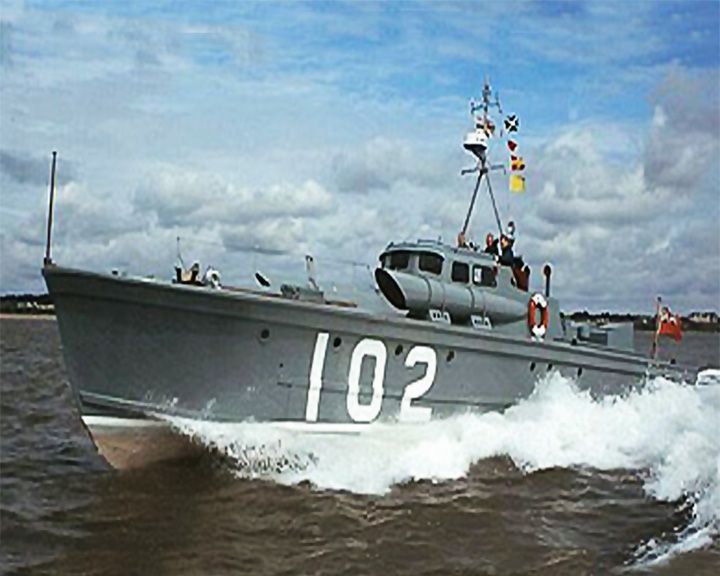 MTB 102 — British motor torpedo boat The the fastest wartime British naval vessel in service at 48 knots and the smallest vessel to ever serve as a flagship for the Royal Navy. In 1944 she carried Winston Churchill and General Eisenhower to review the fleet for Operation Overlord, the invasion of Normandy, World War II. She appeared as herself in the 2017 war film Dunkirk. LAUNCHED: 1937 → FATE: On exhibit at Lowestlft, on the North Sea. |
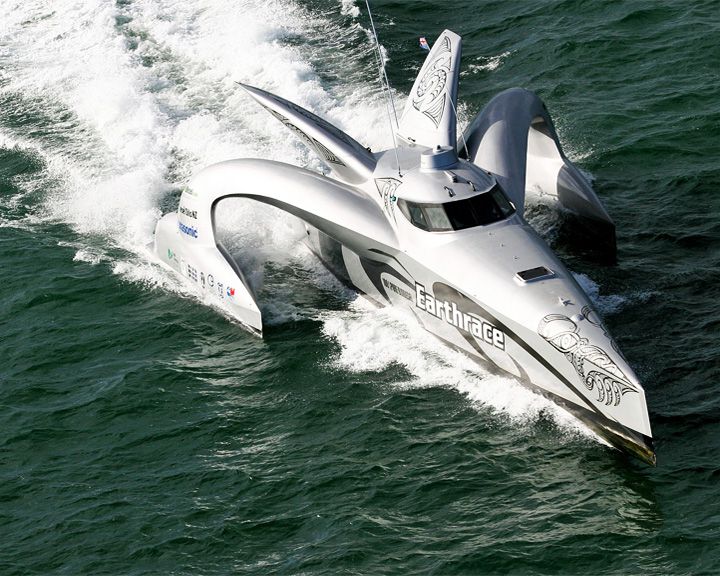 My AdyGil — New Zealand wave-piercing trimaran Broke the world record for circumnavigating the globe in a motorized boat in 60 days 23 hours and 49 minutes. Participated in anti-whaling operations under the lead of the Sea Shepherd Conservation Society in the Southern Ocean. LAUNCHED: 2006, February 18 → FATE: Collided with a Japanese ship and sank on January 7, 2010. |
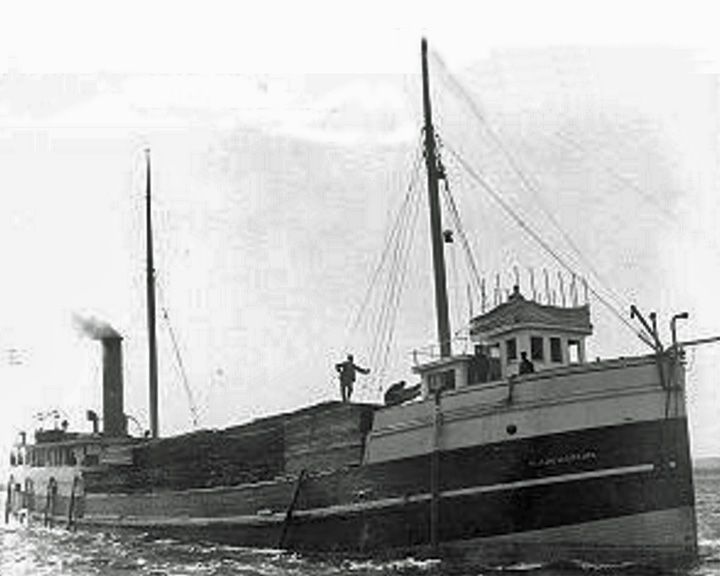 Myron, SS — American wooden steamship, built as a lumber hooker The wreck is protected as part of an underwater museum in the Whitefish Point Underwater Preserve. She defied the adage "Lake Superior seldom gives up her dead" when all 17 crew drifted ashore found frozen to death. The captain survived. LAUNCHED: 1888 → FATE: Sank to the end of Lake Superior during a storm on November 23, 1919. |
|
|
Page 37
|
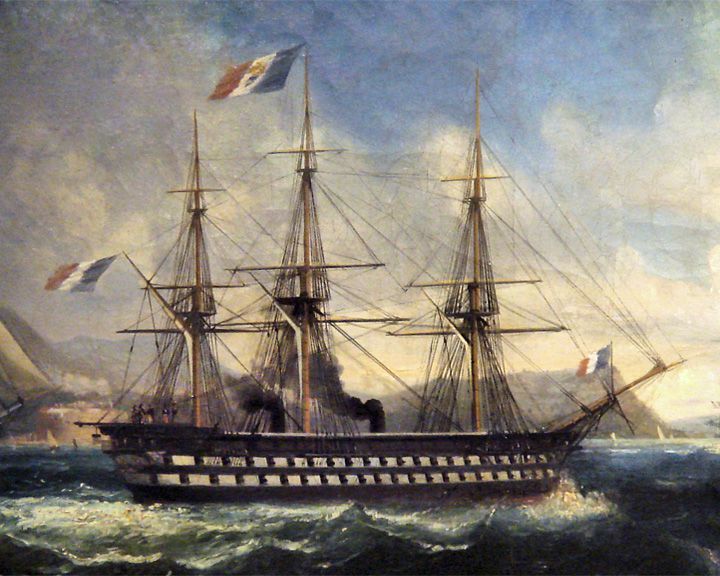 Napoléon, (Le) — French battleship, ship of the line First true steam and screw battleship in the world. She was the lead ship of a class of 9 battleships, all considered as very successful and built over a period of 10 years. LAUNCHED: 1850, May 18 → FATE: Sunk November 6, 1876. |
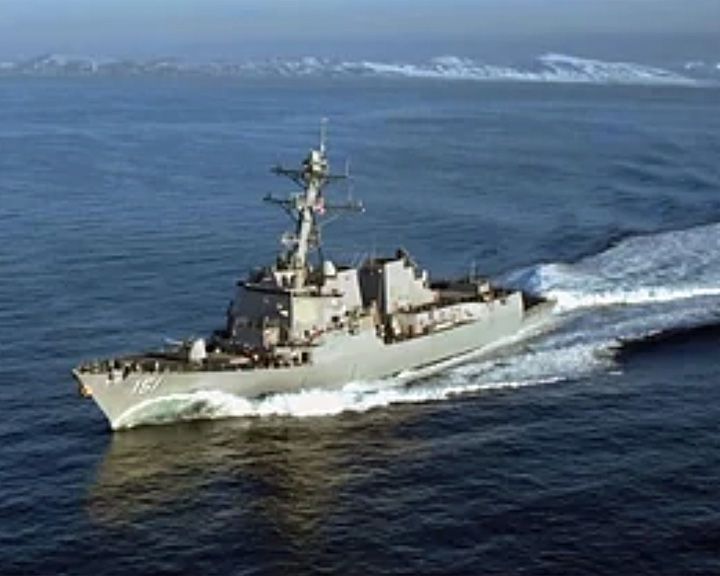 Nathan James, USS — American guided missile destroyer Fictional ship in the movie The Last Ship. She was portrayed by USS Halsey. LAUNCHED: 2014, movie release → FATE: Inconclusive. |
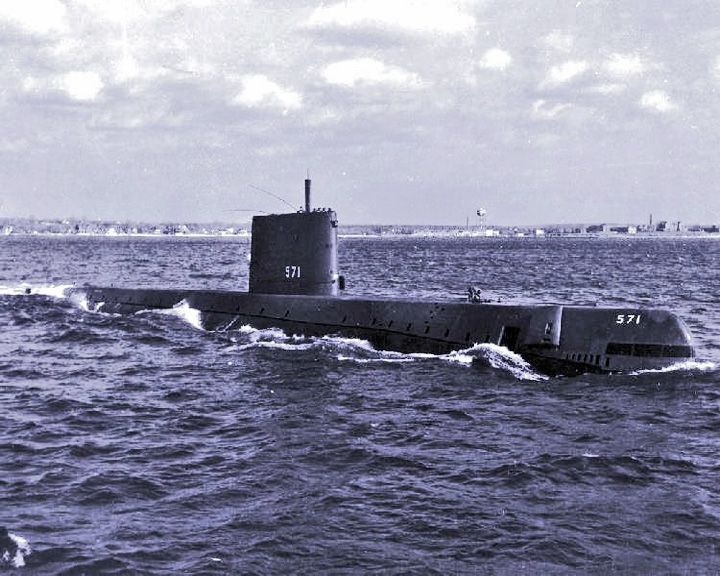 Nautilus, USS — American nuclear submarine World's first nuclear-powered submarine. She was the first vessel to cross under the North Pole. Also the namesake of another U.S. submarine that served in World War II. LAUNCHED: 1954, January 18 → FATE: On exhibit at the Naval Submarine Base New London in Groton, Connecticut. |
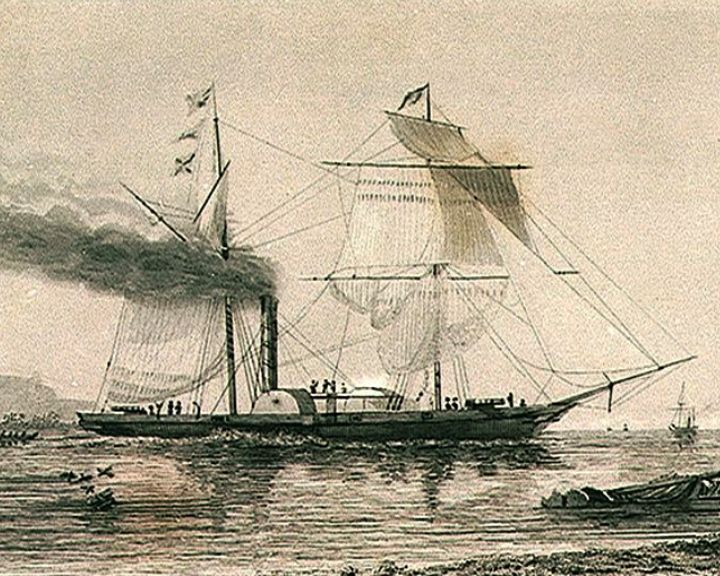 Nemesis — British steam and sail powered warship The first British ocean-going iron warship; also the first iron ship to sail around the Cape of Good Hope. She was greatly effective in the First Opium War. The Chinese referred to her as the "devil ship". LAUNCHED: 1839 → FATE: Ended up in Calcutta, 1855. |
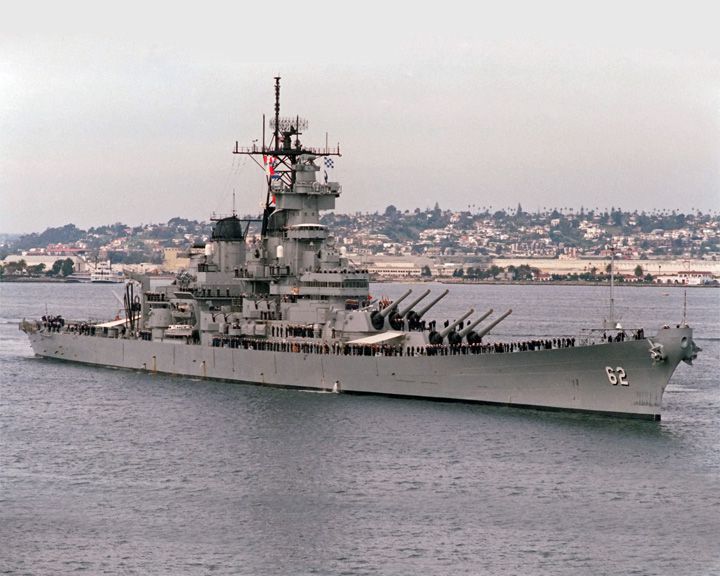 New Jersey, USS — American battleship Earned more battle stars for combat actions than the other American battleship. She was the only U.S. battleship to provide gunfire support during the Vietnam War. LAUNCHED: 1942, December → FATE: In a museum at the Camden Waterfront, Camden, New Jersey. |
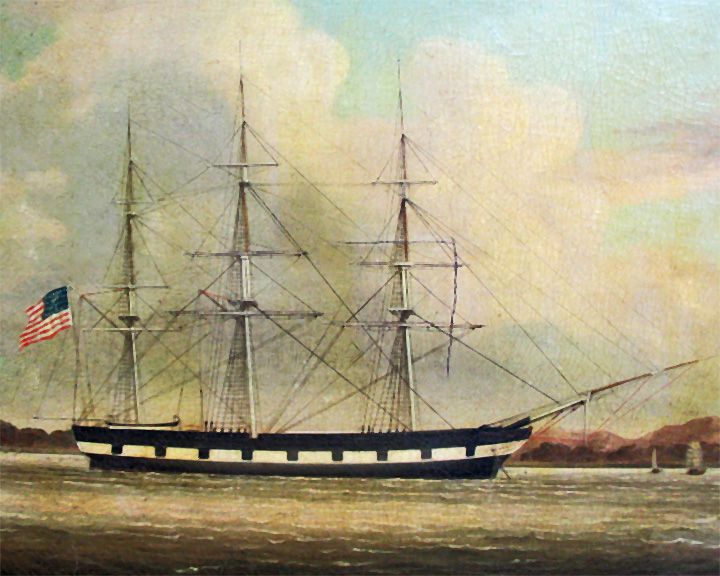 Niantic — American whaling ship Brought fortune-seekers to Yerba Buena (now San Francisco) during the California Gold Rush of 1849. She was a prominent landmark in the booming city for several years. The site of Niantic beside the Transamerica Pyramid is now a California Historical Landmark. LAUNCHED: 1832 → FATE: Converted to hotel in 1849, destroyed by fire 1852. |
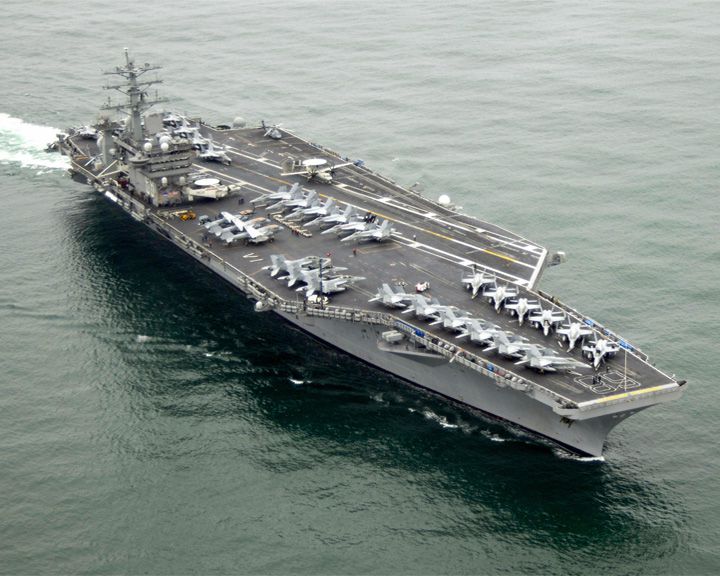 Nimitz, USS — American aircraft carrier; supercarrier Setting for the 1980 science fiction movie The Final Countdown. In May of 1981, one of her planes crashed on the flight deck, killing 14 crewmen. LAUNCHED: 1972, May → FATE: Still in service. |
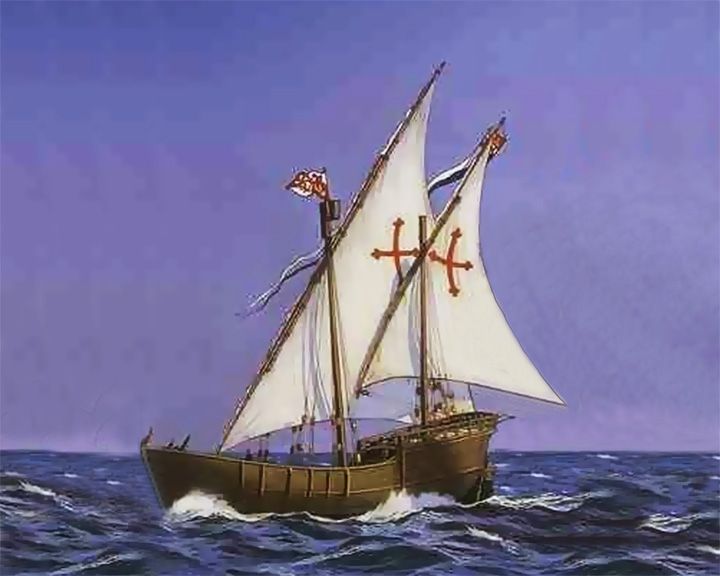 Nina, (La) — Spanish four masted caravel The smallest of Columbus' ships of discovery. She became Columbus' flag ship back to Spain after the loss of Santa Maria. LAUNCHED: 1492 → FATE: Last heard of in 1501; fate unknown. |
|
|
Page 38
|
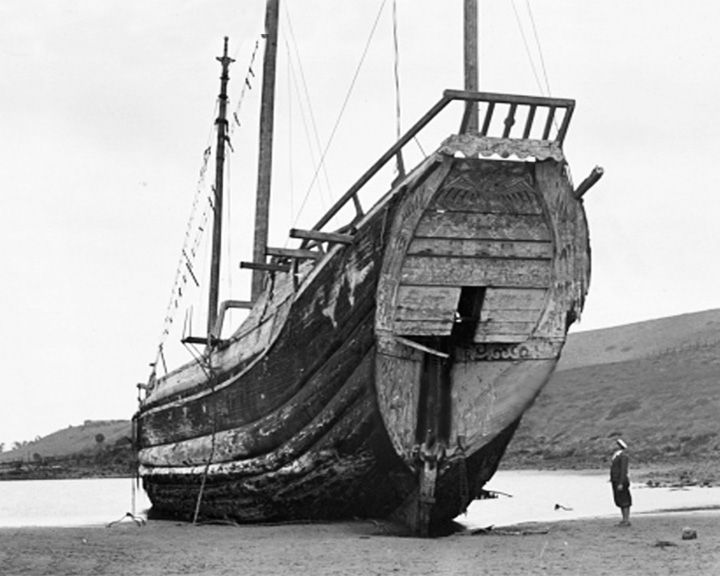 Ning Po — Chinese 3-masted, 291 ton junk Spent 159 years in the Yellow Sea engaging in crimes such as smuggling, slave trading, mutiny, and piracy. During the 1920s and 1930s she sat in Catalina Harbor, Santa Catalina Island, California and was used as a backdrop for movies filmed there. LAUNCHED: 1753 → FATE: Burned in Catalina Harbor in 1938. |
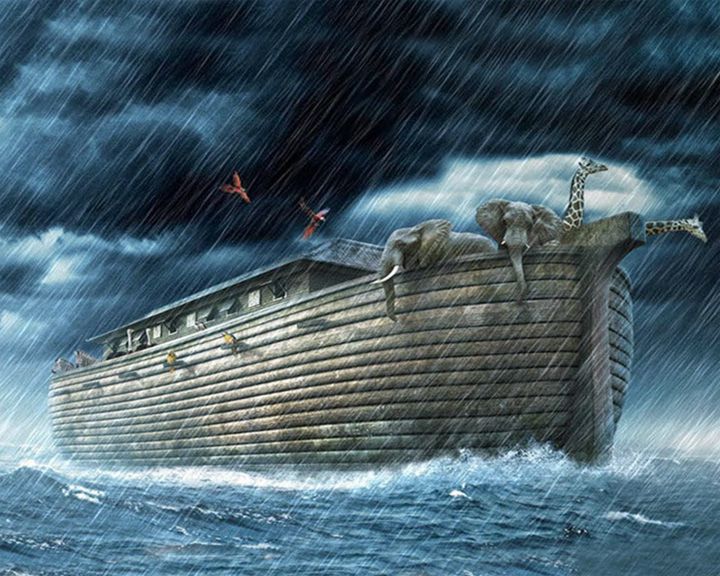 Noah's Ark — Ancient cargo ship andferry Legendary vessel that carried Noah's family and animal pairs during a torrential rain storm. Information about the ship is found in the Bible as well as the Koran. LAUNCHED: 2400, about → FATE: Unknown. |
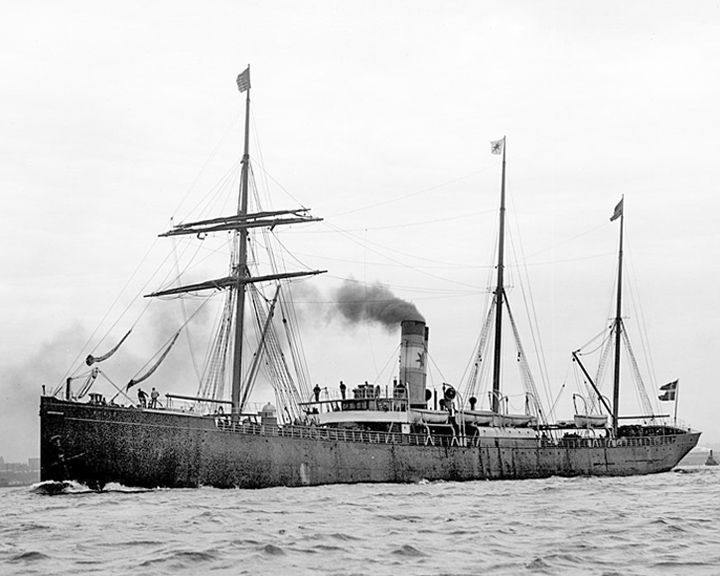 Norge, SS — Norwegian, then Danish ocean liner The biggest civilian maritime disaster in the Atlantic in the until the sinking of the Titanic. More than 635 people died during the sinking, among them 225 Norwegians. The disaster remains the worst in Danish maritime history. LAUNCHED: 1881, June 18 → FATE: Ran aground and sank June 28, 1904. |
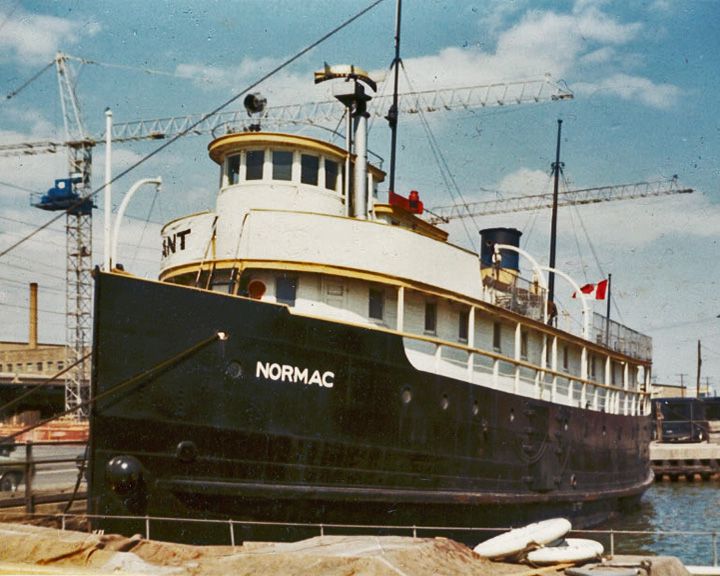 (Another (Another Normac, MS — American fire tug, later a ferry Used as Captain John's Harbour Boat Restaurant, a floating restaurant in Toronto Harbour, from 1969-1981. She sank after being severely damaged when the ferry Trillium struck her in 1981. She was raised in 1986 and again refurbished as a restaurant as seen in "Another IMAGE". LAUNCHED: 1902 → FATE: Currently a floating restaurant in Toronto, Ontario. |
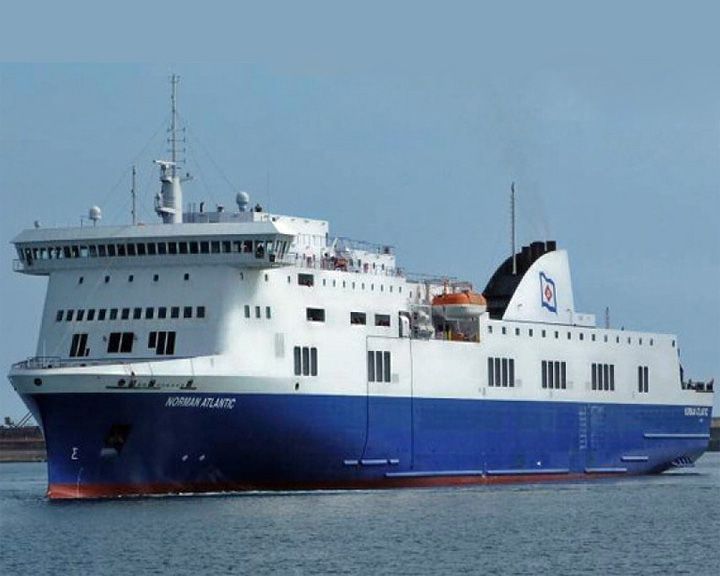 (Another (Another Norman Atlantic, MS — Italian roll-on/roll-off car ferry At least thirty people died when she caught fire in the Strait of Otranto, in the Adriatic Sea. More than 400 people were rescued, most in nighttime helicopter sorties despite high winds and seas. LAUNCHED: 2009, November, 2 → FATE: Scrapped. |
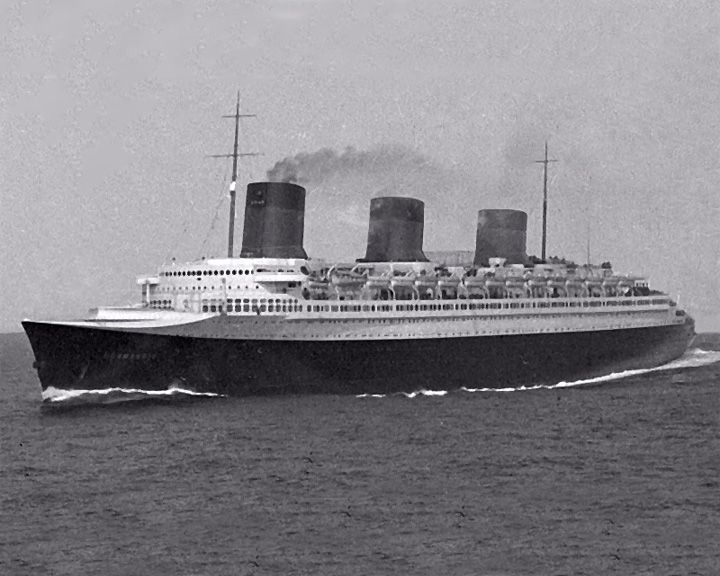 (Another (Another Normandie, SS — French ocean liner Largest, fastest and most powerful passenger ship ever built. Considered one of the greatest ocean liners in history, her Art Deco motif was so splendid she was known as the "Ship of Light" just as Paris was the "City of Light". LAUNCHED: 1935, October 29 → FATE: Caught fire and capsized in February 1942; scrapped October, 1946. |
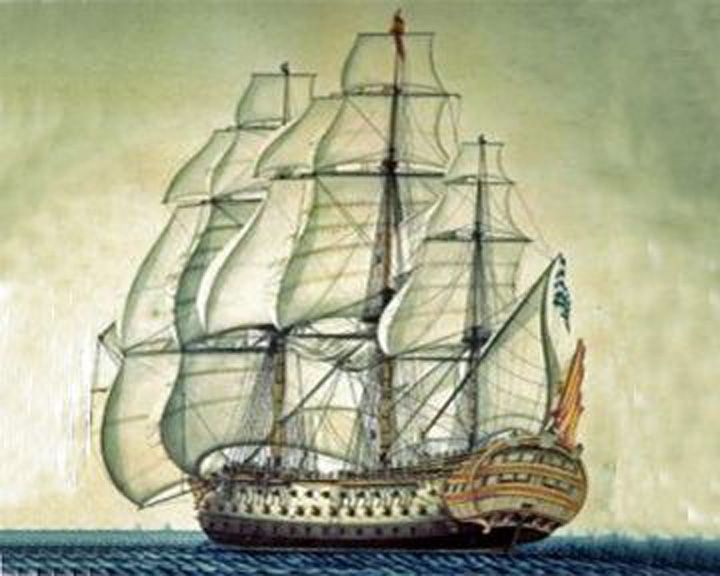 Nuestra Señora de las Mer — Spanish frigate Thought to be the wreck discovered by Odyssey Marine Exploration. Returning to Spain from South America with tons of gold, silver and jewels, she was blown up by the British off Cabo de Santa Maria, Portugal. LAUNCHED: 1786 → FATE: Sunk by the British on October 5, 1804. |
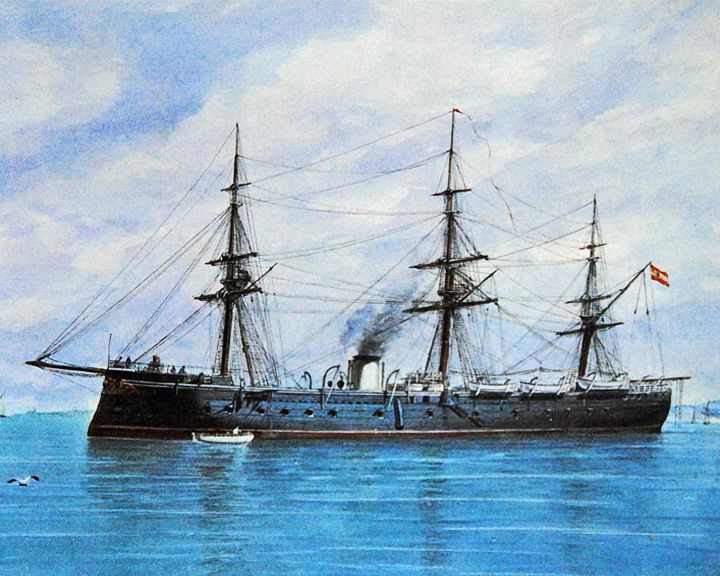 Numancia — Spanish broadside ironclad First ironclad to circumnavigate the Earth. She was built as an armored frigate in France and sold to the Spanish in 1865. LAUNCHED: 1863, November 18 → FATE: Sank while under tow December 17, 1916. |
|
|
Page 39
|
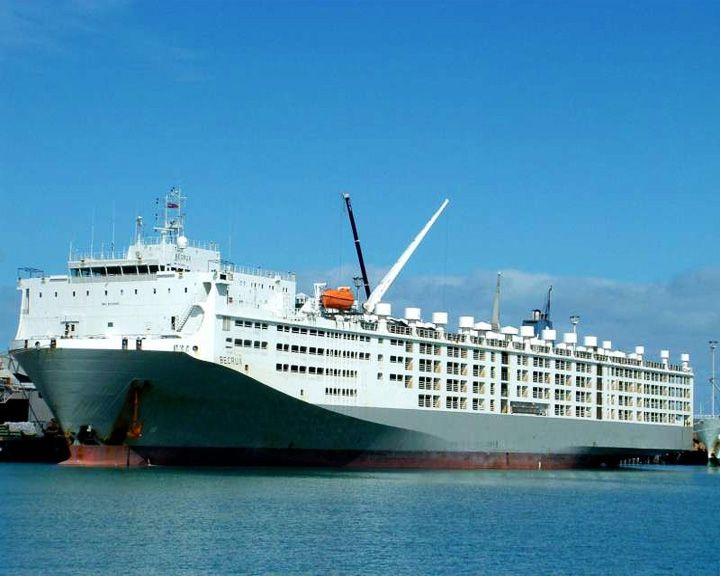 Ocean Dover, MV — Australian livestock carrier The largest livestock carrier in the world designed and built with special livestock support systems. She is capable of carrying 75,000 sheep or 18,000 cattle across oceans. In 2014, a fire broke out in the crew quarters, but was contained. LAUNCHED: 2002 → FATE: Still in service. |
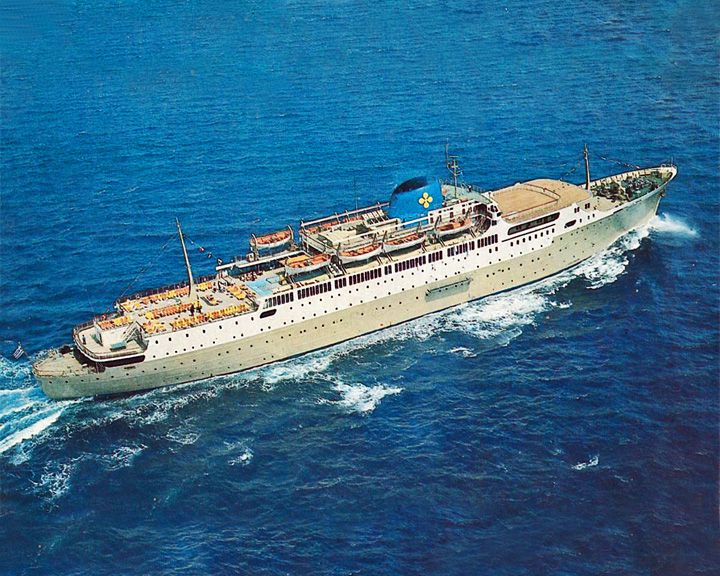 Oceanos, MTS — Greek cruise ship Realizing the ship was doomed, the crew fled in panic, neglecting their duties and the passengers. All 571 people on board were saved following one of the most dramatic and successful rescue operations of its kind. LAUNCHED: 1952, July → FATE: Sank off South Africa's eastern coast on August 4, 1991. |
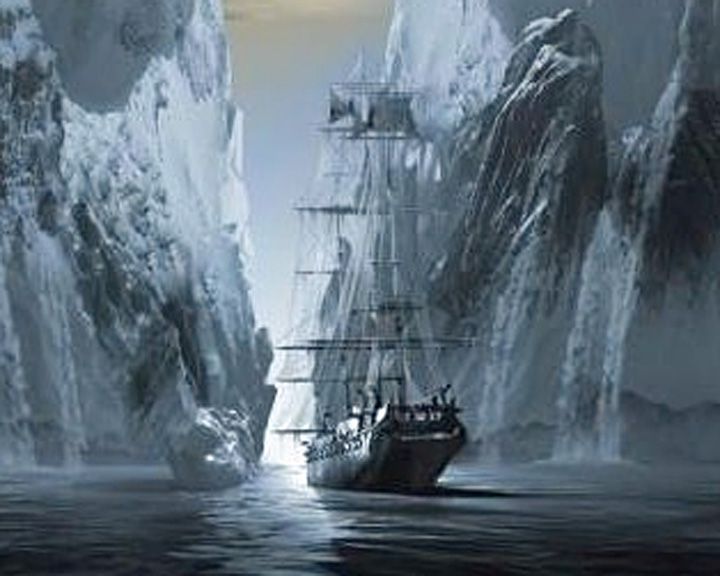 |
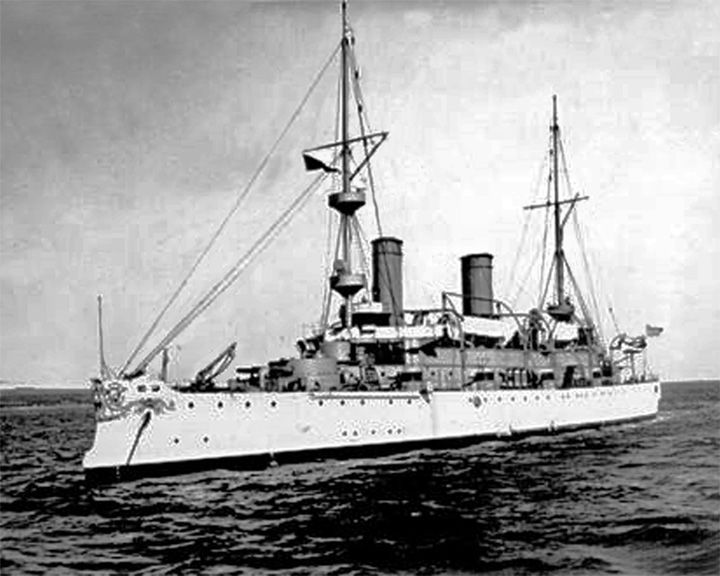 Olympia, USS — American protected cruiser Famous as the flagship of Commodore George Dewey at the Battle of Manila. She is the sole floating survivor of the US Navy's Spanish American War fleet. LAUNCHED: 1892, November 18 → FATE: Restored as a museum ship at the Independence Seaport Museum in Philadelphia. |
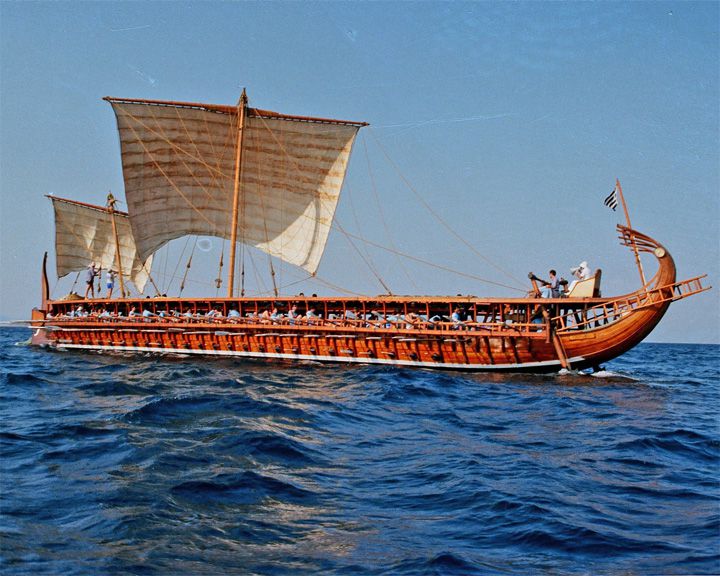 Olympias — Greek trireme The only commissioned replica trireme in the world. She achieved a speed of 9 knots (17 km/h) and was able to turn 180 degree within one minute. LAUNCHED: 1987, August → FATE: On exhibit in a dry dock at the Naval Tradition Park in Palaio Faliro, Athens, Greece. |
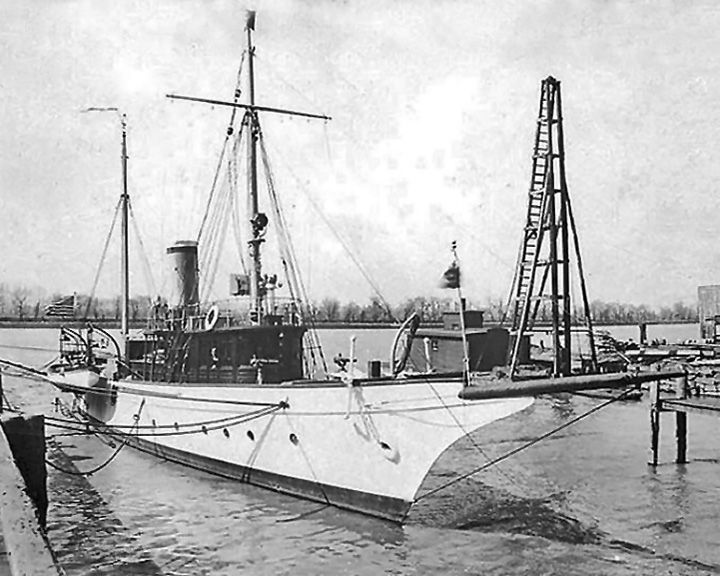 Oneida — American yacht W.R. Hearst's boat and site of the mysterious death of an American film producer that became a scandal and part of early Hollywood lore. The 2001 movie The Cat's Meow dramatized the fateful events on the yacht. LAUNCHED: 1897 → FATE: Sold as scrap August 21, 1940. |
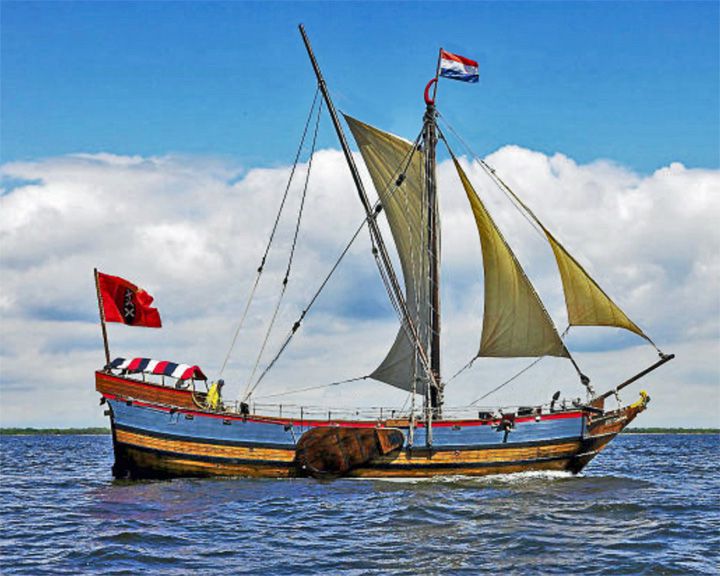 Onrust — Dutch yacht First ship built to reach what is now New York State, and the first fur trading vessel built in America. The ship was the first to explore much of the eastern seaboard around New England. LAUNCHED: 1614, replica launched May 20, 2009 → FATE: Original ship, unknown; replica on display at Connecticut River Museum. |
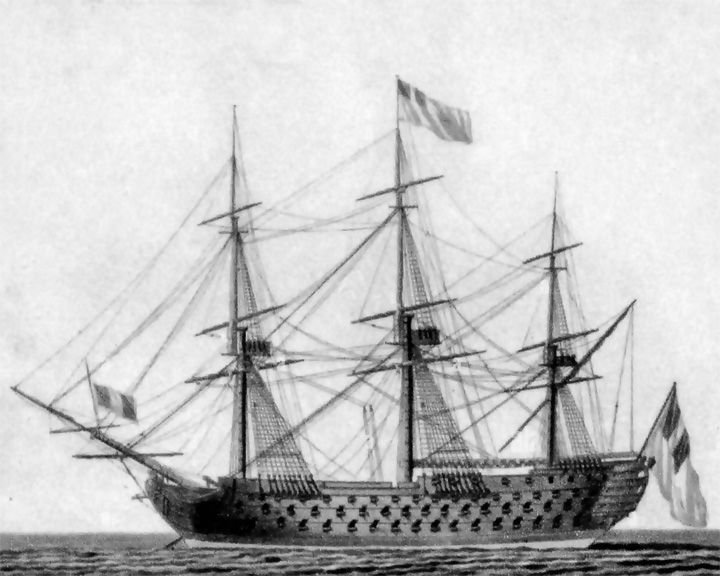 Orient — French ship of the line Famous for her role as flagship of the French fleet at the Battle of the Nile, 1798. During the battle, she caught fire and exploded, with an estimated loss of over 1,130 men; 760 are said to have survived. LAUNCHED: 1791, July 20 → FATE: She was destroyed by an explosion, August 1798. |
|
|
Page 40
|
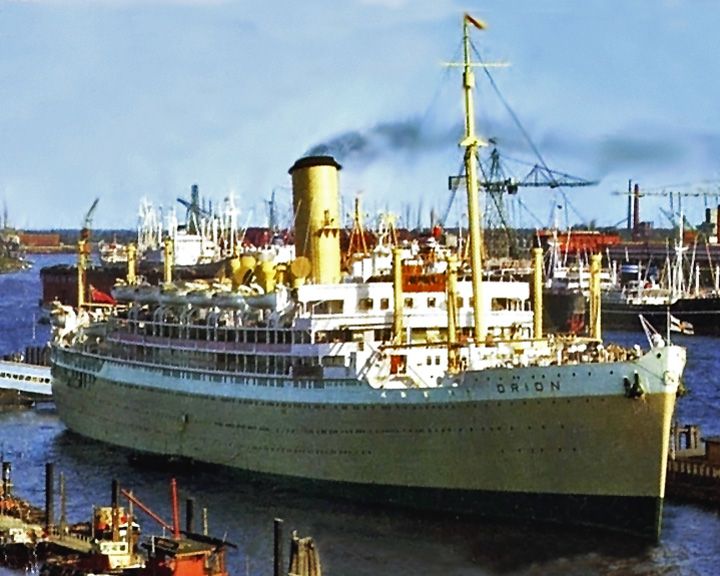 Orion, RMS — British ocean liner First to offer modern passenger comforts in ocean travel including air conditioning.. She was launched at England from Brisbane, Australia by wireless remote by the Duke of Gloucester. She served as a troop ship in World War II, then converted to a passenger liner in 1946. LAUNCHED: 1934, December 18 → FATE: Broken for scrap at Antwerp, Belgium in 1963. |
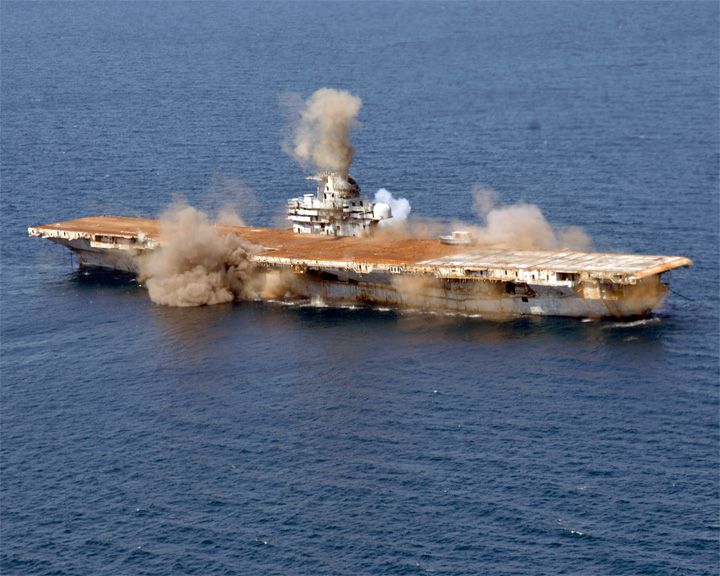 (Another (Another Oriskany, USS — American aircraft carrier, Essex class The world's largest, and the U.S.'s first, artificial reef. She had multiple reconfigurations and updates. In 1966, a flare accidentally ignited on the hangar bay causing a catastrophic fire killing 44 crewmen. LAUNCHED: 1945, October 18 → FATE: Sunk as an artifical reef May 17, 2006. |
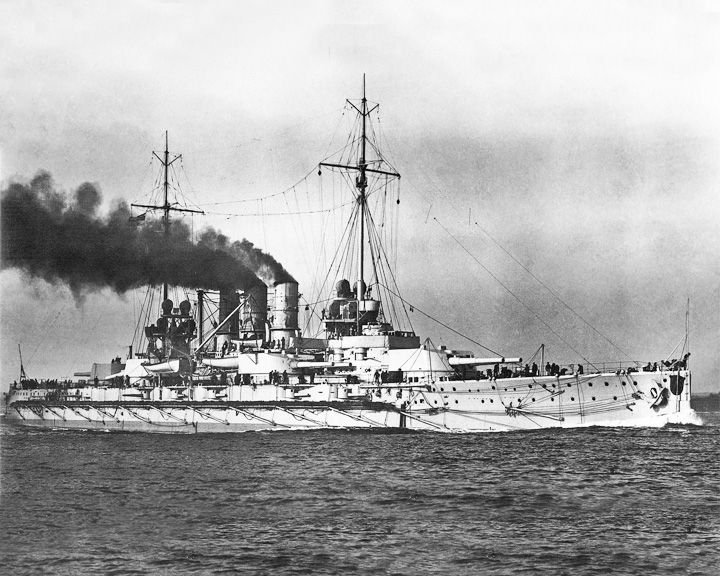 Ostfriesland, SMS — German battleship, ceded to America after World War II Sunk by bombs dropped from aircraft by General Billy Mitchell to demonstrate air power. After having seen action in World War I, the ship was ceded to the United States as war reparations. LAUNCHED: 1909, Septmber 30 → FATE: Sunk by bombs off Cape Hatteras July 21, 1921. |
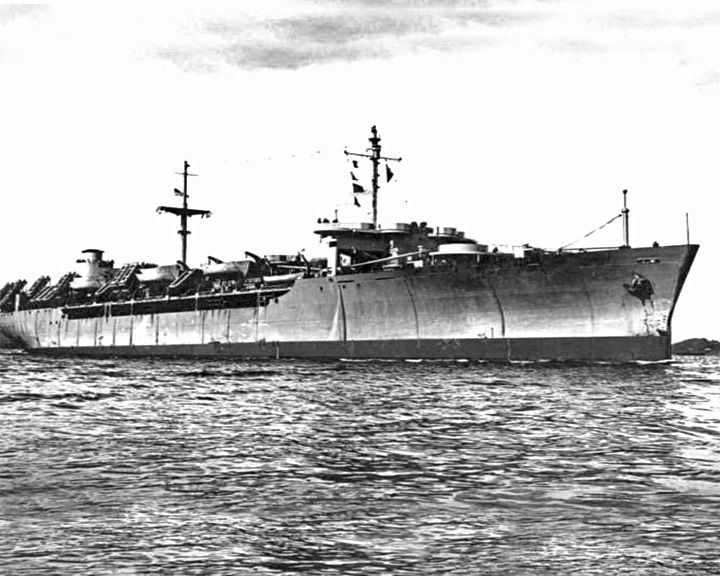 Ourang Medan, SS — Dutch cargo ship Purported ghost ship in Indonesian waters after her crew had died under suspicious circumstances. No registration records for a ship by the name of Ourang Medan could be located in various countries. LAUNCHED: 1945, first referenced → FATE: Supposedly exploded and sank June, 1947. |
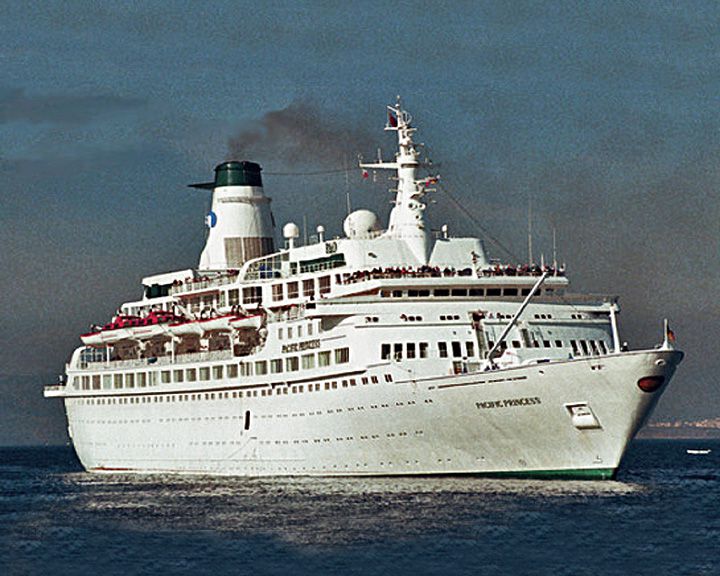 Pacific Princess — American cruise ship The ship featured in the TV series Love Boat from 1977 to 1986. In 1998 the Pacific Princess was impounded by police in Piraeus, Greece after 25 kg of heroin was found on board. LAUNCHED: 1970, May 18 → FATE: Sold to be scrapped in March of 2012. |
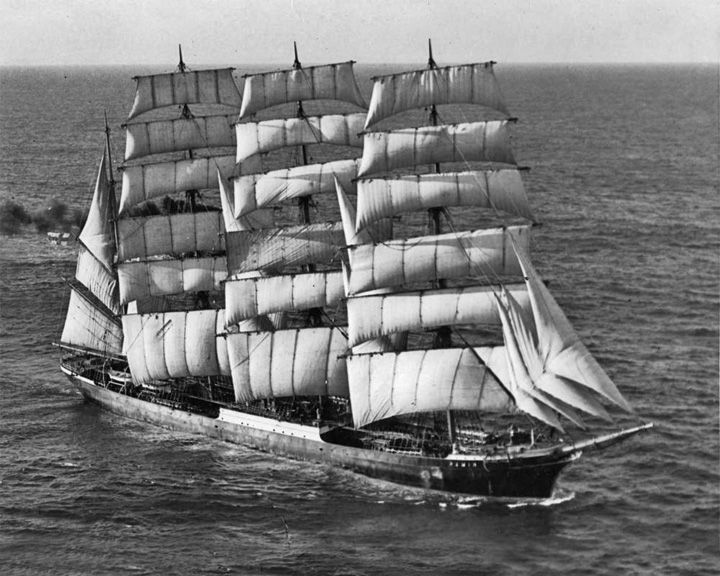 Pamir — German barque, four-masted steel-hulled windjammer Last commercial sailing ship to round Cape Horn in 1949. Over her life at various times, she flew under the flags of Germany, Italy, New Zealand, and Finland. LAUNCHED: 1905, July → FATE: Caught in Hurricane Carrie and sank off the Azores, September 21, 1957. |
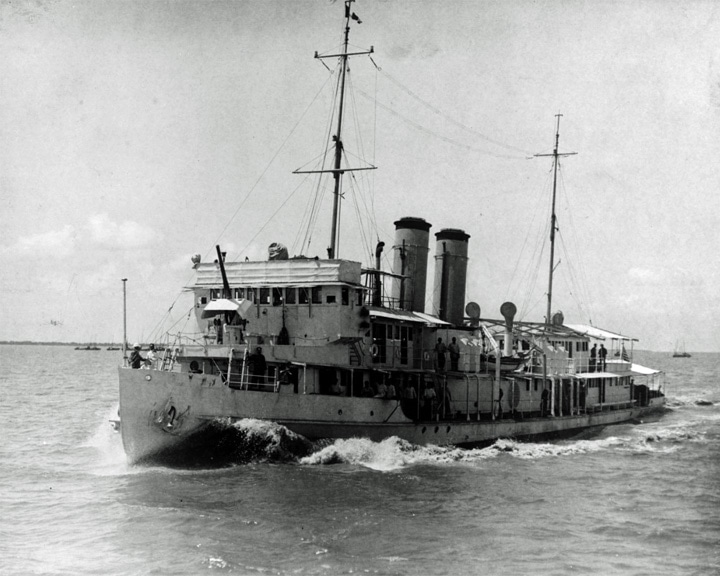 Panay, USS — American river gunboat The USS Panay incident; on December 12, 1937, a Japanese bombing attack on this U.S. Navy river gunboat and three Standard Oil Company tankers on the Yangtze River. Two newsreel cameramen were present on Panay and filmed much of the attack and afterward from shore as Panay sank. See Newsreel. LAUNCHED: 1927, November 10 → FATE: Sunk in December 12, 1937. |
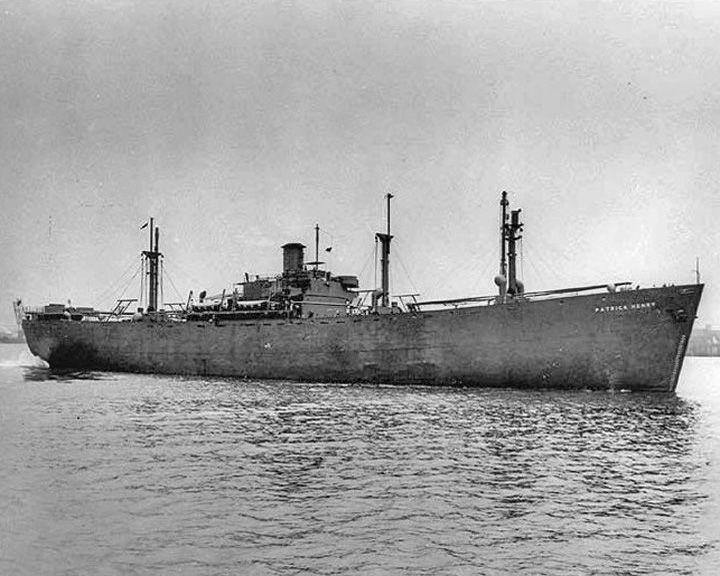 Patrick Henry, SS — American liberty ship; cargo ship First of 2751 liberty ships built during World War II. Liberty ships were built in a mass production method, each typically in 70 days or less. SS Patrick Henry made 12 voyages across the Atlantic Ocean. LAUNCHED: 1941, September 18 → FATE: Went aground off the coast of Florida July of 1946, scrapped in 1960. |
|
|
Page 41
|
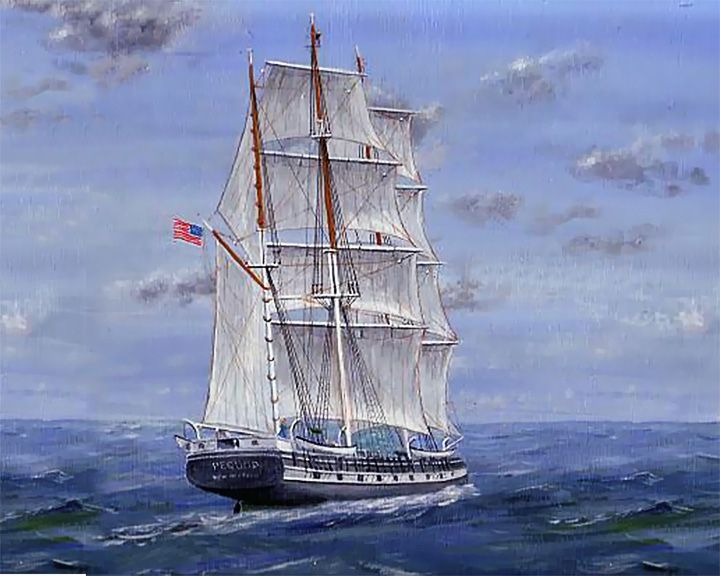 Pequod — American whaling ship Fictitious 19th-century Nantucket whaling ship in the 1851 novel Moby-Dick by Herman Melville and in several movies. In the novel, the ship's captain is the one-legged, monomaniacal Ahab. LAUNCHED: 1840, or earlier → FATE: Destroyed by a whale supposedly in 1851. |
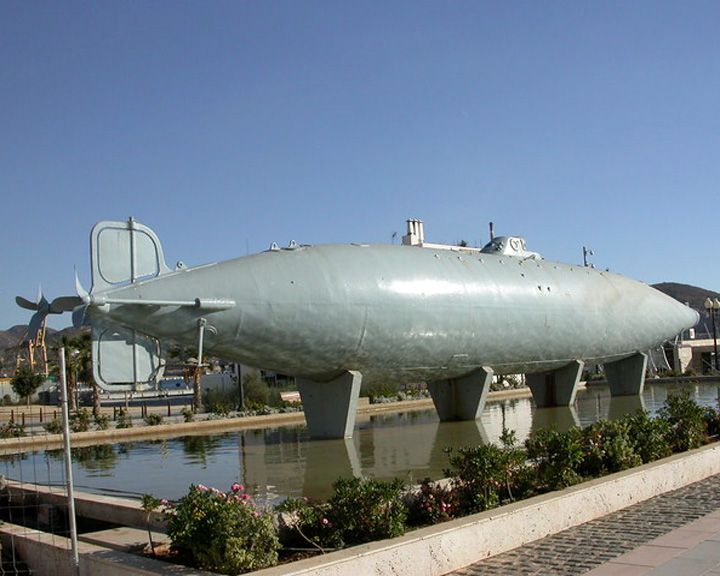 (Another (Another Peral — Spanish submarine The first fully capable military submarine and the first electric battery-powered submarine. She was also the fastest at the time. Since she lacked a means of charging batteries while underway, such as an internal combustion engine, she had very limited endurance and range. LAUNCHED: 1889 → FATE: Withdrawn from service in 1890 and is now preserved at the Cartagena Naval Museum. |
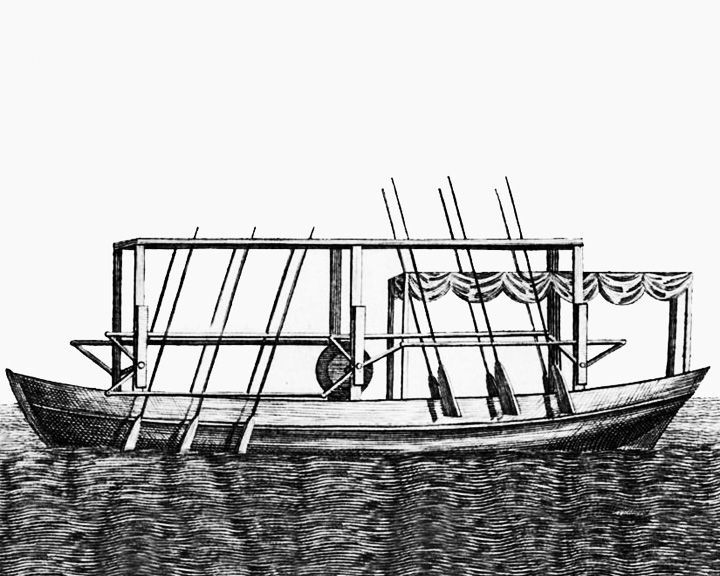 Perserverance — American steam boat First steam boat that operated using a series of vertical paddles. Invented by John Fitch, an improved model carried passengers on round-trips between Philadelphia and Burlington, New Jersey, summer of 1790. LAUNCHED: 1787 → FATE: Unknown. |
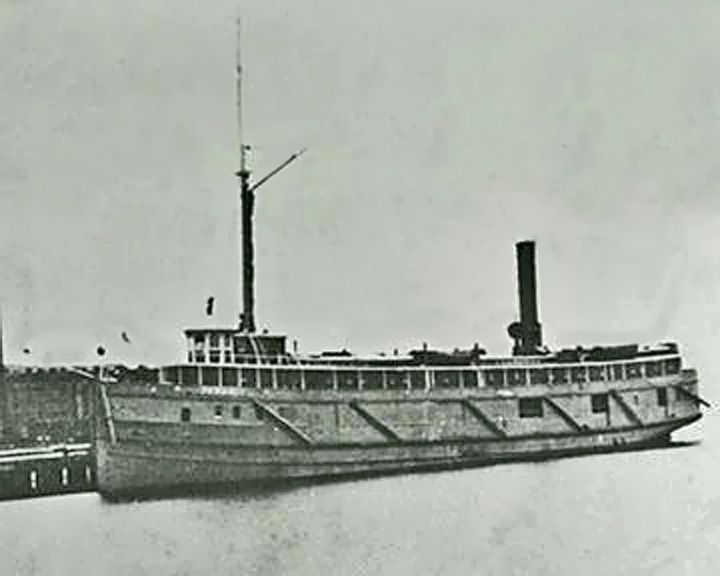 Pewabic, SS — American lake steamship; cargo ship Worst shipwreck on the Great Lakes with the loss of an estimated 125 lives, hundreds of tons of copper, silver, and iron ore. Over the years five divers died attempting to salvage the cargo. Some of the copper was recovered during World War I, the rest in 1974. LAUNCHED: 1863 → FATE: Collided with SS Meteor in Michigan's Thunder Bay and sank August 9, 1865. |
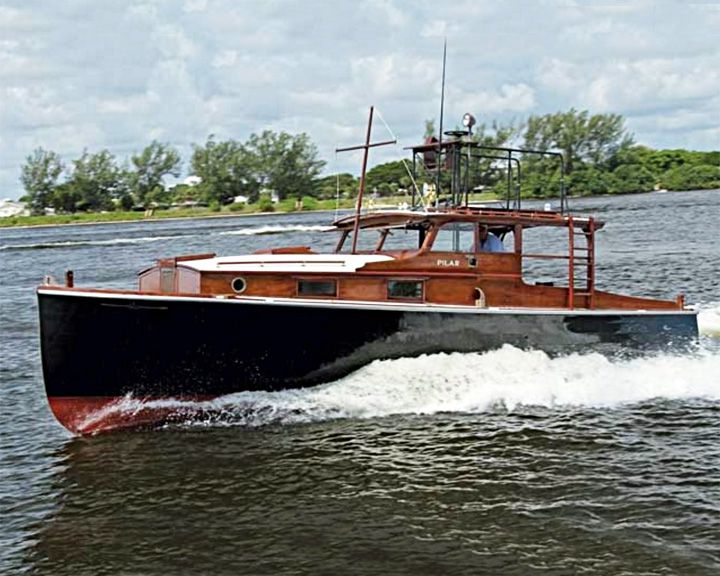 Pilar — American fishing boat Ernest Hemingway's fishing boat. Pilar was a nickname for the American novelist's second wife, Pauline, and the heroine in For Whom the Bell Tolls. LAUNCHED: 1934, April → FATE: On display at Hemingway's former home, Finca Vigía, near Havana, Cuba. |
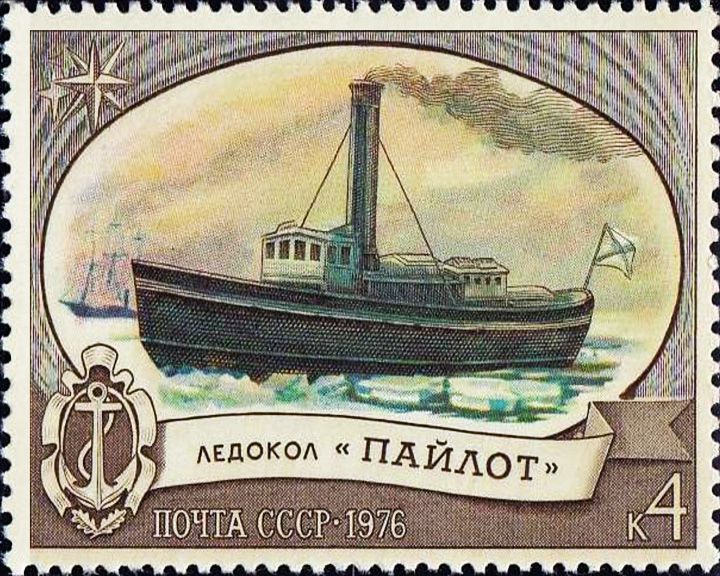 Pilot — Russian icebreaker World's first steam-powered and metal-ship icebreaker. Originally been built as a steam-powered propeller tug. LAUNCHED: 1864 → FATE: Unknown. |
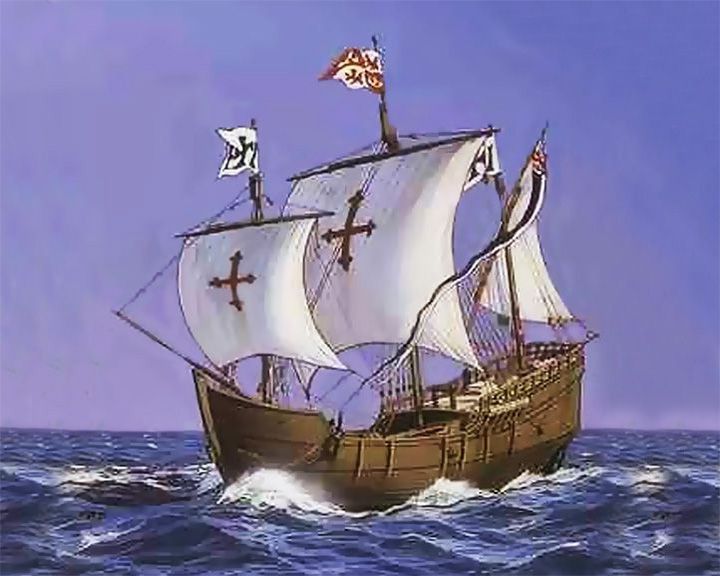 Pinta, (La) — Spanish three masted caravel One of Columbus' ships of discovery. The fastest of Columbus' three ships to America in 1492, and Columbus' flag ship on the return trip to Spain in 1943. She was among the fleet of 17 ships for Columbus' second voyage. LAUNCHED: 1441, circa → FATE: Around 1501. |
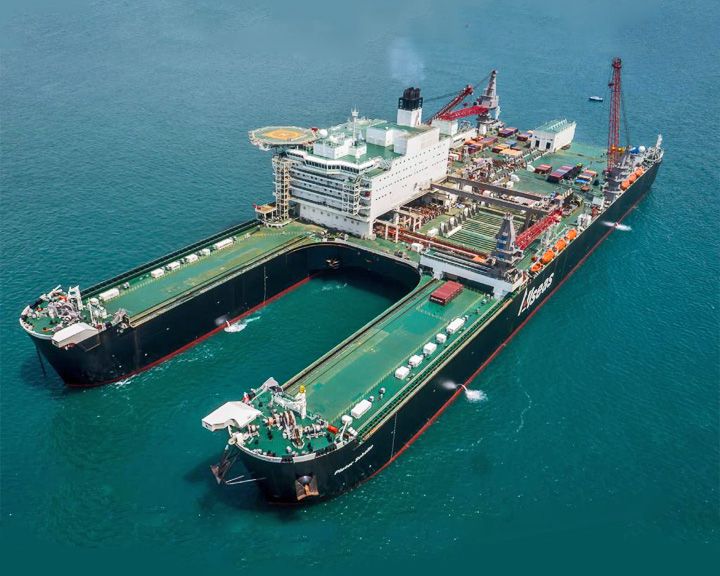 Pioneering Spirit — Swiss catamaran construction ship, Korean built The world's largest ocean vessel, designed for the single-lift installation and removal of large oil and gas platforms. Displacing 1 million tons, the vessel operates as a semi-submersible. Using ballasts, she is able to lower herself when installing payload or raise herself when removing payload. LAUNCHED: 2013, January 18 → FATE: Still in service. |
|
|
Page 42
|
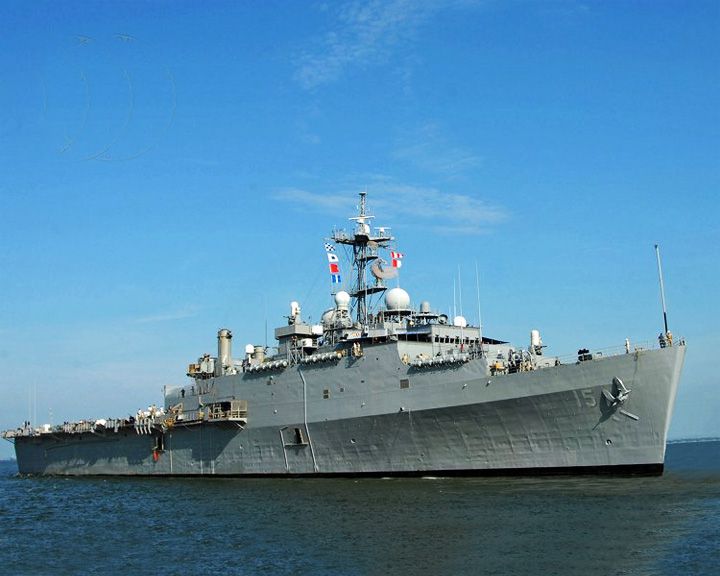 Ponce, USS — American amphibious assault ship First "Afloat Forward Staging Base" (AFSB) ship. She was refitted in 2012 to serve as floating port for helicopters and patrol craft. LAUNCHED: 1970, May 18 → FATE: Still in service. |
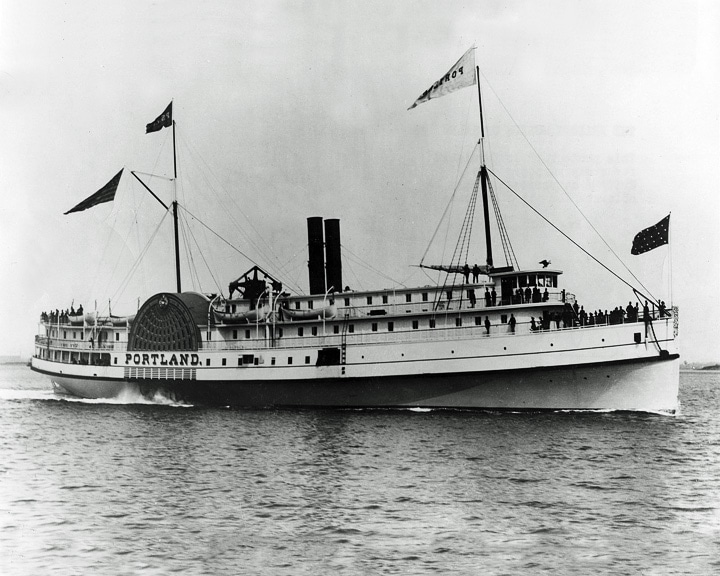 Portland, PS — American sidewheel steamer Known as the "Titanic of New England" and considered New England's worst maritime disaster, she went down with an estimated 192-245 passengers and crew. The storm that sank her, killed more than 400 persons and sank more than 150 other boats and ships. LAUNCHED: 1889 → FATE: Sank in the Portland Gale off of Cape Ann November 27, 1898. |
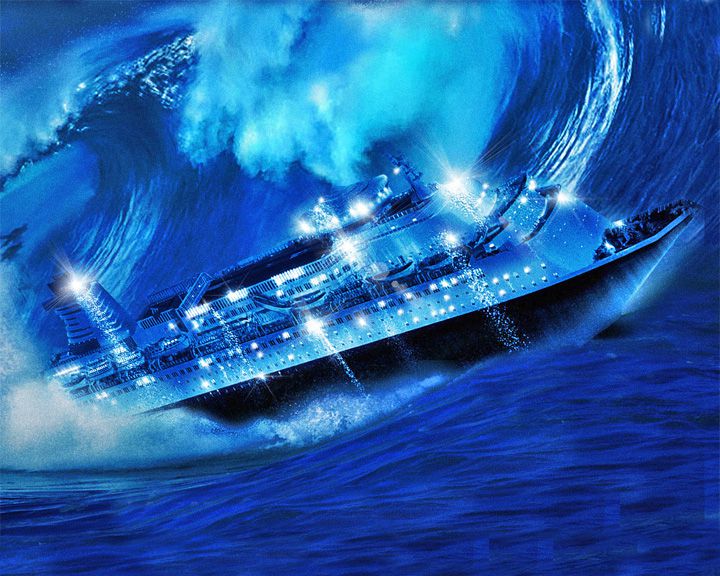 Poseidon, SS — American cruise ship; British ocean liner Subject of a ship sinking in the 1969 novel The Poseidon Adventure and four movie adaptations, 1972, 1979, 2005, and 2006. In each version of the story, the ship is capsized and several survivors try to make their way to the top of the overturned ship. LAUNCHED: 1969, original story → FATE: Inconclusive. |
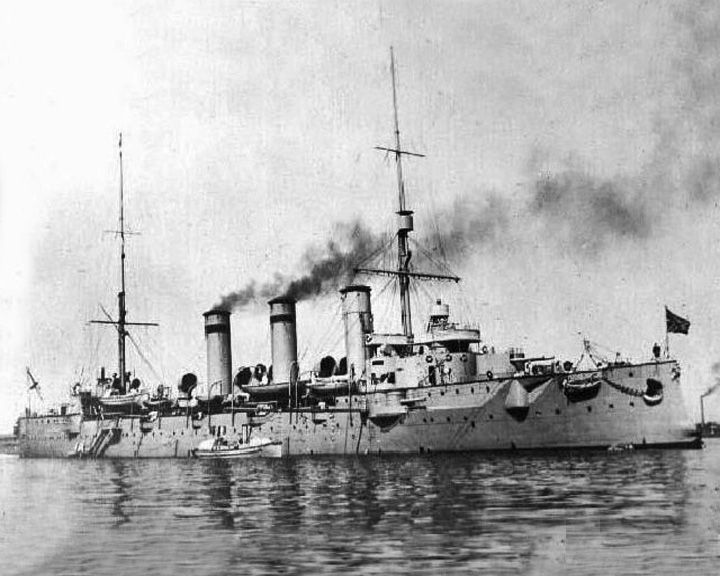 Potemkin — Russian battleship A rebellion of the crew against their cruel officers in 1905 signaled the coming of the Russian Revolution of 1917. Following the mutiny, now called Panteleimon, she accidentally sank a Russian submarine in 1909 and was badly damaged when she ran aground in 1911. LAUNCHED: 1904 → FATE: Scuttled by interventionists at Sevastopol April of 1919. |
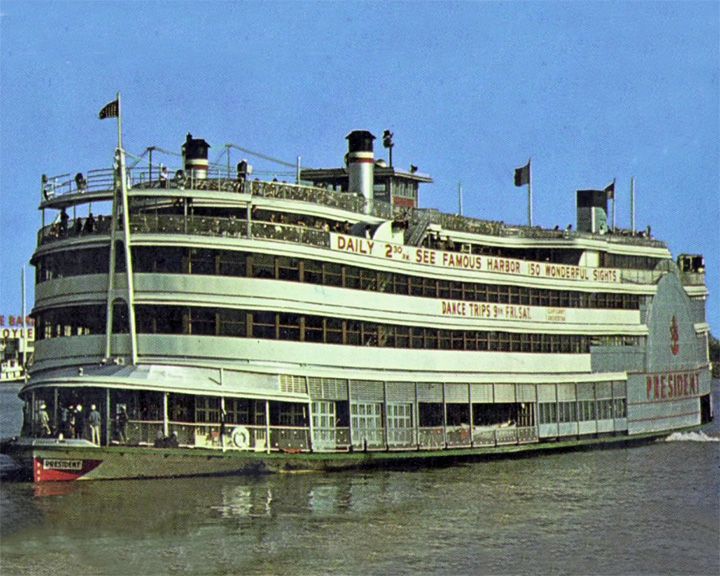 President — American steamboat The last original "Western Rivers" style side-wheel river excursion steamboat in the United States and the second riverboat casino in modern times. In the 1950s and 1960s, she berthed in New Orleans for many years as a popular music venue featuring concerts by national acts; in 1990 she was converted into a floating casino. LAUNCHED: 1924 → FATE: In 2007 she was disassembled and moved in pieces to St. Elmo, Illinois where she may be re-assembled as a non-floating tourist attraction and hotel. |
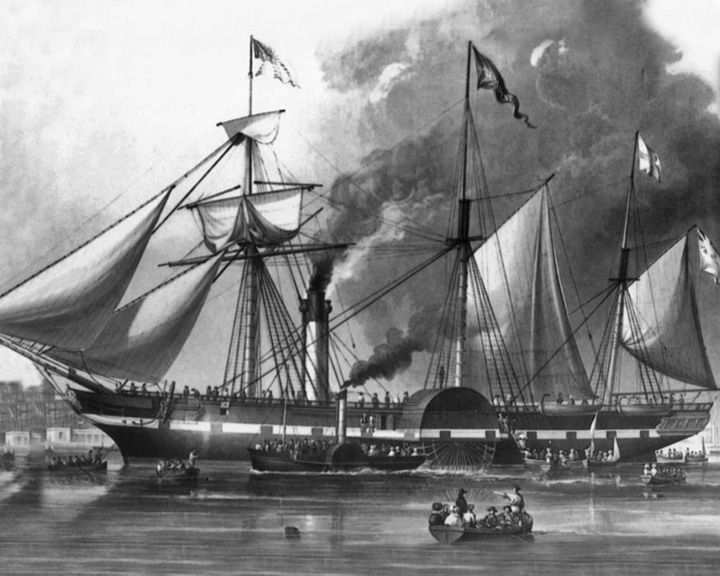 President, SS — British paddle steamship, with sails; ocean-going First steamship lost at sea on a transatlantic run, taking with her all 136 on board. Constructed with a third deck on top of the hull and designed with luxurious staterooms, she was top heavy and rolled excessively. LAUNCHED: 1840, August → FATE: Lost during a gale off Nantucket Shoals March of 1841. |
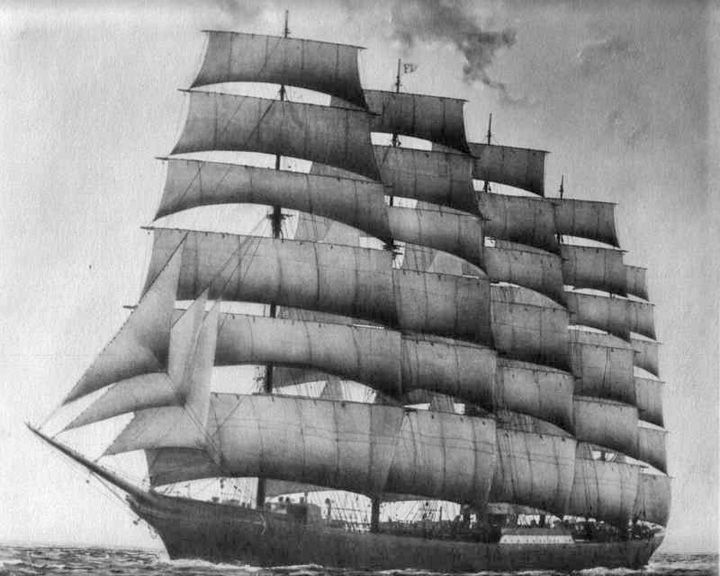 Preußen — German windjammer, five-masted The largest sailed ship ever built and the only five-masted, full-rigged, ship built until the 21st century. She was built entirely of steel. She was used in the saltpeter trade with Chile, setting speed records in the process. LAUNCHED: 1902, May 18 → FATE: Swept onto rocks and sank near the White Cliffs of Dover November 6, 1910. |
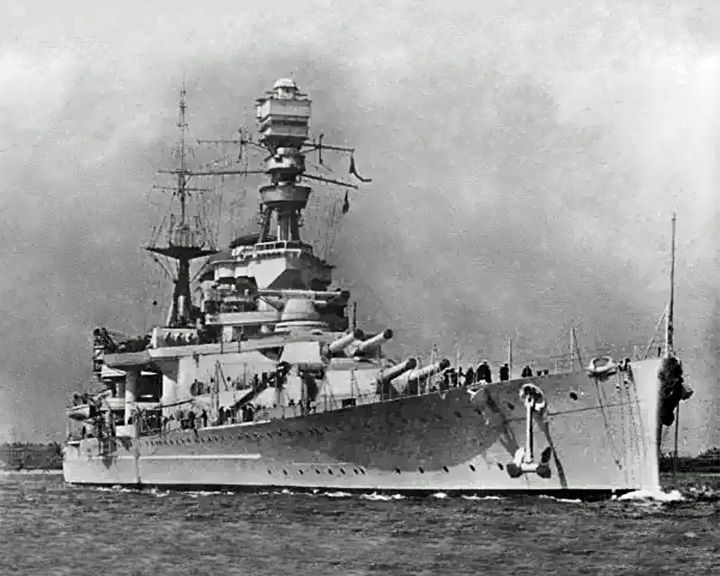 Prince of Wales, HMS — British battleship She and Repulse were the first capital ships to be sunk solely by naval air power on the open sea. She was involved in several key actions of the World War II, including the Battle of the Denmark Strait against the German battleship Bismarck. LAUNCHED: 1939, May 18 → FATE: Sunk on December 10, 1941 by Japanese air attack off Kuantan, South China Sea. |
|
|
Page 43
|
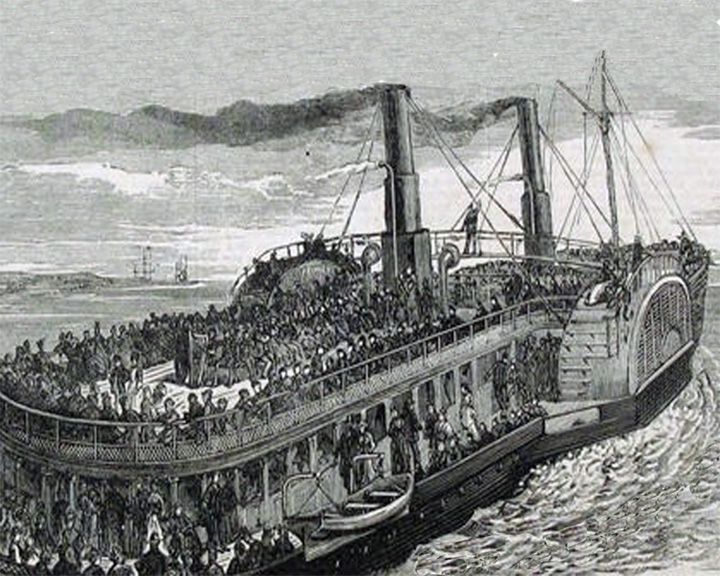 (Another (Another Princess Alice — British paddle steamer The greatest loss of life, 600-700, of any British inland waterway shipping accident after being struck by the Bywell Castle. Because of the river pollution from the sewage and local industrial output, the recovered bodies were covered with slime and toxins. LAUNCHED: 1865, July → FATE: Sank on September 3, 1878 after the collision on the River Thames. |
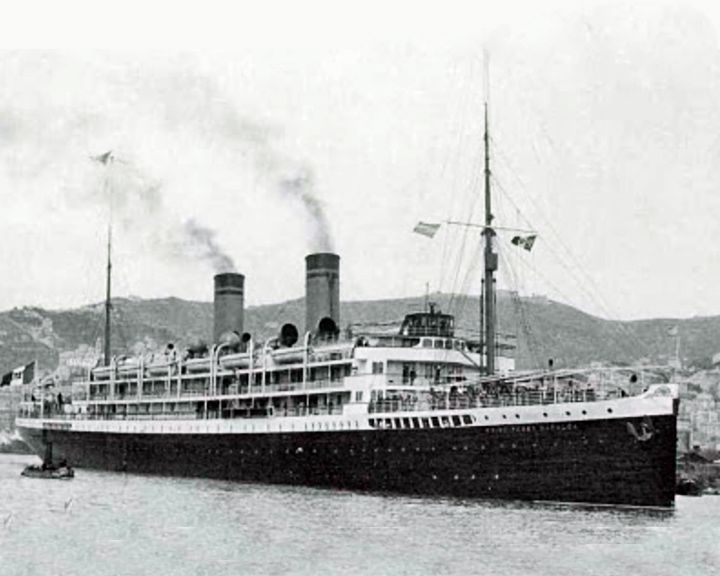 Princess Mafalda, SS — Italian ocean liner Her sinking and the loss of 314 people was the greatest loss of life in Italian shipping and the largest ever in the in the Southern Hemisphere in peacetime. At the time, she was the largest Italian passenger ship afloat and known for her luxury. LAUNCHED: 1908, October 18 → FATE: Sank of the coast of Brazil October 9, 1927. |
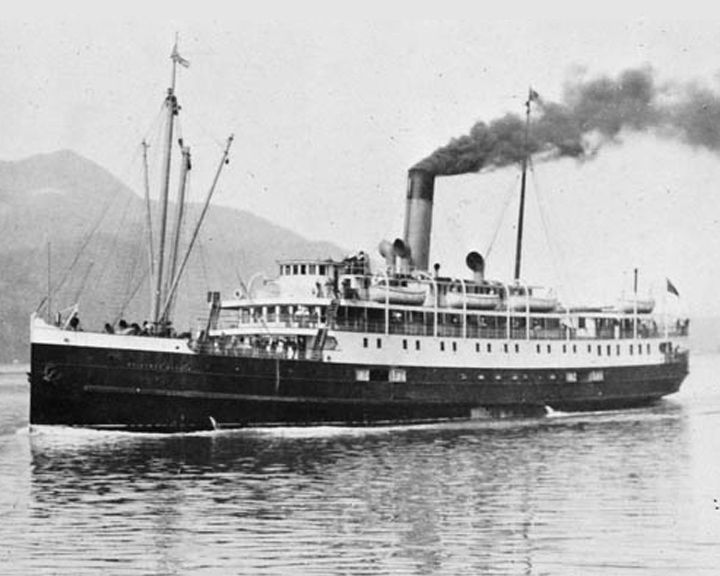 Princess Sophia, SS — Canadian passenger ship The worst maritime accident in the history of British Columbia and Alaska. The wreck and the loss of 343 people was controversial since some thought that all aboard could have been saved. LAUNCHED: 1911, November 18 → FATE: Grounded on October 24,1918 and sank following day during a storm near Juneau Alaska. |
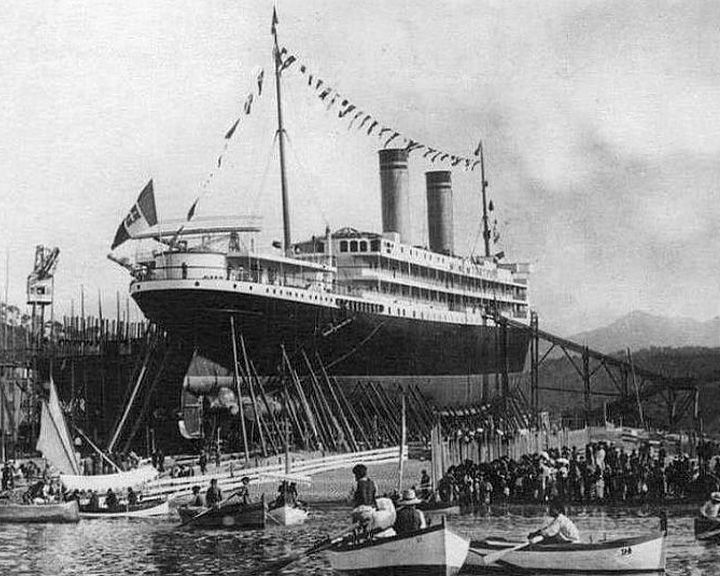 (Another (Another Principessa Jolanda, SS — Italian ocean liner She was to be among the first transatlantic vessels with Marconi telegraphy, electric lighting and telephones. She never sailed, but capsized during initial launch and sank. LAUNCHED: 1907, September 18 → FATE: Sank September 22, 1907. |
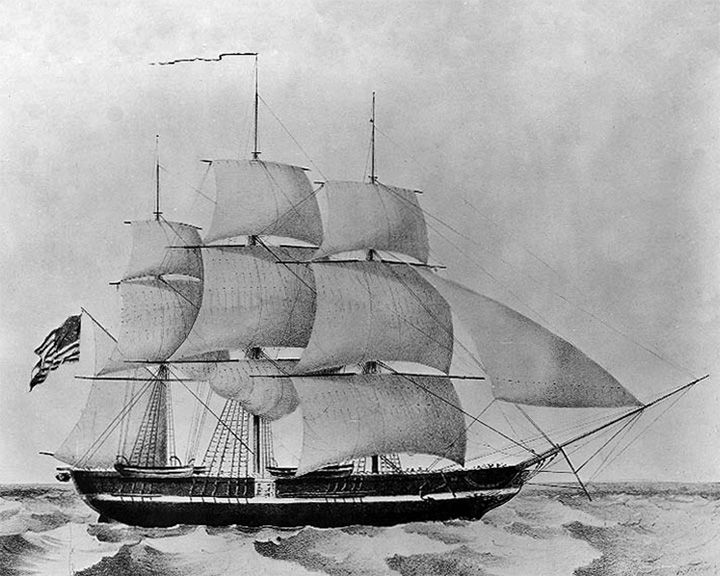 Prineton, USS — American screw steam warship First ship with screw propellers powered by an engine mounted entirely below the waterline. In 1844, during a pleasure cruise for dignitaries, a gun exploded killing 6 high-ranking federal officials and wounding 20 more, the worst such tragedy in American history. LAUNCHED: 1843, September 5 → FATE: Broken up at the Boston Navy Yard, October 1849. |
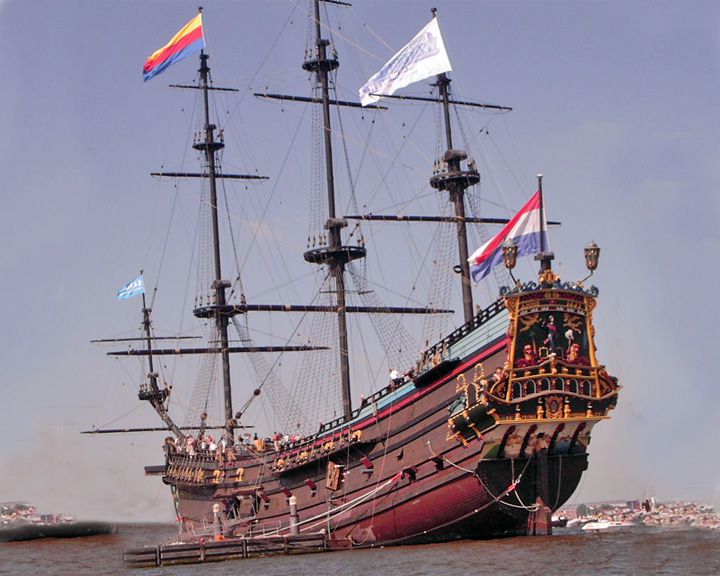 (Another (Another Prins Willem replica — Dutch brig; replica of a full-rigged ship This replica of a ship built in 1649 and sunk in 1662 was lost in fire on the morning of 30 July 2009(See alternate image). In 2004, the replica became part of the theme park Cape Holland in Den Helder, the Netherlands. LAUNCHED: 1985 → FATE: Burned and sank at Den Helder, Netherlands July 30, 2009. |
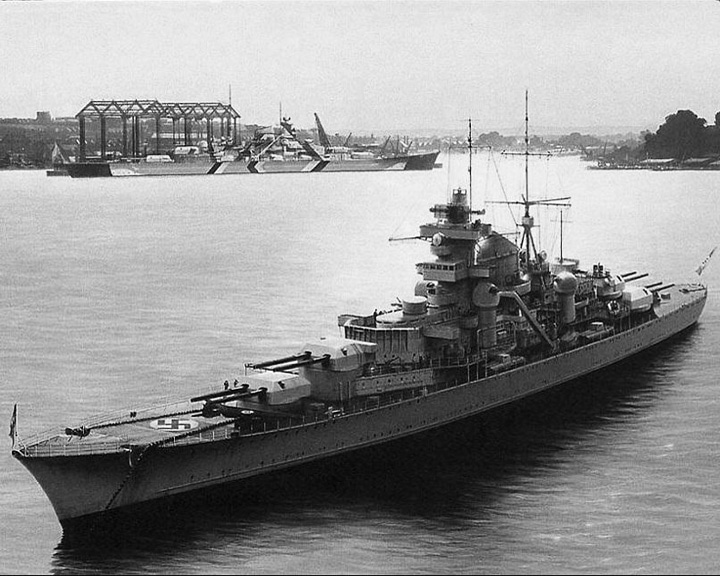 Prinz Eugen — German Admiral Hipper-class heavy cruiser After World war II ended, the US Navy assigned her to the Operation Crossroads nuclear tests at Bikini Atoll. During the Battle of Denmark Strait (May 24, 1941), she and Bismarck engaged and sank the British ships HMS Hood and HMS Prince of Wales. LAUNCHED: 1938, August 22 → FATE: Having survived the atomic blasts, she was towed to Kwajalein Atoll, where she ultimately capsized and sank in December 1946. |
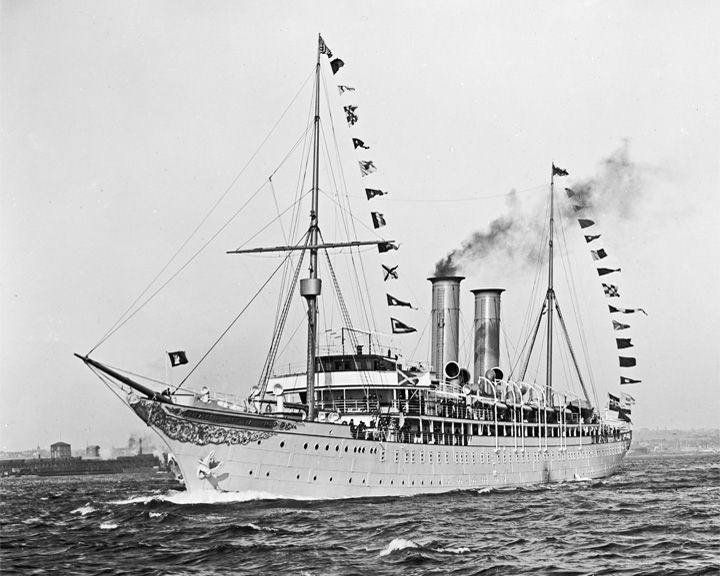 Prinzessin Victoria Luise — German passenger ship First purpose-built cruise ship. Not only did she look more like a private yacht, she had 120 first class cabins, a library, gymnasium, and darkroom. LAUNCHED: 1900, June 18 → FATE: Declared a loss December 19, 1906 after running onto rocks at Kingston. |
|
|
Page 44
|
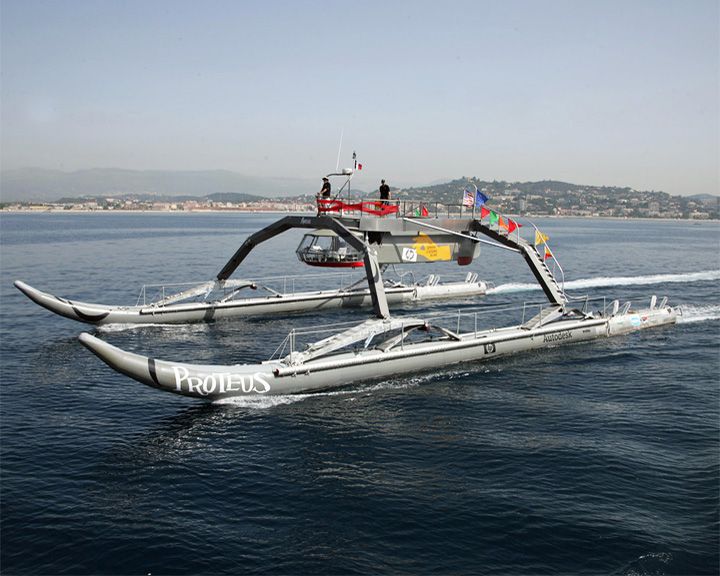 |
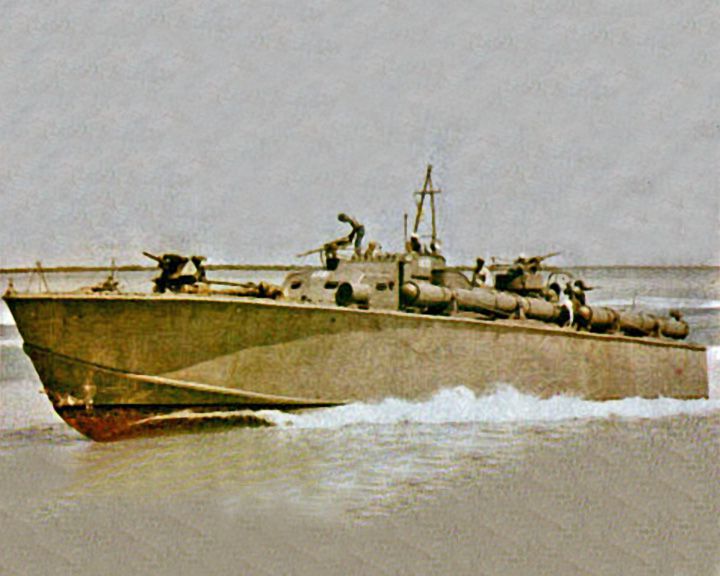 PT 109 — American motor torpedo boat Commanded by Lieutenant John F. Kennedy. The movie of the incident PT 109 was made with President Kennedy's approval provided the events be historically accurate, and the profits go to the survivors of PT 109 and their families. LAUNCHED: 1942, June 18 → FATE: Rammed and sunk in the Solomon Islands by the Japanese destroyer Amagiri on a moonless night, August 2, 1943 during World War II. |
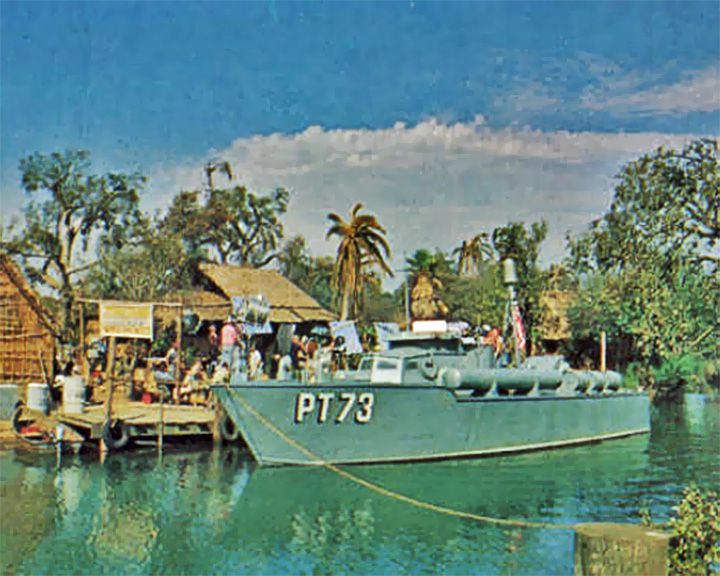 PT-73 — American PT boat Patrol boat in the TV sitcom McHale's Navy. The real-life PT-73 was built on August 12, 1942, and was destroyed by the crew in January, 1945. LAUNCHED: 1962, 1966 for the TV series → FATE: Inconlusive. |
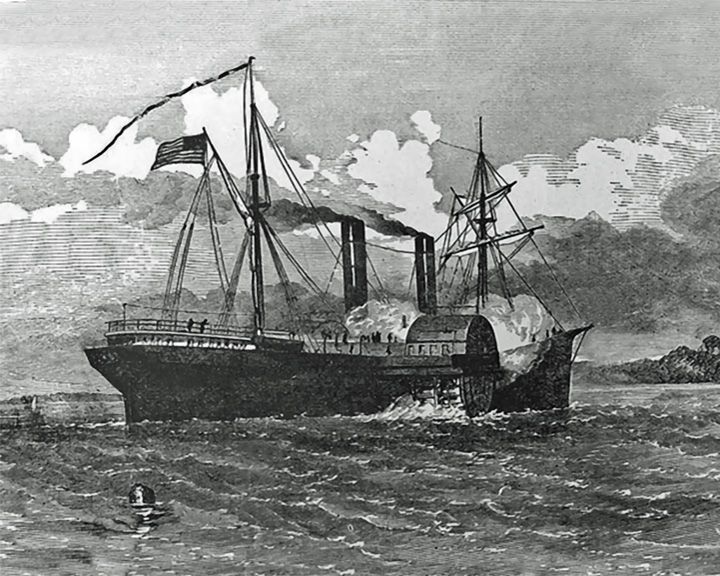 Quaker City, USS — American paddle steamship, side-wheeler During a trip to Europe in 1867, she was the scene of some of the tales related by Mark Twain in his book The Innocents Abroad. During the American Civil War, she one of the most active and effective ships in the Union Navy's blockade of Chesapeake Bay. LAUNCHED: 1854 → FATE: Sold to the Haitian Navy in February of 1871, renamed République, lost at sea off Bermuda in March of 1871. |
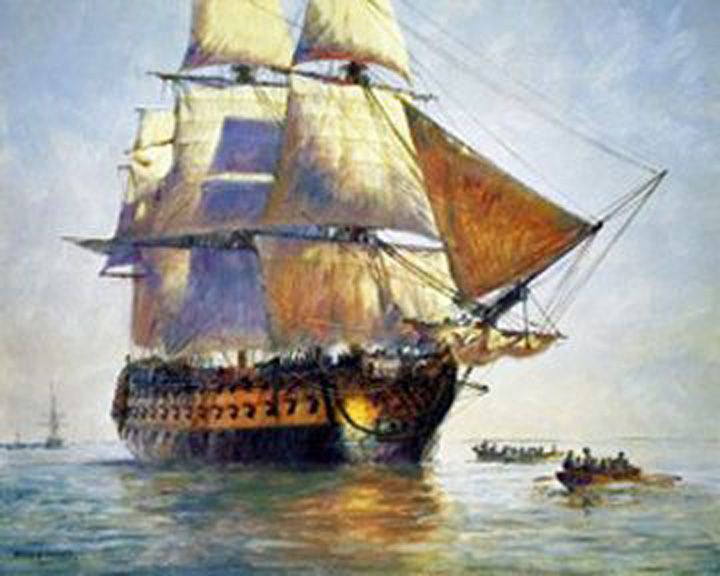 (Another (Another Queen Anne's Revenge — English sloop Flagship of pirate Blackbeard (Edward Thatch). As Conccord was captured by the French in 1711, and then as La Concord she was taken by pirates in 1717. LAUNCHED: 1710 → FATE: Run aground near Beaufort Inlet, North Carolina in May, 1718. |
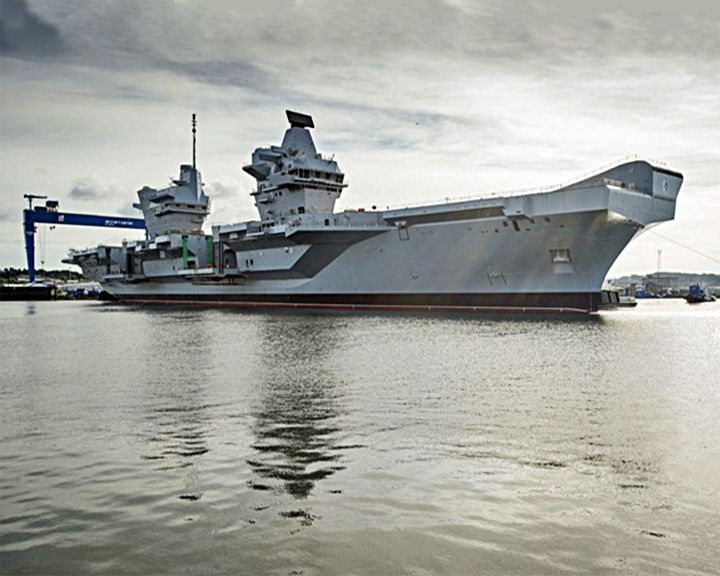 Queen Elizabeth, HMS — British aircraft carrier Largest warship ever built for the Royal Navy capable of carrying up to 40 aircraft. With no catapults and catch wires she carries only V/STOL aircraft, F-35B Lightning II fighters and Merlin helicopters. LAUNCHED: 2014, July 18 → FATE: In service 2017. |
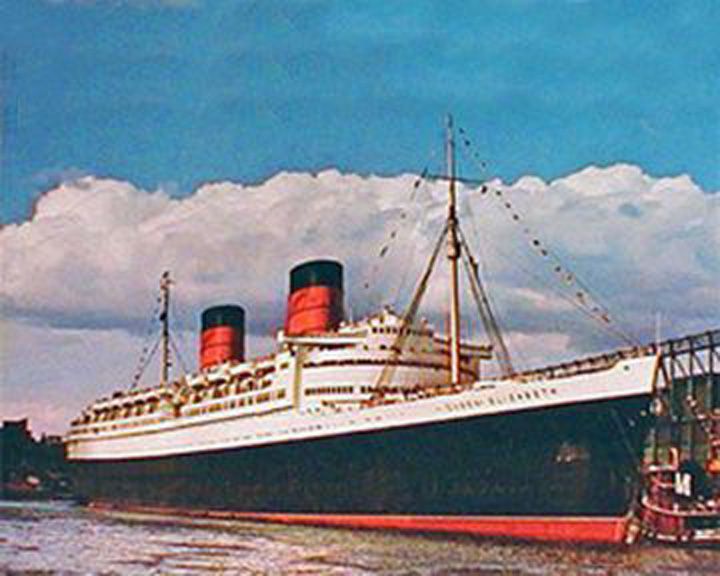 (Another (Another Queen Elizabeth, RMS — British ocean liner With sister ship Queen Mary, dominated the transatlantic passenger service. She was used in World War II as troop transport. After being converted to a university and renamed Seawise University, she was destroyed by fire. The charred wreck was featured in the 1974 James Bond movie The Man with the Golden Gun. LAUNCHED: 1938, September 18 → FATE: After a fire, capsized in Hong Kong Harbor, January 9, 1972. |
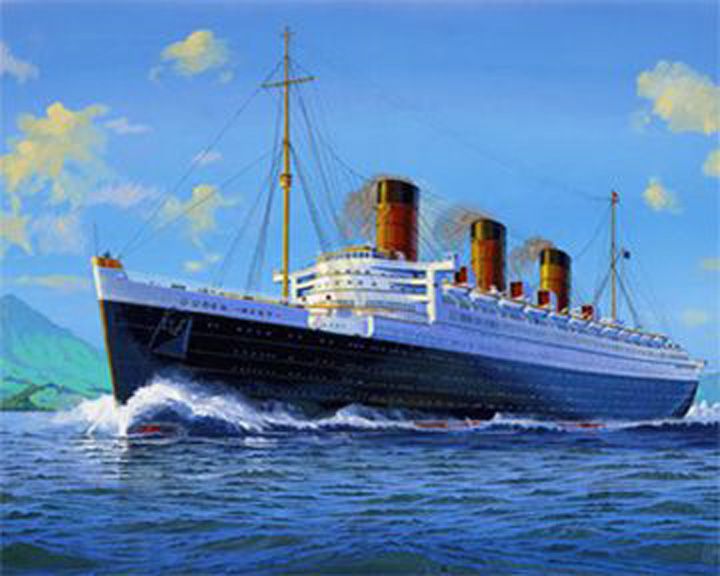 Queen Mary, RMS — British ocean liner Once dominated transatlantic passenger service with sister ship Queen Elizabeth. She was used in World War II as troop transport carrying up to 15,000 passengers at a time. Featured in the 1972 movie The Poseidon Adventure and the 1981 movie Goliath Awaits. LAUNCHED: 1934, Septmber 26 → FATE: After sailing nearly 4 million miles, she was retired in 1967 and berthed in Long Beach, California as a museum ship and hotel from 1974 to present. |
|
|
Page 45
|
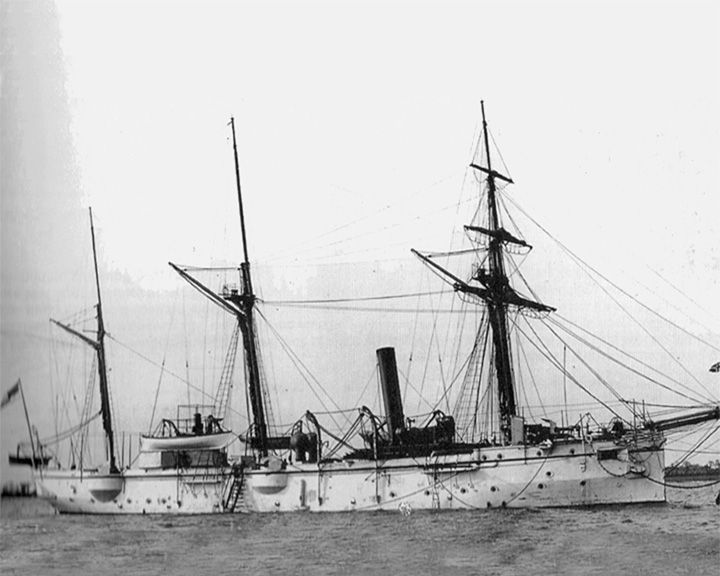 Rattler, HMS — British sloop made of wood with metal frame First warship to adopt a screw propellor. In March 1845, she beat HMS Alecto in a series of races, followed by a contest in which she towed Alecto backwards at a speed of 2 knots (3.7 km/h). LAUNCHED: 1843 → FATE: Broken up 1856. |
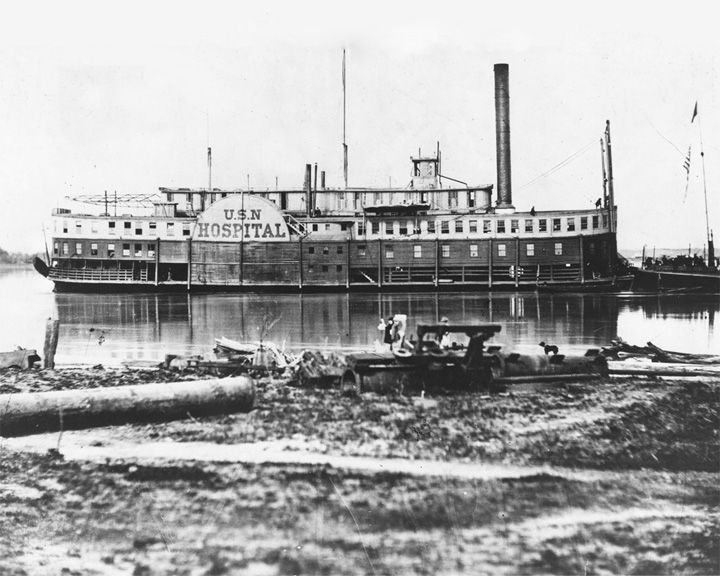 Red Rover, USS — American Confederate paddle steamboat, side-wheeler First ship fitted and staffed as a hospital ship. During the American Civil War, she was a Confederate barracks ship until the Union captured and refit her in March of 1862. LAUNCHED: 1859 → FATE: Decommissioned and sold at public auction November 29, 1865. |
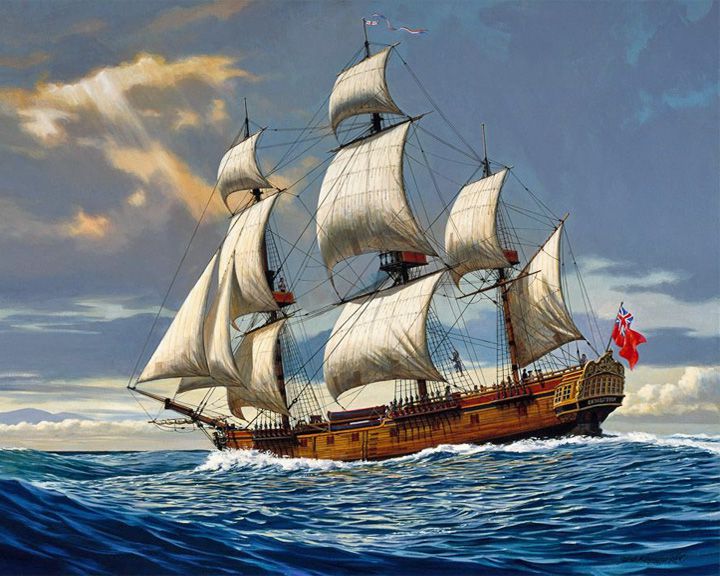 Resolution, HMS — British Collier The first ship to cross the Antarctic Circle reaching beyond latitude 71 degrees south. She was the ship on which Captain James Cook made his second and third voyages of exploration in the Pacific. LAUNCHED: 1770 → FATE: Taken by the French June 10, 1782, renamed La Liberté and ended up rotting in Narragansett Bay not far from Cook's other ship, Endeavour. |
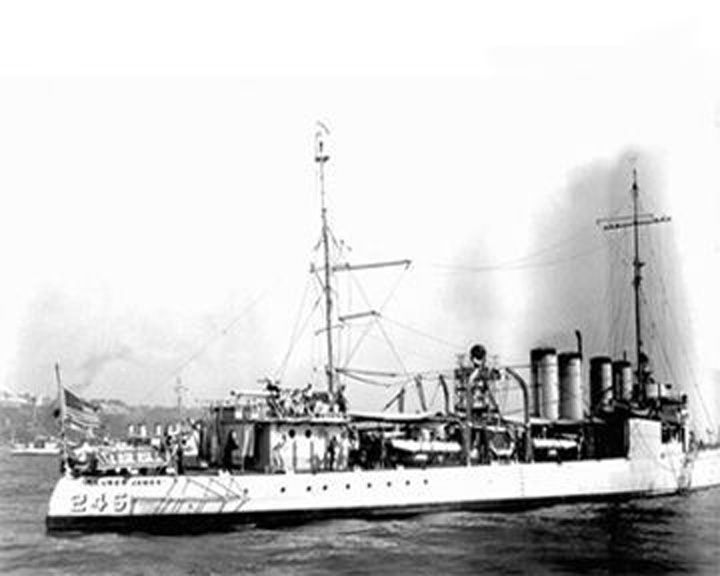 Reuben James, USS — American destroyer First US ship to be sunk in World War II. She was torpedoed while escorting an Atlantic convoy of supply ships to Britain; 159 crew were lost, 44 survived. LAUNCHED: 1919, October → FATE: Sunk October 31, 1941. |
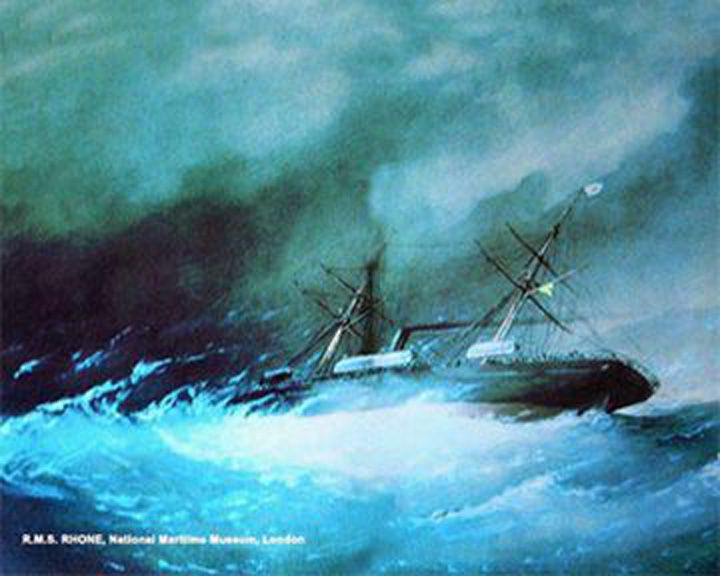 (Another (Another Rhone, RMS — British packet ship Sunk during a hurricane with the loss of approximately 123 lives. The wreckage is now a popular diving site and was used in the 1977 film The Deep that featured Jacqueline Bisset in a wet T‑shirt. LAUNCHED: 1865 → FATE: Wrecked in the British Virgin Islands on October 29, 1867. |
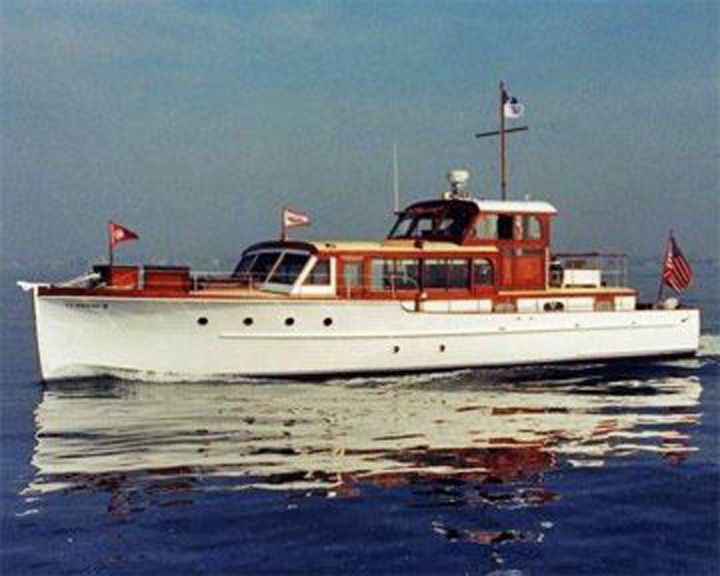 |
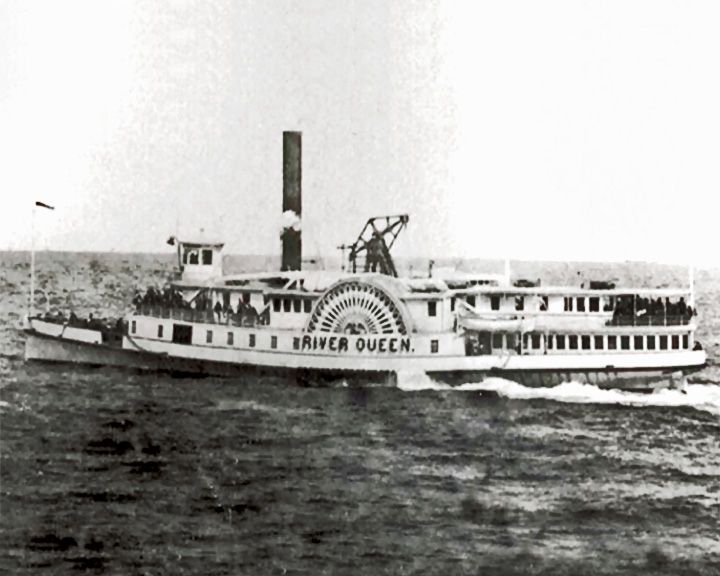 River Queen — American sidewheel steamer Closely associated with President Abraham Lincoln and General Ulysses S. Grant while operating on the Potomac River during the American Civil War. In March 1865, Abraham Lincoln met with his generals aboard the River Queen to discuss strategy for the end of the Civil War. LAUNCHED: 1864 → FATE: Burn to the water line in 1911, July |
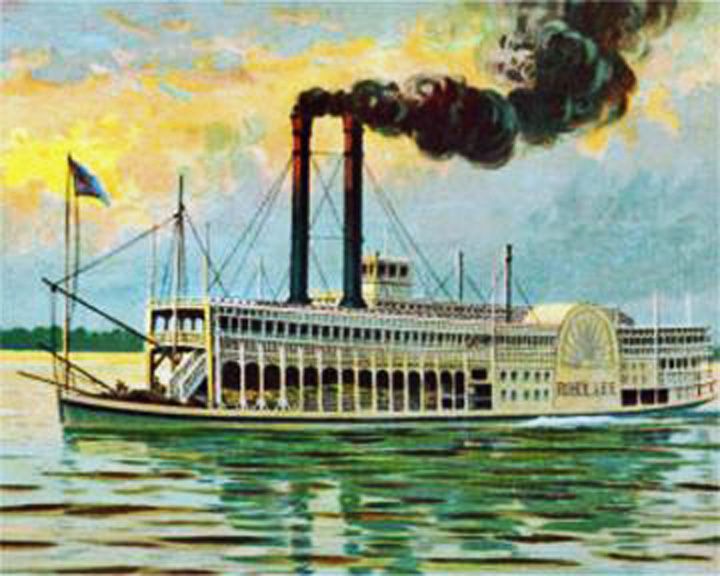 Robert E. Lee — American paddle steamboat, side-wheeler Won a steamboat race against the Natchez VI, going from St. Louis, Missouri to New Orleans, in 3 days, 18 hours and 14 minutes. The speed record still stands. A replica of the ship was built but it also burned in 2010. LAUNCHED: 1866 → FATE: Caught fire and lost north of New Orleans September 30, 1882. |
|
|
Page 46
|
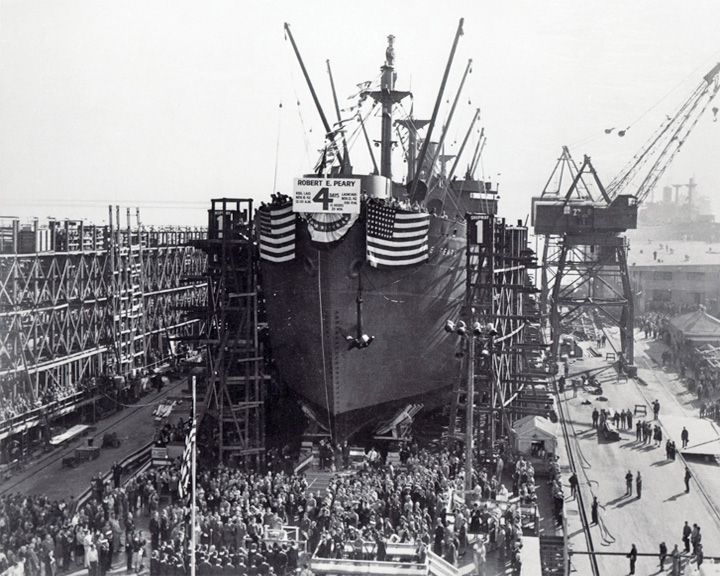 Robert E. Perry, SS — American liberty ship Gained fame during World War II for being built in the shortest time for such a large vessel. Typical completion of liberty ships took 50 days; she was completed in 4 days 15 hours and 29 minutes after the keel was laid down. LAUNCHED: 1942, November 12 → FATE: Scrapped at Baltimore, June 1963. |
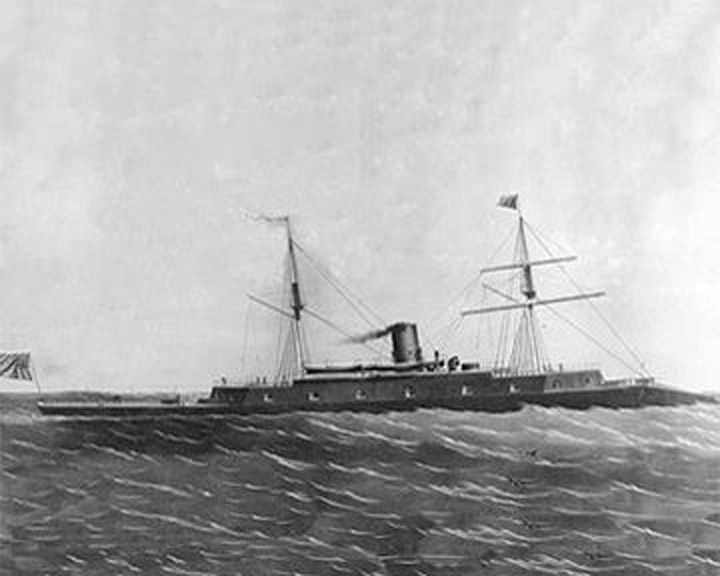 Rochambeau — American frigate, ironclad The longest wooden ship ever built. When the French thought Otto von Bismarck might be interested in the ship, they hurriedly bought her from the Americans and commission her in 1867. LAUNCHED: 1862, July 22 as Dunderberg → FATE: The French scrapped her in 1874. |
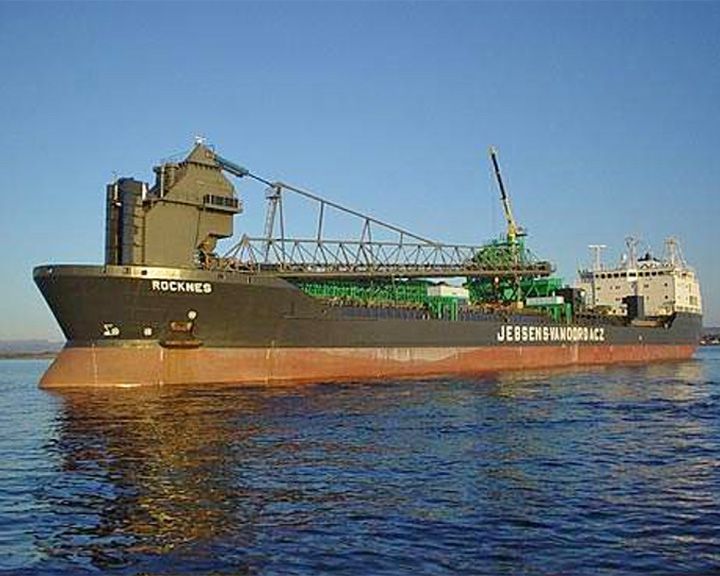 Rocknes, MV — Dutch rock dumping vessel, formerly a bulk carrier As the world's largest rock dumping vessel, her unexpected capsizing killed 18 of 30 crew. The tragedy was due to high center of gravity, uneven cargo loading, and a punctured hull after touching bottom. LAUNCHED: 2001 → FATE: She capsized in shallow water south of Bergen Norway January 19, 2004. She was to be righted and repaired. |
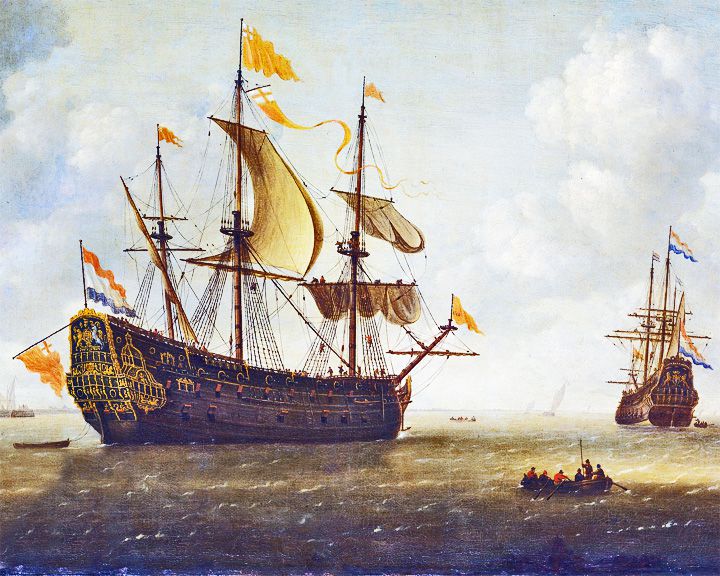 Royal Charles, HMS — British first-rate three-decker ship of the line During the English Restoration, she brought Charles II and his entourage from the Dutch Republic to England to reclaim his crown. At 1,229 tons, she was larger than Sovereign of the Seas, the first three-deck ship of the line. LAUNCHED: 1655, April 18 → FATE: Sold for scrap in 1673 by Dutch navy. |
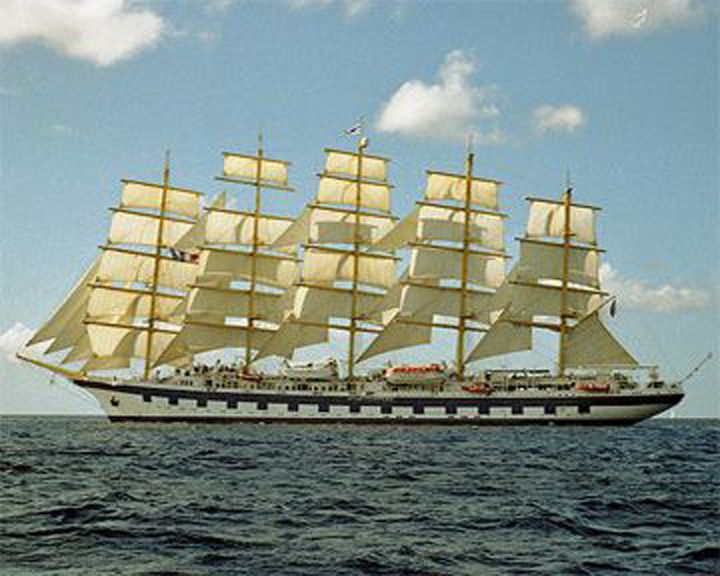 Royal Clipper — German tall ship; steel-hulled five masted fully rigged design The largest and only five-masted full-rigged sailing ship in service. Her design was based on the German ship Preussen, but was configured for passenger comfort rather than cargo carrying. LAUNCHED: 2001 → FATE: Still in service. |
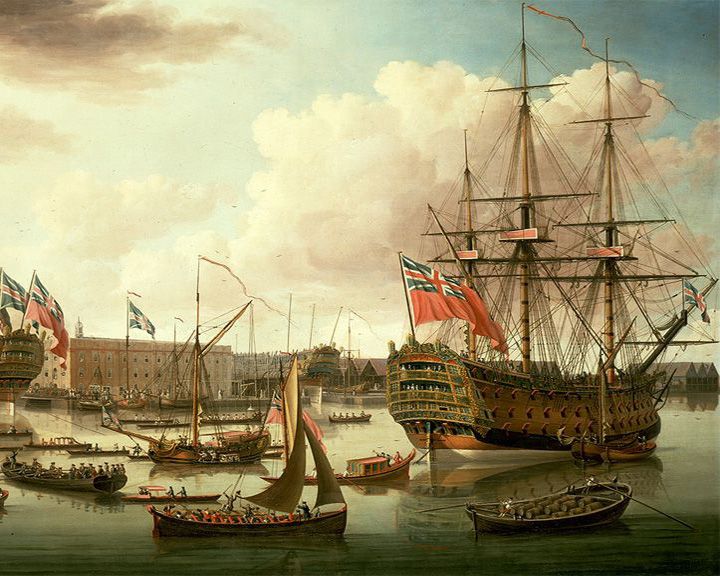 Royal George, HMS — English first-rate ship of the line One of the most serious maritime losses to occur in British water, sinking while undergoing routine maintenance taking more than 800 lives. She was the largest warship in the world at the time of launching. LAUNCHED: 1756, February 18 → FATE: Sank while anchored off Portsmouth August 29, 1782. |
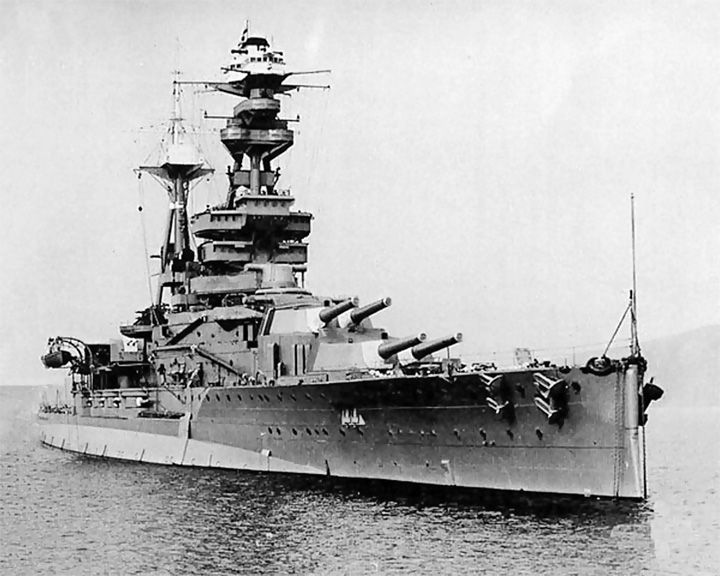 (Another (Another
Royal Oak, HMS — British Battleship, Revenge-class The first of five Royal Navy battleships and battlecruisers sunk in the World War II. When she was torpedoed, 835 of her 1,234 crew were killed. The brass letters of her name were removed from the sunken ship and are now displayed in the Scapa Flow visitor center. LAUNCHED: 1914, November 17 → FATE: Was sunk in Scapa Flow in October 1939 by a German U-boat, |
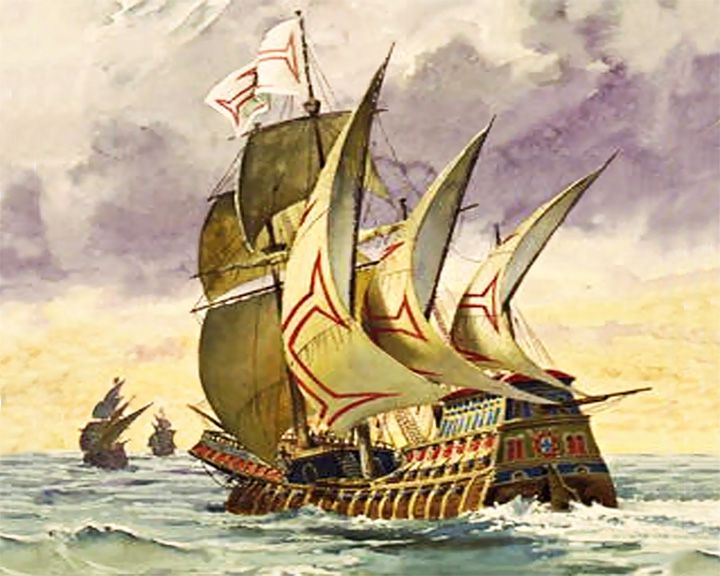 São Gabriel — Portugese caravel Flagship of Vasco da Gama's armada which carried the first Europeans to the coast of India. She, along with ships São Rafael, Bérrio, and São Miguel, made the round trip in two years. LAUNCHED: 1497 → FATE: Unknown. |
|
|
Page 47
|
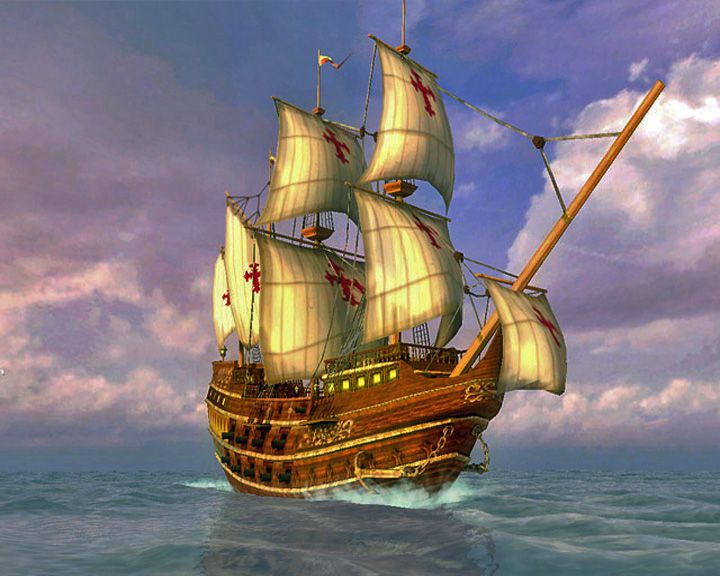 São Martinho — Portuguese galleon Flagship of Duke of Medina Sedonia, commander-in-chief of the Spanish Armada. In September 1588, she was among the few Armada ships to make it back to the port city of Santander, Spain, after suffering heavy damage by English ships. LAUNCHED: 1580 → FATE: 1589 perhaps. |
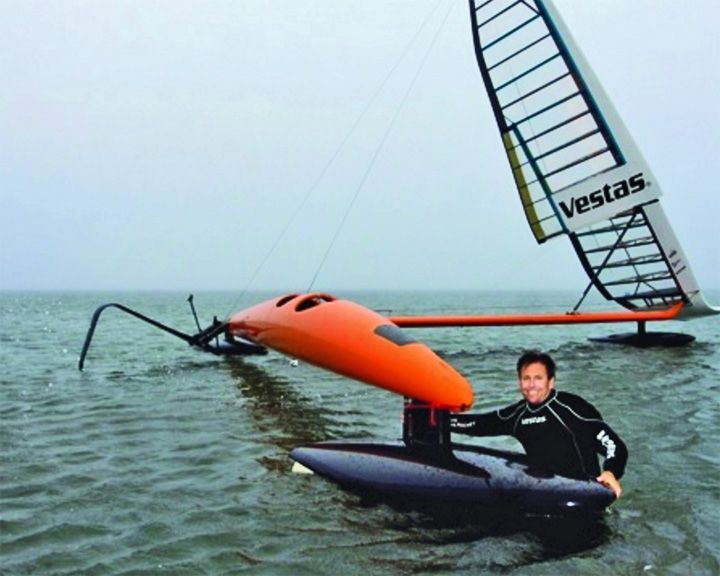 Sailrocket 2 — Australian speed sailboat Built to capture the class D sailing speed record, piloted by the project leader Paul Larsen at 65.45 knots in Walvis Bay, Namibia. In 2008, before crashing, the first Sailrocket reached a reported unofficial speed of 52.22 knots. LAUNCHED: 2011, March → FATE: Still racing. |
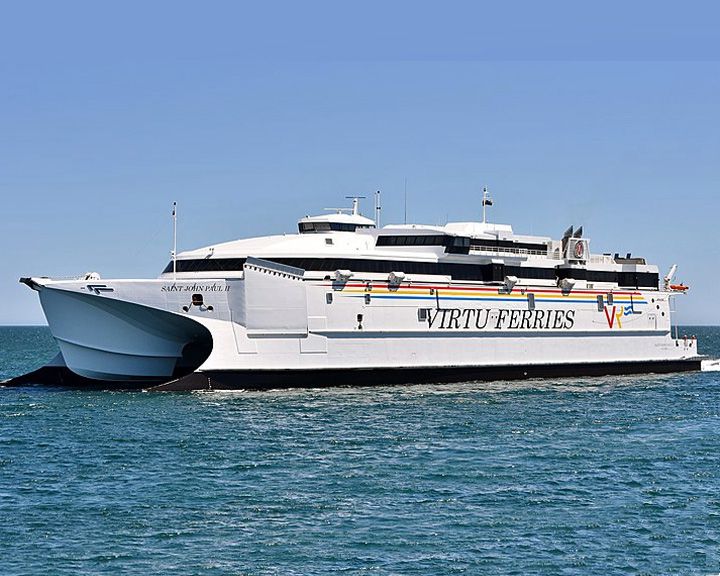 Saint John Paul II, MV — Maltese catamaran ferry The largest high-speed catamaran in the Mediterranean Sea and the second largest in the world as of 2020. Her service speed is approximately 37 knots, or 69 km/h (43 mph). She is operated by Virtu Ferries. LAUNCHED: 2018, December 22 → FATE: Still in operation. |
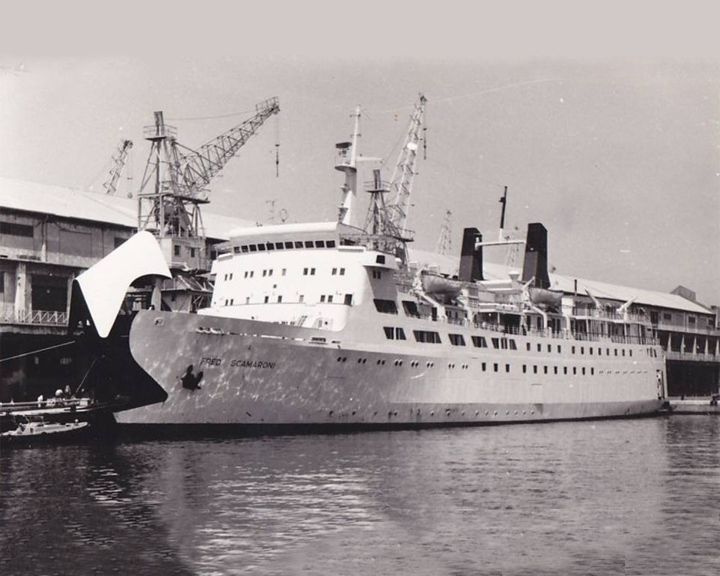 Salem Express, MV — French roll-on/roll/off car ferry She sank after colliding with reefs while carrying hundreds of Egyptian pilgrims. More than 500 passengers and crew were lost. The sunken wreck is in good condition although coral covers much of the ship. The wreck still contains cars and luggage. LAUNCHED: 1966 → FATE: Sank after collision on the Egyptian coast December 17, 1991. |
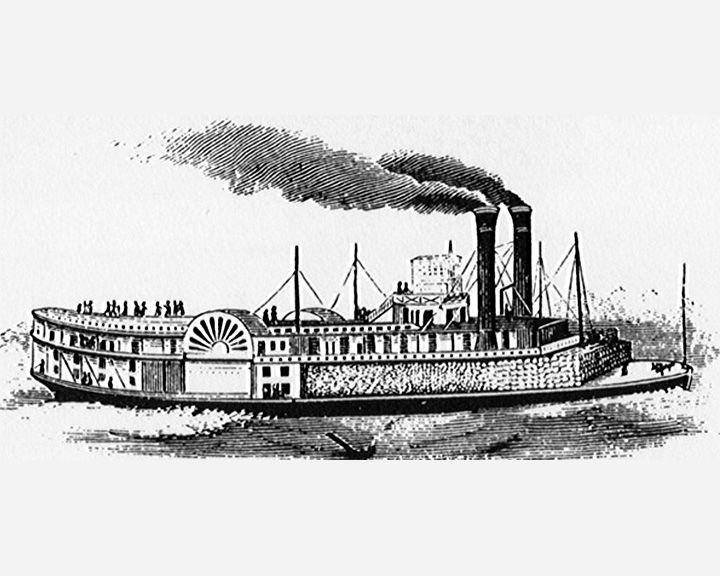 Saluda — American river paddle steamboat, side-wheeler Worst river steamboat accident in US; a tragedy for the Mormon Church. Over 100 passengers out of 175 were killed, including 28 Mormons. There were several dozen survivors. LAUNCHED: 1846, (sunk in 1847, raised and repaired) → FATE: Boilers exploded and destroyed the boat on the Missouri River near Lexington, Missouri, she sank April 9, 1852. |
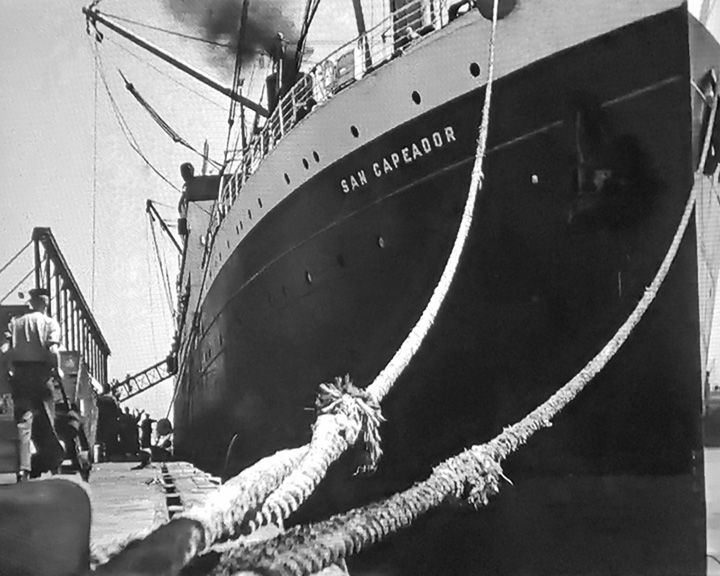 San Capador, SS — American cruise ship Backdrop for the movie Captain Hates the Sea, a 1934 comedy film showing a series of intertwining stories involving the passengers on a cruise ship. The exterior footage of the ship would be seen again in the Three Stooges short Dunked in the Deep. LAUNCHED: 1934, movie release → FATE: Inconclusive. |
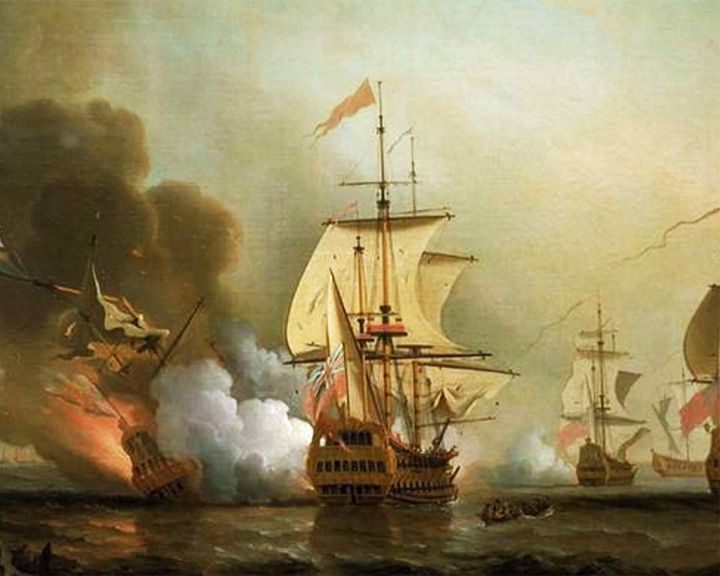 San José — Spanish galleon,60-gun Sunken treasure ship with 7 to 10 million Spanish pesos on board. She was discovered in 2015 with treasure estimated to be worth between 4-17 billion US dollars. LAUNCHED: 1696 → FATE: Sunk in battle off the coast of Cartagena, Colombia in 1708. |
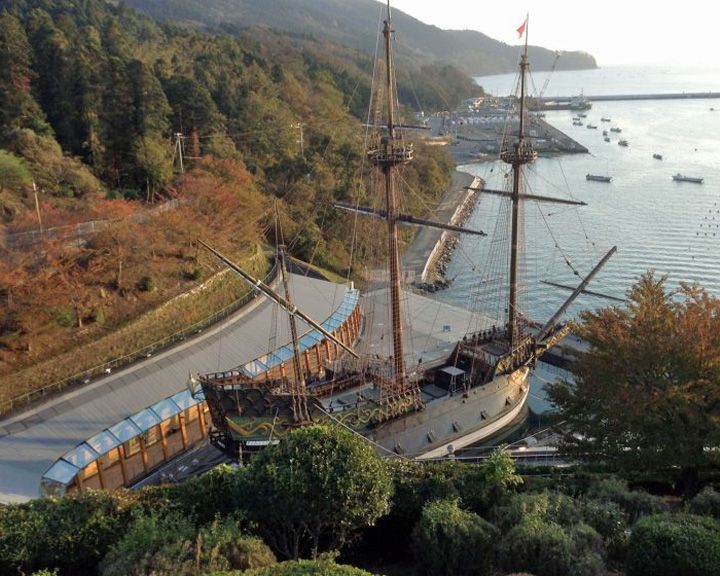 San Juan Bautista — Japanese galleon One of Japan's first Japanese-built Western-style sailing ships. She crossed the Pacific in 1614 transporting a Japanese diplomatic mission to the Vatican. By 1619, then owned by Spain, she was a slave ship. A full sized replica of the San Juan Bautista is the centerpiece of museum in Ishinomaki, Japan. LAUNCHED: 1613, September → FATE: Unknown |
|
|
Page 48
|
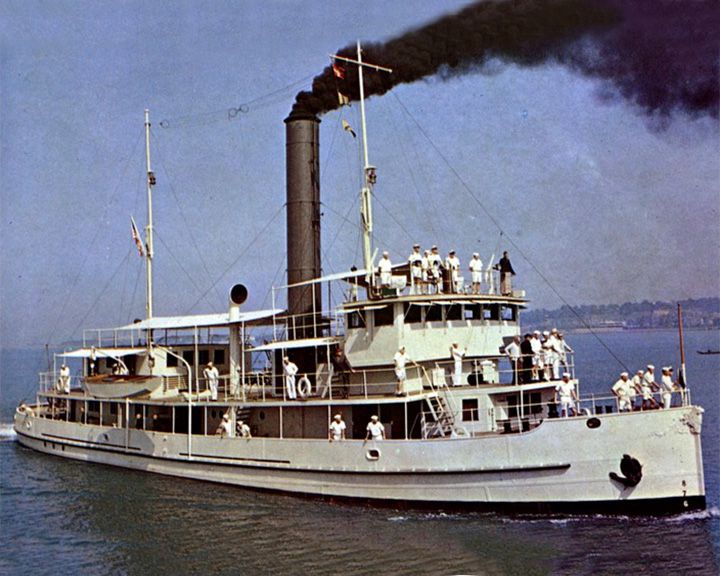 San Pablo — American gunboat Featured in the movie Sand Pebbles starring Steve McQueen. After filming was completed, she was sold and renamed the Nola D, received significant modifications, and eventually used as a base camp for a seismic exploration company. LAUNCHED: 1966, movie release; actual ship September, 1895 → FATE: As the Nola D, she was taken to Singapore and scrapped in 1975. |
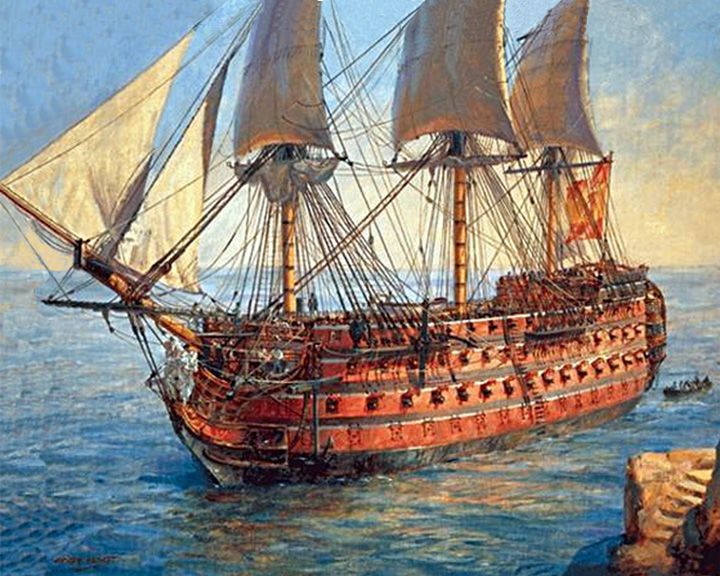 (Another (Another Santísima Trinidad — Spanish ship of the line, first-rate After refitting in 1804, the largest and heaviest-armed ship in the world with 140 guns on four decks. A full-size representation in on display in the harbour of Alicante, Spain as shown in "Another IMAGE". LAUNCHED: 1768 → FATE: Sank at the Battle of Trafalgar in October of 1805. |
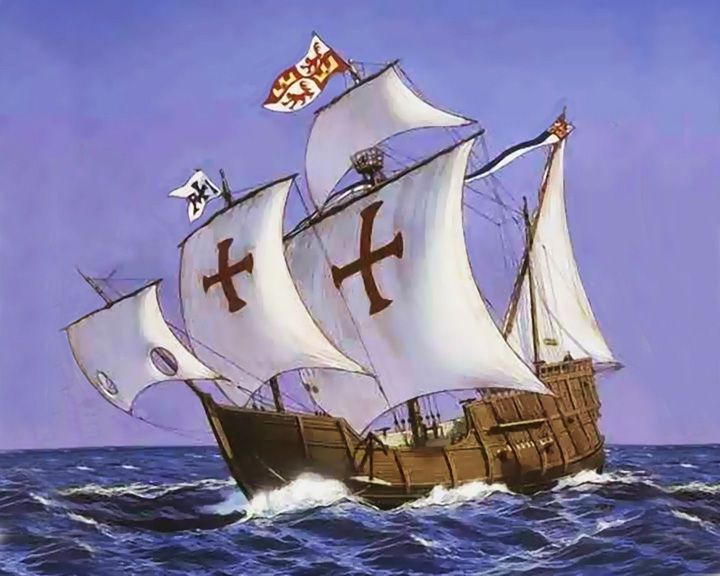 Santa Maria — Spanish carrack The largest of Columbus' ships of discovery. The anchor of the Santa María now resides in the Musée du Panthéon National Haitien, in Port-au-Prince, Haiti. LAUNCHED: 1460, circa → FATE: Ran aground and lost near Cap-Haitien, Haiti, December 25, 1492. |
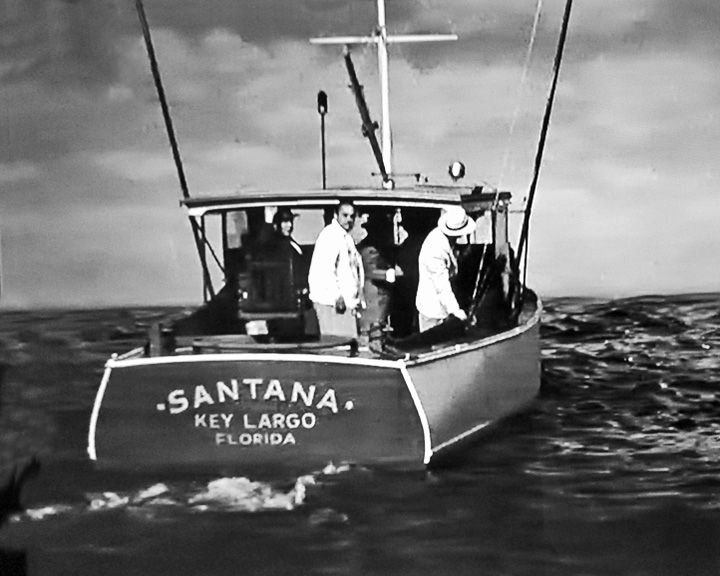 Santana — American commuter yacht The boat in the 1948 movie Key Largo, starring Humphrey Bogart. The boat used in the movie, with Bogart's character at the helm, was the name of Bogart's personal sailing yacht. LAUNCHED: 1926, probably → FATE: Unknown. |
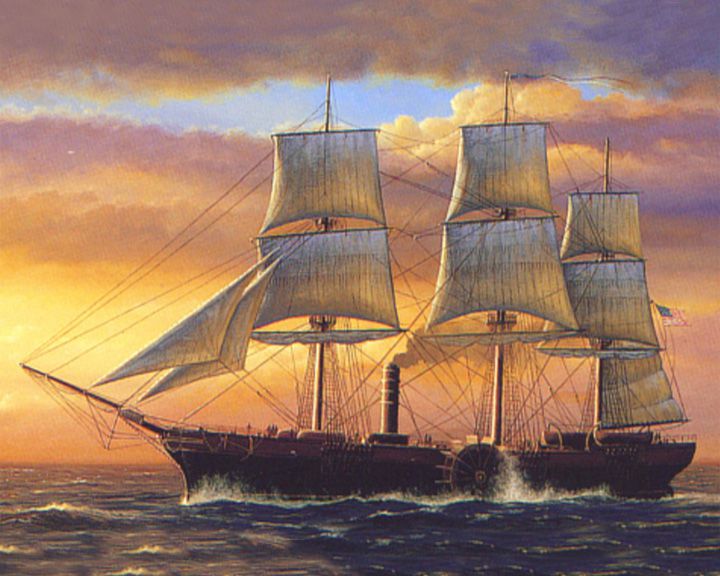 Savannah, SS — American paddle steamship, side-wheeler with sails First steamship to cross the Atlantic Ocean. After ocean crossing, her steam plant was removed and she continued sailing up and down the east coast. LAUNCHED: 1819, March → FATE: Ran aground off Long Island, NY in 1823. |
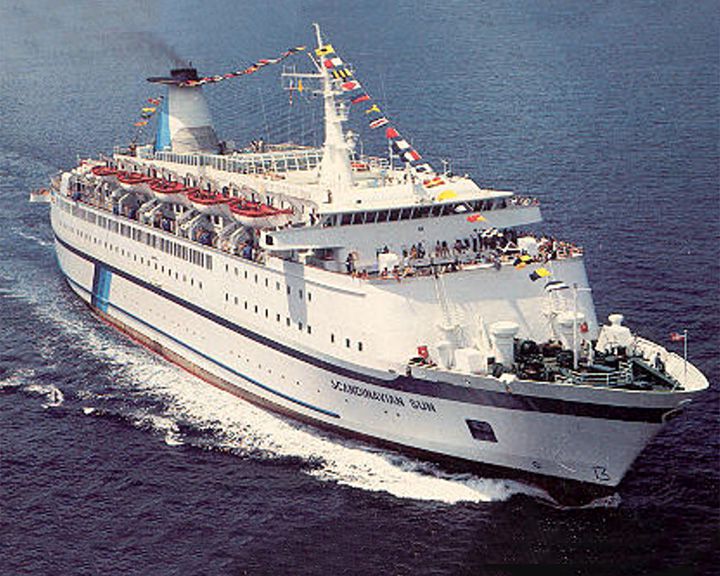 (Another (Another Scandinavian Star, MS — Scandinavian ferry for cars and passengers The ship was set on fire by an arsonist in 1990, killing 159 people. She had at various times the names of MS Massalia, Stena Baltica, Island Fiesta, Scandinavian Star, MS Candi, MS Regal Voyager, and finally MS Regal V. LAUNCHED: 1971, January 18 → FATE: As MS Regal V, she was broken up and scrapped May, 2004. |
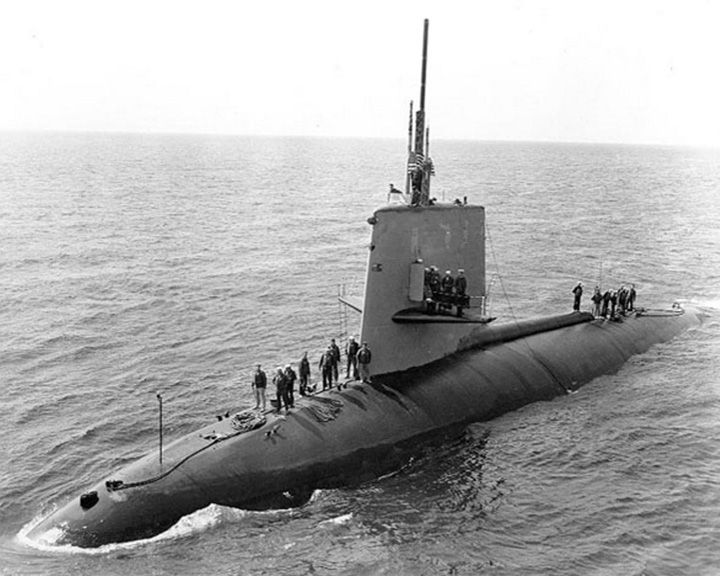 Scorpion, USS — American Skipjack-class nuclear submarine Went missing at sea with 99 crewmen, one of two nuclear submarines the U.S. Navy has lost, the other being USS Thresher (SSN-593). She carried two nuclear-tipped torpedoes. In November 2012, the submarine veterans asked the US Navy to reopen the investigation on the sinking. LAUNCHED: 1959, December 18 → FATE: Sank on May 22, 1968 in the Atlantic Ocean southwest of the Azores. |
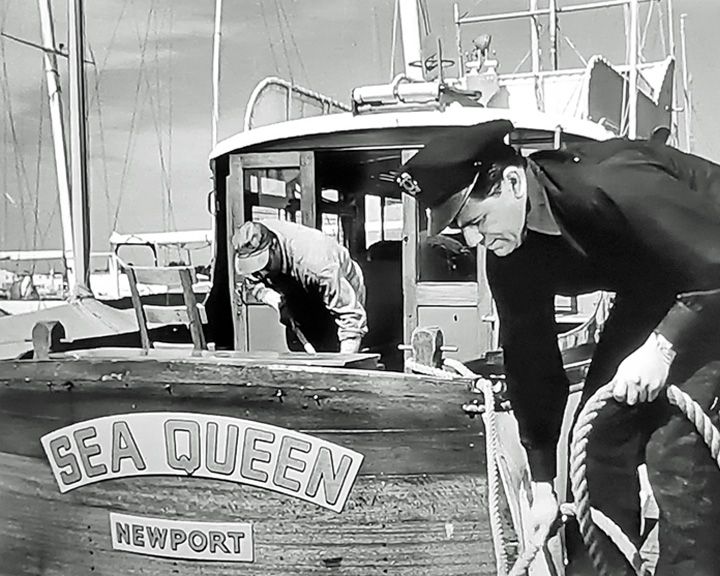 Sea Queen — American sport-fishing boat Boat at the center of the movie The Breaking Point. This movie was based on Ernest Hemingway's novel To Have and Have Not which was made into an earlier movie with the same title, but in which the boat is called Queen Conch LAUNCHED: 1950 → FATE: Inconclusive. |
|
|
Page 49
|
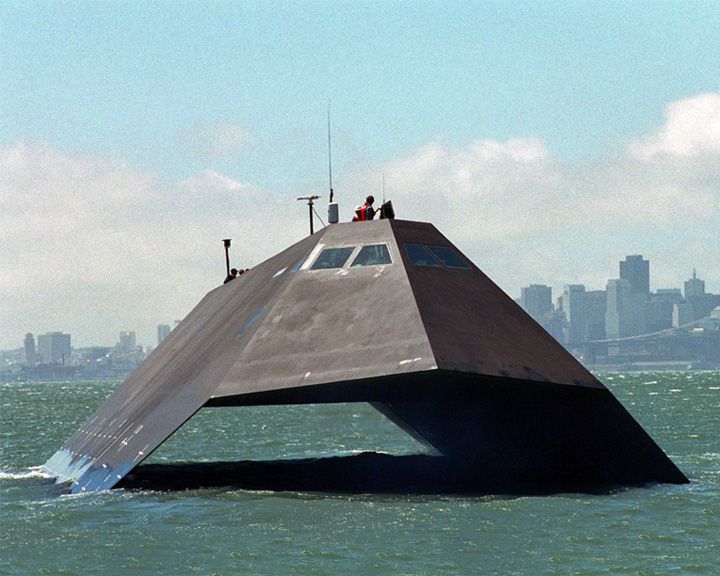 Sea Shadow — American stealth warship U.S. Navy experimental stealth ship, never intended to be mission capable and never commissioned. The ship was the inspiration for the stealth ship in the James Bond movie Tomorrow Never Dies. LAUNCHED: 1985, March → FATE: As of June, 2011 the ship is still being stored at Suisun Bay in northern California awaiting its fate. |
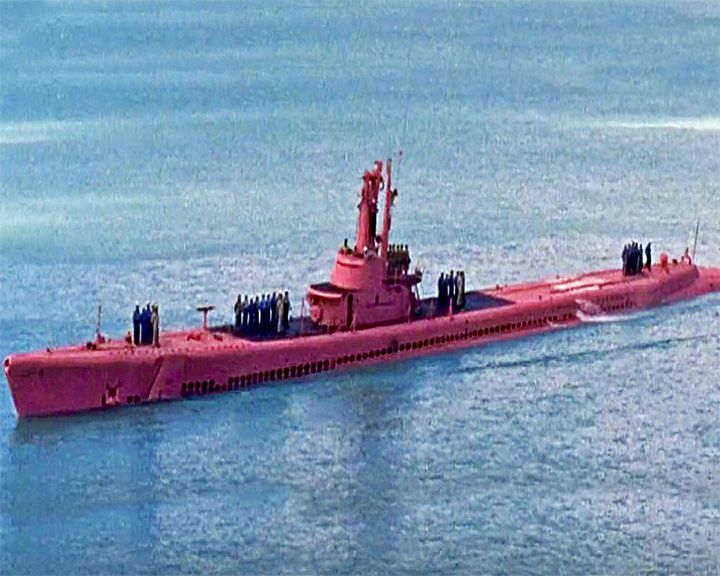 (Another (Another Sea Tiger, USS — American submarine A fictional U.S. Navy submarine in the 1959 movie Operation Petticoat during the opening days of World War II. Stand-in boats were USS Balao painted pink for exterior shots and USS Archerfish with the standard colors of gray and black for interior and some exterior shots. LAUNCHED: 1959 → FATE: Inconclusive. |
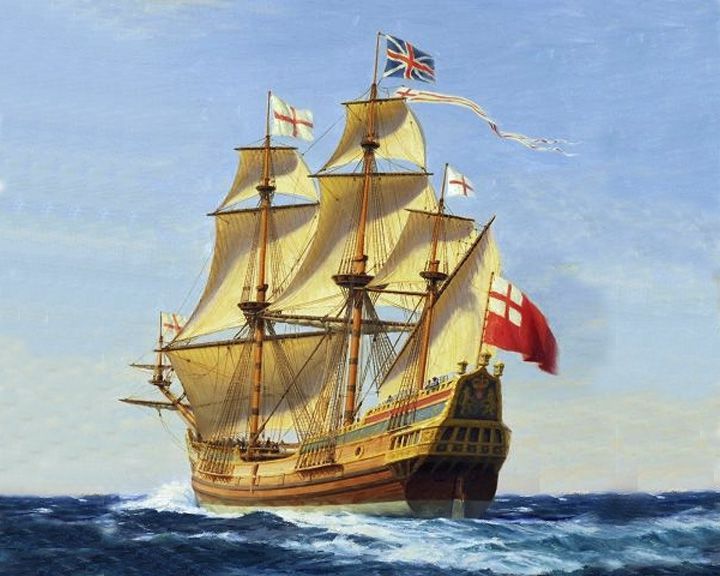 Sea Venture — English merchant ship; purpose-built First dedicated emigration ship as part of the Third Supply mission to the Jamestown Colony. During the storm, massive leaks developed because of faulty construction. All 150 people aboard and one dog made it to shore safely. LAUNCHED: 1609 → FATE: Damaged in a hurricane and scuttled at Discovery Bay, June 1609. |
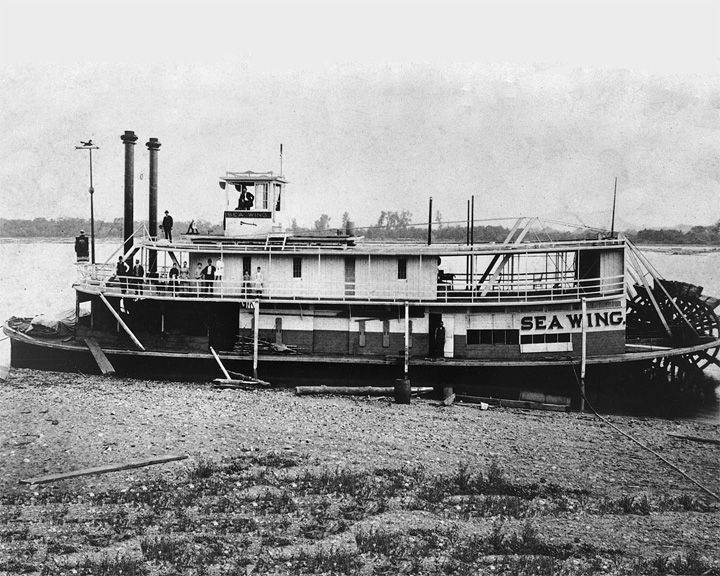 Sea Wing — American paddle steamer One of the worst maritime disasters that has occurred on the upper Mississippi River with 98 passengers drowned. Shortly after leaving Lake City on the excursion return trip, a violent storm broke and capsizing the steamer. LAUNCHED: 1888 → FATE: Sunk in July 13, 1890. Later recovered and rebuilt. |
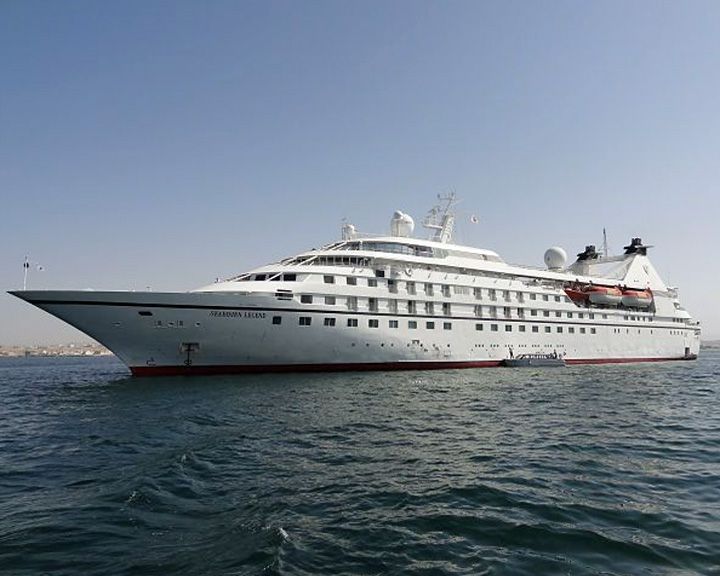 Seaborn Legend — American cruise ship The ship in the movie Speed 2: Cruise Control; starring Sandra Bullock. The plot has a couple on vacation to the Caribbean aboard a luxury cruise ship which is hijacked by a villain. LAUNCHED: 1997, for movie relase; ship launched in 1991. → FATE: Ship is still in service as Star Legend. |
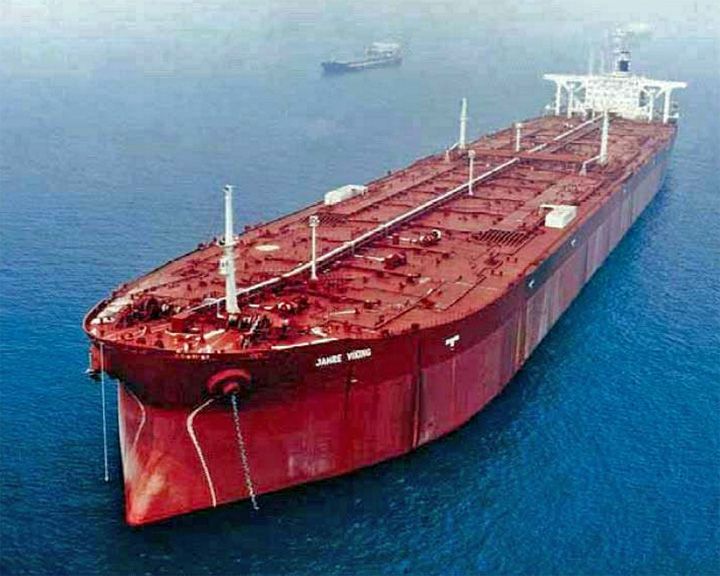 Seawise Giant — Japanese supertanker, variously owned Longest ship ever built at 458.46 meters or 1,504 feet. She was damaged during the Iran-Iraq War by an Iraqi Air Force in the Strait of Hormuz in May 1988. LAUNCHED: 1979 → FATE: Scrapped in January of 2010. |
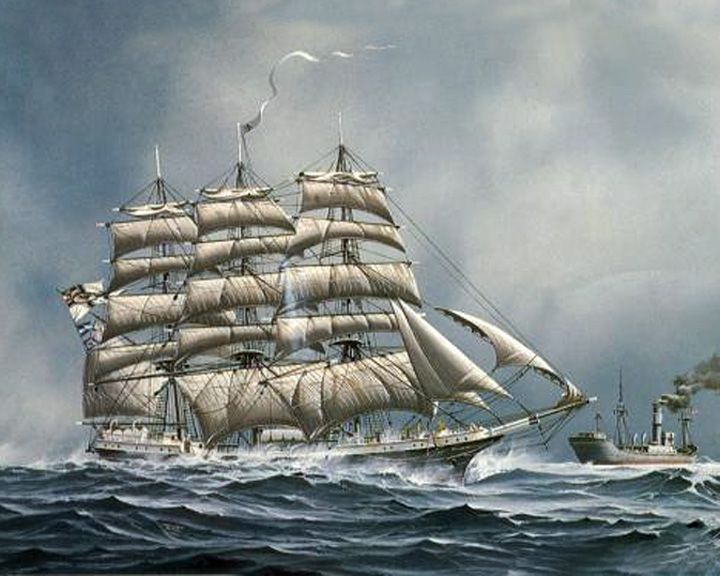 Seeadler, SMS — Scottish windjammer, three-masted; American owned One of the last sailing ships used in a war; as a German merchant raider disguised as a Norwegian wood carrier. she was originally named Pass of Balmaha before capture by a German submarine. LAUNCHED: 1888 → FATE: Wrecked on a reef at the island of Pacific, August 2, 1917. |
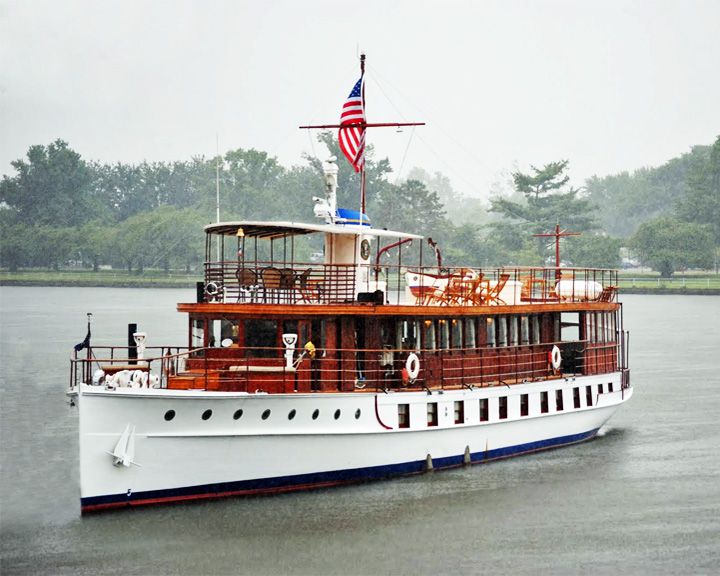 Sequoia, USS — American yacht, 104-foot wooden Served as the U.S. presidential yacht from 1933 until it was sold in 1977. She was purchased in 1931 by the U.S. Department of Commerce for Prohibition patrol and decoy duties. LAUNCHED: 1926 → FATE: Refurbished many time; now privately owned. |
|
|
Page 50
|
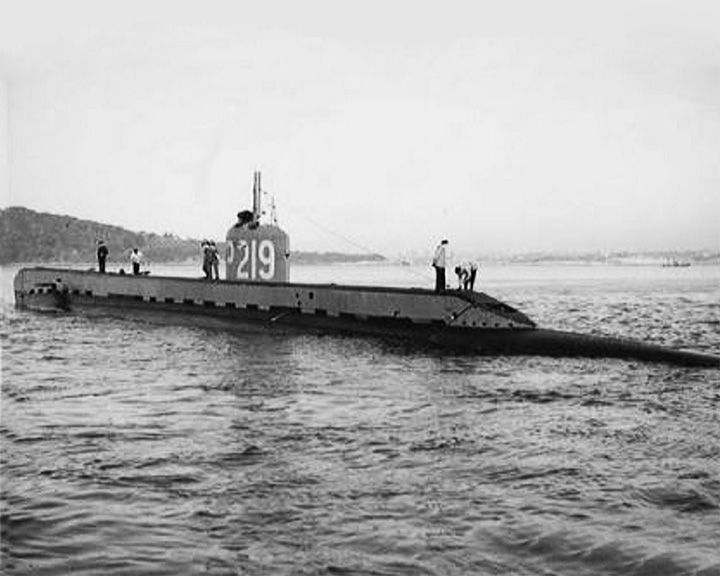 Seraph, HMS — British submarine Known as "the ship with two captains," briefly became the USS Seraph. During World War II, she released a corpse ("The Man Who Never Was") onto the shores off Gibraltar carrying decoy papers to fool the Nazis as part of "Operation Mincemeat." LAUNCHED: 1941, October 18 → FATE: Scrapped in December of 1962. |
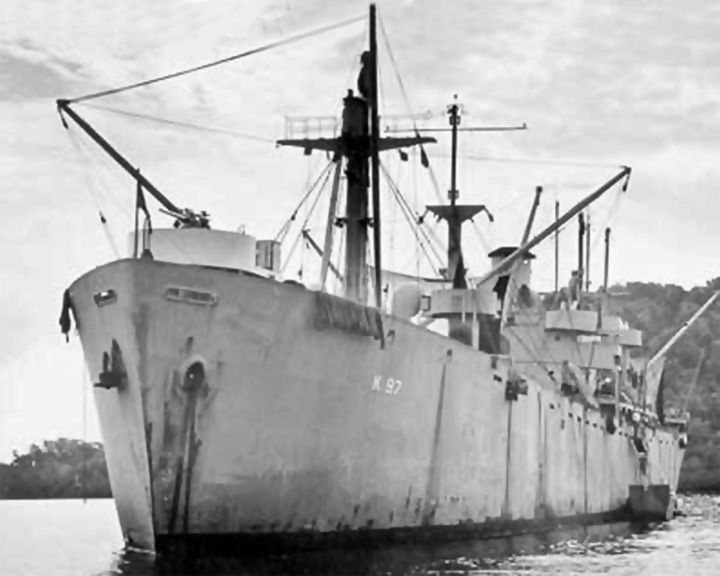 Serpens, USS — American Crater-class cargo ship The most catastrophic single-event loss of life in the history of the U.S. Coast Guard with 250 casualties. In the explosion, a 12-ton locomotive, the wooden pier it sat on, and 16 boxcars loaded with bombs and ammunition disappeared completely. LAUNCHED: 1943, April 5 → FATE: Exploded in complete destruction January 29, 1945, on the coast of Guadalcanal. |
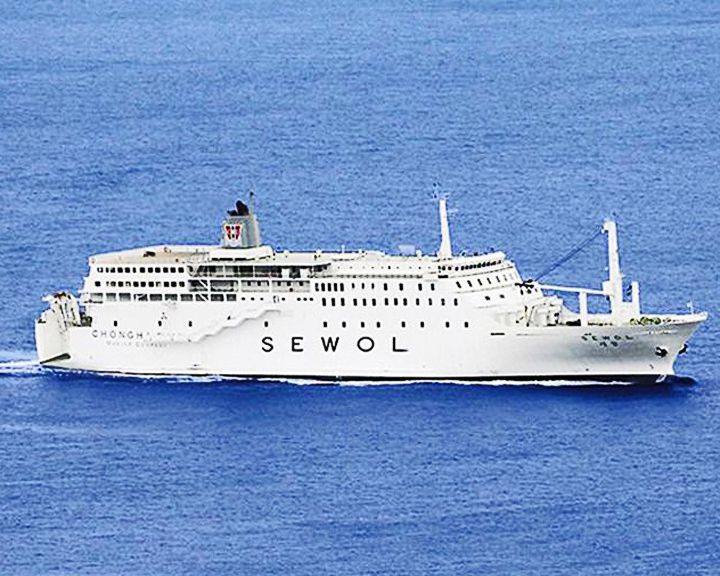 (Another (Another |
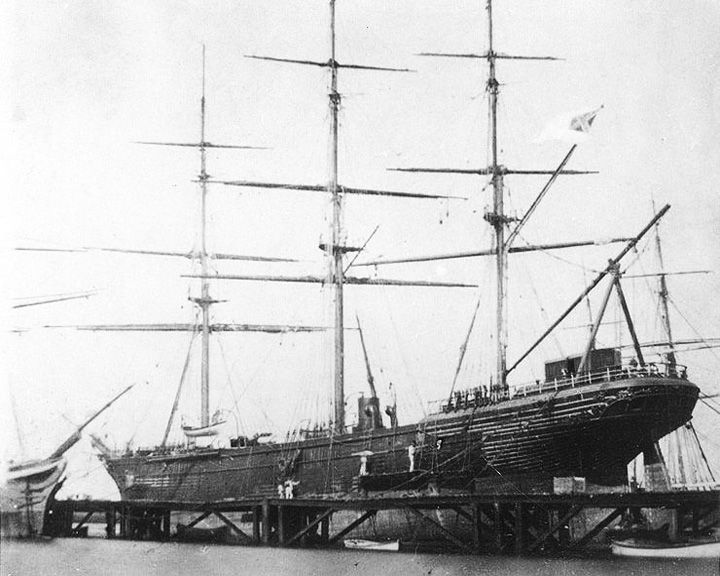 Shenandoah, CSS — American Confederate full-rigged ship, iron-clad During the US Civil War, she captured and/or sank 38 Union merchant vessels. She fired the last shot of the Civil War off the Aleutian Islands, then was surrendered to the British. She was sold to Majid bin Said, the first Sultan of Zanzibar who renamed her El Majidi after himself. LAUNCHED: 1863, August 18 → FATE: As El Majidi, beached during hurricane near Zanzibar in 1872. |
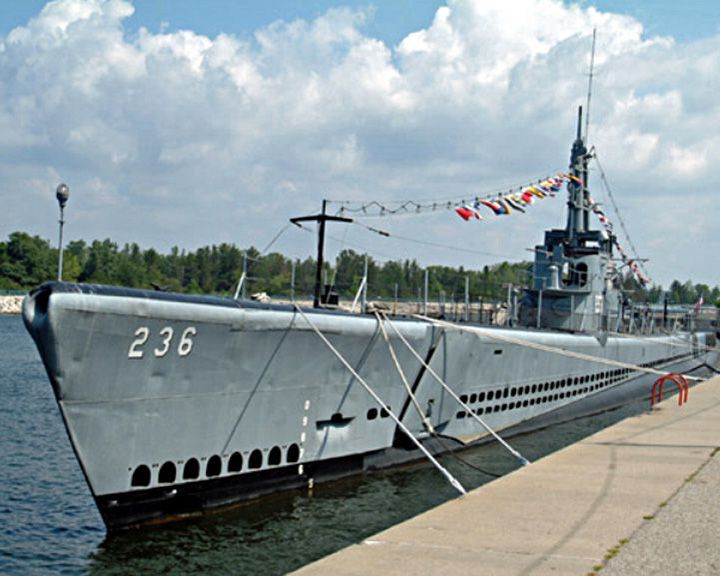 Silversides, USS — American Gato-class submarine One of the most successful submarines in the Pacific Theater of World War II, with 23 sinkings totalling more than 90,000 tons. She was used to depict the fictional submarine USS Tiger Shark in the 2002 film Below LAUNCHED: 1941, August 18 → FATE: Currently serves as a museum ship at the USS Silversides Submarine Museum in Muskegon, Michigan, and is a National Historic Landmark. |
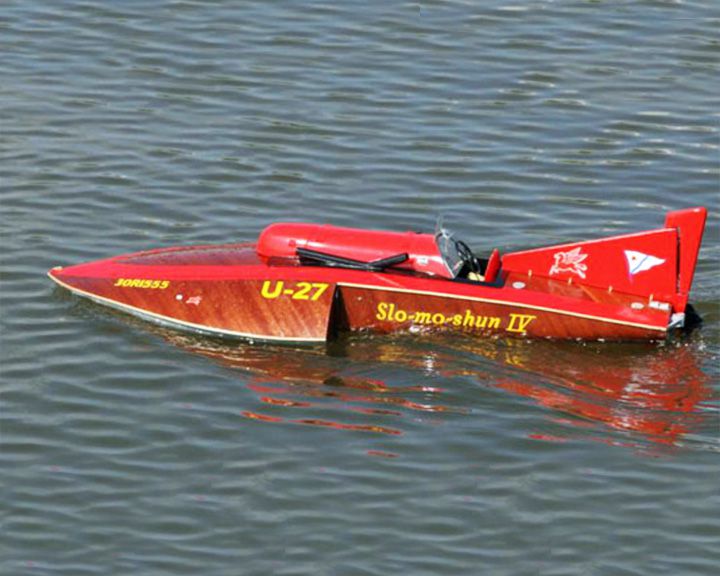 Slo-mo-shun IV — American racing hydroplane Winner of the 1950, 1952, and 1953 APBA Gold Cup Races; also set two straightaway speed records. Her hull was designed to lift the top of the propellers out of water at high speed, a technique called “prop riding,” which reduced drag. LAUNCHED: 1949, October → FATE: Wrecked in a pre-race test run in 1956; rebuilt and on exhibit at Seattle's Museum of History and Industry. |
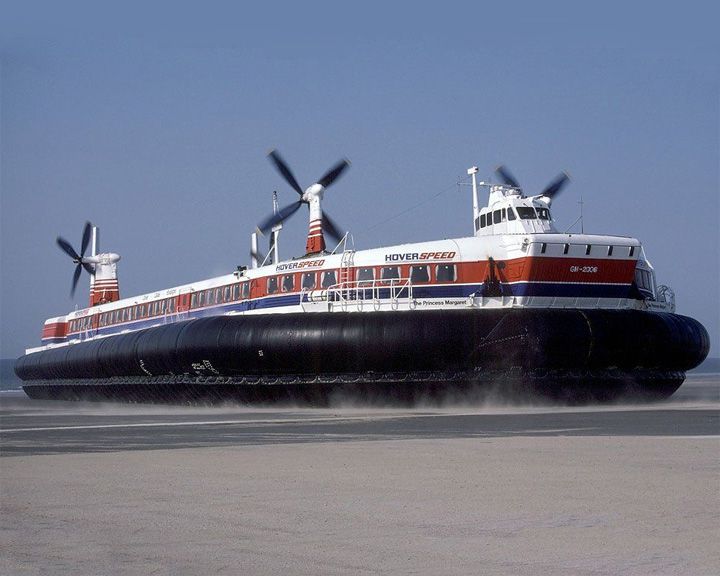 SN.R4 — British Mountbatten class hovercraft Was the largest civil hovercraft ever built, carrying 254 passengers and up to 30 cars. She is the only surviving hovercraft that served English Channel traffic from 1968 to 2000. The others, Sir Christopher, Sure, Swift, Princess Margaret, and The Prince of Wales, were all scrapped. LAUNCHED: 1968 → FATE: Preserved and on static display at the Hovercraft Museum at Lee-on-Solent, England. |
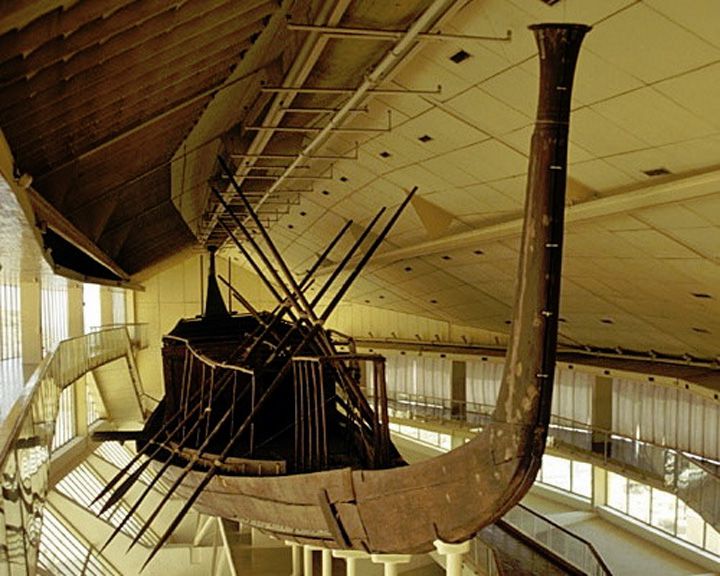 Solar Bark — Egyptian barge, or bark; Ancient funeral The world's oldest intact ship; built for Khufu, King Cheops. She was discovered in 1954 sealed into a pit at the foot of the Great Pyramid of Giza. LAUNCHED: 2500, BC, circa → FATE: On display in a museum at the Giza pyramid complex since 1982. |
|
|
Page 51
|
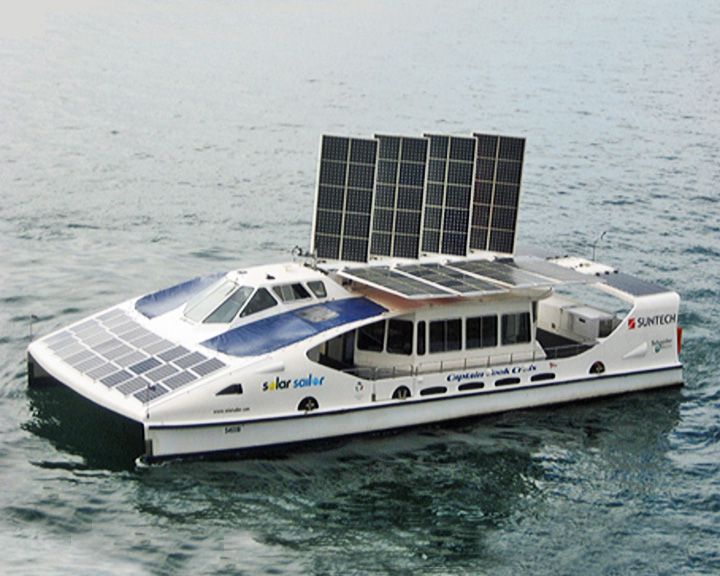 Solar Sailor — Australian passenger ferry First vessel to be efficiently powered by both wind and sun. She was a unique hybrid ferry propelled by solar or wind energy, battery, or diesel. LAUNCHED: 2000 → FATE: Currently operating in Sydney Harbour. |
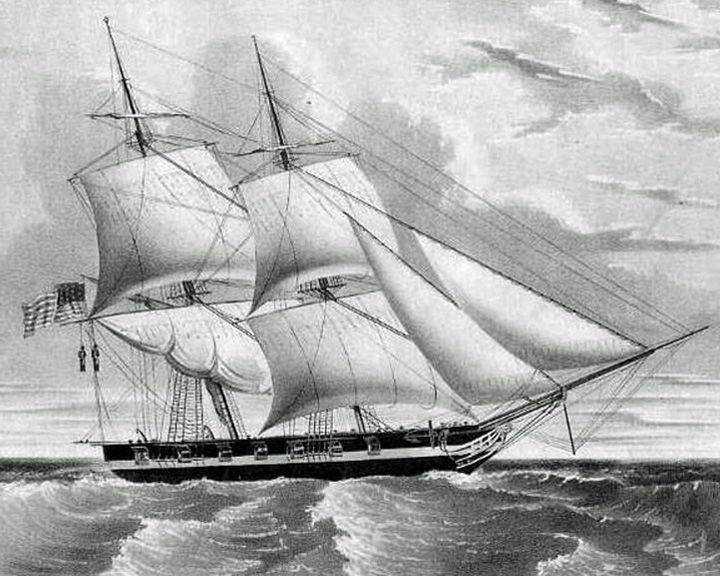 Somers, USS — American brig The only U.S. Navy ship upon which a conspiracy of mutiny took place. Known as the "Somers Affair", it was the basis for several books and dramatizations. December 1, 1842, three of the mutineers who intended to take over the ship and use it for piracy were found guilty of "intention to commit a mutiny," hanged and buried at sea. LAUNCHED: 1842, May 18 → FATE: Capsized and foundered in a sudden squall off Vera Cruz December of 1846. |
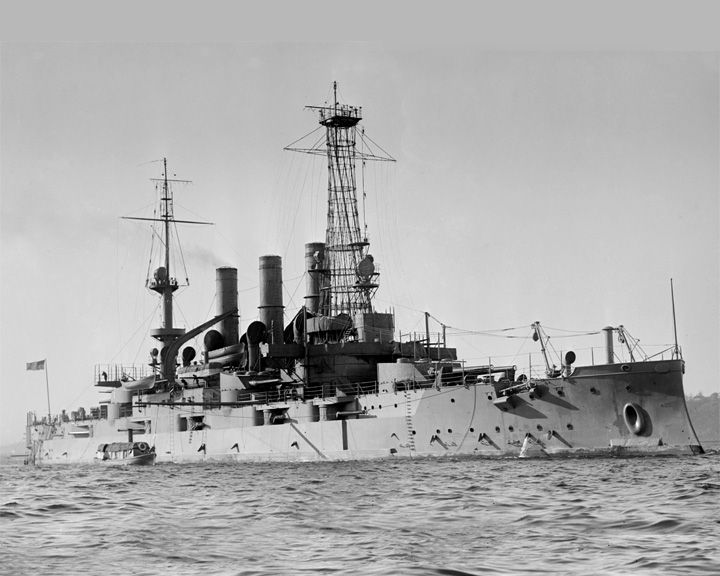 South Carolina, USS — American dreadnought, battleship The first American dreadnought and the first of any nation to have its main guns in a superfire arrangement. She was part of America's Great White Fleet that circumnavigated, December of 1907 to February of 1909. LAUNCHED: 1908, July 18 → FATE: Sold for scrap on April of 1924. |
 Sovereign of the Seas, HMS — English full-rigged warship The most extravagantly decorated warship in the early Royal Navy. She was armed with 102 bronze guns at the insistence of the king, Charles I of England. LAUNCHED: 1637, October 18 → FATE: Burnt to the water line January 27, 1697. |
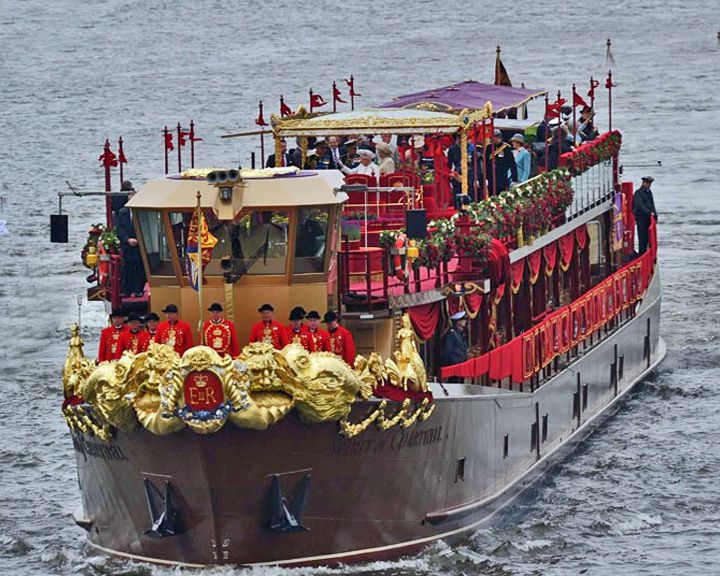 (Another (Another Spirit of Chartwell, MV — English hotel barge The Royal Barge used for Queen Elizabeth II's Diamond Jubilee, June 3, 2012. She originally sailed the Rhine River as the Van Gogh, designed to sail the waterways of Europe and venture into coastal waters. She was refitted in for the 2011 jubilee. LAUNCHED: 2009 → FATE: Still afloat. |
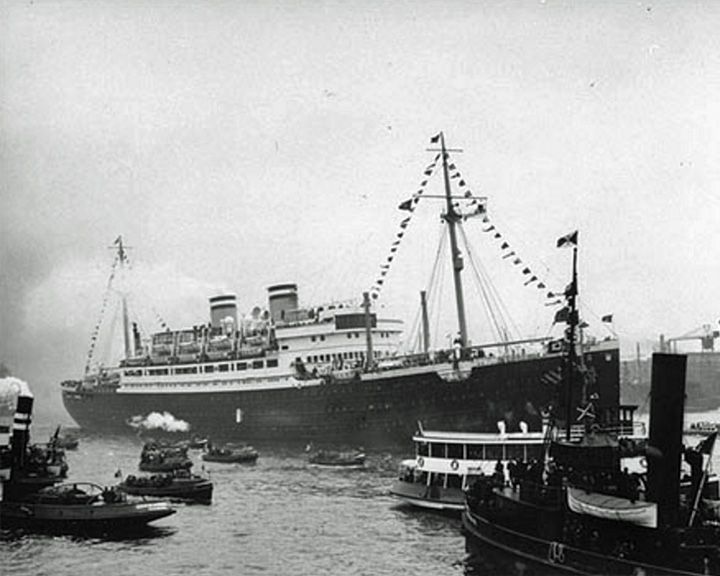 St. Louis, SS — German ocean liner In 1939, her captain, Gustav Schröder, tried to find homes for 937 German Jewish refugees after denied entry to Cuba. She was the subject of a 1974 book, Voyage of the Damned, and adapted for a 1976 movie of the same name. LAUNCHED: 1928, August 18 → FATE: Scrapped in Hamburg, Germany, 1952. |
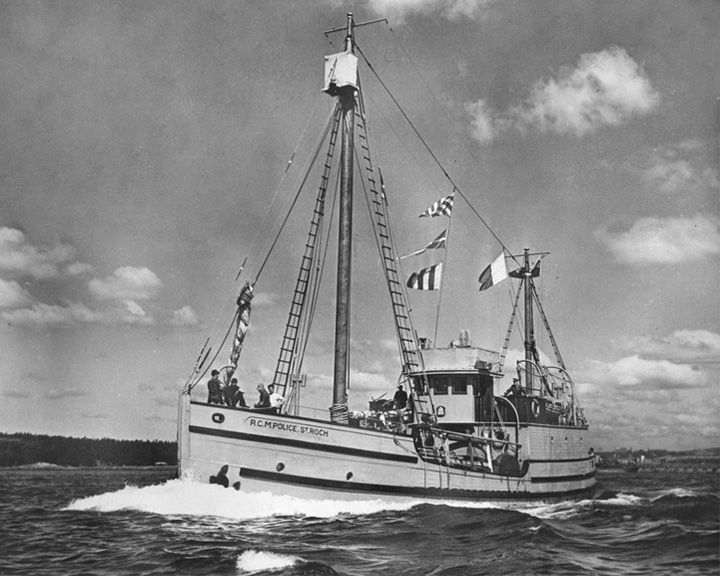 St. Roch — Canadian schooner The first ship to completely circumnavigate North America, and first to complete passage through the Northwest Passage west to east. She was also the first vessel to pass through the more northerly route of the Northwest Passage, and was also the first to navigate the passage in a single season. LAUNCHED: 1928, May 18 → FATE: On exhibit at the Vancouver Maritime Museum. |
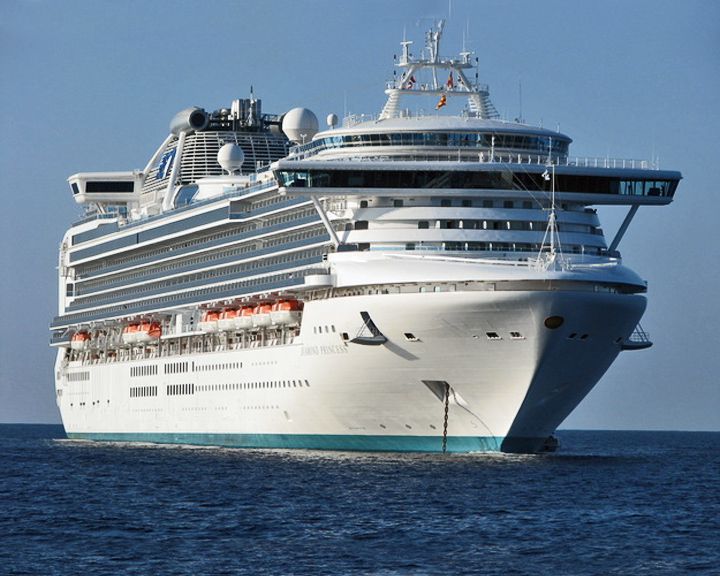 (Another (Another Star Princess — Italian cruise ship; American-British owned Fire amidship produced smoke, killing one passenger and injuring 13 others. With the fire initiated, highly combustible polycarbonate partitions, polyurethane deck tiles, and the plastic furniture produced large amounts of thick black smoke. LAUNCHED: 2001, May 18 → FATE: Damage repaired and still in service. |
|
|
Page 52
|
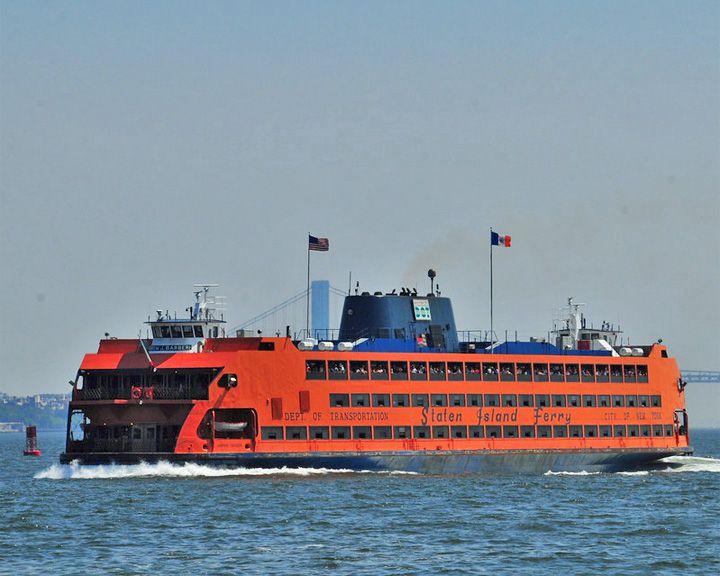 Staten Island Ferry — American passenger ferry boats A fleet of eight ferry boats sailing free of charge between Manhattan and Staten Island in New York. On October 15, 2003, the Andrew J. Barberi collided with a pier killing eleven people and injuring many others; NYC's deadliest mass-transit incident in 50 years. LAUNCHED: 1819 → FATE: Still in service. |
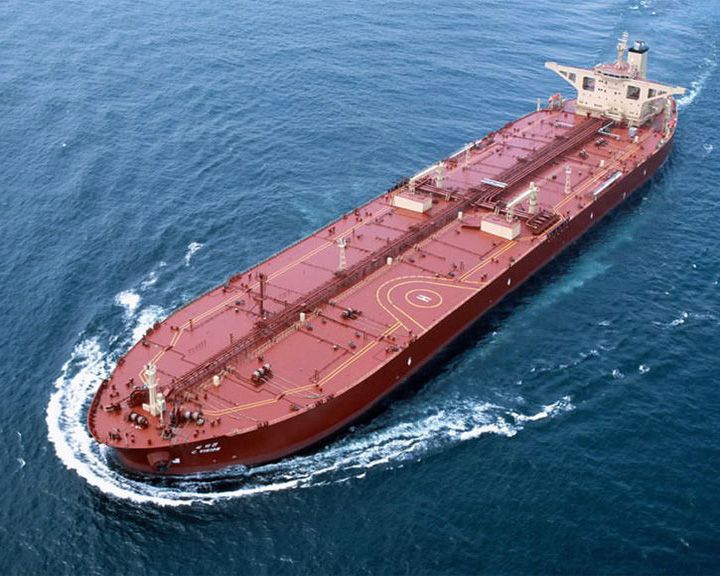 Stellar Daisy — South Korean very large oil carrier, VLOC. Converted in 2006 to ore carrier Demonstrated that ore-carriers converted from oil tanker are prone to disaster. Two crew survived, 22 lost at sea. LAUNCHED: 1993, February 18 → FATE: Sank off the coast of Uruguay on March 31, 2017. |
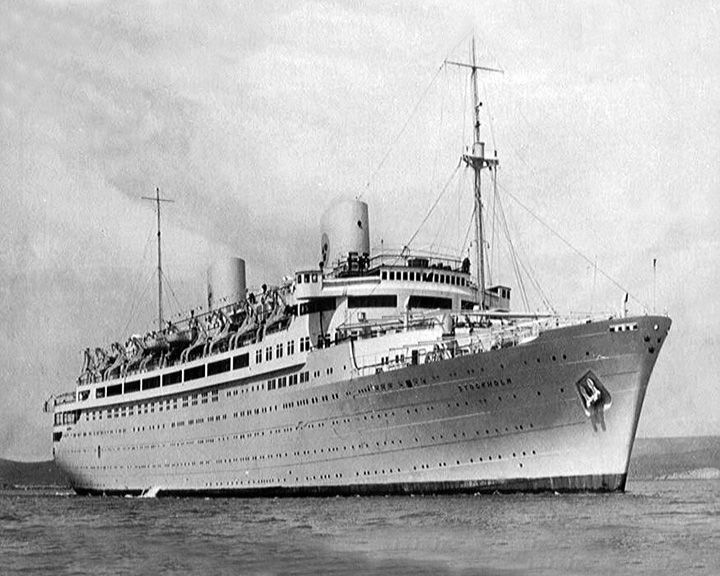 (Another (Another Stockholm, MS — Swedish luxury cruise ship (ocean liner) Collided with the SS Andrea Doria in heavy fog off the coast of Nantucket. She sailed under dozens of other names and is currently MS Athena. LAUNCHED: 1948 → FATE: Still in use. |
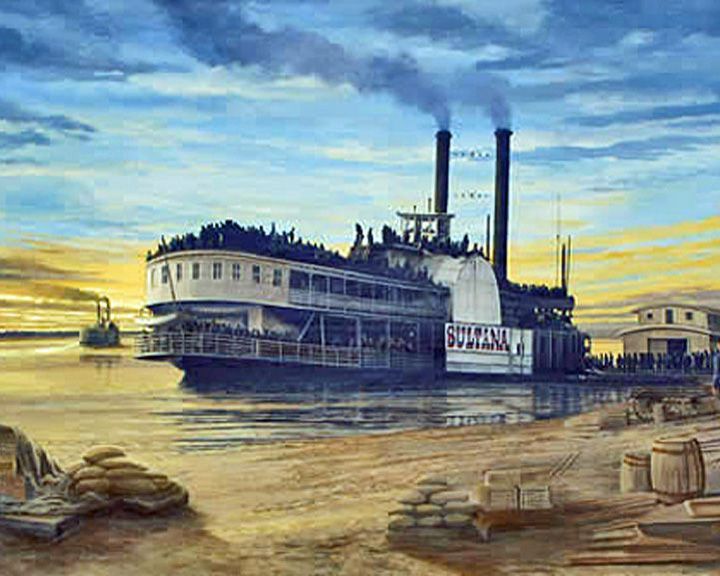 Sultana, SS — American paddle steamboat, stern-wheeler Tragically collided with the SS Narragansett. An estimated 1,800 of 2,400 passengers were killed when the ship's boilers exploded, earning her the appellation "Titanic of the Mississippi." LAUNCHED: 1863 → FATE: Sank April 27, 1865. |
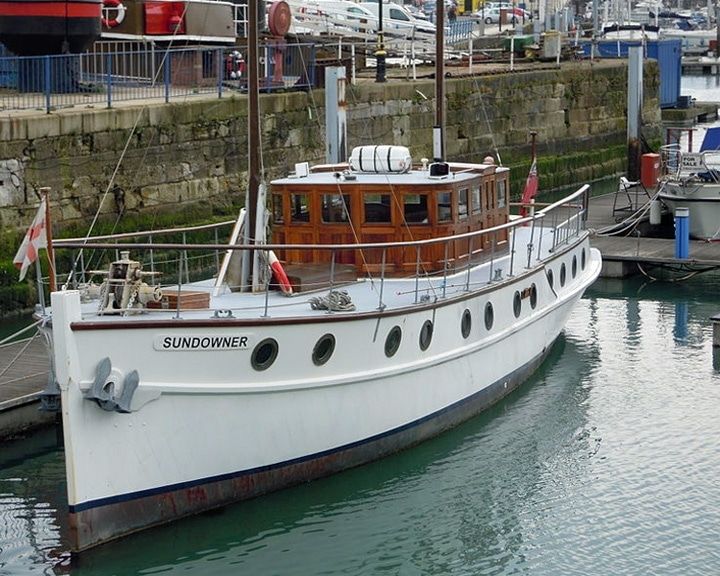 Sundowner — British motor yacht She participated in the Dunkirk evacuation as one of the "little ships" as well as a number of commemorations of the event. She was formerly owned by Charles Lightoller who was Second Officer aboard the ill-fated RMS Titanic and survived. LAUNCHED: 1912 → FATE: A museum ship at the Ramsgate Maritime Museum in Southern England. |
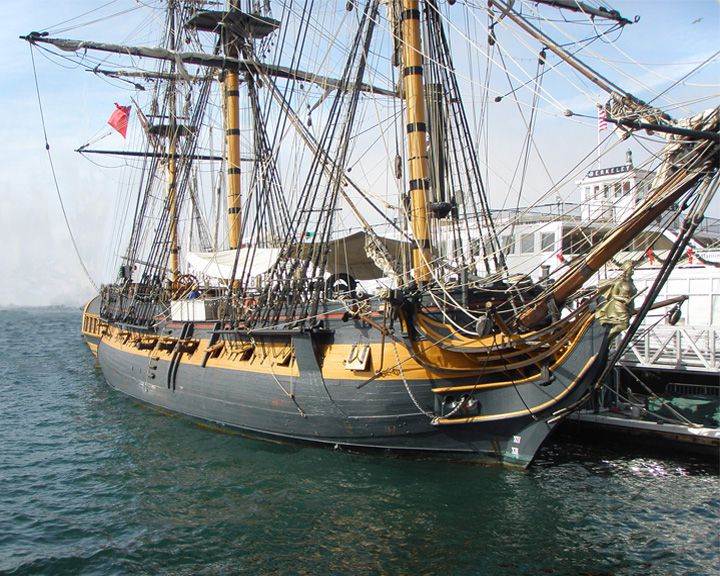 Surprise, HMS — Canadian tall ship based on the 1757 HMS Rose, a sixth-rate frigate As HMS Rose, she appeared in the 2003 movie Master and Commander: The Far Side of the World and was officially re-registered as HMS Surprise in honor of her role in the film. In 2010, she portrayed HMS Providence in the movie Pirates of the Caribbean: On Stranger Tides. LAUNCHED: 1970 → FATE: Since 2007, based in Maritime Museum of San Diego. |
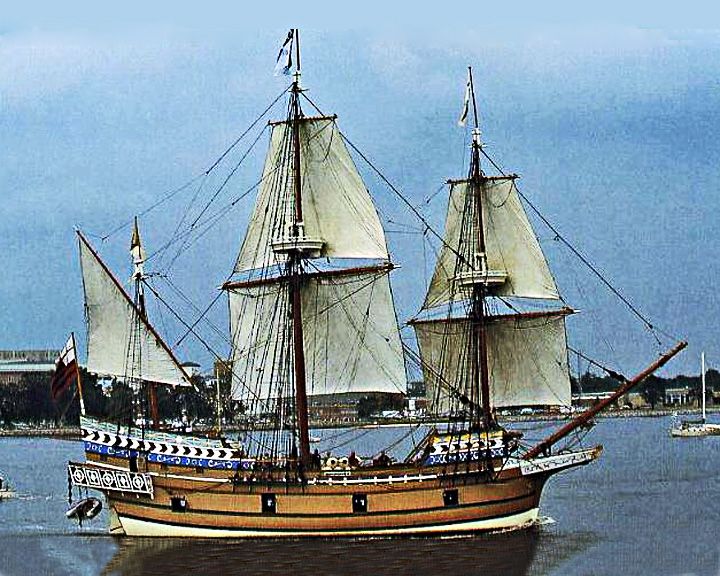 Susan Constant — British fully-rigged ship The largest of three ships of the English Virginia Company sailing to establish the new Colony of Virginia, Jamestown. Replicas of Susan Constant, shown in image, and her sister-ships are docked in the James River at Jamestown Settlement. LAUNCHED: 1607 → FATE: After 1615, fate unknown. |
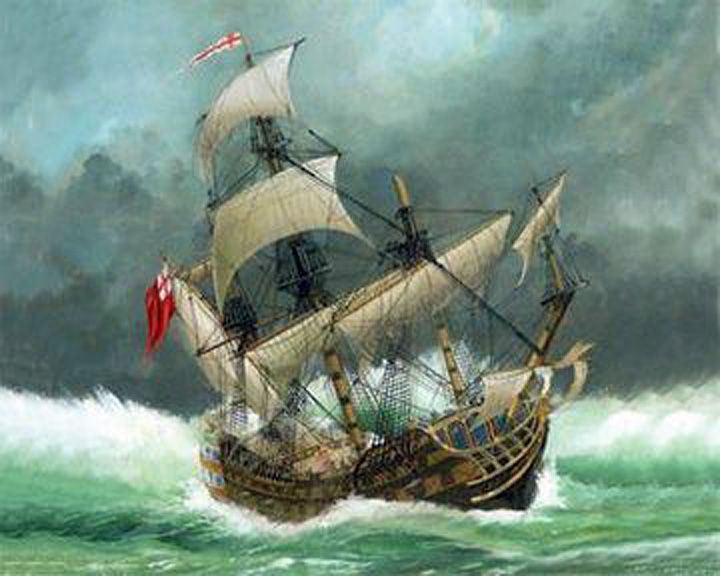 Sussex, HMS — English ship of the line, third-rate One of the most valuable wrecks ever with possibly 10 tons of gold coins and other valuables on board. Besides Sussex, 12 other ships of her flotilla sank with about 1,200 casualties making the disaster one of the worst in Royal Navy history. LAUNCHED: 1693, April 18 → FATE: Sank in a violent storm near the Strait of Gibraltar February 27, 1694. |
|
|
Page 53
|
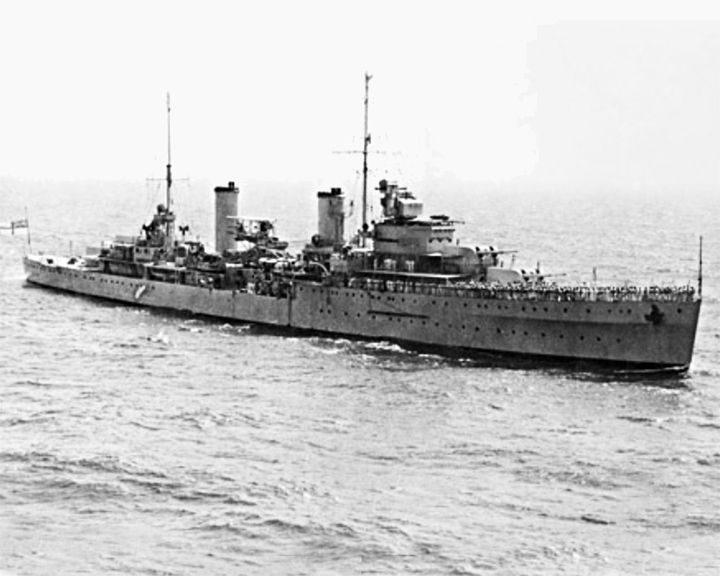 Sydney, HMAS — Australia Leander-class light cruiser The most devastating loss of life for the Royal Australian Navy when 645 personnel went down with the ship during the battle with the German auxiliary cruiser Kormoran. The wrecks of Sydney and the Kormoran were discovered off the coast of Shark Bay in 2008. The Australians who died are commemorated at the Australian War Memorial. LAUNCHED: 1934, September 22 → FATE: Sunk by the German auxiliary cruiser Kormoran, November 19, 1941 off the coast of Western Australia. |
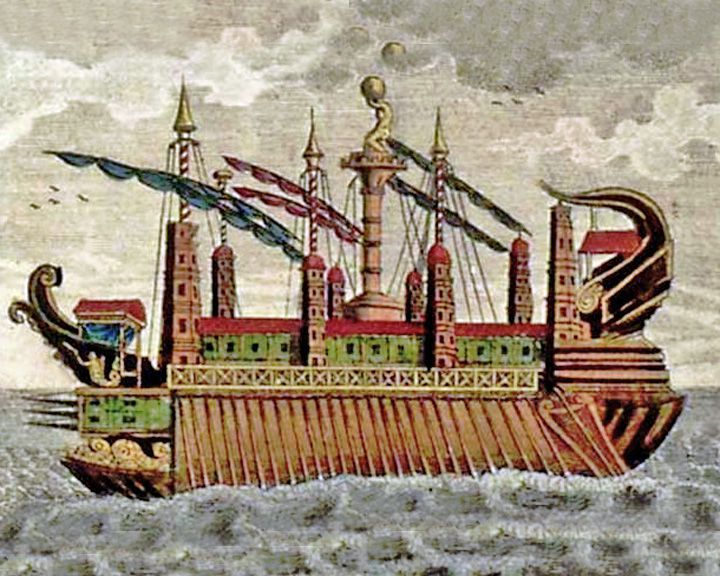 Syracusia — Greek cargo ship The largest transport ship of antiquity. It sailed only once to berth in Alexandria where it was later given to Ptolemy. LAUNCHED: 240, BC, circa → FATE: Unknown. |
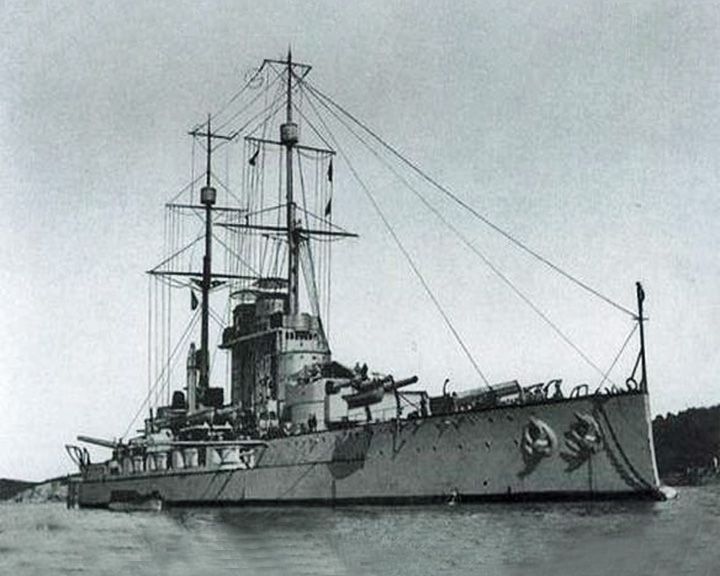 (Another (Another Szent István, SMS — Hungarian dreadnought The only battleship whose sinking was filmed during World War I. Having spent most of the war at anchor or out on gunnery training, she was sunk in her first and only mission; 89 sailors died. LAUNCHED: 1914, January 18 → FATE: Torpedoed off Premuda Island June 10, 1918. |
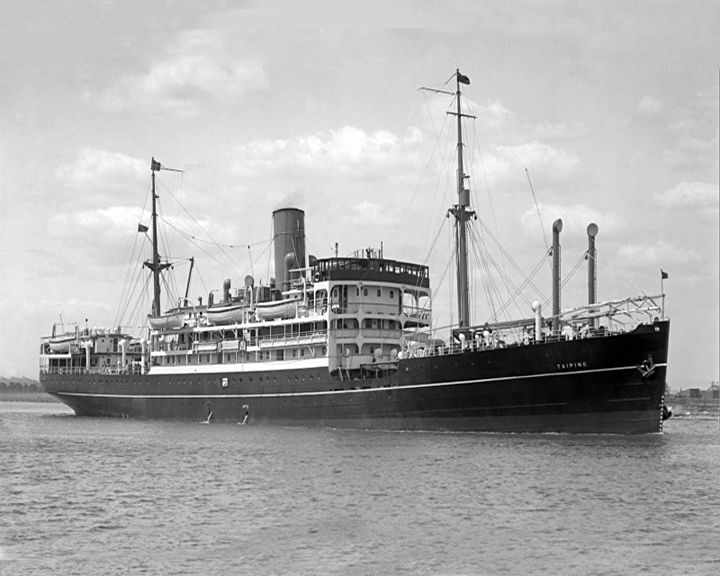 Taiping — Chinese steamship Tragically collided with another vessel killing over 1,500 people. A memorial to the ship and those who died aboard her was established at Port Keeling naval base on Taiwan. The 2014 movie The Crossing is based on the sinking. LAUNCHED: 1920, probably → FATE: Sank January 27, 1949. |
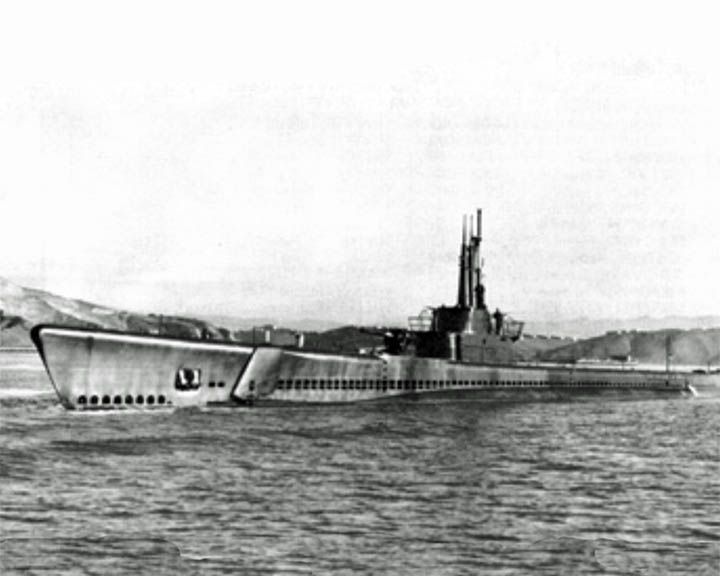 Tang, USS — American Balao class submarine Credited with sinking 31 enemy ships totaling 227,800 tons, unequaled among American submarines during World War II. When she was sunk by a circular run of her final torpedo, several crew escaped the sinking boat with a Momsen lung, the only known occasion of its use. 78 men were lost and the nine survived. LAUNCHED: 1943, August 18 → FATE: Sunk by her own torpedo in the Taiwan Strait October 24, 1944. |
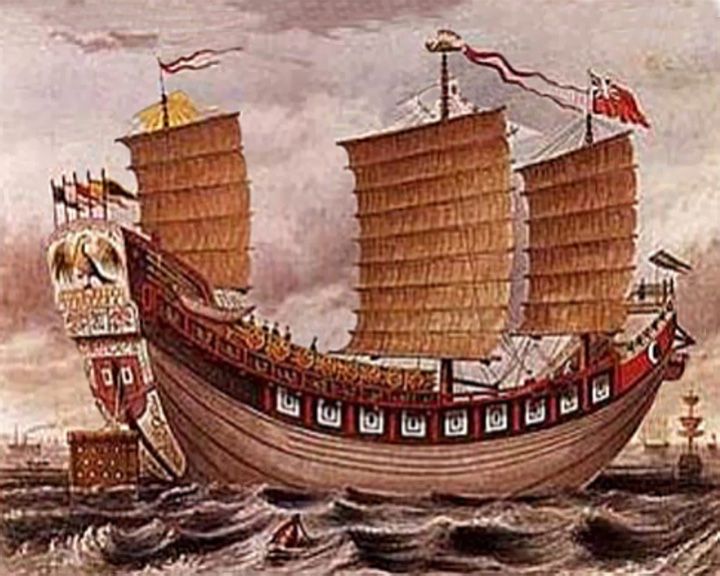 Tek Sin — Chinese ocean-going junk Called the "Titanic of the East" when it sank taking with it over 1,600 people. Only about 200 people survived, being rescued by another ship the next day. LAUNCHED: 1820, circa → FATE: Grounded on a reef, then sank on February 6, 1822. |
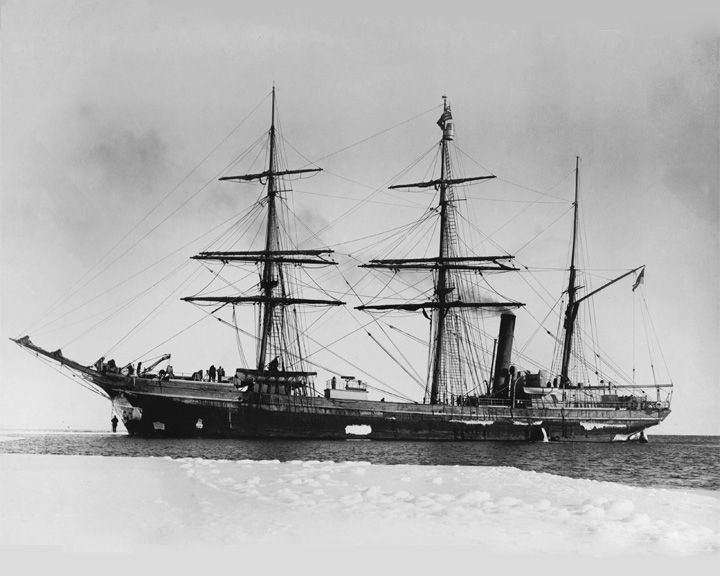 Terra Nova — British wooden-hulled barque Serving in the British Antarctic Expedition 1910, best remembered for the death of Captain Scott and four companions. She was built for the Dundee whaling and sealing fleet, working 10 years in the annual seal fishery in the Labrador Sea. LAUNCHED: 1884 → FATE: Sank off the southwestern tip of Greenland September 13, 1943. |
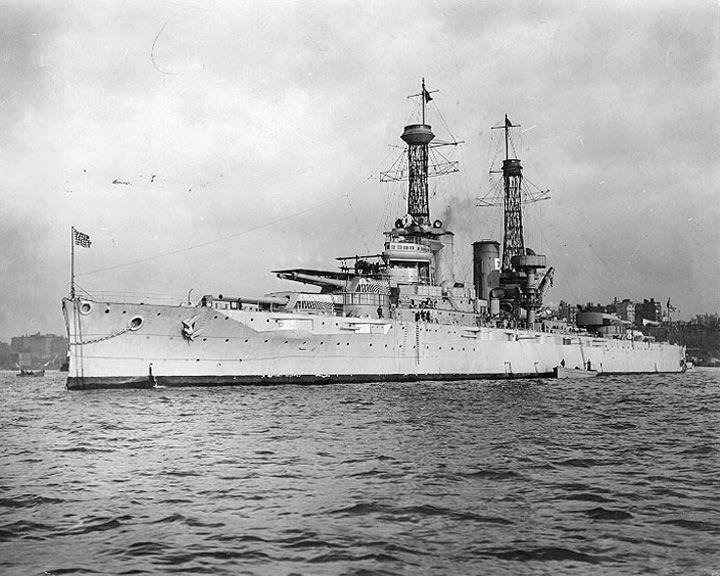 (Another (Another Texas, USS — American New York class battleship The only remaining World War I era dreadnought battleship. She is noteworthy for being one of only seven remaining ships and the only remaining capital ship to have served in both World Wars. LAUNCHED: 1912, May 18 → FATE: Museum ship at San Jacinto Battleground State Historic Site. |
|
|
Page 54
|
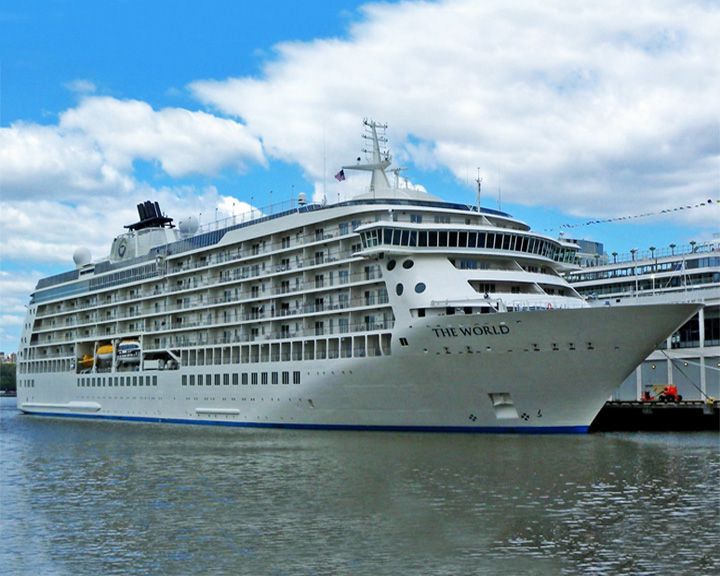 The World, MS — Swedish cruise ship A ship serving as a residential community owned by its residents. She became the largest passenger ship to transit the Northwest Passage by sailing from Nome, Alaska to Nuuk, Greenland in 25 days, August-September, 2012. LAUNCHED: 2002, March → FATE: Still in service. |
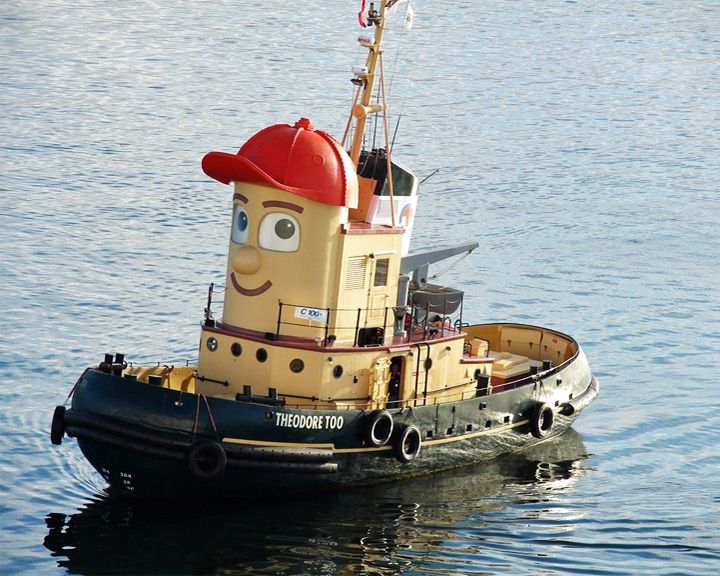 Theodore Too — Canadian tug boat Full size imitation tugboat based on the fictional tugboat Theodore from the television show Theodore Tugboat. She is the ambassador of the U.S. National Safe Boating Council and mascot to the U.S. Coast Guard participating in several tall ship events. LAUNCHED: 2000, April 18 → FATE: Still in service. |
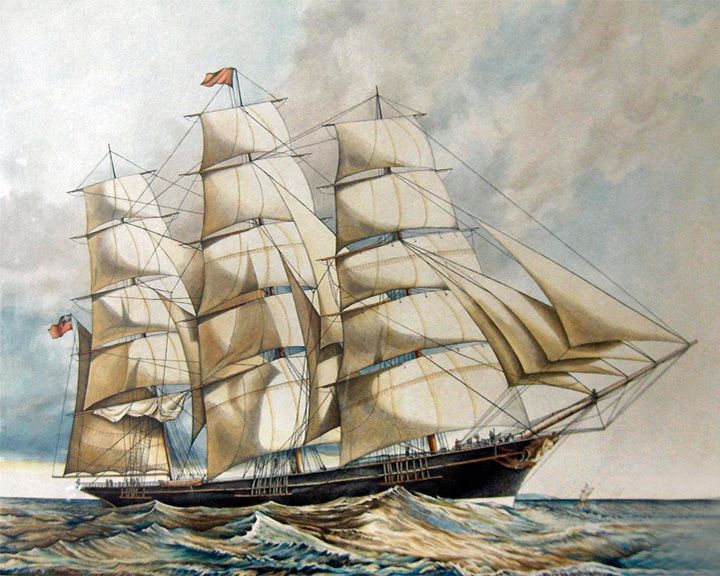 Thermopylae — English extreme clipper Raced the clipper Cutty Sark from Shanghai back to London and won by seven days. In 1897, she was sold to Portugal and renamed Pedro Nunes for used as a naval training ship. LAUNCHED: 1868, August → FATE: Sunk as target practice by the Portuguese Navy, October 13, 1907. |
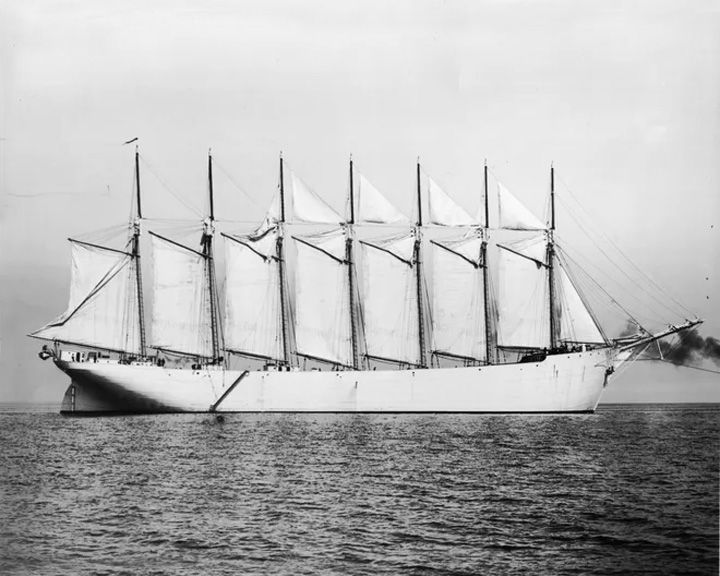 Thomas W. Lawson — American seven-masted schooner The largest schooner and largest sailing vessel without an auxiliary engine ever built. She proved problematic in the ports she was intended to operate in due to the amount of water she displaced. LAUNCHED: 1902, July, 10 → FATE: Sank in a storm while at anchor off Cornwall, England, in 1907 taking 16 of her crew with her. |
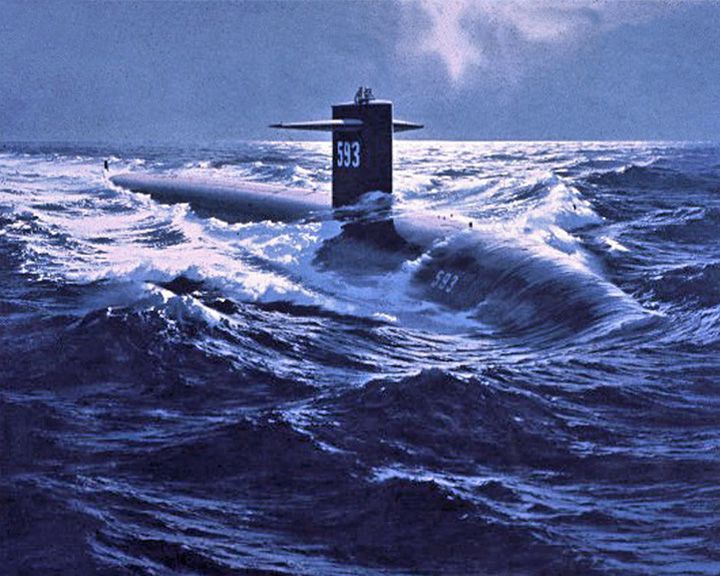 Thresher, USS — American nuclear submarine Lost at sea during deep-diving tests in 1963 with 129 crew. She was the lead ship of her class of nuclear-powered attack submarines and one of two nuclear submarines the U.S. Navy has lost, the other being USS Scorpion, SSN-589. LAUNCHED: 1960, July 18 → FATE: Sunk April 10, 1963. |
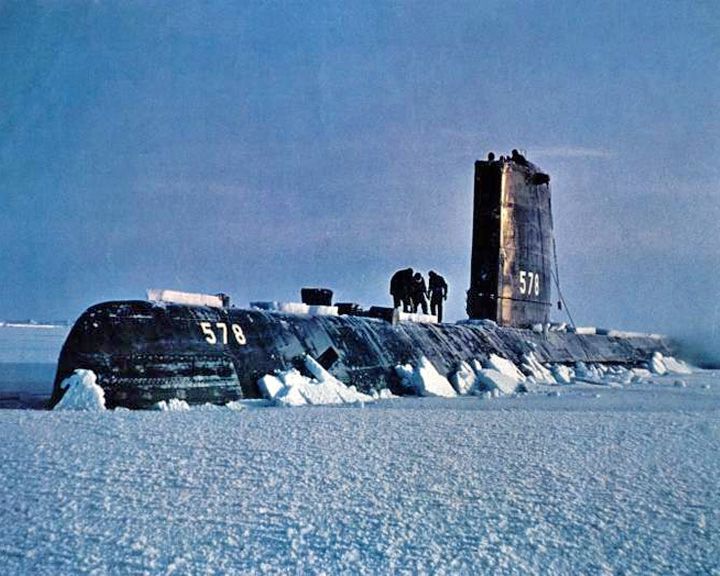 Tigerfish, USS — American attack submarine Fictional submarine in the movie Ice Station Zebra. She was portrayed in the movie by the diesel-electric submarine USS Ronquil when seen on the surface. LAUNCHED: 1968, movie release → FATE: Inconclusive. |
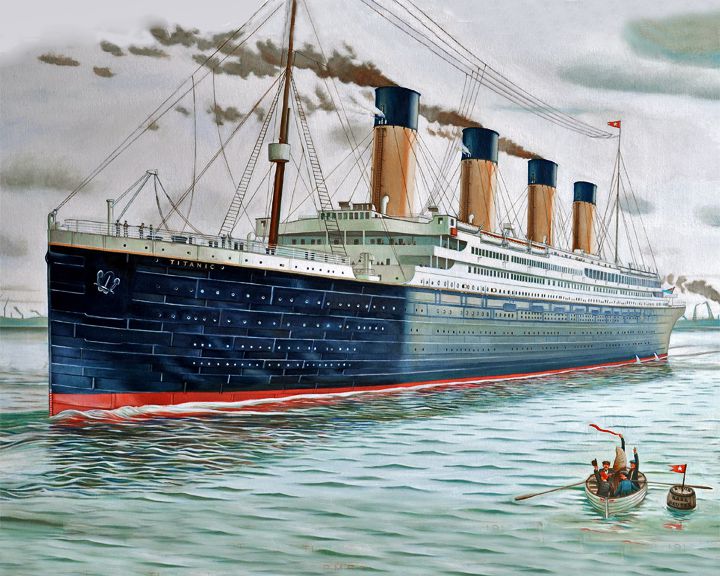 (Another (Another Titanic, RMS — British luxury ocean liner The most famous ship sinking in history, she sank after hitting iceberg in the Atlantic, claiming over 1500 lives. Believed by many to be unsinkable, her disintegrating remains lie at a depth of 3,784 meters. Many movie have been made about her sinking including the 1997 film. LAUNCHED: 1911, May 18 → FATE: Sank in the North Atlantic April 15, 1912. |
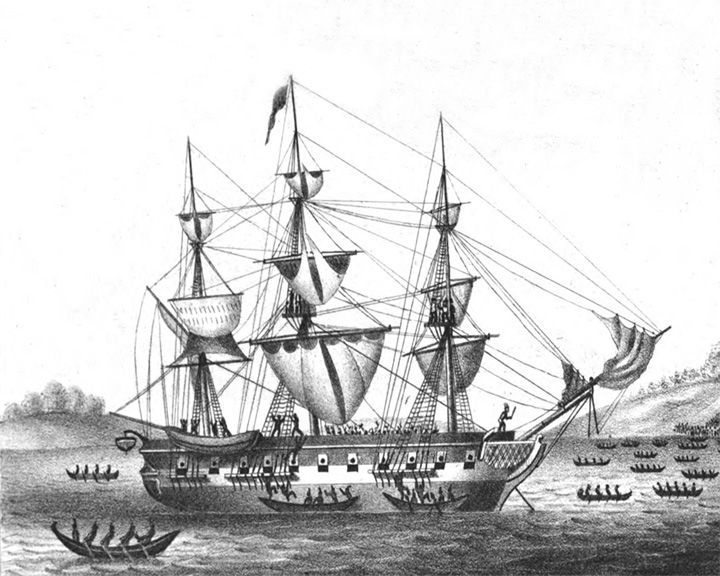 Tonquin — American merchant ship The ship was part of Astor's attempt to establish a fur trading outpost on the Pacific Northwest coast. After an angry encounter with natives, two surviving crew hid in the ship, then when the Indian natives returned to loot the ship, lit a fuse that detonated her powder magazine killing more than 100 natives and two crew. LAUNCHED: 1807, May 26 → FATE: Blown up June 16, 1811. |
|
|
Page 55
|
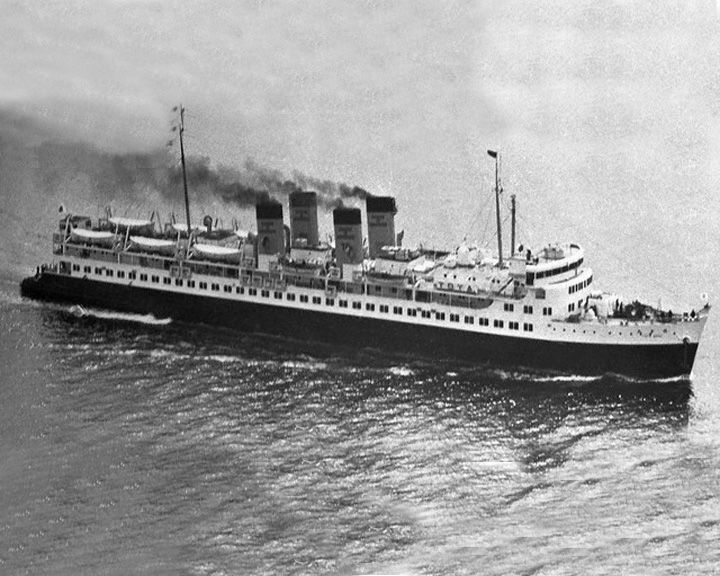 Toya Maru — Japanese train ferry Her sinking was one of the major factors behind the construction of the Seikan Tunnel between Hokkaido and Honshu. Perhaps 1,153 people were lost but the exact number is unknown because some people boarded without tickets and others cancelled just before sailing. LAUNCHED: 1947, November → FATE: Sank during a typhoon in the Tsugaru Strait September 26, 1954. |
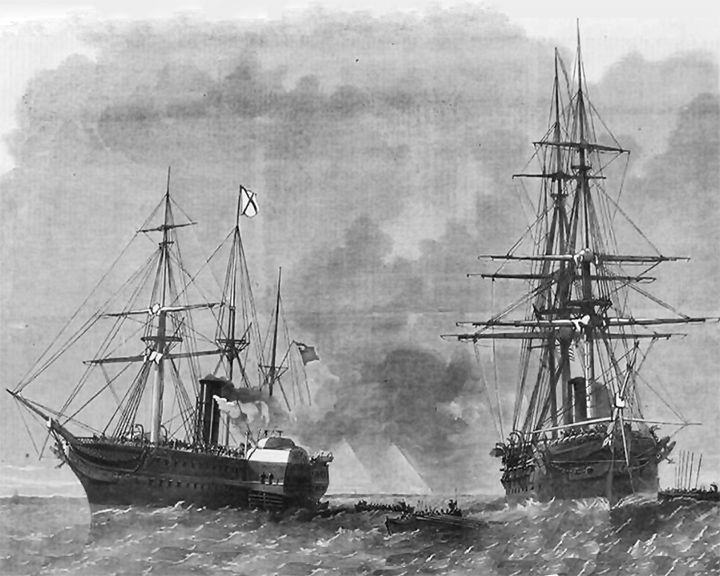 Trent, RMS — British paddle steamer serving as a packet boat Principle ship in the Trent affair in 1861 during the American Civil War. Her interception by USS San Jacinto and unlawfully capture of two Confederate diplomats almost led to war between the Britian and the United States. LAUNCHED: 1841 → FATE: Sold and broken up after 1865. |
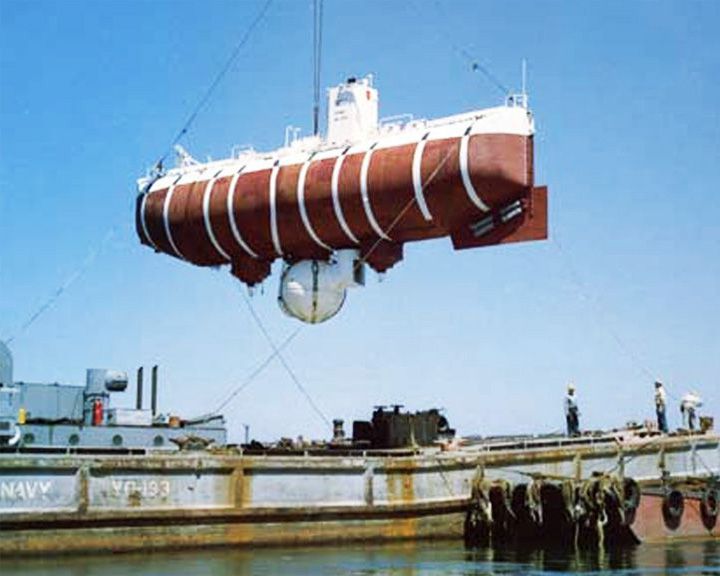 Trieste — Italian deep-diving research bathyscaphe; Swiss designed Dove to a record ocean depth of about 10,911 metres, or about 6.8 miles. She reached the ocean floor in the Mariana Trench on January 23, 1960. She found the missing submarine USS Thresher off the coast of New England in August of 1963. LAUNCHED: 1953, August 18 → FATE: On display at the U.S. Naval National Undersea Museum in Keyport, Washington. |
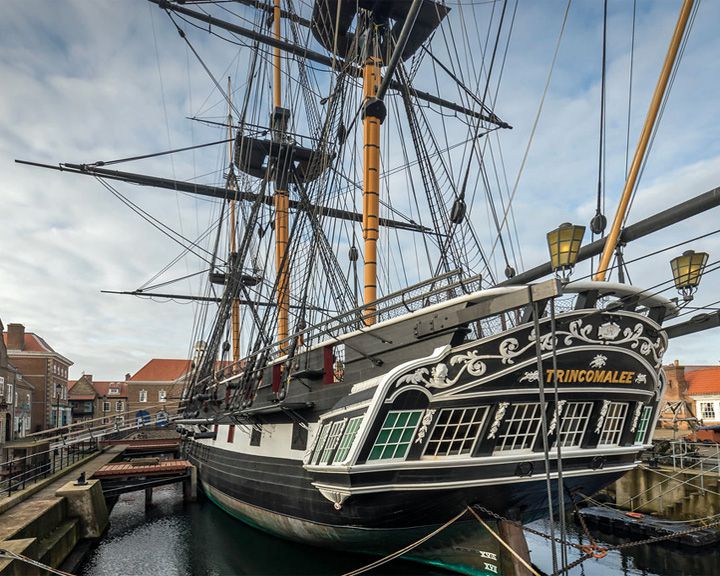 Trincomalee, HMS — British Leda-class frigate One of two surviving British frigates of her era. Holds the distinction of being the oldest British warship still afloat. LAUNCHED: 1817, October 12 → FATE: Restored made the centerpiece museum ship in Hartlepool, England. |
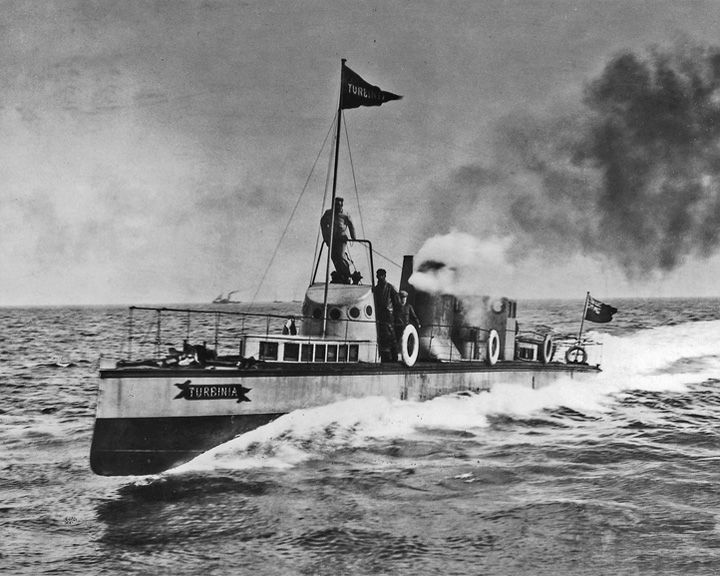 Turbinia — British steamship First steam turbine-powered steamship and the fastest ship in the world at that time at over 34 knots. She showed up unannounced at the Fleet Review for Queen Victoria's Diamond Jubilee at Spithead in 1897, racing up and down the ranks of other ships. LAUNCHED: 1894, August 18 → FATE: On display at the Discovery Museum at Newcastle upon Tyne, England. |
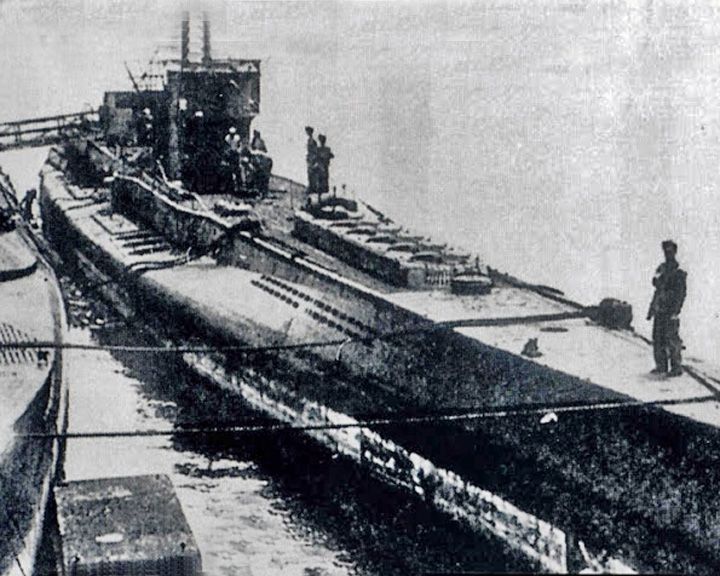 U-234 — German submarine Hitler's last submarine; ironically, there is an isotope of uranium designated U-234. While attempting to deliver uranium to Japan near the end of World War II, she surrendered to the United States on May 14, 1945. LAUNCHED: 1943, December → FATE: Sunk by torpedo November 20, 1947. |
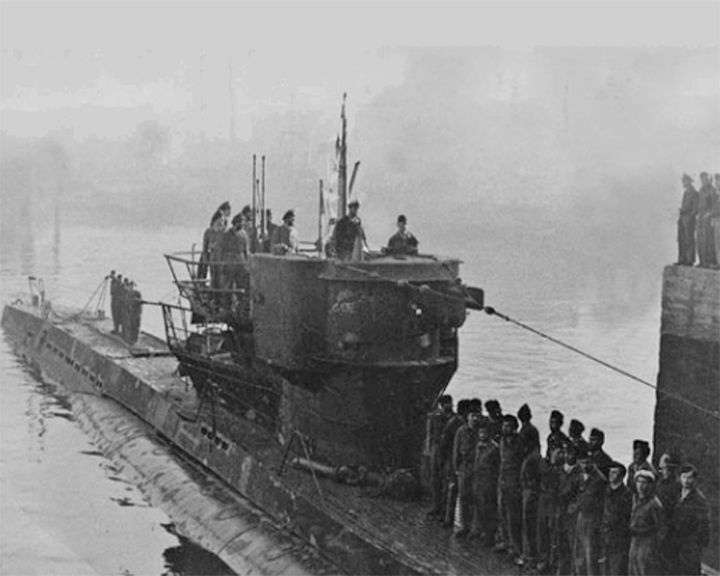 U-480 — German experimental Kriegsmarine Type VIIC submarine The first stealth submarine; she was covered with a special rubber coating making it difficult to detect with SONAR. She sank two warships and two merchantmen ships and was never detected by the British until it was discovered by divers in 1998 south of Isle of Wight. LAUNCHED: 1943, August 14 → FATE: Sunk in February 1945 in an English Channel minefield with the loss of its crew. |
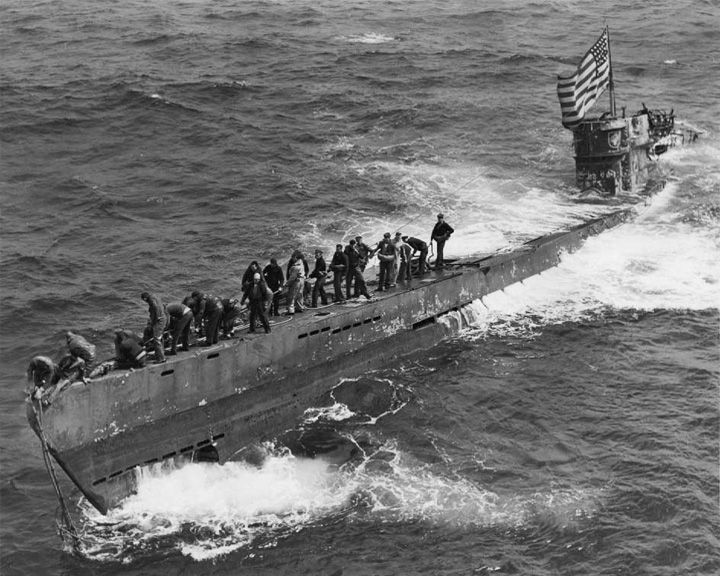 U-505 — German submarine Codebooks, an Enigma machine, and other secret materials that were found on board assisted Allied code breakers during World War II. All but one of crew were rescued from U-505. For U-110, there were casualties among the crew caused by two attacking destroyers. LAUNCHED: 1941, August → FATE: Captured in June 4, 1944. Now at Chicago museum. |
|
|
Page 56
|
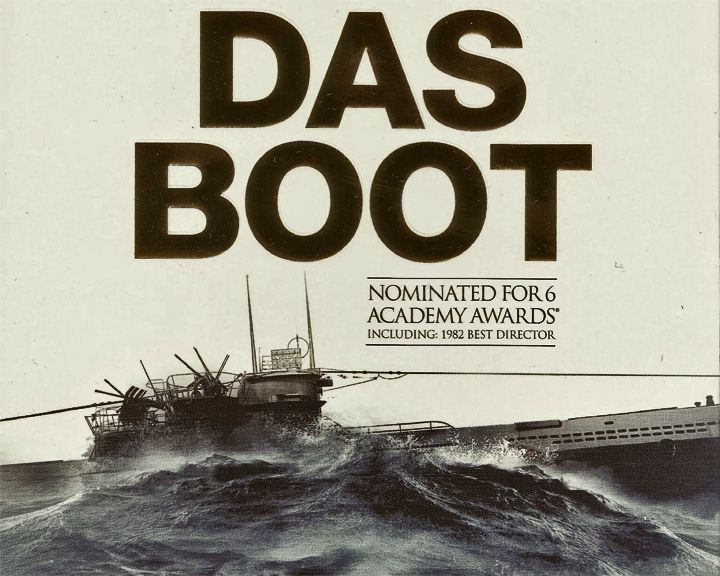 U-96 — German German Type VIIC submarine She was made famous in the 1981 movie Das Boot, a fictional account of its adventures in the Battle of Atlantic of World War II.. During 1941, war a correspondent joined U-96 and, based on his experiences, published a novel that was made into the 1981 movie LAUNCHED: 1940, August 1 → FATE: Sunk in the Hipper Basin at Wilhelmshaven, March 30, 1945. |
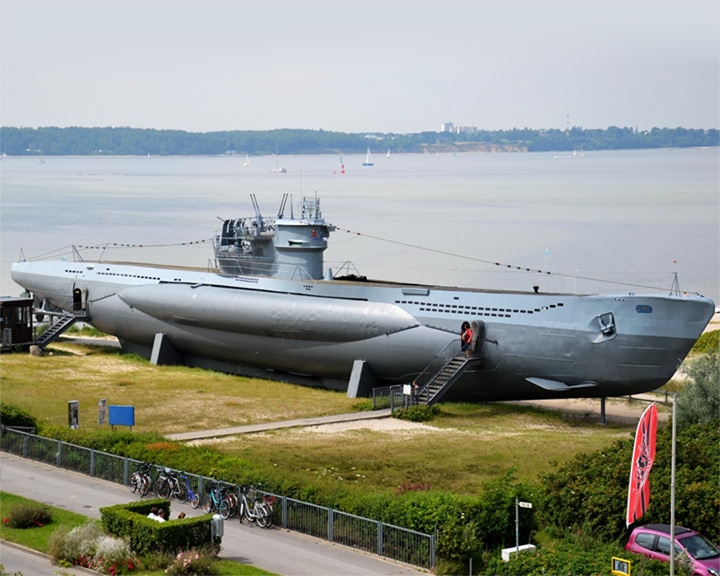 U-995 — German submarine The last existing submarine of its type, which was the workhorse for the German navy during World War II. From 1943 till 1945 the U-995 fulfilled several missions against allied convoys heading for Murmansk, Russia. LAUNCHED: 1942, November 25 → FATE: At the end of WW-II, she was surrendered to the British in December 1945 and then transferred to Norwegian ownership in October 1948. Eventually, in October 1971, she became a museum ship at Laboe Naval Memorial, in Germany. |
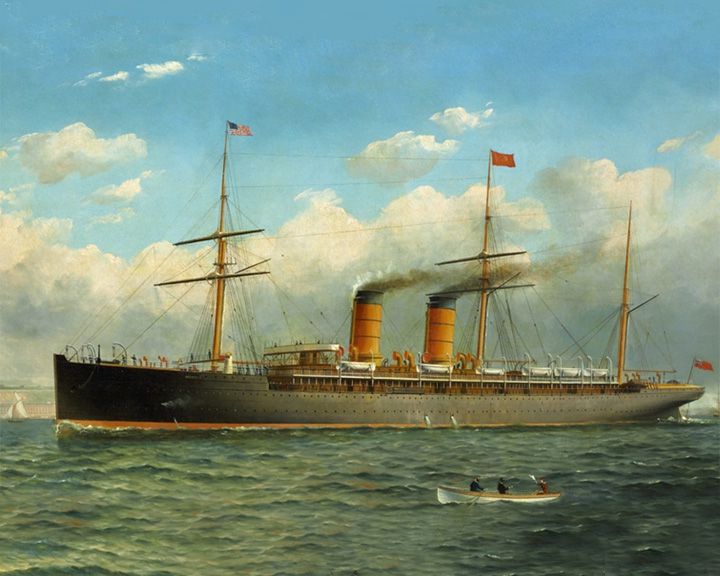 Umbria, RMS — British ocean liner With her sister ship, Etruria, the last two transatlantic ocean liners fitted with auxiliary sails. In May of 1903, the Mafia tried to blow her up but failed. LAUNCHED: 1884, June 18 → FATE: Scrapped in 1910. |
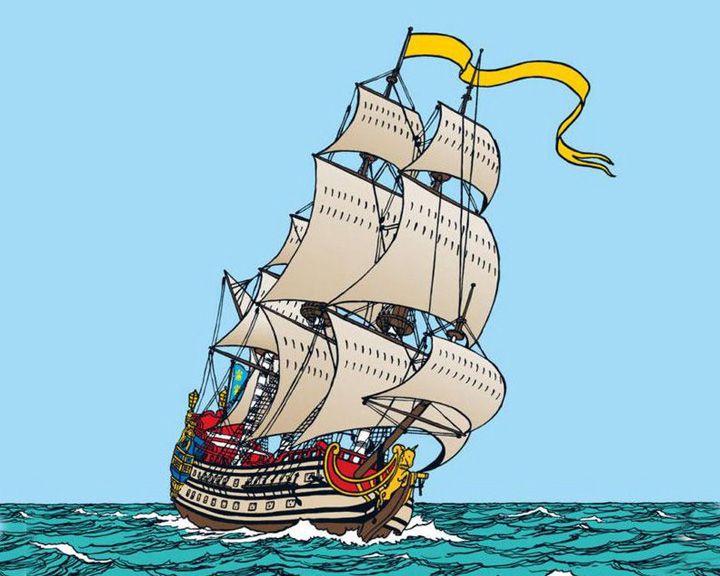 (Another (Another Unicorn — British three-masted sailing ship Royal Navy vessel appearing in the comics series by Belgian cartoonist Hergé The Adventures of Tintin, and the movie. She is the setting of a battle between pirates and sailors, then scuttled, and discovered years later by the boy Tintin and his friends. LAUNCHED: 1943, first appeared in print; movie release in 2011 → FATE: Inconclusive. |
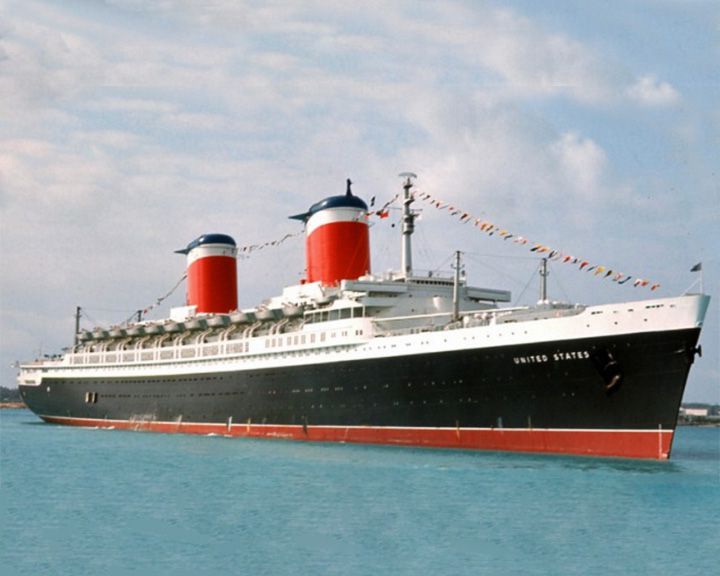 United States, SS — American ocean liner (steamship) The fastest liner ever built; virtually no wood used in her construction. On her maiden voyage she captured the Blue Riband with the fastest transatlantic crossing on record in 3 days, 10 hours, 40 minutes at an average speed of 35.59 knots. LAUNCHED: 1951, June 18 → FATE: As of February 7, 2012, work has begun on the restoration project to prepare the ship for her eventual rebuild. |
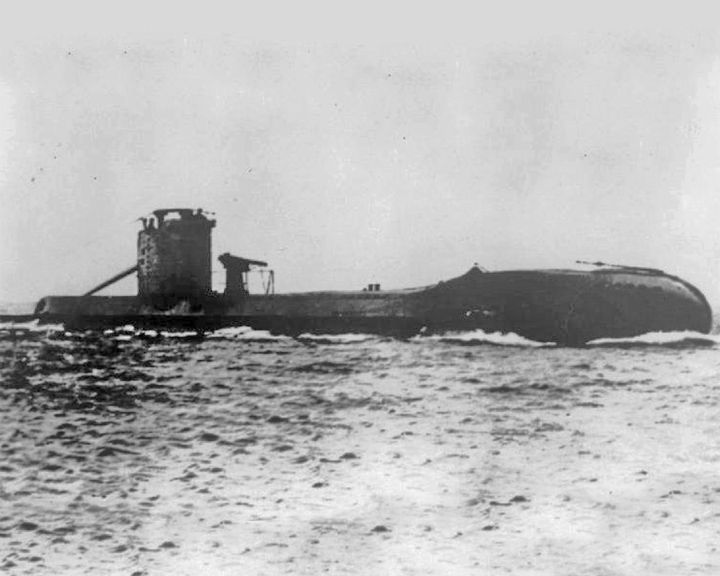 Upholder, HMS — British U-class submarine The most successful British submarine of the World War II sinking a gross tonnage of 93,031. She was one of four U-class submarines with 2 external torpedo tubes at the bows in addition to the 4 internal ones. LAUNCHED: 1940, July 8 → FATE: Lost northeast of Tripoli with all hands, probably sunk by enemy depth charges April 14, 1942. |
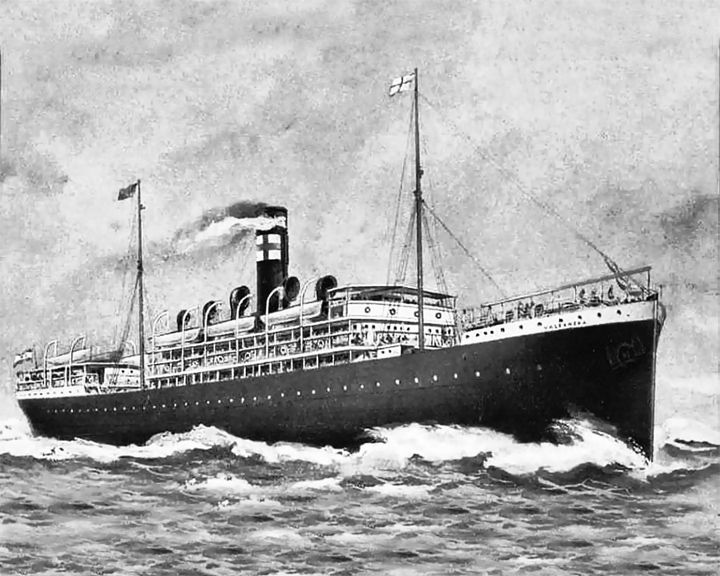 Valbanera, SS — Scotish, then Spanish passenger steamship Notable because of the mystery surrounding her disappearance during a hurricane. More than 480 passengers and crew were lost. Two empty lifeboats and the ships mast marked the spot where the ship sank. LAUNCHED: 1906 → FATE: Sank in a hurricane off Key West September of 1919. |
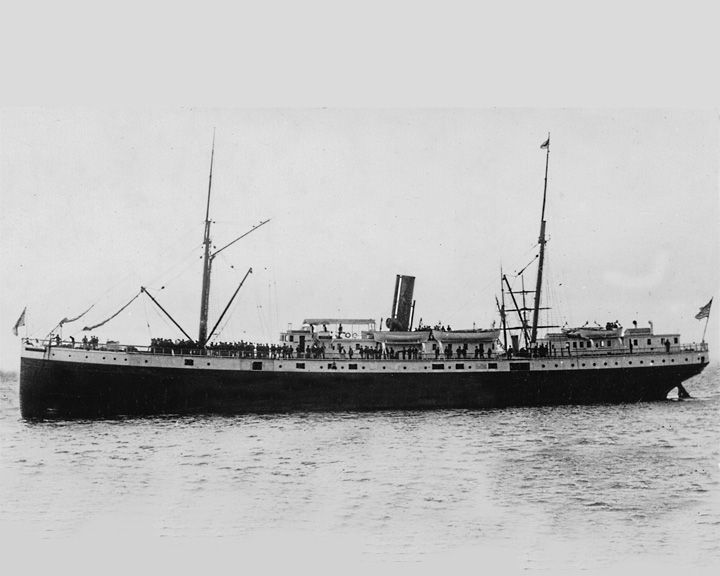 Valencia, SS — American passenger steamboat (steamship) Consider the worst maritime disaster in the Graveyard of the Pacific, a treacherous area off the southwest coast of Vancouver Island, British Columbia. 27 years after her sinking, one of her life rafts was found floating peacefully in nearby Barkley Sound. LAUNCHED: 1882, May → FATE: Wrecked January 22, 1906. |
|
|
Page 57
|
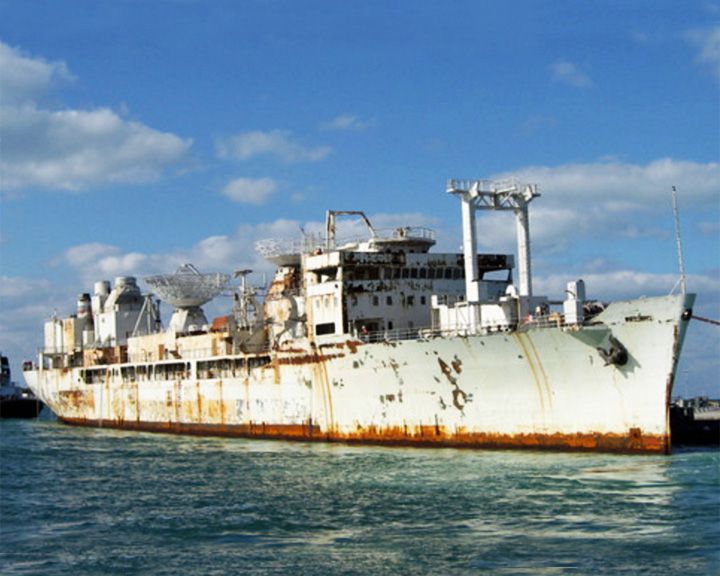 Vandenberg, USAFS — American transport ship Second-largest artificial reef in the world, after the aircraft carrier USS Oriskany. She transported troops in World War II. In 1998, she was featured in the film Virus as the Russian research ship Akademik Vladislav Volkov. LAUNCHED: 1943, October → FATE: Sank May 27, 2009, six miles off the Florida Keys. |
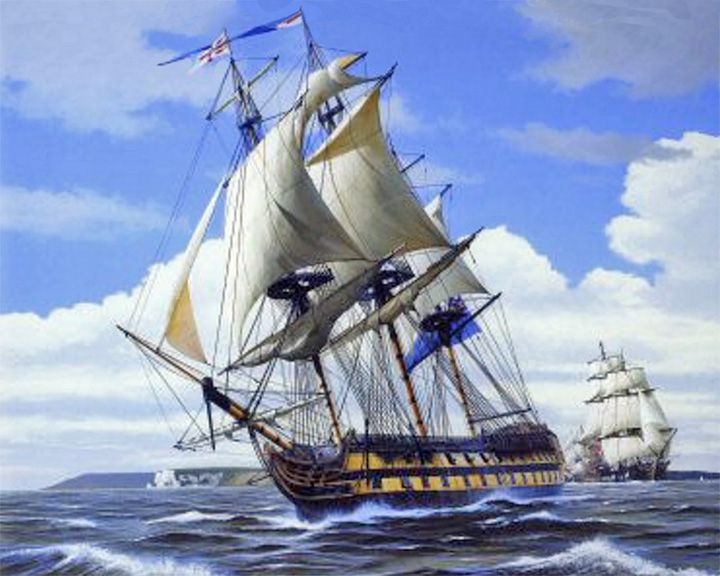 Vanguard, HMS — English ship of the line, 74-gun third-rate The flag ship of Horatio Nelson at the Battle of the Nile, 1798. Prince Alberto of Naples and Sicily, part of a royal entourage on board fleeing from Naples and the French, died on board. LAUNCHED: 1787, March 18 → FATE: Broken up in 1821. |
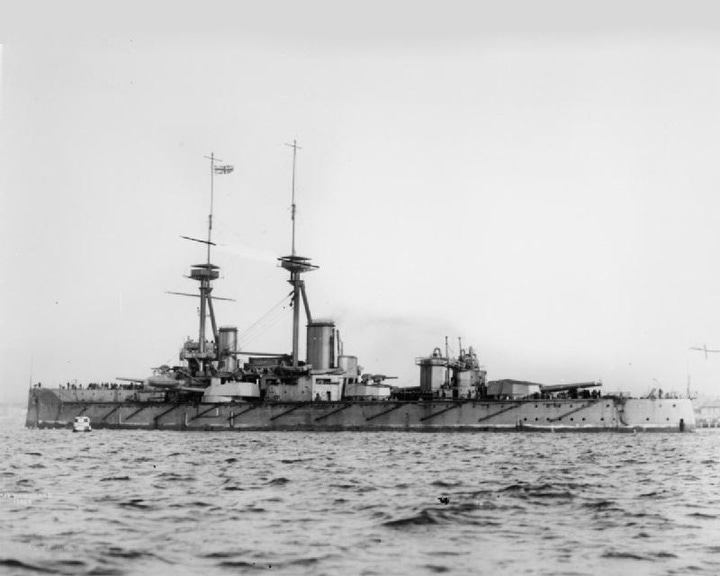 Vanguard, HMS (1909) — British St. Vincent class Dreadnaught She suffered a series of magazine explosions, sinking almost instantly, killing 843 of the 845 men aboard. Her captain coincidentally made a speech to the crew predicting the possible fate of the ship several hours before her sinking. Vanguard's wreck was heavily salvaged in search of non-ferrous metals before it was declared a war grave in 1984. Royal Navy divers placed a new Union Jack on the wreck. LAUNCHED: 1909, February 2 → FATE: Sunk by internal explosion at Scapa Flow, July 9, 1917. |
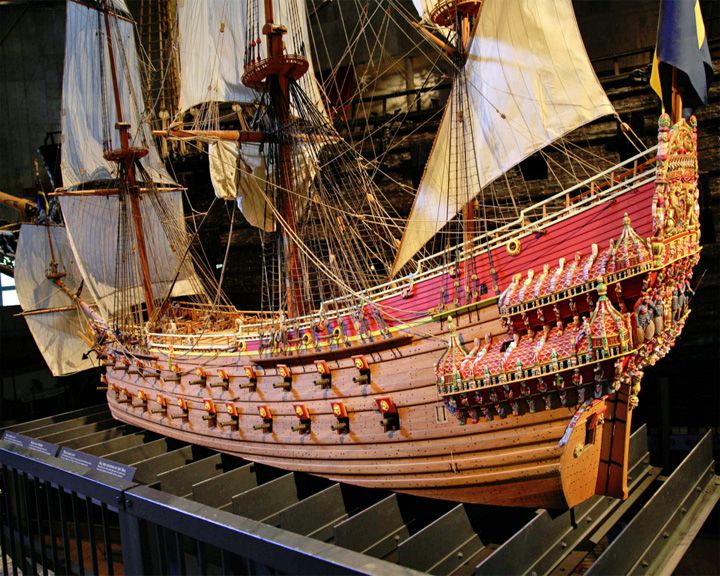 Vasa — Swedish wooden warship One of Sweden's most popular tourist attractions and a widely recognized symbol of the Swedish 'great power period'. During the 1961 recovery, thousands of artifacts and the remains of at least 15 people were found in and around the hull of the Vasa by marine archaeologists. LAUNCHED: 1627 → FATE: Sank on her maiden voyage in 1628 near Södermalm; salvaged in 1961 and now on display in the Vasa Museum in Stockholm. |
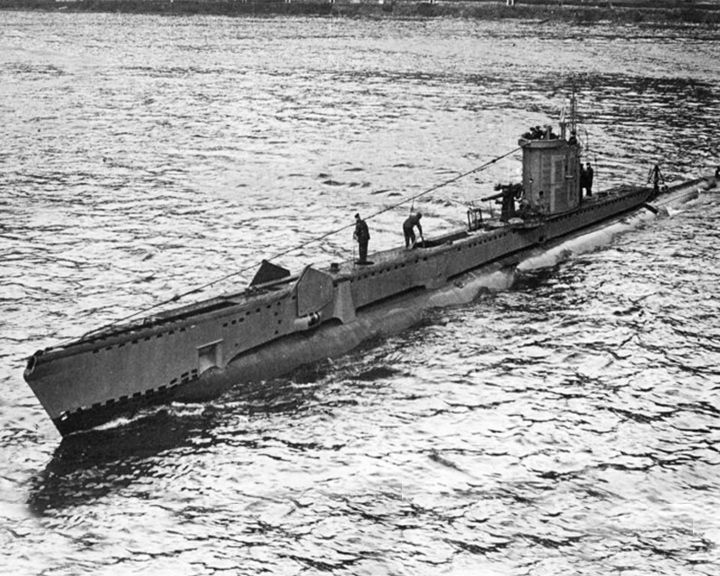 Venturer, HMS — British V-class submarine First time in naval warfare that one submarine stalked and sank another while both were submerged. Based on Enigma decrypts, she sought out and destroyed the German submarine U-864 in the Fedje area, February 9, 1945. LAUNCHED: 1943, May 4 → FATE: She was sold to Norway and renamed HNoMS Utstein. She was scrapped and broken up in 1964. |
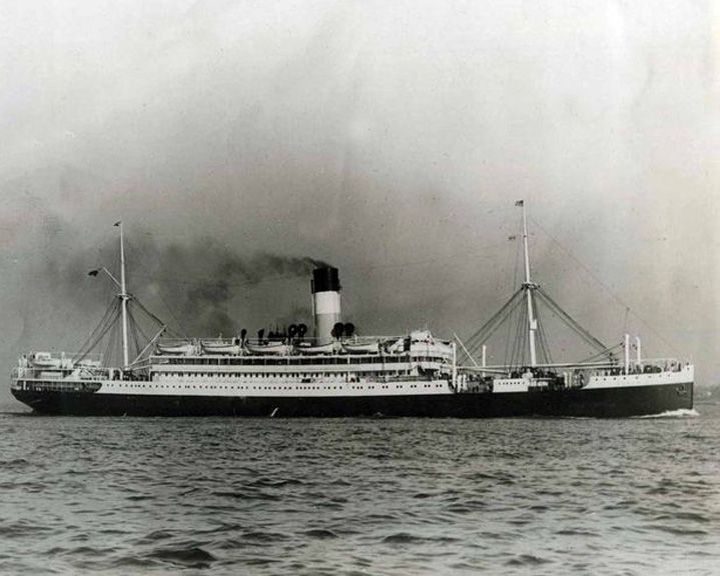 Vestris, SS — British passenger steamship The ship sank taking more passengers to their death than crew. 60 of 128 passengers survived, 155 of 198 crew survived. None of 13 children and only 8 of 33 women survived. LAUNCHED: 1912, May → FATE: Sank November 12, 1928. |
 Victoria — Spanish carrack or nao First ship to circumnavigate the world — August, 1519 to September of 1522; a total of 42,000 miles. Captain Ferdinand Magellan was killed in the Phillipines; another four ships were lost along the way. LAUNCHED: 1518, about → FATE: 1522 or soon after. |
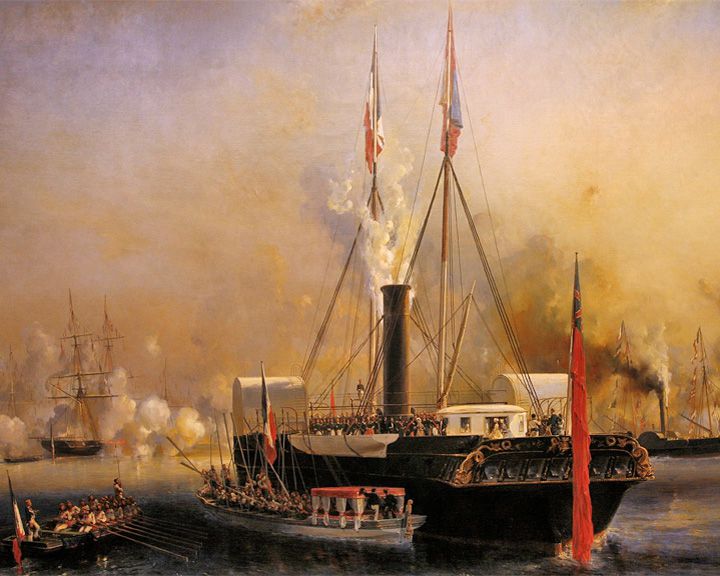 Victoria and Albert, HMY — British royal yacht; twin-paddle steamer First steam powered royal yacht built in Britain. The Queen and Prince Albert loved cruising around the coast of England. The yacht was renamed Osborne after the launch of HMY Victoria and Albert II January 16, 1855. LAUNCHED: 1843, April 25 → FATE: Scrapped, 1868. |
|
|
Page 58
|
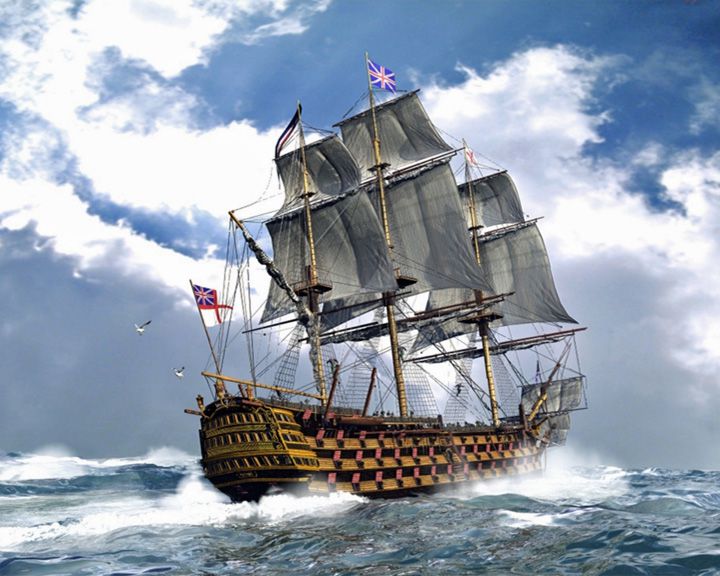 Victory, HMS — English first-rate ship of the line (Galleon) Lord Nelson's flagship at the Battle of Trafalgar in 1805. She was refitted and repainted in 1800-1803, almost broken up in 1831, fitted up as a Naval School 1889, retired in 1904, and eventually restored. LAUNCHED: 1765, May 18 → FATE: Being restored at the HMNB, Portsmouth, England. |
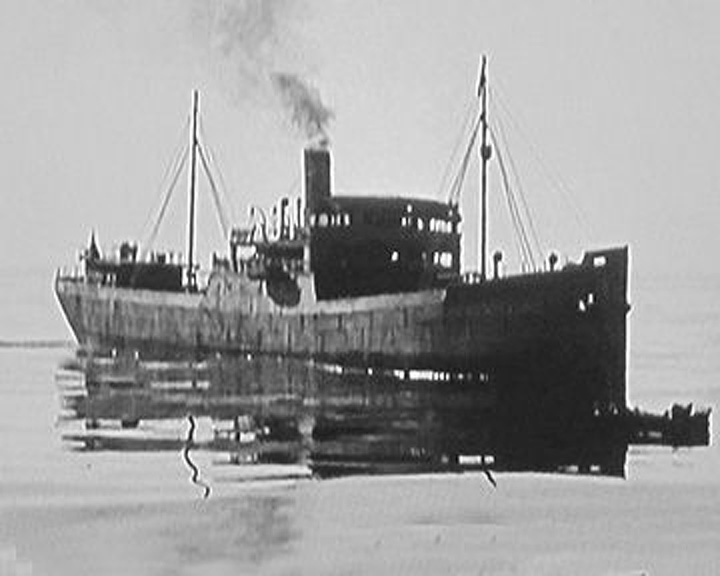 Ville de Nancy — American sloop of war Fictious ship in the movie Passageto Marseille, set during World War II and starring Humphrey Bogart. For the movie, Warner Bros. built a full-scale Merchant Marine ship modeled after the French ship Ville de Nancy. LAUNCHED: 1940 → FATE: Inconclusive. |
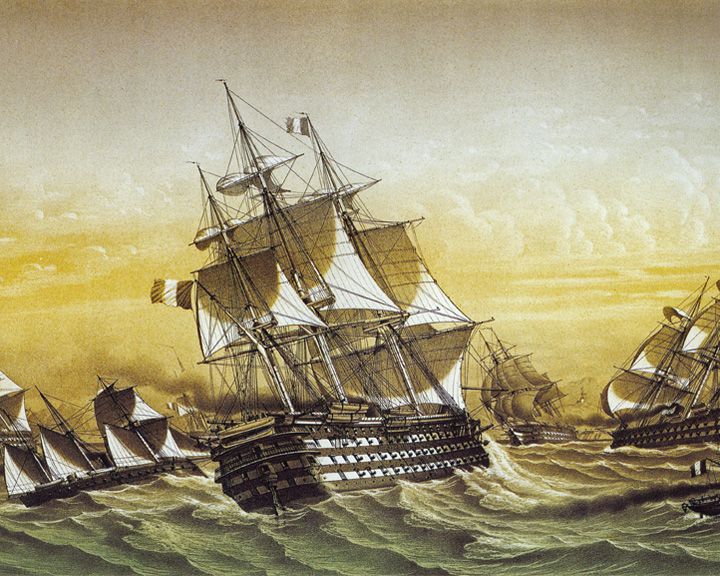 Ville de Paris — French ship of the line, large three-decker The flagship of the Comte de Grasse during the American Revolutionary War and the Siege of Yorktown. A ship of the line of the Royal Navy was named after her, HMS Ville de Paris, and launched in 1795. LAUNCHED: 1764 → FATE: Sank in September 1782 with other ships in a Central Atlantic hurricane. |
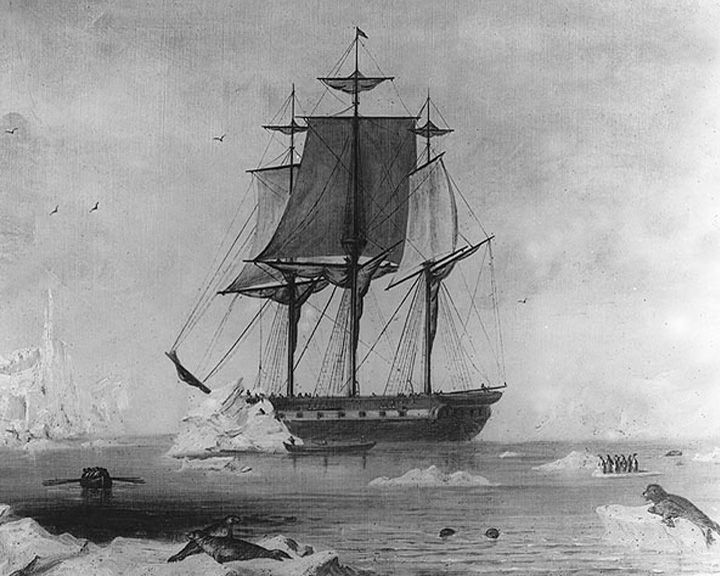 Vincennes, USS — American sloop of war First U.S. ship to circumnavigate the globe. She was the flagship for the U.S. Exploring Expedition of 1838. LAUNCHED: 1826 → FATE: Sold in October of 1867 at Boston, Massachusetts; fate unknown. |
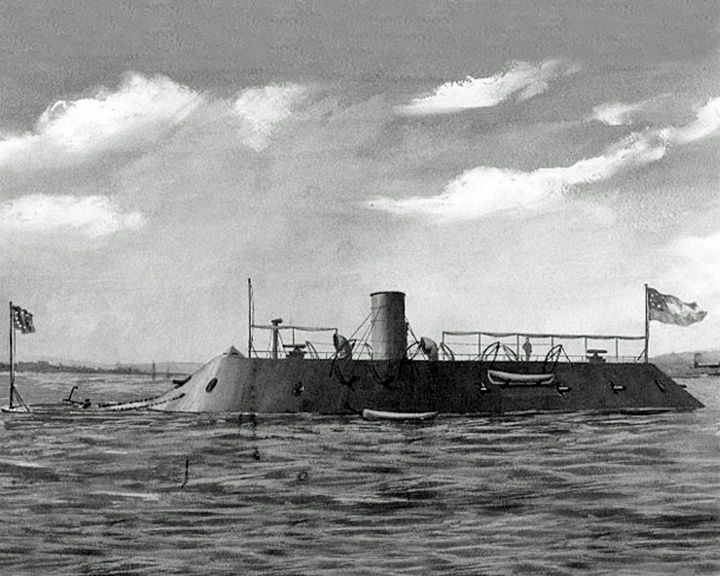 Virginia, CSS — Americant Confederat ironclad warship With USS Monitor, first naval battle between ironclad warships at the Battle of Hampton Roads. She was converted to an ironclad from a steam frigate. LAUNCHED: 1862, February → FATE: Destroyed by crew May 11, 1862. |
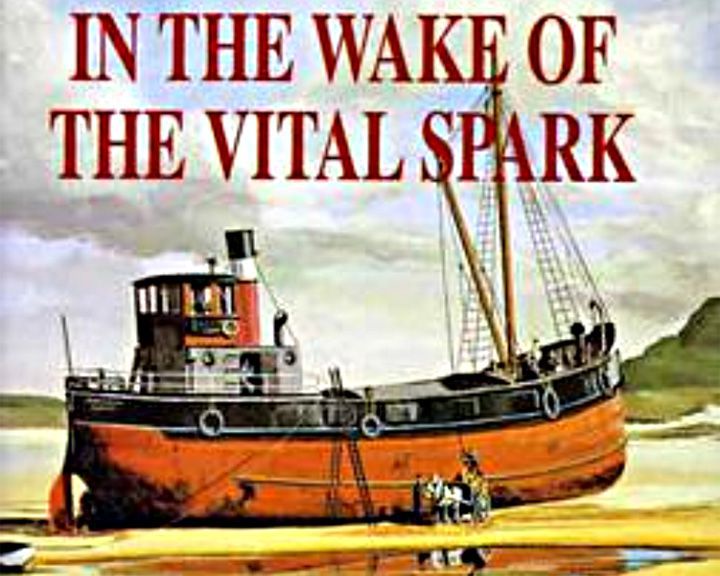 (Another (Another Vital Spark — British Clyde puffer cargo ship Star of the book series and British TV comedy series, The Vital Spark about the adventures of the boat captain and his crew. The BBC Scotland TV program The Vital Spark (1959-1974 series) was set in the western isles of Scotland in the 1930s, based on the books by Neil Munro LAUNCHED: 1931, book published; 1959 for the start of TV series; boat built in 1943 → FATE: The boat is to be restored as a tourist attraction with the Inveraray Maritime Museum. |
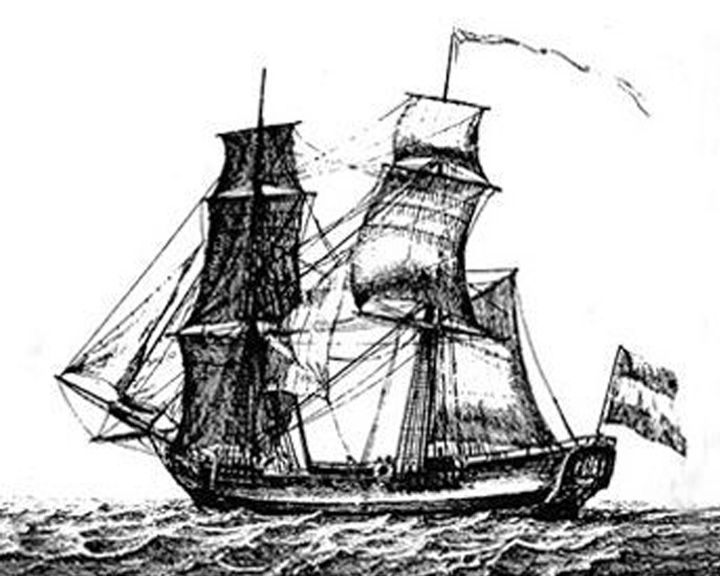 (Another (Another Vrouw Maria — Dutch merchant ship, wooden two-masted Treasure ship that went down with great artworks and jewelry for Catherine the Great. After its discovery in 1999, a Vrouw Maria Maritime Museum was established in Helsinki, Finland. LAUNCHED: 1770, circa → FATE: Sank October 3, 1771. |
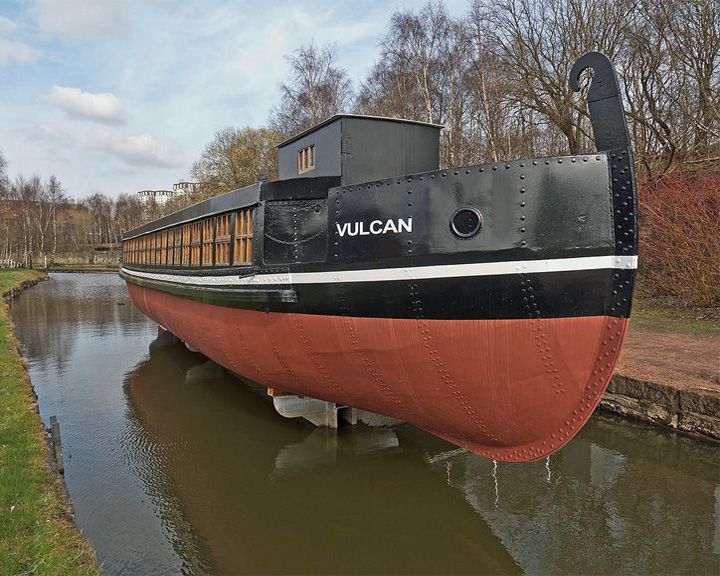 Vulcan — Scottish barge The original barge was the first all iron-hulled vessel to be built; the replica was the last Scottish vessel built using traditional riveting techniques. The iron canal boat named Trial, built by John Wilkinson in 1787, was not all iron. In 1988, a replica of the Vulcan was constructed. LAUNCHED: 1819, original ship; replica, 1985 → FATE: The original was sold for scrap 1873; the replica now sits decaying at Coatbridge, in North Lanarkshire, Scotland. |
|
|
Page 59
|
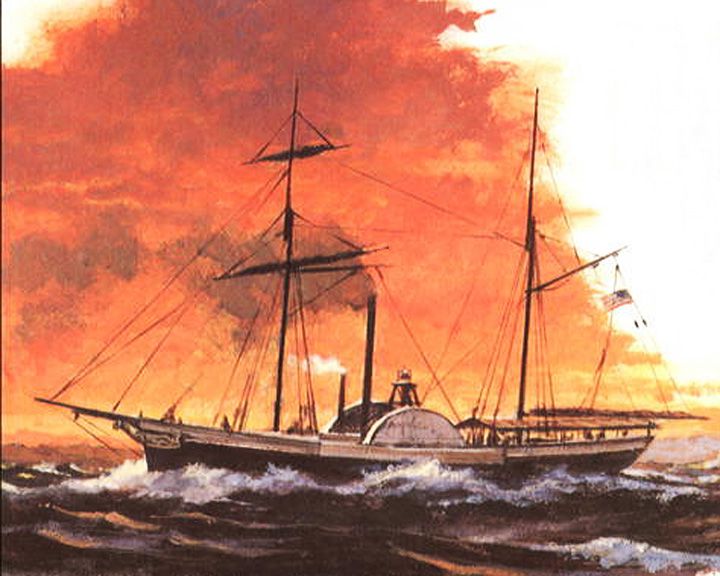 Walk-in-the-Water — American paddle steamboat, stern-wheeler with two masts First steamboat on Lake Erie and the eastern Great Lakes. Two large paddle boxes amidship housed her paddle wheels. LAUNCHED: 1818, August 23, first voyage → FATE: Grounded on the beach south of Buffalo, NY, October 31, 1821. |
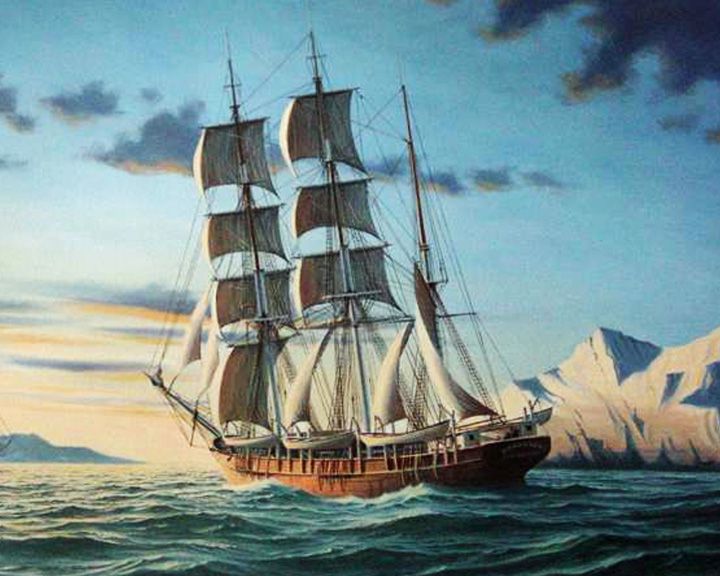 Wanderer — American whaling ship Last American whaling ship. The mast of the Wanderer stands as a flagpole in Boston Navy Yard, a few feet from where it was built. LAUNCHED: 1878 → FATE: Lost in a storm near Cuttyhunk Island, Massachusetts, on August 26, 1924. |
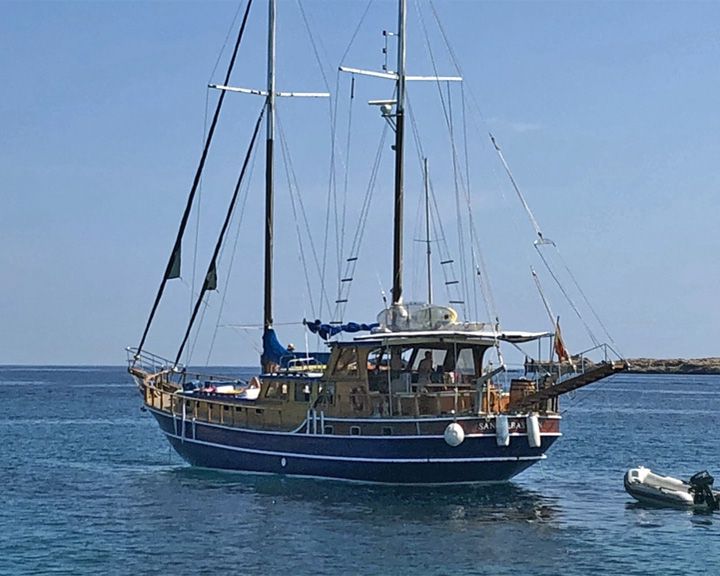 Wanderer — American yacht The boat in the 1992 comedy movie Captain Ron; starring Kurt Russell and Martin Short. The movie received mostly negative reviews. LAUNCHED: 1992 → FATE: Inconclusive. |
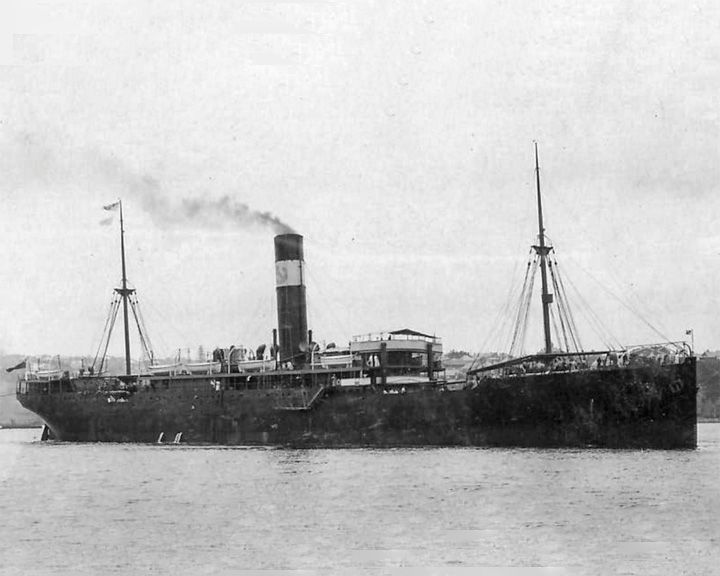 Waratah, SS — Australian steamship Known as the Australia's Titanic, she disappeared en route with 211 passengers and crew aboard. To this day, no trace of the ship has been found. LAUNCHED: 1908, October → FATE: Disappeared without trace south of Durban, July of 1909. |
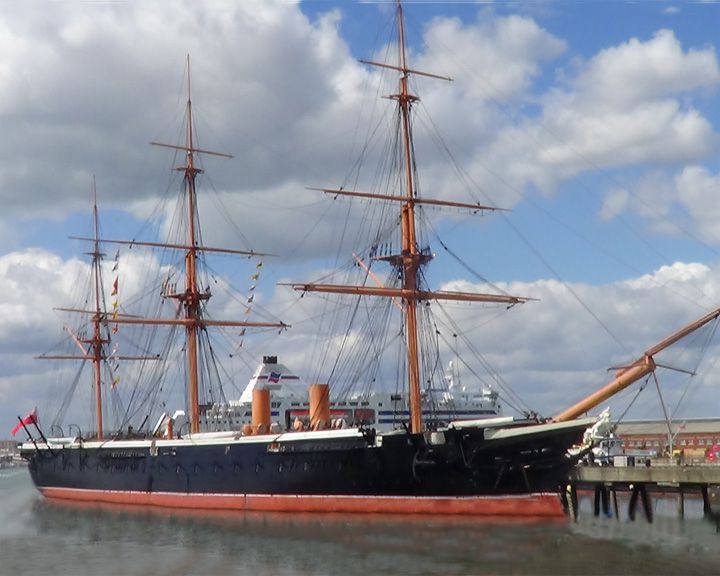 Warrior, HMS — British warship First British iron-hulled, armour-plated warship. She was the largest, fastest, most heavily armed and armored warship up to that time. LAUNCHED: 1860, December 18 → FATE: Currently berthed in Portsmouth, England as a museum. |
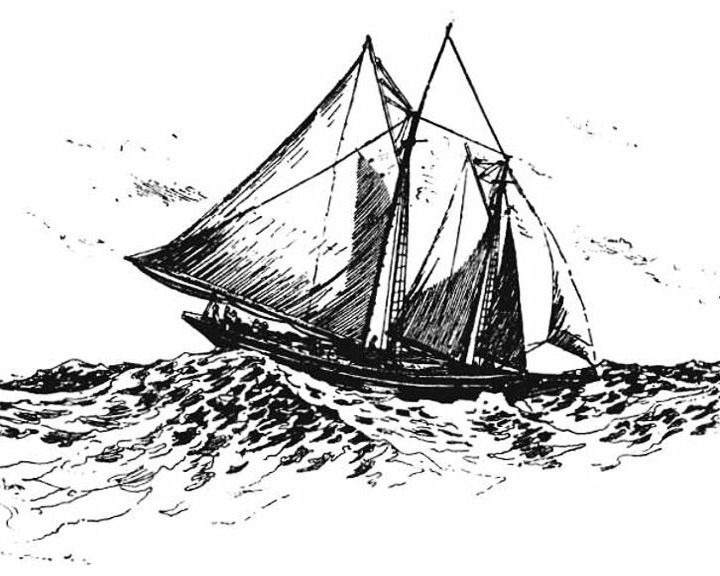 We're Here — American Schooner The fictional ship in the book and movie Captain Couraeous. Based on the 1897 book by Rudyard Kipling, it's a story of a boy and his adventures aboard a the ship. LAUNCHED: 1937 → FATE: Inconclusive. |
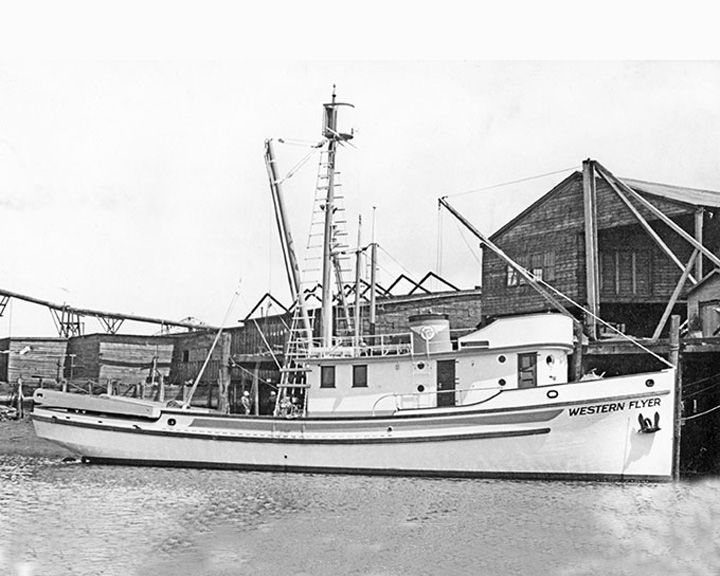 (Another (Another Western Flyer — American fishing boat Known for its use by John Steinbeck and Ed Ricketts in their 1940 expedition to the Gulf of California.. After Steinbeck's voyage, the ship was returned to commercial fishing, harvesting sardines, perch, and crab. Twice in 2012 the boat sprang leaks and sank and refloated each time. LAUNCHED: 1937, July 3 → FATE: Being restored to its historic glory by the Port Townsend Shipwrights Co-Op. |
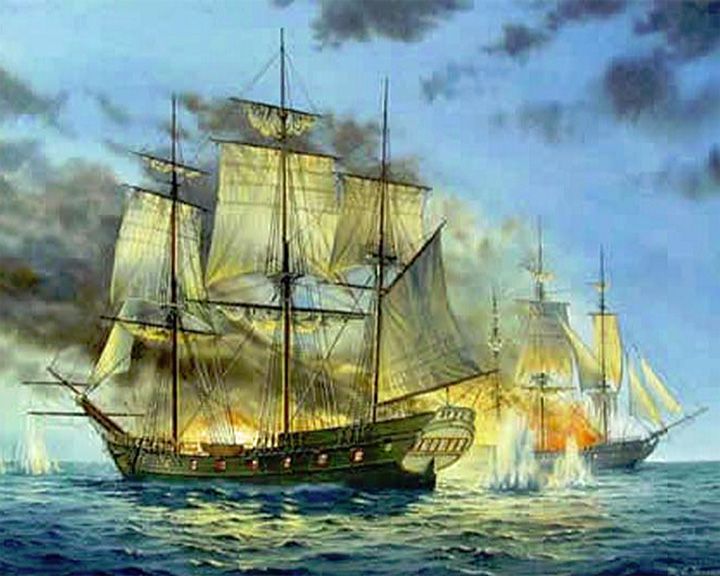 Whydah Gally — British sailing ship, square rigged three-masted Flagship of the pirate "Black Sam" Bellamy. The wreck was found in 1984. Artifacts from the wreck are on display at The Whydah Pirate Museum in Provincetown, Massachusetts. LAUNCHED: 1715 → FATE: Sank in a violent storm April 26, 1717. |
|
|
Page 60
|
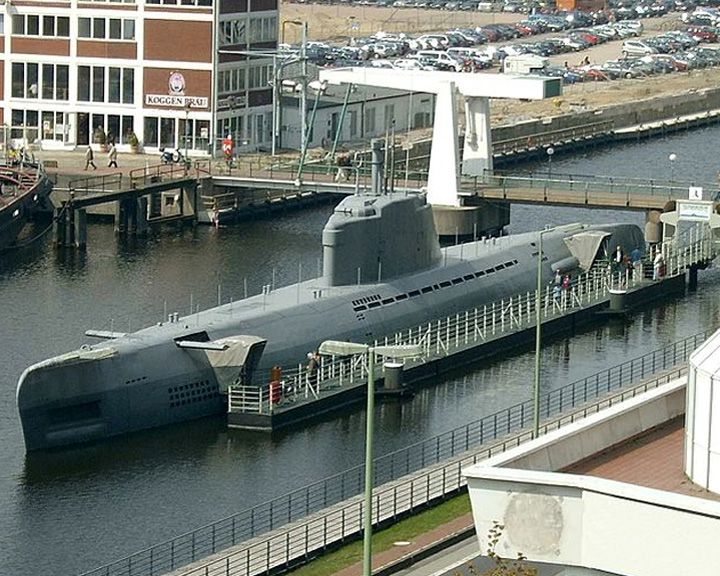 Wilhelm Bauer — German submarine, Type XXI One of several captured World War II Type XXI U-boats designed to operate primarily submerged. She is the only floating example of a this type of U-boat. LAUNCHED: 1945, January → FATE: Scuttled May 4, 1945; raised, June 1957; museum ship as of April 1984 at Bremerhaven, Germany. |
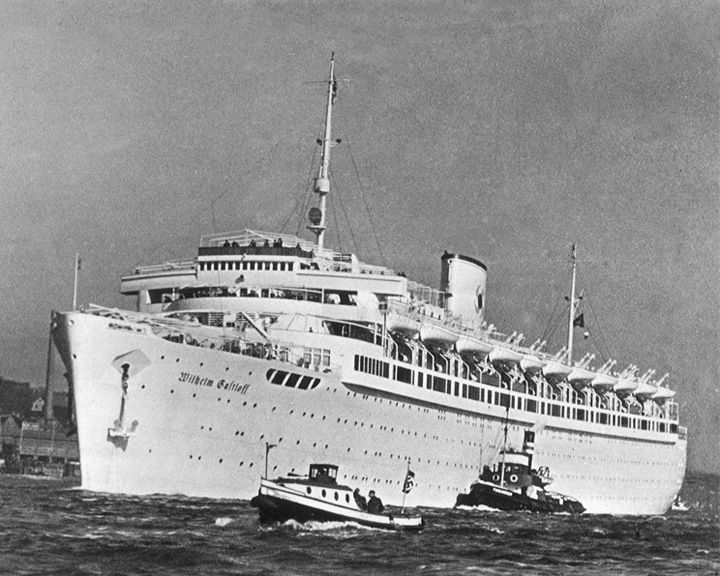 Wilhelm Gustloff, MV — German purpose-built cruise ship used as a hospital ship and troop ship in World War II Greatest ship disaster in recorded maritime history with an estimated 9,400 people were killed in the sinking. It was sunk by a Soviet submarine while participating in the evacuation of civilians, military personnel, and Nazi officials who were surrounded by the Red Army in East Prussia. LAUNCHED: 1937, May → FATE: Torpedoed in the Baltic Sea January 30, 1945. |
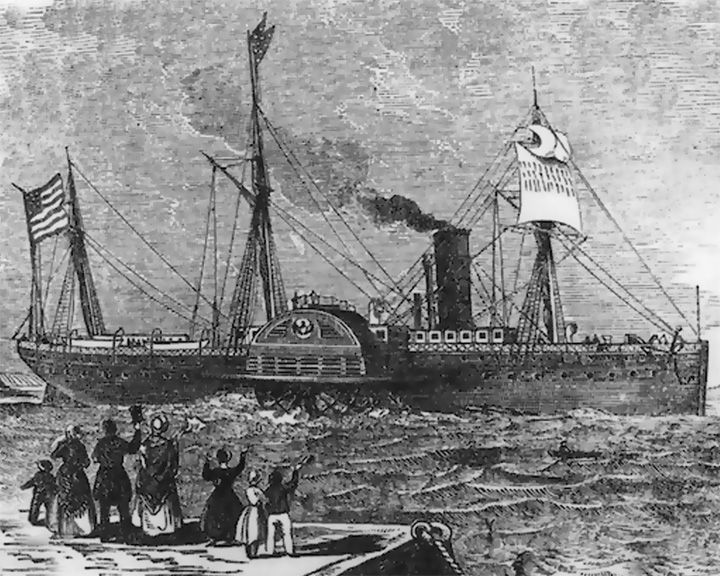 Winfield Scott, SS — American paddle steamer A sidewheel steamer that transported passengers and cargo between San Francisco and Panama in the early 1850s, during the California Gold Rush. She has been the object of numerous salvage operations since the crash and currently rests underwater as part of the Channel Islands National Park. LAUNCHED: 1850, October 5 → FATE: During a foggy night, crashed on Anacapa Island December 2, 1853. |
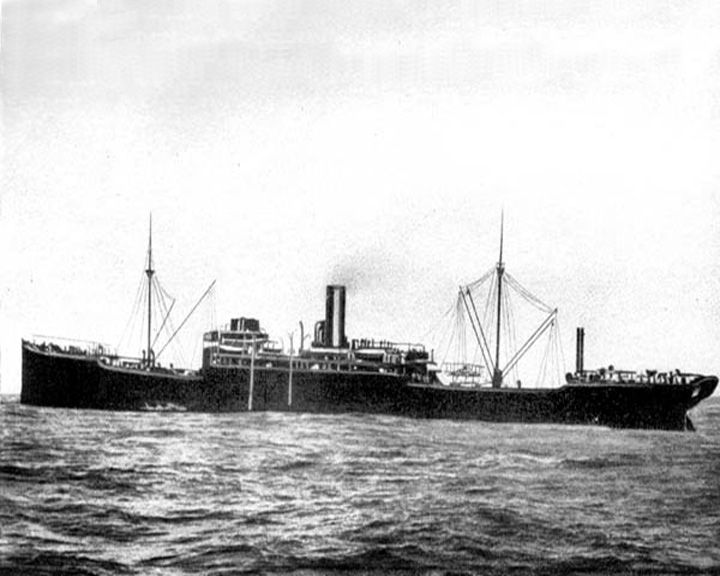 Wolf, SMS — German merchant raider Armed merchant raider of the German Navy in World War I and World War II. Not a fast ship, Wolf's advantage was deception, such as changing her appearance with fake funnels and masts, and false sides which kept her weapons hidden. LAUNCHED: 1913, March 18 → FATE: Out of service February, 1918; scrapped in 1931. |
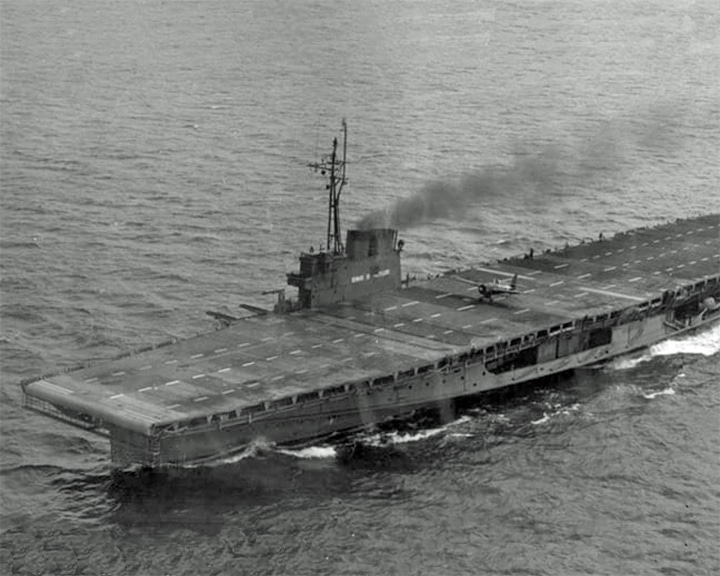 Wolverine, USS (originally Seeandbee) — American training ship Converted from a luxury side-wheel steamer cruise ship into a freshwater aircraft carrier serving in Lake Michigan for the advanced training of naval aviators in carrier take-offs and landings. As the Seeandbee, launched in 1912, she was the largest side-wheel steamer in the world at the time. LAUNCHED: 1942, August 12 → FATE: Sold for scrap December, 1947. |
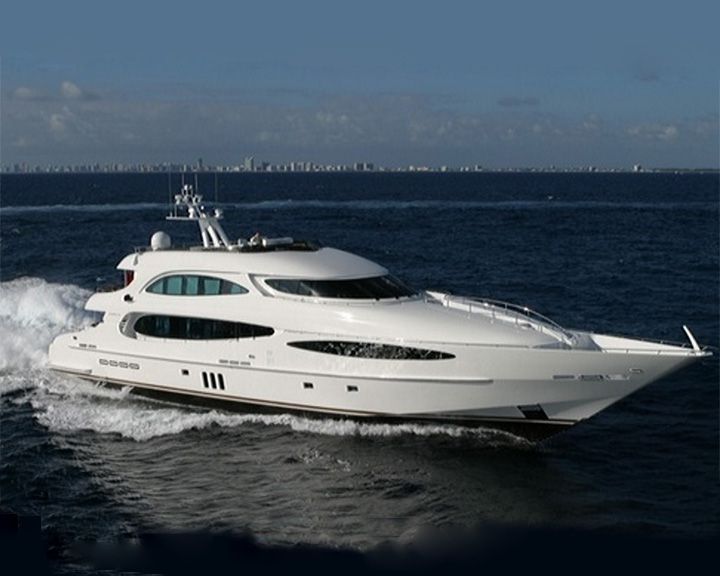 World is not Enough — American super yacht Fastest yacht in the world. She cruises at 50 knots and can reach speeds of up to 70 knots. LAUNCHED: 2005 → FATE: Still in use. |
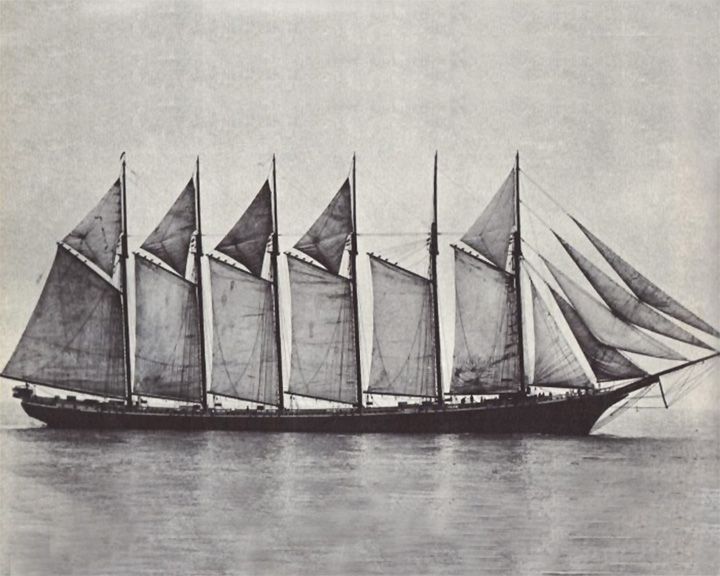 Wyoming — American six-masted schooner The largest known wooden ship ever built. Because of her length she tended to flex in heavy seas causing the long planks to twist and buckle, allowing water to seep into the hold. LAUNCHED: 1909, December 15 → FATE: Foundered in a storm in 1924 and sank off the coast of Cape Cod with the loss of all 14 crewmen. |
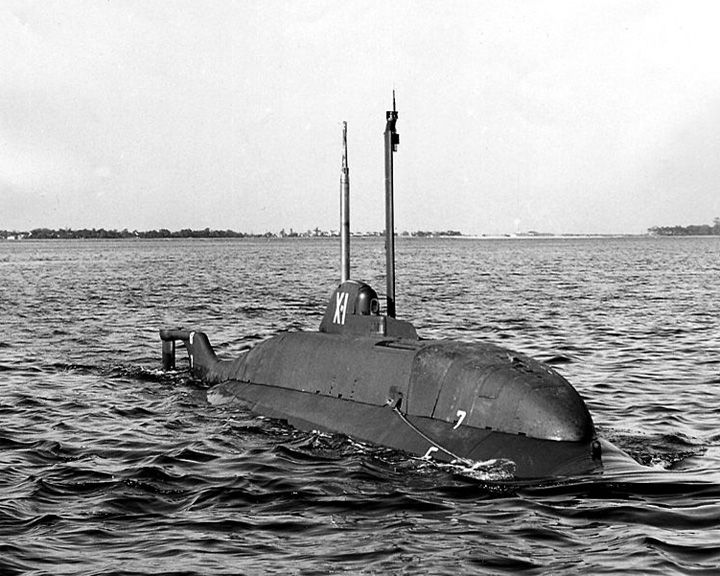 X-craft submarine — American miniature submarine Deployed September, 1943 against German warships based in Norway. These midget subs would be towed to their target area by a full-size submarine. Of the 20 built, seven were lost, 12 scuttled or scrapped. LAUNCHED: 1943 → FATE: Only one has survive and is on display at the Royal Navy Submarine Museum. |
|
|
Page 61
|
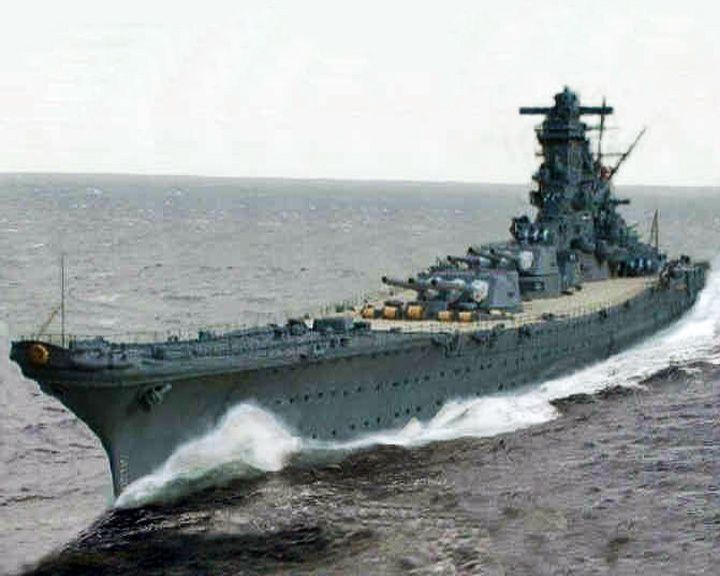 Yamato — Japanese battleship The largest, heaviest, and most powerful battleships ever constructed. She was the flagship of Admiral Isoroku Yamamoto during World War II. LAUNCHED: 1940, August 18 → FATE: Sunk north of Okinawa April 7, 1945. |
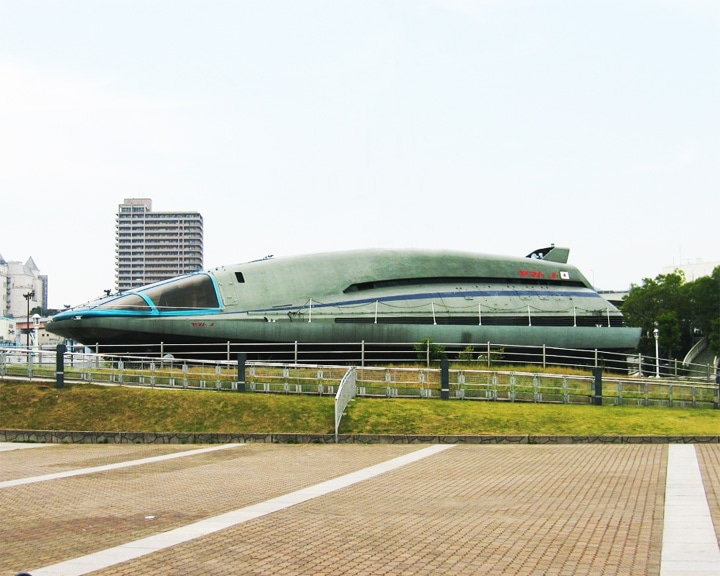 Yamato 1 — Japanese experimental ship She used magnetohydrodynamic drive s (MHDDs) driven by liquid helium-cooled superconductors . The ship, which had no moving parts, was successfully operated in Kobe harbor in June 1992. LAUNCHED: 1991 → FATE: She was on display at the Kobe Maritime Museum but was demolished in 2016. |
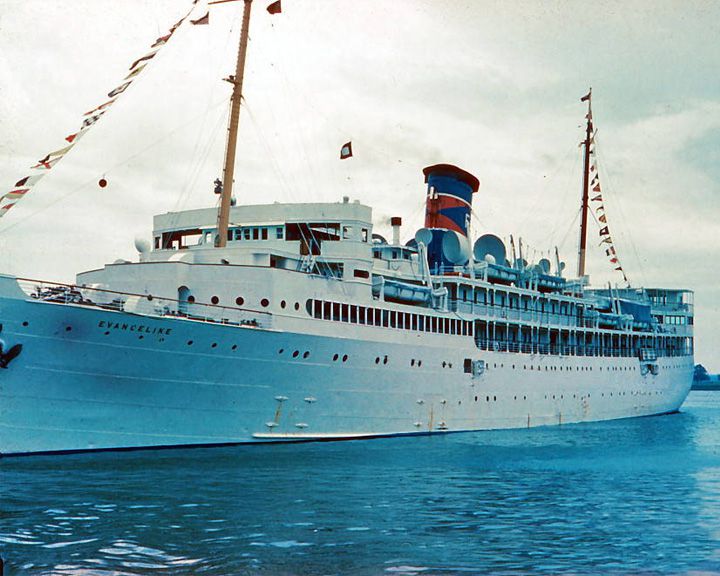 Yarmouth Castle, SS — American cruise ship Fire left 90 of 552 on board died. Her loss lead to the Safety of Life at Sea law. During World War II, she served as a troop ship and hospital ship in the Pacific. LAUNCHED: 1927 → FATE: Sunk in a blaze on the way to Nassau November 13, 1965. |
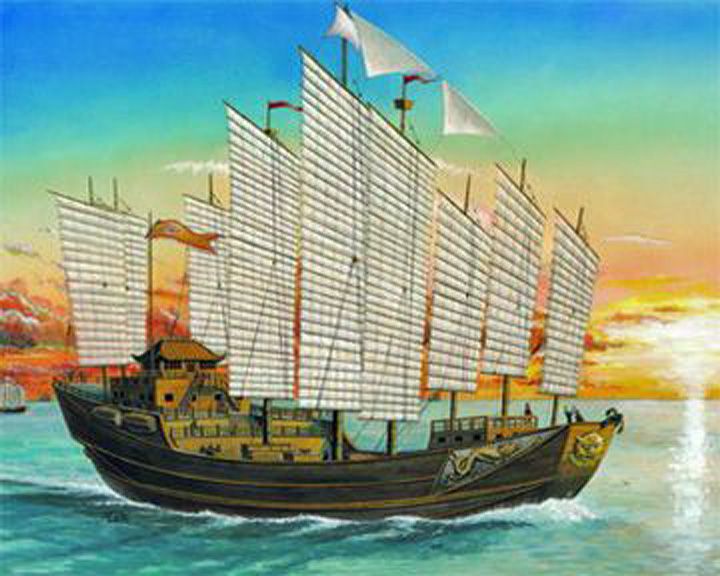 (Another (Another Zheng He's fleet — Chinese treasure ship The fleet's voyages came before most of the famous European voyages of discovery. Zheng He's seven expeditions were designed to establish a Chinese presence in the Indian Ocean and control trade. The ships dwarfed European ships of that century. LAUNCHED: 1405, first voyage → FATE: Last voyage, 1430. |
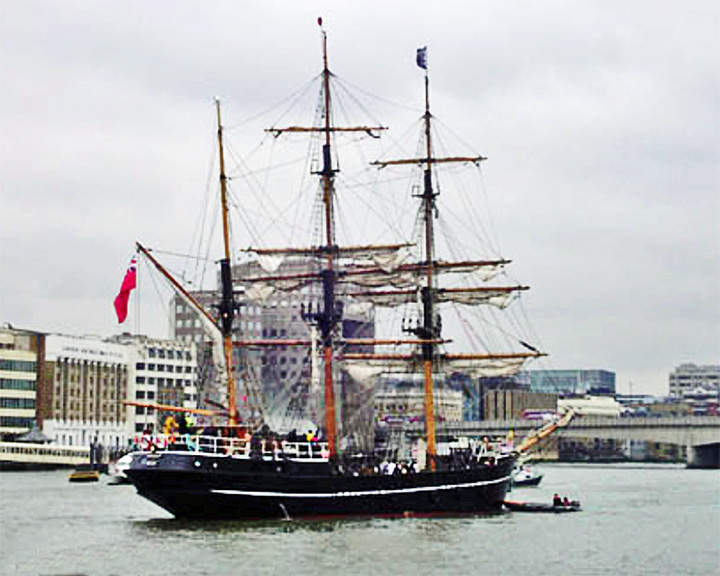 Zong — British square rigger slave ship Infamous for the 1781 massacre of 132 sick and dying slaves thrown overboard so the ship's owners could collect on their cargo insurance. The Zong had been a Dutch vessel the Zorgue seized by the British in 1781 off West Africa, along with 244 Africans on board. LAUNCHED: 1776, or ealier → FATE: Unknown. |
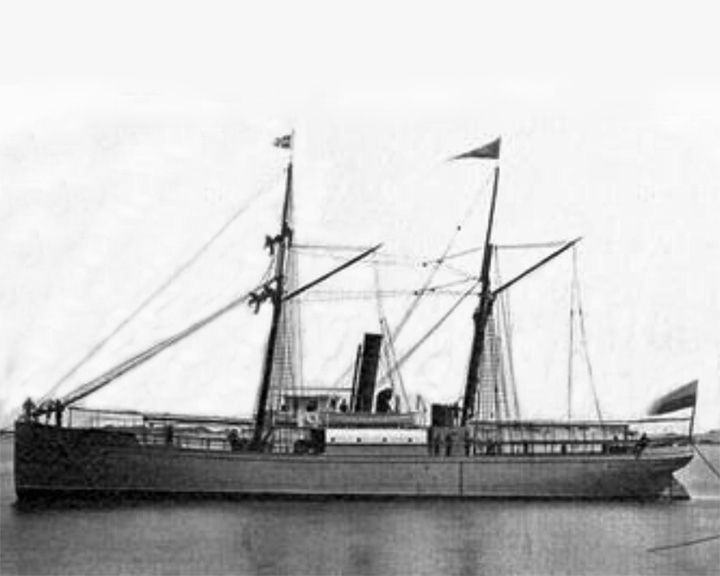 Zoroaster — Swedish oil tanker The first successful oil tanker, carrying the kerosene cargo in two iron tanks in her hull instead of many separate wooden casks. She was built by Ludwig Nobel, brother of Alfred who created The Nobel Prize. LAUNCHED: 1878 → FATE: Unknown. |
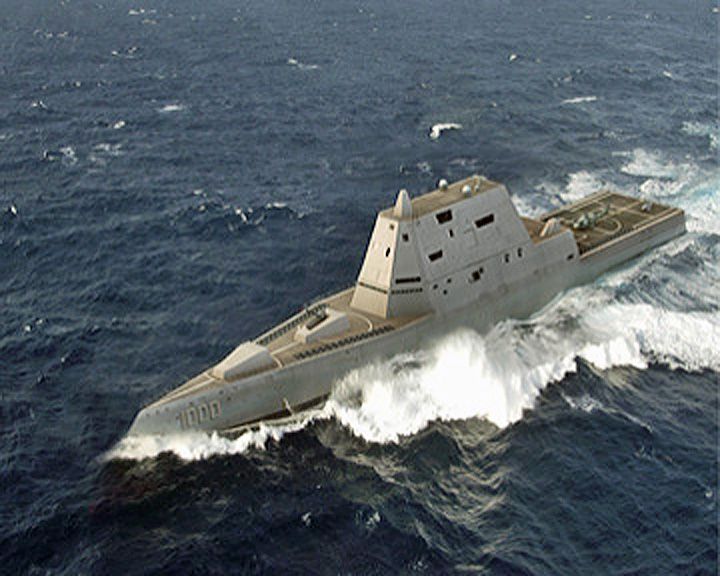 Zumwalt, USS — American guided missile destroyer Designed with stealth capabilities, having a radar cross-section akin to a fishing boat. Commanding officer is Captain James A. Kirk, coincidentially the same as the Star Trek captain. LAUNCHED: 2013, October → FATE: Currently at sea. |
The number of All Countries Ships and Boats listed is 487 The contents of this page are available under the Creative Commons Attribution-Share Alike 3.0 Unported license and the GNU Free Documentation License (GFDL). |
|
First Ship on each page
| |
| Page | Ship Name (Country and Type) |
| 1. | A. J. Goddard (American paddle steamer) |
| 2. | African Queen (American steamboat) |
| 3. | Amethyst, HMS (British modified Black Swan class sloop) |
| 4. | Argus, HMS (British aircraft carrier) |
| 5. | Atlantic, RMS (English ocean liner) |
| 6. | Baychimo, SS (German cargo ship) |
| 7. | Birthday Present (American super-yacht) |
| 8. | Bonhomme Richard, USS (American frigate) |
| 9. | Buford, USAT (American cargo) |
| 10. | Carroll A. Deering (American schooner) |
| 11. | Charlotte Dundas (Scottish steamboat) |
| 12. | Color Magic (Norwegian cruise ferry) |
| 13. | Constitution, USS (American frigate) |
| 14. | Darling, HMS (British torpedo boat destroyer) |
| 15. | Discovery (British barque) |
| 16. | Eastland, SS (American steamship) |
| 17. | Empress of Ireland (Canadian ocean liner) |
| 18. | Etoile du Roy (British frigate) |
| 19. | Floating Theater (American caravel) |
| 20. | Furious, HMS (British battlecruiser) |
| 21. | Ghost, stealth ship (American super-cavitating) |
| 22. | Golden Hind (English galleon) |
| 23. | Great Western, SS (British paddle steamboat) |
| 24. | Hannibal, USS (American collier) |
| 25. | Higgins boat (American troop landing craft) |
| 26. | Hunley, H.L. (American Confederate submarine) |
| 27. | Intrepid, USS (American aircraft carrier) |
| 28. | Jylland, HDMS (Danish screw-propelled steam frigate) |
| 29. | Kin Lung, SS (Chinese tramp steamer) |
| 30. | La Amistad (Spanish schooner) |
| 31. | Laffey, USS (American Allen M. Sumner-class destroyer) |
| 32. | Lightning, HMS (British torpedo boat) |
| 33. | Marine Electric (American bulk carrier) |
| 34. | Mauretania, RMS (British ocean liner) |
| 35. | Mighty Servant 2 (American heavy lift ship) |
| 36. | Morituri (German cargo ship) |
| 37. | Napoléon, (Le) (French battleship) |
| 38. | Ning Po (Chinese junk) |
| 39. | Ocean Dover, MV (Australian livestock carrier) |
| 40. | Orion, RMS (British ocean liner) |
| 41. | Pequod (American whaling ship) |
| 42. | Ponce, USS (American amphibious assault ship) |
| 43. | Princess Alice (British paddle steamer) |
| 44. | Proteus (American catamaran) |
| 45. | Rattler, HMS (British sloop made of wood with metal frame) |
| 46. | Robert E. Perry, SS (American liberty ship) |
| 47. | São Martinho (Portuguese galleon) |
| 48. | San Pablo (American gunboat) |
| 49. | Sea Shadow (American stealth warship) |
| 50. | Seraph, HMS (British submarine) |
| 51. | Solar Sailor (Australian passenger ferry) |
| 52. | Staten Island Ferry (American passenger ferry) |
| 53. | Sydney, HMAS (Australia Leander-class light cruiser) |
| 54. | The World, MS (Swedish cruise ship) |
| 55. | Toya Maru (Japanese train ferry) |
| 56. | U-96 (German German Type VIIC submarine) |
| 57. | Vandenberg, USAFS (American transport ship) |
| 58. | Victory, HMS (English first-rate) |
| 59. | Walk-in-the-Water (American paddle steamboat) |
| 60. | Wilhelm Bauer (German submarine) |
| 61. | Yamato (Japanese battleship) |
All Countries | |
| 1. | A. J. Goddard American paddle steamer |
| 2. | Achille Lauro Dutch cruise ship |
| 3. | Admiral, SS American river steamboat |
| 4. | Adriyatik, MS UND Turkish cargo ship |
| 5. | Adventure Galley English galley |
| 6. | AE1, HMAS Australia E-class submarine |
| 7. | Aeolus British cruise ship |
| 8. | African Queen American steamboat |
| 9. | Alabama, CSS American Confederate screw sloop-of-war |
| 10. | Albacore, USS American submarine |
| 11. | Albert M. Boe American liberty ship |
| 12. | Alligator American submarine |
| 13. | Alvin, DSV American research vessel |
| 14. | America American racing yacht |
| 15. | American Queen American river paddle steamboat |
| 16. | Amethyst, HMS British modified Black Swan class sloop |
| 17. | Ancon, SS American steamship |
| 18. | Andrea Doria, SS Italian ocean liner |
| 19. | Andrea Gail American fishing vessel |
| 20. | Antonia Graza Italian ocean liner |
| 21. | Archimedes, SS British steamship |
| 22. | Argo Greek galley |
| 23. | Argonaut American cabin cruiser |
| 24. | Argus, HMS British aircraft carrier |
| 25. | Ariel English clipper ship |
| 26. | Arizona, USS American battleship |
| 27. | Ark Royal, HMS English galleon |
| 28. | Artemis American sloop |
| 29. | Arthur Foss American tugboat |
| 30. | Asgard British yacht |
| 31. | Association, HMS British second-rate ship of the line |
| 32. | Atlantic, RMS English ocean liner |
| 33. | Atlantis German auxillary cruiser |
| 34. | Australia II Australian racing yacht |
| 35. | Azzam Emirati luxury yacht |
| 36. | B-39 Russian foxtrot-class submarine |
| 37. | Balao, USS American submarine |
| 38. | Ballantrae, USS American Town-class destroyer |
| 39. | Batavia Dutch galeon |
| 40. | Baychimo, SS German cargo ship |
| 41. | Beagle, HMS English sloop |
| 42. | Becuna, USS American submarine |
| 43. | Belfast, HMS British town-class cruiser |
| 44. | Belinda, USS American attack transport |
| 45. | Belle of Louisville American steamboat |
| 46. | Birkenhead, HMS British frigate |
| 47. | Birmingham, USS American scout cruiser |
| 48. | Birthday Present American super-yacht |
| 49. | Bismarck German battleship |
| 50. | Black Pearl American yacht |
| 51. | Black Widow Russian foxtrot-class submarine |
| 52. | Bluebird K7 British hydroplane |
| 53. | Bluenose Canadian schooner |
| 54. | Blyshawica, ORP Polish destroyer |
| 55. | Boka Vanguard Netherlands heavy-lift ship |
| 56. | Bonhomme Richard, USS American frigate |
| 57. | Boudeuse French frigate |
| 58. | Bounty (replica) Canadian collier |
| 59. | Bounty, HMS English collier |
| 60. | Bow Mariner Norwegian tanker |
| 61. | Bras d'Or, HMCS Canadian hydrofoil |
| 62. | Britannia, HMY British yacht |
| 63. | Britannic, HMHS British ocean liner |
| 64. | Buford, USAT American cargo |
| 65. | C.A. Thayer American three-masted schooner |
| 66. | Caine, USS American destroyer minesweeper |
| 67. | Cairo, USS American ironclad gunboat |
| 68. | Calypso, RV American minesweeper |
| 69. | Campbeltown, HMS American Wickes-class destroyer |
| 70. | Cap Arcona, SS German ocean liner |
| 71. | Carpathia British ocean liner |
| 72. | Carroll A. Deering American schooner |
| 73. | Cassin Young, USS American destroyer |
| 74. | Cavalier, HMS British C-class Destroyer |
| 75. | Central America, SS American paddle steamboat |
| 76. | Cerberus, HMVS Australian breastwork monitor |
| 77. | Challenger, HMS British corvette |
| 78. | Champion of the Seas English clipper ship |
| 79. | Charles W. Morgan American whaling ship |
| 80. | Charlotte Dundas Scottish steamboat |
| 81. | Christina O Greek luxury yacht |
| 82. | City of Adelaide English clipper ship |
| 83. | City of Benares, SS British steam passenger ship |
| 84. | Claremore Queen American steamboat |
| 85. | Clermont American steamboat |
| 86. | Clotilda American two-masted schooner |
| 87. | Cole, USS American aegis-equipped |
| 88. | Color Magic Norwegian cruise ferry |
| 89. | Colossus, HMS British third-rate ship of the line |
| 90. | Columbia Rediviva American full-rigged |
| 91. | Comet, PS British paddle steamer |
| 92. | Compass Rose British Flower-class corvette |
| 93. | Conception, MV American dive boat |
| 94. | Constellation, USS American sloop-of-war |
| 95. | Constitution, SS American ocean liner |
| 96. | Constitution, USS American frigate |
| 97. | Costa Concordia Italian cruise ship |
| 98. | Cotopaxi, SS American bulk carrier |
| 99. | Curacoa, HMS British light-cruiser |
| 100. | Cusk, USS American submarine |
| 101. | Cutty Sark English clipper ship |
| 102. | Daigo Fukuryu Maru Japanese fishing boat |
| 103. | Daimlier German motorboat |
| 104. | Darling, HMS British torpedo boat destroyer |
| 105. | David, CSS American Confederate torpedo boat |
| 106. | Demologos American paddle steamers |
| 107. | Derbyshire, MV British cargo ship |
| 108. | Deutschland German battleship |
| 109. | Deutschland, SMS German battleship |
| 110. | Deutschland, submarine German submarine |
| 111. | Devastastion, HMS British Devastation-class ironclad |
| 112. | Discovery British barque |
| 113. | Doña Paz, MV Japanese ferry |
| 114. | Dolpin, USS American V-class submarine |
| 115. | Dreadnought, HMS British dreadnought battleship |
| 116. | Driver, HMS British paddle sloop |
| 117. | Drum, USS American Gato-class submarine |
| 118. | Duyfken Dutch barque |
| 119. | Earnslaw, TSS New Zealand ferry |
| 120. | Eastland, SS American steamship |
| 121. | Eclipse Russian luxury yacht |
| 122. | Edmund Fitzgerald, SS American lake cargo ship |
| 123. | El Faro, SS American container ship |
| 124. | Eldridge, USS American destroyer escort |
| 125. | Emma Maersk Danish container ship |
| 126. | Empire Windrush, MV German cruise ship |
| 127. | Empress of China American three-masted, square-rigged sailing ship |
| 128. | Empress of Ireland Canadian ocean liner |
| 129. | Endeavour, HMS British collier |
| 130. | Endurance Norwegian barquentine |
| 131. | Enterprise, USS American aircraft carrier |
| 132. | Eos American three-masted Bermuda rigged |
| 133. | Esmeralda Chilean steam corvette |
| 134. | Essex American barque |
| 135. | Estonia, MS German cruise ferry |
| 136. | Etoile du Roy British frigate |
| 137. | Eureka American paddle steamboat |
| 138. | Ever Given Japanese container ship |
| 139. | Exodus 1947 American packet steamer |
| 140. | Exxon Valdez American oil tanker |
| 141. | Faith, SS American Concrete |
| 142. | Felicity Ace Japanese roll-on/roll-off cargo ship |
| 143. | Fenian Ram American submarine |
| 144. | Floating Theater American caravel |
| 145. | Flying Cloud American clipper |
| 146. | Flying Dutchman Dutch sailing ship |
| 147. | Flying Enterprise American cargo ship |
| 148. | Fram Norwegian schooner |
| 149. | Francisco, HSC Argentine high-speed catamaran |
| 150. | Frigorifique French steamship |
| 151. | Fujikawa Maru Japanese cargo ship |
| 152. | Furious, HMS British battlecruiser |
| 153. | Galeb Croatian yacht |
| 154. | Gaspée English single-masted sloop-of-war |
| 155. | Gaul English fishing trawler |
| 156. | General Slocum American river paddle steamboat |
| 157. | Georgios Averof Greek armored cruiser |
| 158. | Gerda III Danish lighthouse tender |
| 159. | Ghost American schooner |
| 160. | Ghost, stealth ship American super-cavitating |
| 161. | Gjøa Norwegian sloop |
| 162. | Glencairn, SS British tramp steamer |
| 163. | Gloire French ocean-going ironclad |
| 164. | Glomar Explorer American deep sea research vessel |
| 165. | Gloriana English royal barge |
| 166. | Goeben, SMS German battlecruiser |
| 167. | Gokstad Viking clinker-built |
| 168. | Golden Hind English galleon |
| 169. | Golden Hinde English galleon |
| 170. | Goliath, RMS British ocean liner |
| 171. | Graf Spee, Admiral German pocket battleship |
| 172. | Grandcamp, SS American liberty ship |
| 173. | Great Britain, SS British steamship |
| 174. | Great Eastern, SS British iron paddle steamboat |
| 175. | Great Republic American clipper |
| 176. | Great Western, SS British paddle steamboat |
| 177. | Gribshunden Danish warship |
| 178. | Hōshō Japanese aircraft carrier |
| 179. | HA. 19 Japanese midget submarine |
| 180. | Half Moon Dutch flyboat |
| 181. | Halibut, USS American attack submarine |
| 182. | Hammersly, HMAS Australian Armidale-class patrol boat |
| 183. | Hannah, USS American schooner |
| 184. | Hannibal, USS American collier |
| 185. | HD-4 American hydrofoil |
| 186. | Henrietta French steamboat |
| 187. | Henry B. Smith, SS American lake cargo ship |
| 188. | Herald of Free Enterprise, MS British roll-on/rolll-off ferry |
| 189. | Hermione, HMS British frigate |
| 190. | Hero, HMAS British Leander-class frigate |
| 191. | Hewell, USS American cargo ship |
| 192. | Higgins boat American troop landing craft |
| 193. | Holland I, HMS British submarine |
| 194. | Holland, USS (SS-1) American submarine |
| 195. | Honey Fitz American yacht |
| 196. | Hood, HMS British battle cruiser |
| 197. | Hotspur, HMS British sloop-of-war |
| 198. | Houston, USS (CA-30) American cruiser |
| 199. | Huáscar Peruvian iron-clad |
| 200. | Hunley, H.L. American Confederate submarine |
| 201. | I-400 Japanese submarine |
| 202. | Icon of the Seas American cruise ship |
| 203. | Ideal X, SS American cargo ship |
| 204. | Ile de France, SS French ocean liner |
| 205. | Independence, USS American trimaran |
| 206. | Indiana, USS (BB-1) American battleship |
| 207. | Indianapolis, USS American Portland-class |
| 208. | Intrepid, USS American aircraft carrier |
| 209. | Investigator, HMS British collier |
| 210. | Invincible, HMS British battlecruiser |
| 211. | Iowa, USS American fast battleship |
| 212. | Jiaolong Chinese research vessel |
| 213. | John Adams, USS American frigate |
| 214. | John W. Brown, SS American liberty ship |
| 215. | Joyita American luxury yacht |
| 216. | Jylland, HDMS Danish screw-propelled steam frigate |
| 217. | K-13 British K-class submarine |
| 218. | Kalakala American ferry |
| 219. | Kalmar Nyckel Swedish full-rigged pinnace |
| 220. | Kathleen and May British three masted schooner |
| 221. | Kaz II Australian catamaran |
| 222. | Keying, Junk Chinese junk |
| 223. | Kiangya, SS Chinese steamship |
| 224. | Kin Lung, SS Chinese tramp steamer |
| 225. | Kingston II American tugboat |
| 226. | Kirk, USS American destroyer escort, Knox-class |
| 227. | Kon Tiki Norwegian raft |
| 228. | Kursk, K-141 Russian nuclear submarine |
| 229. | Kursura, INS Indian Kalvari-class |
| 230. | Kuru, SS Finnish steamship |
| 231. | L'Hydroptère French speed sailboat |
| 232. | La Amistad Spanish schooner |
| 233. | La Belle French barque |
| 234. | La Gloire French battleship |
| 235. | Labrador, CCGS Canadian Wind-class icebreaker |
| 236. | Laconia, RMS British ocean liner |
| 237. | Lady Elgin, PS American paddle steamer |
| 238. | Lady Elizabeth British 3-masted iron barque |
| 239. | Lady Lovibond English schooner |
| 240. | Laffey, USS American Allen M. Sumner-class destroyer |
| 241. | Lancastria, RMS British ocean liner |
| 242. | Langley, USS American aircraft carrier |
| 243. | LCT7074, HM British landing craft, tank (LCT) |
| 244. | Leitha, SMS Austro-Hungarian river monitor |
| 245. | Lexington American steamboat |
| 246. | Liberté, SS German ocean liner |
| 247. | Liemba, MV German ferry |
| 248. | Lightning, HMS British torpedo boat |
| 249. | Lusitania, RMS British ocean liner |
| 250. | München, MS German LASH carrier |
| 251. | Maersk Alabama, MV American container ship |
| 252. | Maggie British Clyde puffer |
| 253. | Maine, USS American battleship |
| 254. | Majestic American paddle steamboat |
| 255. | Maltese Falcon American full-rigged |
| 256. | Marine Electric American bulk carrier |
| 257. | Mars Swedish three masted warship |
| 258. | Mary Celeste American brigantine |
| 259. | Mary Deare American steamship |
| 260. | Mary Rose English carrack-type |
| 261. | Maryland Dove American merchant vessel |
| 262. | Massachusetts, USS American South Dakota class battleship |
| 263. | Matthew English caravel |
| 264. | Mauretania, RMS British ocean liner |
| 265. | Maxim Gorky Russian cruise ship |
| 266. | Mayflower English galleon |
| 267. | Mayflower, USS (PY-1) American yacht |
| 268. | Medusa French frigate |
| 269. | Medusa, HMS British Harbour defence motor launch |
| 270. | Merchant Royal English merchant ship |
| 271. | Meredith Victory, SS American cargo ship |
| 272. | Mighty Servant 2 American heavy lift ship |
| 273. | Mikasa Japanese pre-dreadnought battleship |
| 274. | Minnow, S.S. American express cruiser |
| 275. | Mirny Russian sloop-of-war |
| 276. | Missouri, USS American battleship |
| 277. | Monitor, USS American ironclad warship |
| 278. | Mont Blanc, SS French cargo ship |
| 279. | Monte Carlo, SS American concrete ship |
| 280. | Morituri German cargo ship |
| 281. | Morro Castle, SS American cruise ship |
| 282. | Moshulu Scottish barque |
| 283. | Moskva Russian guided missile cruiser |
| 284. | Mount Hood, USS American ammunition ship |
| 285. | MTB 102 British motor torpedo boat |
| 286. | My AdyGil New Zealand wave-piercing |
| 287. | Myron, SS American wooden steamship |
| 288. | Napoléon, (Le) French battleship |
| 289. | Nathan James, USS American guided missile destroyer |
| 290. | Nautilus, USS American nuclear submarine |
| 291. | Nemesis British steam and sail powered warship |
| 292. | New Jersey, USS American battleship |
| 293. | Niantic American whaling ship |
| 294. | Nimitz, USS American aircraft carrier |
| 295. | Nina, (La) Spanish caravel |
| 296. | Ning Po Chinese junk |
| 297. | Noah's Ark Ancient ferry |
| 298. | Norge, SS Norwegian, then Danish ocean liner |
| 299. | Normac, MS American ferry |
| 300. | Norman Atlantic, MS Italian roll-on/roll-off car ferry |
| 301. | Normandie, SS French ocean liner |
| 302. | Nuestra Señora de las Mer Spanish frigate |
| 303. | Numancia Spanish broadside ironclad |
| 304. | Ocean Dover, MV Australian livestock carrier |
| 305. | Oceanos, MTS Greek cruise ship |
| 306. | Octavius English schooner |
| 307. | Olympia, USS American protected cruiser |
| 308. | Olympias Greek trireme |
| 309. | Oneida American yacht |
| 310. | Onrust Dutch yacht |
| 311. | Orient French ship of the line |
| 312. | Orion, RMS British ocean liner |
| 313. | Oriskany, USS American aircraft carrier |
| 314. | Ostfriesland, SMS German battleship |
| 315. | Ourang Medan, SS Dutch cargo ship |
| 316. | Pacific Princess American cruise ship |
| 317. | Pamir German barque |
| 318. | Panay, USS American river gunboat |
| 319. | Patrick Henry, SS American liberty ship |
| 320. | Pequod American whaling ship |
| 321. | Peral Spanish submarine |
| 322. | Perserverance American steam boat |
| 323. | Pewabic, SS American lake steamship |
| 324. | Pilar American fishing boat |
| 325. | Pilot Russian icebreaker |
| 326. | Pinta, (La) Spanish three masted caravel |
| 327. | Pioneering Spirit Swiss catamaran |
| 328. | Ponce, USS American amphibious assault ship |
| 329. | Portland, PS American sidewheel steamer |
| 330. | Poseidon, SS American cruise ship |
| 331. | Potemkin Russian battleship |
| 332. | President American steamboat |
| 333. | President, SS British paddle steamship |
| 334. | Preußen German windjammer |
| 335. | Prince of Wales, HMS British battleship |
| 336. | Princess Alice British paddle steamer |
| 337. | Princess Mafalda, SS Italian ocean liner |
| 338. | Princess Sophia, SS Canadian passenger ship |
| 339. | Principessa Jolanda, SS Italian ocean liner |
| 340. | Prineton, USS American screw steam warship |
| 341. | Prins Willem replica Dutch brig |
| 342. | Prinz Eugen German Admiral Hipper-class heavy cruiser |
| 343. | Prinzessin Victoria Luise German passenger ship |
| 344. | Proteus American catamaran |
| 345. | PT 109 American motor torpedo boat |
| 346. | PT-73 American PT boat |
| 347. | Quaker City, USS American paddle steamship |
| 348. | Queen Anne's Revenge English sloop |
| 349. | Queen Elizabeth, HMS British aircraft carrier |
| 350. | Queen Elizabeth, RMS British ocean liner |
| 351. | Queen Mary, RMS British ocean liner |
| 352. | Rattler, HMS British sloop made of wood with metal frame |
| 353. | Red Rover, USS American Confederate paddle steamboat |
| 354. | Resolution, HMS British Collier |
| 355. | Reuben James, USS American destroyer |
| 356. | Rhone, RMS British packet ship |
| 357. | Riptide American yacht |
| 358. | River Queen American sidewheel steamer |
| 359. | Robert E. Lee American paddle steamboat |
| 360. | Robert E. Perry, SS American liberty ship |
| 361. | Rochambeau American frigate |
| 362. | Rocknes, MV Dutch rock dumping vessel |
| 363. | Royal Charles, HMS British first-rate three-decker ship of the line |
| 364. | Royal Clipper German tall ship |
| 365. | Royal George, HMS English first-rate ship of the line |
| 366. | Royal Oak, HMS British Battleship |
| 367. | São Gabriel Portugese caravel |
| 368. | São Martinho Portuguese galleon |
| 369. | Sailrocket 2 Australian speed sailboat |
| 370. | Saint John Paul II, MV Maltese catamaran |
| 371. | Salem Express, MV French roll-on/roll/off car ferry |
| 372. | Saluda American river paddle steamboat |
| 373. | San Capador, SS American cruise ship |
| 374. | San José Spanish galleon |
| 375. | San Juan Bautista Japanese galleon |
| 376. | San Pablo American gunboat |
| 377. | Santísima Trinidad Spanish ship of the line |
| 378. | Santa Maria Spanish carrack |
| 379. | Santana American commuter yacht |
| 380. | Savannah, SS American paddle steamship |
| 381. | Scandinavian Star, MS Scandinavian ferry |
| 382. | Scorpion, USS American Skipjack-class nuclear submarine |
| 383. | Sea Queen American sport-fishing boat |
| 384. | Sea Shadow American stealth warship |
| 385. | Sea Tiger, USS American submarine |
| 386. | Sea Venture English merchant ship |
| 387. | Sea Wing American paddle steamer |
| 388. | Seaborn Legend American cruise ship |
| 389. | Seawise Giant Japanese supertanker |
| 390. | Seeadler, SMS Scottish windjammer |
| 391. | Sequoia, USS American yacht |
| 392. | Seraph, HMS British submarine |
| 393. | Serpens, USS American Crater-class cargo ship |
| 394. | Sewol, MS Korean ferry |
| 395. | Shenandoah, CSS American Confederate full-rigged ship |
| 396. | Silversides, USS American Gato-class submarine |
| 397. | Slo-mo-shun IV American racing hydroplane |
| 398. | SN.R4 British Mountbatten class hovercraft |
| 399. | Solar Bark Egyptian barge |
| 400. | Solar Sailor Australian passenger ferry |
| 401. | Somers, USS American brig |
| 402. | South Carolina, USS American dreadnought |
| 403. | Sovereign of the Seas, HMS English full-rigged |
| 404. | Spirit of Chartwell, MV English hotel barge |
| 405. | St. Louis, SS German ocean liner |
| 406. | St. Roch Canadian schooner |
| 407. | Star Princess Italian cruise ship |
| 408. | Staten Island Ferry American passenger ferry |
| 409. | Stellar Daisy South Korean very large oil carrier |
| 410. | Stockholm, MS Swedish luxury cruise ship |
| 411. | Sultana, SS American paddle steamboat |
| 412. | Sundowner British motor yacht |
| 413. | Surprise, HMS Canadian tall ship |
| 414. | Susan Constant British fully-rigged ship |
| 415. | Sussex, HMS English ship of the line |
| 416. | Sydney, HMAS Australia Leander-class light cruiser |
| 417. | Syracusia Greek cargo ship |
| 418. | Szent István, SMS Hungarian dreadnought |
| 419. | Taiping Chinese steamship |
| 420. | Tang, USS American Balao class submarine |
| 421. | Tek Sin Chinese ocean-going junk |
| 422. | Terra Nova British wooden-hulled barque |
| 423. | Texas, USS American New York class battleship |
| 424. | The World, MS Swedish cruise ship |
| 425. | Theodore Too Canadian tug boat |
| 426. | Thermopylae English extreme clipper |
| 427. | Thomas W. Lawson American seven-masted schooner |
| 428. | Thresher, USS American nuclear submarine |
| 429. | Tigerfish, USS American attack submarine |
| 430. | Titanic, RMS British luxury ocean liner |
| 431. | Tonquin American merchant ship |
| 432. | Toya Maru Japanese train ferry |
| 433. | Trent, RMS British paddle steamer |
| 434. | Trieste Italian deep-diving research bathyscaphe |
| 435. | Trincomalee, HMS British Leda-class frigate |
| 436. | Turbinia British steamship |
| 437. | U-234 German submarine |
| 438. | U-480 German experimental Kriegsmarine Type VIIC submarine |
| 439. | U-505 German submarine |
| 440. | U-96 German German Type VIIC submarine |
| 441. | U-995 German submarine |
| 442. | Umbria, RMS British ocean liner |
| 443. | Unicorn British three-masted sailing ship |
| 444. | United States, SS American ocean liner |
| 445. | Upholder, HMS British U-class submarine |
| 446. | Valbanera, SS Scotish, then Spanish passenger steamship |
| 447. | Valencia, SS American passenger steamboat |
| 448. | Vandenberg, USAFS American transport ship |
| 449. | Vanguard, HMS English ship of the line |
| 450. | Vanguard, HMS (1909) British St. Vincent class Dreadnaught |
| 451. | Vasa Swedish wooden warship |
| 452. | Venturer, HMS British V-class submarine |
| 453. | Vestris, SS British passenger steamship |
| 454. | Victoria Spanish carrack or nao |
| 455. | Victoria and Albert, HMY British royal yacht |
| 456. | Victory, HMS English first-rate |
| 457. | Ville de Nancy American sloop of war |
| 458. | Ville de Paris French ship of the line |
| 459. | Vincennes, USS American sloop of war |
| 460. | Virginia, CSS Americant Confederat ironclad warship |
| 461. | Vital Spark British Clyde puffer |
| 462. | Vrouw Maria Dutch merchant ship |
| 463. | Vulcan Scottish barge |
| 464. | Walk-in-the-Water American paddle steamboat |
| 465. | Wanderer American whaling ship |
| 466. | Wanderer American yacht |
| 467. | Waratah, SS Australian steamship |
| 468. | Warrior, HMS British warship |
| 469. | We're Here American Schooner |
| 470. | Western Flyer American fishing boat |
| 471. | Whydah Gally British sailing ship |
| 472. | Wilhelm Bauer German submarine |
| 473. | Wilhelm Gustloff, MV German purpose-built cruise ship |
| 474. | Winfield Scott, SS American paddle steamer |
| 475. | Wolf, SMS German merchant raider |
| 476. | Wolverine, USS American training ship |
| 477. | World is not Enough American super yacht |
| 478. | Wyoming American six-masted schooner |
| 479. | X-craft submarine American miniature submarine |
| 480. | Yamato Japanese battleship |
| 481. | Yamato 1 Japanese experimental ship |
| 482. | Yarmouth Castle, SS American cruise ship |
| 483. | Zheng He's fleet Chinese treasure ship |
| 484. | Zong British square rigger |
| 485. | Zoroaster Swedish oil tanker |
| 486. | Zumwalt, USS American guided missile destroyer |
|
About the Data There are more than 400 ships in this database, but the initial list is only for famous ships names that begin with letters "A-B". For other listings, use the country and type tabs. Touching (or cursor over) a ship image produces an enlargement. Touch anywhere else (or move the cursor off the image) to close the larger image. Touching (or clicking on) any underlined name will link to a page with more information. Although submarines are usually called boats, they are grouped with ships here. Most of the information comes from Wikipedia. |
Other Pages in Names Galore: | |
Famous Cowboy Names Sports Team Names Other Name Lists | Name Generators Naming Fun Stories about Names |